KEY TO THE SHALLOW WATER
SNAILS
OF THE MIDDLE FLORIDA KEYS
Duane Kauffmann
Goshen
College

With much appreciation to Dr. Jonathan Roth, co-founder of the Goshen College Marine Biology program, for getting me interested in the small snails. Thanks are also extended to Dr. Stan Grove, Rebecca Moeljono, Klaus Huebert, Glen Kauffmann, Jeff Liechty, and Dottie Kauffmann who assisted with advice and photos for earlier drafts, and to many students who offered helpful suggestions for ways to make the key more user friendly. Users of the key who wish to offer corrections or suggestions may contact Duane Kauffmann at Goshen College, Goshen, IN 46526 (duanerk@goshen.edu or 574 535 7470).
USING THE KEY
The species included in this
key are those snails in the Class Gastropoda with external shells (including
limpet sand bubble shells, but excluding the chitons and tusks). Animals in the class Gastropoda which
have a shell of individual plates, an internal shell, or no shell at all, are
profiled in a separate guide (which includes the chitons, sea hares, tusks, nudibranchs,
squids, and octopods). A guide is
also available for the Class Bivalvia.
To use this key, one must
make three choices concerning characteristics of the shell which is to be
identified. The three choices
focus on the overall shape, surface features, and aperture. Choosing among the options for each of
these three shell characteristics is not always easy since fitting the shell
into one of the categories offered is sometimes subjective. For example, should a shell with very
fine (sometimes microscopic) spiral grooves be placed in the
"spirals" or "smooth" category? Thus, if the first
choice made does not result in the correct identification, begin again choosing
a second option (e.g., if the shape choice “slender” does not work, try
“stocky,” if the surface features choice “ribs” doesn’t work, try “cancellate”
or "ribs dominant").
To assist the user in making
choices, the pages which follow provide prose descriptions (pages 3, 4, and 5)
and pictorial guides (pages 6, 7, and 8) to the terminology used for shell
features concerning shape, surface features, and aperture. Examine the unknown shell carefully and
select one option for each of these three shell
characteristics. After the three
choices have been made, find the shape choice you have made on page 9. Click on the term indicating your
choice
After arriving at the page
for your shell shape choice, scroll down to the choice you made for surface
features using the alphabetically arranged, indented listings. After finding the surface features
category, find the choice you made for aperture shape. This process will lead to a listing of
one or more identification possibilities from which to choose. Clicking on the species names will take
you to pages where you may examine photographs and read detailed descriptions. A list of references is also provided. These sources are:
Abbot, R. Tucker. (1974). American Seashells
(2nd ed.). New
York: Van Nostrand Reinhold.
Abbot, R. Tucker, and Morris, Percy. (1995). Shells of the Atlantic and Gulf
Coasts and the West Indies (4th
ed.). Boston: Houghton Mifflin.
Lee, Harry. (2009). Marine Shells of
Northeast Florida. Jacksonville,
FL: Jacksonville Shell Club.
Redfern, Colin. (2001). Bahamian Seashells: A
Thousand Species from Abaco, Bahamas.
Boca Raton, FL:
Bahamianseashells.com.
Rehder, Harald. (1981). The Audubon Society Field Guide to North
American Seashells. New
York: Knopf.
Note: The
process of identification will usually be successful when one has a good
quality, mature specimen with which to work. Unfortunately one sometimes finds a shell with broken parts
and/or sun-bleached color loss or about which one cannot be certain if it is
mature. Working with such shells
can often prove quite frustrating and a decision must be made about how much
time and energy to put into the identification of such specimens.
Note: Beginning on page 6, there is an
illustrated guide to give additional help in choosing labels concerning shape,
surface features, and aperture which are given in prose on pages 3 and 4.
Shape (as viewed with shell held with aperture up)
Barrel: sides of shell parallel
Flattened: low spire, shell little elevated above body whorl
Fusiform: shell symmetrical with widest part in middle and tapering to either end
Kite: spire and shell with triangular shape
Rounded/Oval: shell with oval to round shape
Slender: shell widest near base and tapered to a tall, usually pointed, spire
Stocky: base of shell wide, upper whorls of deceasing size
Triangular: shell flat on top or base
Tube: elongate shape
Surface Features (predominant character as viewed with unaided eye)
Base: ribs and spirals on shell, spirals are primarily on base of shell
Beaded: beads, knobs, or spines (often only at shoulder; fine spirals may be present)
Cancellate: ribs and cords of equal size
Ribs: ribs only on shell
Ribs Dominant: both ribs and spiral features on shell, ribs more prominent
Smooth: no surface features (includes also shells with microscopic surface features)
Spirals: cords, grooves, or rings on shell
Spirals Dominant: both ribs and spirals on shell, cords or grooves more prominent
Elongate: aperture is long and narrow (more than 50% height of shell)
Flaring: aperture framed by an outer lip which flares open
Half-Moon: aperture the shape of a half circle
Narrow: aperture narrow and less than 50% the height of the shell
Open: aperture completely open as in limpets
Oval: aperture rounded by longer than wide
Round: aperture round
Tear-Drop: aperture rounded at base and much narrowed at the top
The following
characteristics are not used in the identification key, but are included in the
text descriptions and can be used to help confirm identification.
Minute: up to 1/6 inch up to 4 mm
Tiny: 1/6 to 3/8 inch 5 to 10 mm
Small: 3/8 to 3/4 inch 11 to 19 mm
Medium: 3/4 to 1 1/2 inch 20 to 38 mm
Large: 1 1/2 to 4 inches 39 to 100 mm
Very Large: over 4 inches 101 mm and up
Columella
Fold: a single fold on columella
None: no columella (as in limpets)
Smooth: columella is smooth (with perhaps a twist at lower end)
Teeth: columella with 2 or more folds, teeth, or plications
Canal
None: base of shell rounded, no visible canal
Short: canal much reduced
Moderate: canal very evident and of moderate length
Long: canal prominent, long
Height/width ratio (measurements
include aperture and outer lip)
Very Wide: up to .2
Wide: .21 to .7
Equal: .71 to 1.2
Tall: 1.21 to 2.0
Very Tall: 2.01 to 4.0
X Tall: 4.01 and above
Shell Key
Guide to Shape Terms Used in Key
(sides of
shell parallel)
(spire
very little elevated)
![]()


(shell wide in
middle, tapering to either end) (triangular
spire, triangular body)







![]()
![]()

(base
wide, low spire)




![]()
Shell Key
Guide to Surface Feature Terms Used in Key
Base
Beaded
(ribs
and spirals, spirals strong on base) (beads, knobs, and/or spines [may be at shoulder only, may be
fine spirals])
![]()
![]()


Cancellate Ribs Ribs
Dominant
(ribs and spirals of equal size)
(ribs
only) (ribs
and spirals, ribs stronger)





Smooth Spirals
(may
have microscopic features)
(spirals only)

![]()

![]()

Spirals Dominant
(ribs
and spirals present, spirals stronger)


Shell Key
Guide to Aperture Terms Used in Key
Elongate Flaring Half
Moon
(more than
50% height of shell) (flaring outer
lip)
(half circle)




Narrow
Open Oval
(less than 50% height of shell)





Round Tear Drop
(rounded at base, narrowed at top)




Index to Shape Terminology Pages
Barrel
…………………………………. 10
Flattened……………………………… 11
Fusiform……………………………… 13
Kite ………………………………….. 16
Rounded and Oval …………………… 18
Slender ………………………………. 22
Stocky ……………………………….. 27
Triangular ………………………….... 30
Tube ……………………………….... 31
BARREL
SMOOTH
ELONGATE
FLATTENED
BEADED
OVAL
ROUND
RIBS
ROUND
RIBS
DOMINANT
OVAL
SMOOTH
OVAL
ROUND
SPIRALS
OVAL
ROUND
FUSIFORM
BASE
NARROW
BEADED
NARROW
OVAL
CANCELLATE
OVAL
NARROW
RIBS
NARROW
RIBS
DOMINANT
NARROW
OVAL
SMOOTH
ELONGATE
NARROW
OVAL
TEAR-DROP
SPIRALS
OVAL
NARROW
BEADED
ELONGATE
FLARING
OVAL
RIBS
DOMINANT
OVAL
SMOOTH
ELONGATE
SPIRALS
ELONGATE
SPIRALS DOMINANT
OVAL
ROUNDED
BEADED
OPEN
OVAL
RIBS
OPEN
RIBS DOMINANT
OPEN
SMOOTH
ELONGATE
Minute (see page 4 for size definitions)
FLARING
HALF-MOON
OPEN
SPIRALS
ELONGATE
HALF-MOON
OVAL
TEAR-DROP
SLENDER
BEADED
NARROW
OVAL
ROUND
TEAR-DROP
CANCELLATE
NARROW
OVAL
TEAR-DROP
RIBS
NARROW
OVAL
RIBS
DOMINANT
NARROW
OVAL
TEAR-DROP
SMOOTH
NARROW
OVAL
TEAR-DROP
SPIRALS
OVAL
STOCKY
BEADED
OVAL
ROUND
TEAR-DROP
CANCELLATE
OVAL
RIBS
ROUND
OVAL
RIBS
DOMINANT
OVAL
SMOOTH
OVAL
TEAR-DROP
SPIRALS
HALF-MOON
NARROW
OVAL
ROUND
SPIRALS DOMINANT
OVAL
TRIANGULAR
BEADED
ELONGATE
OVAL
SMOOTH
ELONGATE
SPIRALS
OVAL
SPIRALS DOMINANT
ELONGATE
TUBE
RIBS
ROUND
RIBS DOMINANT
ROUND
SMOOTH
OVAL
ROUND
SPIRALS
OVAL
Acteocina candei
Cande’s
Barrel Bubble
Key ID features:
apex, shape, height of outer lip
Size: 3 to 6 mm



Close-up of top of shell and protoconch
The color of the Acteocina candei
shell is clear/glassy to chalk white.
The shell is smooth and
cylindrical; sharply angled at the shoulder. The low spire is topped by a curled protoconch. The aperture is elongate, 75% the height of the shell. The outer lip is thin and rounded at
the base. The columella has a
distinct fold. There are 5 to 7 whorls and the sutures are distinct due
to a channel.
The live Acteocina candei is
white. The antennae are flat and
leaf-like.
Note: See Redfern, species #638, p. 153, Acteocina sp. B which may be the same.
Similar species: A. lepta (aperture 90% height of shell)
Long Key:
Key terminology choices: barrel, smooth, elongate, tiny, fold, none, very tall
References: Abbot, p. 313; Abbot and Morris, p. 270; Lee, p. 153; Rehder, p. 635 (Tornatina candei)
Back
Acteocina lepta
Woodring’s Barrel Bubble
Key ID features: narrow channel on spire, height of outer lip
Size: 3 to 7 mm



Close-up
of top of shell and protoconch
The color of the Acteocina lepta shell
is clear/glassy to chalk white.
The shell is smooth and cylindrical;
sharply angled at the shoulder.
The flattish spire is topped by a curled protoconch. The aperture is elongate, 90% the height of the shell. The outer lip is thin and rounded at
the base. The columella has a
distinct fold. There are 5 to 7 whorls and the sutures are distinct due
to a ridge and narrow channel.
The live Acteocina lepta is white. The head is bluntly rounded. The antennae are white and are
flattened (“leaf-like”) in shape.




Acteocina lepta emerging from shell and crawling
Similar species: A. candei (aperture 75% height of shell)
Long Key:
Key terminology choices: barrel, smooth, elongate, tiny, fold, none, very tall
References: Redfern, p. 152
Back
Agathotoma candidissima
Key ID features:
punctate spiral threads
Size: 6 to 8 mm




Close-up of notch Close-up of punctate spiral threads
The color of the Agathotoma candidissima shell is white (often appearing frosted). The shell is fusiform with a high spire and pointed apex. There are 9 (to 11) ribs which are angled at the periphery. The surface is densely covered with punctate spiral threads (the punctate character requiring magnification). The aperture is narrow with a rounded notch at the upper end. There is a varix behind the outer lip. The canal is short and open. There are 7 to 9 whorls and the sutures are distinct.
The live Agathotoma candidissima is clear/whitish with dark white markings. The antennae are clear/white, short and rounded, little extended beyond the eye. The siphon is clear with dark white inclusions.




Agathotoma candidissima emerging from shell and crawling
Similar species: K. atrostyla (brown on columella)
Long Key:
Key terminology choices: fusiform, ribs dominant, narrow, tiny, smooth, short,
very tall
References: Abbot, p. 283 (Pyrgocythara candidissima); Lee, p. 127; Redfern, p. 130; Williams, #5510
BACK
Alaba incerta
Varicose Alaba
Key ID features:
thin shell, varices, ribbed nuclear whorls
Size: 3 to 9 mm




Close-up of ribs on 3rd and 4th nuclear whorls Close-up of spirals on body whorl
The character of the Alaba incerta shell is semi-translucent, and glassy to white in color (darker white spots may sometimes be visible). The shell is thin, tall, and slender, with a bluntly pointed spire. The convex larger whorls have former varices which are white. The fine spiral cords are most clearly visible on the body whorl. The 3rd and 4th nuclear whorls have small ribs. The aperture is oval and the outer lip very thin and quite fragile. There are 9 to 10 whorls and the sutures are distinct.
The live Alaba incerta is yellowish-brown. The antennae are clear/white with brown markings, of moderate length, and tapered.




Alaba incerta emerging from shell
Long Key: channel 5 flat, bay side (“Triton flat”)
Key terminology choices: slender, smooth, oval, tiny, smooth, none, very tall
References: Abbot, p. 110; Abbot and Morris, p. 167; Redfern, p. 22; Rehder, p. 442
BACK
Alvania auberiana
West Indian Alvania
Key ID features:
cancellate, wide body whorl
Size: 1.5 to 3 mm


The color of the Alvania auberiana shell is glassy to white to yellowish-white. The shell is stocky and each whorl is considerably larger than the previous one. There are cords and ribs of nearly equal size giving the shell a cancellate appearance, except on the base where there are cords only. There is a very small umbilicus. The aperture is oval with a thickened outer lip. The rim of the aperture is continuous. There are 5 to 6 whorls and the sutures are well defined.
The operculum is round, thin, and clear.
The live Alvania auberiana is white. The antennae have a yellowish streak down the center, and are short, moderately slender, and rounded at the tip.
Similar species: Simulamerelina caribaea (shell more slender and robust)

Simulamerelina caribaea Alvania auberiana
Long Key:
Key terminology choices: stocky, cancellate, oval, minute, smooth, none, tall
References: Abbot, p. 71; Lee, p. 63; Redfern, p. 31; Rehder, p. 412
Back
Ammonicera minortalis
Minuscule Ammonicera
Key ID features:
size, color
Size: .3 to .6 mm





Two views of top of coiled shell Close-up of aperture
The color of the Ammonicera minortalis shell is light to dark brown, the area near the aperture the lightest. The shell is extremely small, coiled, and flattened. The axial sculpture varies from mere ridges on some shells to very distinguishable ribs on others. The aperture is round and the lip is thin. There are 2 to 3 whorls and the sutures are distinct.
The operculum is very thin, round, and clear.
The live Ammonicera minortalis is clear. The antennae are short and rounded.
Long Key: in sand along rocky shore
Key terminology choices: flattened, ribs, round, minute, smooth, none, wide
References: Redfern, p. 140
Back
Amphithalamus vallei
del
Valle’s Tiny Snail
Key ID features:
size, shelf
Size: 1 to 1.2 mm




Close-up of excavated shelf Collection of Amphithalamus vallei
The color of the Amphithalamus vallei shell is chestnut brown (although the base is often nearly white). The shell has rounded whorls which appear smooth. The shell is almost as wide as tall. The aperture is ovate; the lip entirely circles the aperture forming an excavated shelf bordering the columella. There are 3 to 4 whorls and the sutures are distinct.
The operculum is an elongate oval, thin, and paucispiral (requires high magnification).



The live Amphithalamus vallei is clear/white but tinted dark by blackish markings. Underside of foot is white. The antennae are clear/white, of moderate length, and club-shaped.




Amphithalamus vallei emerging from shell
Similar species: Rissoella caribaea (animal is black, shell fragile and translucent)
Long Key: very common in clumps of algae (but often overlooked due to very small size)
Key terminology choices: stocky, smooth, oval, minute, smooth, none, tall
References: Abbot, p. 74; Lee, p. 62; Redfern, p. 30
Back
Arene
cruentata
Star Arene
Key ID features:
spines, red spots, flattened
Size: 6 to 13 mm



The color of the Arene cruentata shell is white to cream, with red patches (turning brown on lower whorls) on the tops of the whorls. The shell is flattened with a very low spire. A cord at the periphery has triangular spines. There are short riblets which do not extend onto the spines. The base has beaded spiral cords, several of which enter a deep umbilicus. The aperture is round and pearly within. There are 4 to 5 whorls and the sutures are channeled.
The operculum is round, multispirally beaded, concave, and yellowish.

Close-up of aperture and operculum
The live Arene cruentata is white. The antennae are long, slender, and white.
Long Key: found in 12 feet of water in Halimeda off Caloosa Cove
Key terminology choices: flattened,
beaded, round, small, smooth, none, wide
References: Abbot, p. 54; Abbot and Morris, p. 139; Lee, p. 55; Redfern, p. 8; Rehder, p. 387
Back
Assiminea succinea
Atlantic Assiminea
Key ID features:
small size, color, spiral below suture
Size: 1.5 to 3 mm



Close-up of spire sutures
The color of the Assiminea succinea shell is light tan to dark brown (beachworn shells fade to light tan or white). The shell is smooth, small, and with a blunt spire. The convex whorls of fresh shells are semi-translucent and there is often a microscopic spiral thread below the suture. The aperture is rounded; the outer lip thin. There is a small parietal callus which considerably obscures the very small umbilicus. There are 4 to 5 whorls and the sutures are distinct.
The operculum is thin, clear (with a hint of brown), and suboval.
The live Assiminea succinea is grayish to whitish/clear (with a tint of reddish). The front of the animal is rounded; the eyes are at the end of short, rounded stalks.




Assiminea succinea emerging from shell and crawling
Long Key: under shore rocks and debris in many locations
Key terminology choices: stocky, smooth, tear-drop, minute, smooth, none, tall
References: Abbot, p. 78; Lee, p. 64; Redfern, p. 38; Rehder, p. 419
Back
Astralium
phoebium
Long-spined Star-shell
Key ID features:
flattened shape, triangular spines
Size: 35 to 60 mm



The color of the Astralium phoebium shell is white, though it is often discolored (gray, greenish, or pink) by the growth of various organisms. The shell is flattened with a very low spire. There are triangular spines at the periphery of the whorls. The base is flattened. Both the whorls and the base have beaded spiral cords. The aperture is rounded and silvery on the interior. The outer lip is crenulate in conformation with the cords on the base. There are 6 to 7 whorls but the sutures themselves are not well defined.
The operculum is heavy, white, calcareous, and convex.


The live Astralium phoebium is rather drab in appearance. The animal is yellowish-white with many brownish spots and splotches. The antennae are long and slender, bristled, and clear with brown markings.




Astralium phoebium emerging from shell and crawling
Note: immature shells are much flattened and the triangular spines are long and distinctive.
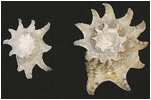

Immature shells of width 10 mm, 18 mm, and 27 mm
Long Key: found with considerable frequency in shallow grass beds
Key terminology choices: flattened, beaded, oval, medium, smooth, none, wide
References: Abbot, p. 58 (Astraea phoebia); Abbot and Morris, p. 141 (Astraea phoebia); Lee, p. 56; Redfern, p. 10; Rehder, p. 390 (Astraea phoebia). [Note: the name Astraea longispina was also used.]
Back
Atys sharpi
Slender Paper Bubble
Key ID features:
shape, apex, incised lines
Size: 5 to 10 mm


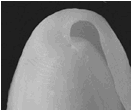
Close-up of apex
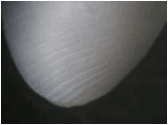

Close-up
of incised lines on base
Close-up of incised lines at top of shell
The color of the Atys sharpi shell is translucent/clear to white (sometimes with a bluish tint). The shell is rather fragile, tall with fairly straight sides, and with a sunken apex. Incised lines are visible at top and base of shell, often not apparent in the center. There is a small umbilicus. The aperture is narrow and elongate (the lip rising above the height of the shell) and the outer lip is thin. Only the body whorl is visible.
Note: the various references differ in whether A. caribaeus and A. sharpi are separate species. Malacolog 4.1.1 cites them as synonyms, Redfern and Lee separate them.
Similar species: Haminoea (species of Haminoea have no umbilicus and the apex is not sunken)
Long Key:
Key terminology choices: rounded, smooth, elongate, tiny, smooth, none, tall
References: Abbot, p. 320 (Atys caribaea); Lee, p. 156; Redfern, p. 158
Back
Bailya intricata
Intricate
Baily Shell
Key ID features:
varix, knobs
Size: 11 to 13 mm




Close-up of varix Close-up of notch
The color of the Bailya intricata shell is grayish. The shell is tall and fusiform; the whorls shouldered. There are 12 to 14 ribs on the body whorl and 12 spiral cords, the intersections forming knobs. The aperture is elongate and slightly notched at the top. The columella is smooth; the outer lip thickened. There is a prominent varix just behind the edge of the outer lip. There are 6 whorls and the sutures are distinct.
The operculum is an elongate oval, thin, and light in color.


The live Bailya intricata is yellowish-white with a few brownish spots. The antennae are fairly short; whitish with brown spots. The siphon is clear/white with numerous brownish lines.




Bailya intricata emerging from shell and crawling
Long Key: in Old Dan Bank Halimeda
Key terminology choices: fusiform, cancellate, oval, small, smooth, short, very tall
References: Abbot, p. 217; Abbot and Morris, p. 222
BACK
Batillaria
minima
False Cerith
Key ID features: nodules
on ribs, multispiral operculum
Size: 13 to 19 mm


The color of the Batillaria minima shell is variable, but usually gray or black with white markings. The shell is slender with a high spire and pointed apex. The numerous ribs are crossed by three primary cords forming nodules. The aperture is obliquely ovate. There is a short canal turned a bit to the left. It is smooth inside outer lip. There are 7 to 9 whorls and the sutures are distinct.
The operculum is round, orange-brown (translucent at margins), and multispiral.
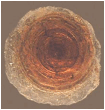
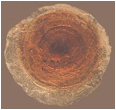
The live Batillaria minima is predominantly black, although there is a bit of white. The antennae are long and slender, tapering to a point. The antennae have black and white rings.

Similar species: Cerithium lutosum. (operculum paucispiral, usually duller in color, beads less prominent)
Long Key: on sand in intertidal zone, e.g., Long Key, island off Duck Key
Key terminology choices: slender, ribs dominant, oval, small, smooth, short, very tall
References: Abbot, p. 103; Abbot and Morris, p. 163; Redfern, p. 24; Rehder, p. 436
Back
Bittiolum
varium
Variable
Bittium
Key ID features:
varix, nodules
Size: 2.5 to 4 mm


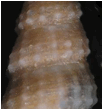
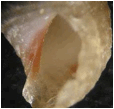
Close-up of nodulated cords Close-up of brown columella
The color of the Bittiolum varium shell is tan to gray, usually with a few tan and/or darker brown markings. The varix is generally white. The shell is tall and slender with a pointed spire. There is a prominent varix on the body whorl. There are low ribs crossed by spiral cords, the cords just above the suture are usually nodulated. The aperture is oval, the canal a mere notch. The columella may be brown. There are 8 to 10 whorls and the sutures are distinct.
The operculum is thin, round, and brownish.


Operculum alone and within aperture
The live Bittiolum varium is whitish to yellow with light brown markings. The antennae are moderately long, slender, and with white and brown rings.
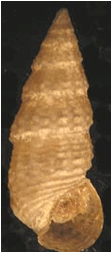
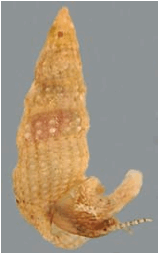
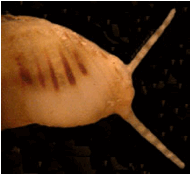
Bittiolum varium in shell, emerging, and crawling
Long Key: common in shallow water grass beds
Key terminology choices: slender, beaded, tear-drop, tiny, smooth, short, very tall
References: Abbot, p. 107 (Diastoma varium); Abbot and Morris, p. 166 (Bittium varium); Lee, p. 59; Redfern, p. 21; Rehder, p. 440 (Bittium varium)
BACK
Blauneria heteroclita
Left-handed Marsh Snail
Key ID features:
sinistral, small Size: 2 to 4 mm

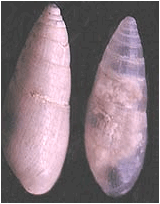


Close-up of apex
Close-up of columella
The color of the Blauneria heteroclita shell is semi-translucent clear to white. The shell is small, smooth, slender, and somewhat fragile. The apex is flattened with the protoconch hidden in the next whorl. The aperture is sinistral, elongate, and wider and rounded at the base. The columella has one large ridge. There are 6 to 8 whorls and the sutures are moderately distinct.
The live Blauneria heteroclita is clear/white. The head is bifurcated and the antennae are short and stubby.
Long Key: under shore debris in the mangroves in the bight
Key terminology choices: slender, smooth, narrow, minute, fold, none, very tall
References: Abbot, p. 334; Lee, p. 159; Redfern, p. 186
Back
Boonea seminuda
Half-smooth Odostome
Key ID features: beads, cords on base
Size: 1.8 to 3 mm



Close-up of beads
The color of the Boonea seminuda shell
is clear/glassy to white. The shell is small but strong, with
flat-sided whorls. The whorls have
4 rows of beaded cords, the base 5 (to 6) cords which are lightly beaded to
smooth. The aperture is oval, the outer lip thin and rounded. There is a fold on the columella (often
deep within). There are 6 to 8 whorls and the sutures are deep and
distinct.
Note: Lee, p. 139 discusses under genus Chrysallida.
Long Key:
Key terminology choices: slender, beaded, oval, minute, fold, none, tall
References: Abbot, p. 292 (Odostomia seminuda); Abbot and Morris, p. 265; Lee, p. 139; Redfern, p. 143; Rehder, p. 629
Back
Bulla
occidentalis
Common West Indian Bubble
Key ID features:
aperture, apical pit, color
Size: 12 to 25 mm
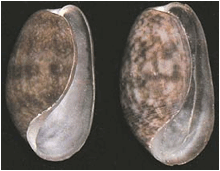
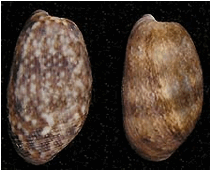
The color of the Bulla occidentalis shell is white with brown markings over the majority of the shell. The shell is moderately strong, smooth (except for shells showing spiral cords on the base), and an elongate oval in shape. The apical pit is large and deep. The aperture is elongate, extending above the top and below the bottom of the shell. The aperture is narrow at the top and widens and flares at the base. The outer lip is thin. The columella shows a white callus which is thicker and rolled back at the base. Only the body whorl is visible.

Close-up
of apical pit
The live Bulla occidentalis is rather drab. The front of the animal is bilobed and is whitish with a dark yellowish cast. There are numerous darker spots. The antennae are leaf-like.

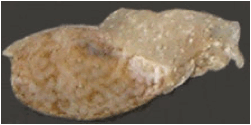
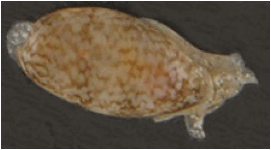
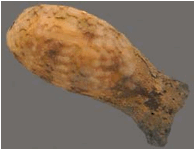
Bulla occidentalis emerging from shell and in motion
Long Key: Long Key bight in shallow water, especially muddy areas
Key terminology choices: rounded, smooth, elongate, small, smooth, none, tall
References: Abbot, p. 319 (Bulla striata); Abbot and Morris, p. 267 (Bulla striata); Lee, p. 155; Redfern, p. 158; Rehder, p. 641 (Bulla umbilicata)
Back
Busycon perversum
Lightning Whelk
Key ID features:
sinistral, long canal, knobs
Size: 10 to 40 cm
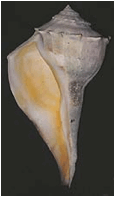
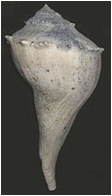

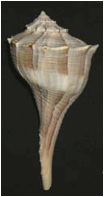
Mature Busycon perversum
Immature Busycon perversum
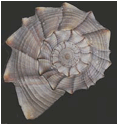
Close-up of apex
The color of the Busycon perversum shell is white with brown streaks and bands when the shell is immature; color is often lost in older shells leaving them yellowish- or grayish-white. The shell is heavy with a low spire and triangular knobs at the shoulder. There are spiral cords on the upper whorls and below the knobs on the body whorl. The aperture is elongate (although fairly wide at the top) and sinistral. The outer lip is thin but quite strong. The canal is open, long, and slender. There are 6 to 7 whorls and the sutures are distinct.
The operculum is brown, heavy, and tear-drop to oval in shape.

![]()
The live Busycon perversum is black.
Note: the name Busycon sinistrum may also be found
Long Key: in sand, on flat off of Duck Key
Key terminology choices: kite, beaded, elongate, very large, smooth, long, tall
References: Abbot, p. 222 (Busycon contrarium); Abbot and Morris, p. 228 (Busycon contrarium); Lee, p. 109; Rehder, p. 563 (Busycon contrarium)
Back
Busycotyrus spiratus
Pear Whelk
Key ID features:
shape, channeled suture
Size: 8 to 13 cm
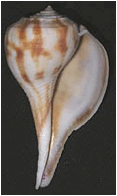
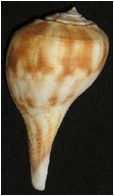
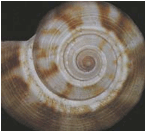
Close-up of apex
The color of the Busycotpyrus spiratus shell is white to cream, with brown markings. The shell is strong, but not heavy, with a large body whorl and a low spire. There are low spiral cords on the upper whorls and on the upper part of the body whorl. The cords become stronger midway down the body whorl. The aperture is wide above, elongate, with a long open canal. The outer lip is thin but strong. There are 4 to 6 whorls and the sutures are channeled and distinct.
The operculum is moderately heavy, an elongate tear-drop in shape, and brown in color.

![]()
Long Key: in shallow sandy areas (dead shells frequently inhabited by Clibinarius hermit crabs)
Key terminology choices: kite, spirals, elongate, very large, smooth, long, tall
References: Abbot, p. 223 (Busycon spiratum); Abbot and Morris, p. 229 (Busycon spiratum); Lee, p. 109; Rehder, p. 564 (Busycon spiratum)
Back
Caecum floridanum
Florida Caecum
Key ID features: large rings near aperture, shape
Size: 3 to 4 mm

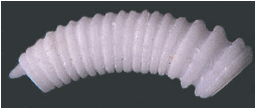
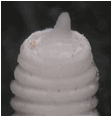
Close-up of mucro
The color of the Caecum floridanum shell is white. The shell is a curved tube. There are very strong rings (up to 40) which become larger and more separated near the aperture. The mucro is pointed and slightly off center. The aperture is round, the lip reinforced by a ring. Only the body whorl is present for the mature snail.
The operculum is thin, round, multispiral, and yellowish.

Operculum (stained)
The live Caecum floridanum is white (with a bit of color by the eye). The antennae are somewhat tapered and white.
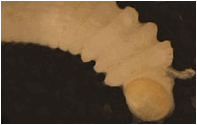



Caecum floridanum emerging from shell and crawling
Similar species: C. imbricatum (longitudinal ridges); C. pulchellum (rings all same size); C. textile (rings more crowded and same size)
Long Key: live in Long Key bight
Key terminology choices: tube, ribs, round, minute, none, none, x tall
References: Abbot, p. 92; Lee, p. 71; Redfern, p. 41
Back
Caecum imbricatum
Imbricate Caecum
Key ID features: longitudinal ridges, shape
Size: 2.5 to 4 mm



Close-up of mucro
The color of the Caecum imbricatum shell is white to yellowish. The shell is a curved tube. There are numerous low flattened circular rings which are crossed by longitudinal ridges (which can range from faint to prominent). The mucro is of moderate height, triangular, and right of center. The aperture is round. Only the body whorl is present for the mature snail.
The operculum is thin, round, multispiral, and yellowish.
The live Caecum imbricatum is white. The antennae are somewhat tapered and white.



Caecum imbricatum emerging from shell
Similar species: C. floridanum (rings larger and increase in size near aperture); C. puchellum (no longitudinal ridges); C. textile (no longitudinal ridges)
Long Key:
Key terminology choices: tube, ribs dominant, round, minute, none, none, x tall
References: Abbot, p. 92; Lee, p. 72; Redfern, p. 41
Back
Caecum pulchellum
Beautiful Little Caecum
Key ID features:
rings, shape Size: 2 to 2.5 mm


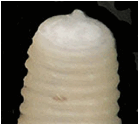
Close-up of mucro
The color of the Caecum pulchellum shell is white to yellowish to tan. The shell is a curved tube. There are numerous circular rings (20 to 30), the interspaces much the same size as the rings. The mucro is low, triangular, and nearly central. The aperture is round. Only the body whorl is present for the mature snail.
The operculum is thin, round, multispiral, and yellowish.

The live Caecum pulchellum is translucent clear to whitish (with a bit of color near the eye). The antennae are clear and little narrowed throughout.




Caecum pulchellum emerging from shell and crawling
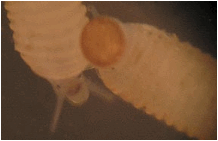
Two Caecum pulchellum
Similar species: C. floridanum (rings larger and increase in size near aperture); C. imbricatum (longitudinal ridges); C. textile (rings all same size and more numerous)
Long Key: Channel 5 Bay side flat and Old Dan Bank in algae and coral rubble
Key terminology choices: tube, ribs, round, minute, none, none, x tall
References: Abbot, p. 91; Abbot and Morris, p. 153; Lee, p. 72; Rehder, p. 420
Back
Caecum textile
Textile Caecum
Key ID features:
numerous low rings, shape
Size: 1.5 to 2.5 mm
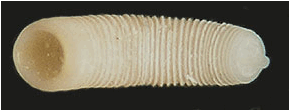

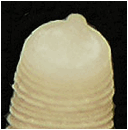
Close-up of mucro
The color of the Caecum textile shell is white to tan. The shell is a curved tube. There are numerous low rings (35 to 45). The mucro is low, bluntly rounded, and slightly off center. The aperture is round. Only the body whorl is present for the mature snail.
The operculum is thin, round, multispiral, and yellowish.
Similar species: C. floridanum (rings larger and increase in size near aperture); C. imbricatum (longitudinal ridges); C. pulchellum (rings all same size and less numerous)
Long Key:
Key terminology choices: tube, ribs, round, minute, none, none, x tall
References: Abbot, p. 91; Redfern, p. 40
Back
Caecum torquetum
Collared Caecum
Key ID features:
varix near aperture, color
Size: 2 to 2.5 mm




Close-up of mucro Close-up of varix near aperture
The color of the Caecum torquetum
shell is clear/white. The shell is a slightly curved tube. Some shells may have very faint rings,
but most are smooth. There is an
inflated smooth varix near the aperture.
The mucro is fairly small, slightly raised, positioned to the right, and
somewhat rounded. The aperture is round, the lip thin. Only the body whorl is present for the mature snail.
Similar species: C. vestitum (generally has faint rings, rings rather than varix near aperture)
Long Key:
Key terminology choices: tube, smooth, round, minute, none, none, x tall
References: Lee, p. 74 (mention only); Redfern, p. 41
Back
Caecum vestitum
Vera Cruz Caecum
Key ID features:
rings near aperture, small mucro, color
Size: 2 to 2.5 mm




Close-up of mucro Close-up of rings near aperture
The color of the Caecum vestitum shell is orangish-brown. The shell is a slightly curved tube. There are very faint rings which become more evident near the aperture. The mucro is flattish and tilts outward a bit at the top. The aperture is round, the lip thin. Only the body whorl is present for the mature snail.
The operculum is round and orange-brown.
Note: Malacolog 4.1 gives C. circumvolutum as the species name. Lee has an extensive discussion of the issues surrounding C. vestitum
Similar species: C. torquetum (generally smooth, varix more developed)
Long Key:
Key terminology choices: tube, smooth, round, minute, none, none, x tall
References: Abbot, p. 93; Lee, p. 74; Redfern, p. 4
Back
Calliostoma adelae
Adele’s Top Shell
Key ID features: top
shape, color, cords on base
Size: 17 to 21 mm
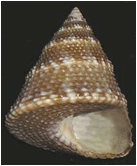
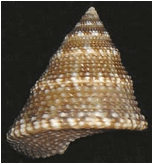
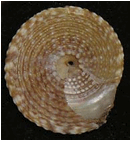
The color of the Calliostoma adelae shell is pale brown to golden tan, mottled with white. The shell is top-shaped with flat-sided whorls and a pointed apex. There are numerous beaded cords, and a ridge at the suture gives the shell a keeled appearance. There are 6 to 8 beaded cords on the flat base. There is a deep umbilicus. The aperture is squarish. There are 8 to 10 whorls and the sutures are marked by the nearby ridges.
The operculum is thin, round, multispiral, and yellow-brown.


The live Calliostoma adelae is quite attractive. The animal is tan to burnt orange in color and has whitish spots. The antennae are tapered and are tan with brown edges. The siphon is dark tan/orange with white spots.
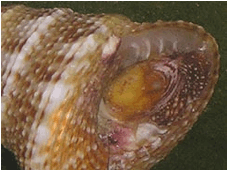
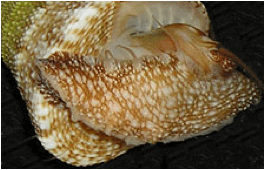
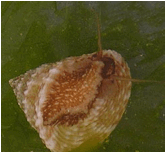
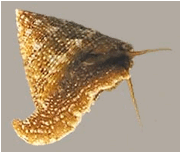
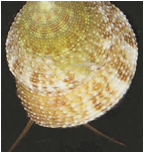
Calliostoma adelae emerging from shell and crawling
Similar species: C. jujubinum (10 to 15 cords on base)
Long Key: in shallow grass beds, e.g., flats off Conch Key and in Channel 5, Old Dan Bank
Key terminology choices: triangular, beaded, oval, small, smooth, none, equal
References: Abbot, p. 44; Abbot and Morris, p. 136
Back
Calliostoma jujubinum
Jujube Top Shell
Key ID features: cords on
base, top shape
Size: 13 to 30 mm
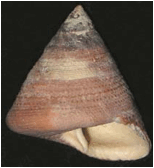
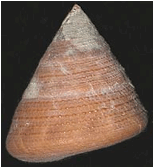

Close-up of spiral cords between sutures
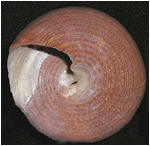
Cords on base
The color of the Calliostoma jujubinum shell is brown to reddish, sometimes with gray or white markings. The shell is top-shaped with flat-sided whorls (slightly larger near sutures) and a sharp apex. There are beaded cords between the sutures. The base has 10 to 15 beaded cords, those nearest the deep umbilicus often the largest. The aperture is an elongated oval. There are 8 to 10 whorls and the sutures are rather indistinct.
The operculum is thin, multispiral, rounded, and light brown.
Similar species: C. adelae (6 to 8 cords on base)
Long Key:
Key terminology choices: triangular, beaded, oval, small, smooth, none, equal
References: Abbot, p. 44; Abbot and Morris, p. 136; Lee, p. 57; Redfern, p. 15; Rehder, p. 378
Back
Calotrophon
ostrearum
Mauve-mouth Drill
Key ID features: color
within aperture, long canal, angular outer lip Size: 19 to 30 mm

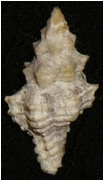
![]()

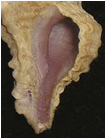
Close-up of outer lip Close-up of aperture color of two shells
The color of the Calotrophon ostrearum shell is yellow to gray. The shell is strong with a pointed spire. There are 6 to 9 ribs crossed by spiral cords, with prominent knobs at the shoulders. The aperture is nearly 50% the height of the shell and is mauve to rusty in color. The outer lip is angular at the shoulder, reflects the ends of the spiral cords, and has numerous small ridges within. The canal is of moderate length and open. There are 6 to 7 whorls and the sutures are moderately distinct.
The operculum is tear-drop shape and dark yellow-brown.


The live Calotrophon ostrearum is yellowish-white with spots of darker white. The eyestalks are fairly short and slender and yellowish-white; the antennae are little extended beyond the eye.
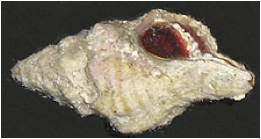
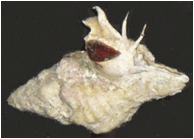


Calotrophon ostrearum emerging from shell and crawling
Similar species: Urosalpinx perrugata (canal shorter, outer lip of aperture rounded), Hesperisternia multangulus (canal very short, shell not as heavy)
Long Key: in grass beds with soft bottom
Key terminology choices: fusiform, ribs dominant, oval, medium, smooth, moderate, very tall
References: Abbot, p. 188; Abbot and Morris, p. 210; Lee, p. 104; Rehder, p. 511
Back
Cantharus cancellarius
Cancellate Cantharus
Key ID features: thin
outer lip, aperture teeth very weak or absent Size: 19 to 30 mm


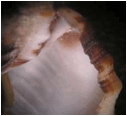
Close-up of upper portion of aperture
The color of the Cantharus cancellarius shell is reddish-brown mottled with white and gray. The shell is solid and fusiform with a slightly concave, but fairly straight-sided, spire. The 11 (to 14) rounded ribs are crossed by numerous spiral cords forming elongated nodules. The aperture is an elongated oval and the canal very short and open. There is a fold near the lower end of the aperture. There are 7 to 10 whorls and the sutures are difficult to identify.
The operculum is strong, tear-drop in shape, and brown with a yellow border.
![]()

The live Cantharus cancellarius is white with many black spots and rounded splotches. The antennae have black spots on the lower portion; the tips are short and yellowish.
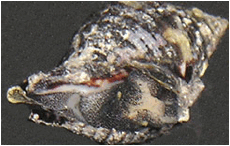
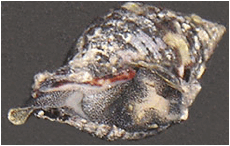
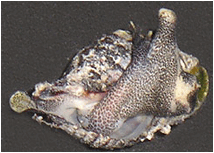

Cantharus cancellarius emerging from shell
Note: Malacolog does not give Cantharus cancellarius as a synonym for Solenosteira cancellaria
Similar species: Gemophos tinctus (varix behind outer lip, nodule and double-tooth at top of aperture)
Long Key: often in clumps of algae in shallow water
Key terminology choices: fusiform, ribs dominant, oval, medium, fold, short, tall
References: Abbot, p. 219; Abbot and Morris, p.
225; Rehder, p. 557 (C. cancellata)
Back
Hesperisternia multangulus
Ribbed Cantharus (False Drill)
Key ID features:
short canal, color, shell shape
Size: 25 to 30 mm
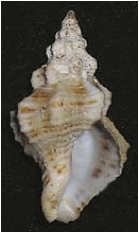

The color of the Hesperisternia multangulus shell is very light to medium brown (beach worm shells often show more dark brown color). The shell is light but strong, tall, with a large body whorl and a pointed spire. There is a sharp change in whorl size, especially regarding the body whorl. The 8 (to 10) strong ribs are crossed by spiral cords, the strongest cords being at, or below, the periphery. The aperture is oval with a thin, crenulate, outer lip. There is a fold at the base of the columella and a short, open canal. There are 6 to 8 whorls and the sutures are distinct.
The operculum is yellowish-brown.
The live Cantharus multangulus is cream-colored, but this base color is obscured by many small brown spots. There are also some spots of white. The antennae are not much extended beyond the eye.

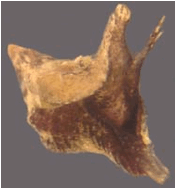
Hesperisternia multangulus emerging from shell
Similar species: Calotrophon ostrearum (canal longer, shell stronger and more angular)
Long Key:
Key terminology choices: fusiform, ribs dominant, oval, medium, fold, moderate, tall
References: Abbot, p. 219 (Cantharus multangulus); Abbot and Morris, p. 226 (Cantharus multangulus); Lee, p. 108 (H. multangula); Redfern, p. 92 (Cantharus multangulus); Rehder, p. 557 (Pisania multangula)
BACK
Careliopsis octona
Guppy’s Miniature Turbonilla
Key ID features:
shape, apex
Size: 1 to 2 mm



Close-up of protoconch
The color of the Careliopsis
octona shell is translucent glassy to white. The shell is
smooth, small, and fragile. The
shell profile is tall and very slender.
The rounded protoconch is set at a right angle to the next whorl. The aperture is teardrop in shape with a thin outer lip. There are 7 to 9 whorls and the sutures are distinct.
Similar species: Henrya henryi (small, axial lines); Murchisonella spectrum (grooves below shoulder, smooth above); Genus Stylopsis (fine spiral grooves)
Long Key: in Halimeda from Old Dan Bank
Key terminology choices: slender, smooth, tear-drop, minute, smooth, none, x tall
References: Redfern, p. 151
Back
Cassis flammea
Flame Helmet
Key ID features: no brown
between outer lip teeth, shape, color
Size: 8 to 13 cm
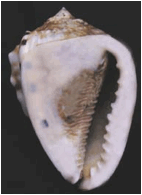
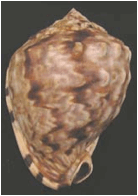
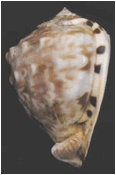
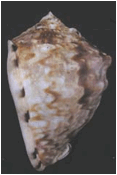
Side views showing brown bars on outer lip
The color of the Cassis flammea shell is light brown with dark brown zigzag markings. There are dark brown bars on the exterior side of the outer lip and on the back side of the ridge at the edge of the parietal shield. The shell is large and heavy; the body whorl is dominant. Knobs at the periphery are the largest. The spire is low. The aperture is long and narrow and the canal is strongly recurved. There are small white ridges (brown between) on the columella and strong teeth (white between) on the inside of the thickened outer lip. The parietal shield is large. There are 6 to 7 whorls and the sutures are moderately distinct.
The operculum is narrow and elongate.
Long Key: only a few dead shells have been found
Key terminology choices: kite, beaded, elongate, very large, teeth, short, tall
References: Abbot, p. 162; Abbot and Morris, p. 199; Lee, p. 81; Redfern, p. 58; Rehder, p. 495
Back
Cassis
madagascariensis spinella
Clench’s Helmet
Key ID features: size, low
spire, columella ridges
Size: 10 to 35 cm
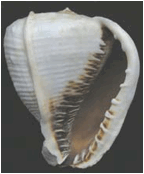
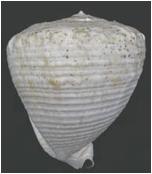
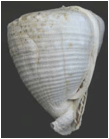
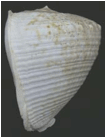
The color of the Cassis madagascariensis spinella shell is yellow, cream, or grayish. The shell is large and triangular in shape with a very low spire. The largest row of knobs is at the shoulder; there are numerous spiral ridges on the remainder of the body whorl (one or two spirals may be knobby). The aperture is long and fairly narrow. The canal is short and turned sharply back. The outer lip is thickened and has prominent teeth, often with brown between them. The columella has numerous white ridges that have dark brown between them. The interior of the aperture is salmon colored. There are 6 whorls and the sutures are distinct.
The operculum is brown and elongate.


Note: Clench’s Helmet is the form (i.e., Cassis madagascariensis spinella) of the Queen Helmet (i.e., Cassis madagascariensis) most often found in Florida waters
Long Key: island off Duck Key
Key terminology choices: triangular, beaded, elongate, very large, teeth, short, tall
References: Abbot, p. 161; Abbot and Morris, p. 200; p. 81; Rehder, p. 495
Back
Cenchritis muricata
Beaded Periwinkle
Key ID features:
beads, color
Size: 13 to 28 mm
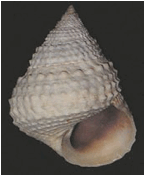
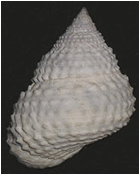
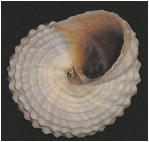
Close-up of base and umbilicus
The color of the Cenchritis muricata shell is white to ash gray to bluish-gray. The shell is top-shaped with convex whorls and a sharp apex. There are many rows of white beads on the body whorl and 3 to 5 rows of small beads on the upper whorls. There are fine spiral threads between the beads. The aperture is round with a solid outer lip. The columella is cream colored and the interior is reddish-brown. The beads on the base are somewhat flattened and there is a small umbilicus which is sometimes closed off. There are 7 to 8 whorls and the sutures are distinct.
The operculum is a fat tear-drop in shape, brown, and paucispiral.


The live Cenchritis muricata is cream white with greenish-brown lines. The antennae are long, tapered, and greenish. The siphon is dark in color with a light tip.
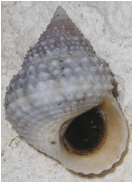
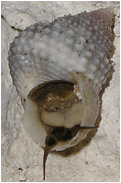
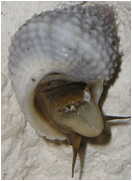
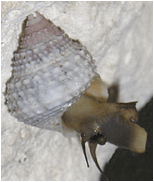
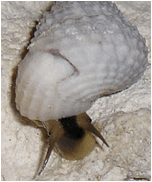
Cenchritis muricata emerging from shell and crawling
Note: immature shells angulate and are more brown in color


Immature Cenchritis muricata
Long Key: on shore rocks well above high tide line (e.g., rocks near bridge at Caloosa Cove)
Key terminology choices: stocky, beaded, oval, medium, smooth, none, tall
References: Abbot, p. 70 (Tectarius muricatus); Abbot and Morris, p. 150 (Tectarius muricatus); Redfern, p. 29; Rehder, p. 409 (Tectarius muricatus)
Back
Cerithidea costata
Costate Horn Shell
Key ID features:
shape, ribs, single cord on base
Size: 10 to 20 mm
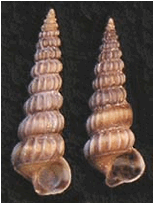
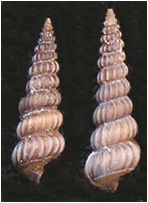
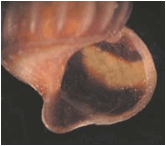
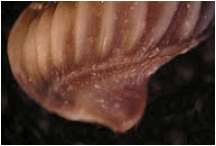
Close-up of outer lip and canal Close-up of base
The color of the Cerithidea
costata shell is tan to light brown or yellowish-brown. The ribs are white
or cream in color. The shell is tall and slender with a
pointed apex. The convex whorls
have many low axial ribs; the ribs on the body whorl ending at the
periphery. The base of the shell
has a single spiral cord (though there is sometimes a weak second cord) and
very weak axial growth lines. The aperture is round, the outer lip is
thin and flaring. The canal is
very short and spout-like. There
are 10 to 14 whorls and the sutures
are distinct.
Similar species: C. scalariformis (larger, numerous spiral cords on base)
Long Key: dead shells found in mud flat locations
Key terminology choices: slender, ribs, oval, small, smooth, short, very tall
References: Abbot, p. 102; Abbot and Morris, p. 163; Redfern, p. 26; Rehder, p. 434
Back
Cerithidea scalariformis
Ladder Horn Shell
Key ID features:
size, ribs, spiral cords on base
Size: 19 to 30 mm

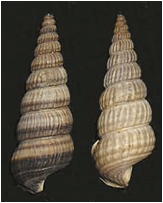
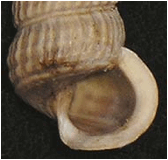
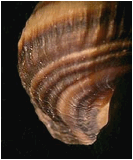
Close-up of aperture and flared outer lip Close-up of spiral cords on base
The color of the Cerithidea scalariformis shell is tan to brown or violet, sometimes in color bands. The shell is tall and slender with a pointed apex. The convex whorls have many low axial ribs; the ribs on the body whorl ending at the periphery. The base of the shell has 5 to 8 low spiral cords. The aperture is round, the outer lip is thin and flaring. There are 10 to 13 whorls and the sutures are distinct.
Similar species: C. costata (smaller, spiral features on base limited to one cord)
Long Key: dead shells found in mud flat locations
Key terminology choices: slender, ribs, oval, small, smooth, none, very tall
References: Abbot, p. 103; Abbot and Morris, p. 163; Lee, p. 60; Rehder, p. 435
Back
Retilaskeya bicolor
Two-toned Cerithiopsis
Key ID features:
protoconch, two rows of beads
Size: 6 to 9 mm





Close-up of protoconch Close-up of lower whorls Close-up of upper whorls
(showing emergence of third row of beads)
The color of the Retilaskeya bicolor shell is light brown with a darker subsutural band. The shell is tall, slender, and straight-sided, with a brown protoconch of a smooth partial whorl followed by two whorls with low axial ribs. There are 2 rows of rounded glassy beads per whorl (only the largest shells begin to form a third row of beads). The beads are linked by axial ribs and spiral cords. The aperture is oval and the outer lip thin and crenulate. The columella has a twist and may be stained brown. There are 10 to 14 whorls and the sutures are rather difficult to identify.
The live Retilaskeya bicolor is orange with a few white spots near the eye. The antennae are clear, long, and slightly tapered.


Retilaskeya bicolor in shell and crawling
Long Key: Old Dan Bank
Key terminology choices: slender, beaded, oval, tiny, fold, short, very tall
References: Redfern, p. 73 [Note: Abbot, p. 109; Abbot and Morris, p. 168; and Rehder, p. 444, describe a very similar shell Cerithiopsis emersonii, see also Lee, p. 88]
Back
Cerithiopsis flava
Spiked Cerithiopsis
Key ID features:
protoconch, spike
Size: 5 to 6 mm





Close-up of
protoconch
Close-up of upper whorls
Close-up of lower whorls
The color of the Cerithiopsis flava shell is orangish-brown to a darker brown. The shell is tall and slender with a protoconch of 4+ smooth whorls (the lower portion may be stained with brown) which are topped by a small darkly colored spike. (The shell will be difficult to identify if the protoconch is broken off). There are 3 rows of rounded glassy beads per whorl. The beads are generally linked by axial ribs and spiral cords. The aperture is oval and the outer lip thin and crenulate. There are 11 to 12 whorls and the sutures are rather difficult to identify.
The live Cerithiopsis flava is white. The antennae are of moderate length, not much tapered, and rounded.
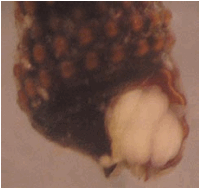
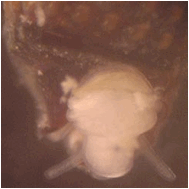
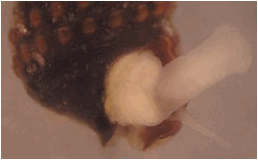
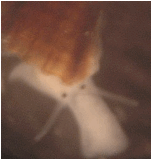
Cerithiopsis flava emerging from shell and crawling
Long Key:
Key terminology choices: slender, beaded, oval, minute, smooth, short, very tall
References: Lee, p. 85; Redfern, p. 70
Back
Cerithiopsis greenii
Green’s Cerithiopsis
Key ID features: protoconch, upper row of beads
Size: 3 to 5 mm



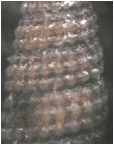
Close-up of protoconch Close-up of beads
The color of the Cerithiopsis greenii shell is brown to orange-brown. The shell is slender with a golden-brown protoconch of 3 smooth whorls. There are 3 rows of rounded glassy beads per whorl, the top row somewhat reduced in size on the upper adult whorls. The beads are generally linked by axial ribs and spiral cords. The aperture is oval and the outer lip thin. There are 10 to 13 whorls and the sutures are rather difficult to identify.
The live Cerithiopsis greeni is white with some considerable areas of black on the foot.
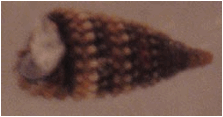
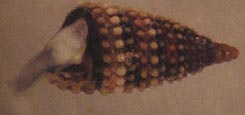

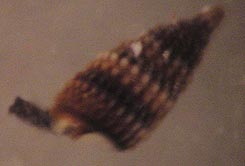
Cerithiopsis greeni emerging from shell and crawling
Similar species: C. iontha (protoconch of 2+ glassy whorls); C. pseudomovilla (protoconch of 2.5 whorls, beads on upper whorls unevenly spaced); C. Sp. A (protoconch of 4 whorls)
Long Key:
Key terminology choices: slender, beaded, oval, minute, smooth, short, very tall
References: Abbot, p. 108; Abbot and Morris, p. 168; Lee, p. 85; Redfern, p. 71; Rehder, p. 443
Back
Cerithiopsis iontha
Iontha
Cerithiopsis
Key ID features: protoconch, elongated beads on body whorl
Size: 2 to 4 mm




Close-up of protoconch
Close-up of beads on lower whorls
The color of the Cerithiopsis iontha shell is reddish brown to dark brown. The shell is slender with a glassy translucent protoconch of 2+ smooth whorls (the lower of these whorls may be stained light brown). There are 3 rows of rounded glassy beads per whorl; those on the body whorl are somewhat flattened and axially elongated. The beads are generally linked by axial ribs and spiral cords. The aperture is oval and the outer lip thin. There are 8 to 11 whorls and the sutures are difficult to identify.
Similar species: C. pseudomovilla (protoconch brown); C. greenii (protoconch 3 whorls and brown); C. Sp. A (protoconch 4 whorls and brown)
Long Key:
Key terminology choices: slender, beaded, oval, minute, fold, short, very tall
References: Redfern, p. 72
Back
Cerithiopsis
pseudomovilla
Mock-movilla
Cerithiopsis
Key ID features:
protoconch, bead arrangement
Size: 3 to 5 mm



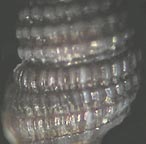
Close-up of protoconch
Close-up of beads on lower whorls
The color of the Cerithiopsis
pseudomovilla shell is dark brown, often with an even darker subsutural
band. The shell is tall and slender with a golden-brown protoconch of 2+
smooth whorls. There are 3 rows of
rounded glassy beads per whorl, the top 2 rows closer together on the upper
adult whorls; the beads becoming more elongate on the body whorl. The beads are generally linked by axial
ribs and spiral cords (the cords being more prominent). The aperture is oval and the outer lip thin and crenulate. There are 9 to 11 whorls and the sutures are rather difficult to identify.
The live Cerithiopsis pseudomovilla is
whitish with irregular greenish/black markings. The antennae are slender,
rounded at tip, and clear/grayish (with some black markings).
Similar species: C. greenii (protoconch of 3 whorls, beads evenly spaced, upper row reduced on upper whorls); C. iontha (protoconch of 2+ glassy whorls); C. Sp. A. (protoconch of 4 whorls, upper row of beads reduced)
Long Key:
Key terminology choices: slender, beaded, oval, minute, smooth, short, very tall
References: Redfern, p. 72
Back
Cerithiopsis vicola
Vicola
Cerithiopsis
Key ID features:
protoconch, brown band
Size: 3 to 4 mm


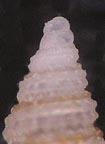

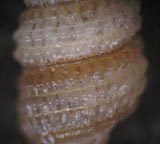
Close-up of protoconch
Close-up of upper whorls
Close-up of lower whorls
The color of the Cerithiopsis vicola shell is glassy to white to cream, with a brown band covering the suture and subsutural area. There is a brown subperipheral cord (and the base may also be stained with brown). The shell is ovate with a protoconch of 2+ smooth, clear whorls. There are 3 rows of rounded glassy beads per whorl (although one row may be reduced in size on the early whorls). The beads are connected by ribs and cords to create squarish spaces. The beads on the body whorl are less rounded and more elongate. The aperture is oval and the outer lip thin. There are 8 to 10 whorls and the sutures are moderately distinct (but their location is made evident by the brown band).
Similar species: Cerithiopsis lata (protoconch of 4+ whorls)
Long Key:
Key terminology choices: slender, beaded, oval, minute, smooth, short, very tall
References: Redfern, p. 72
Back
Cerithium
atratum
Florida Cerith
Key ID features: upright
aperture, beads
Size: 20 to 30 mm


The color of the Cerithium atratum shell is white to cream to gray, often with reddish and/or brown markings. The shell is tall and slender with a pointed apex. There are several rows of 18 to 20 beads per whorl, with the beads at the periphery sometimes larger. There are several former varices. The aperture is broadly ovate and upright in relation to shell. There are both a notch and a ridge at the upper end. Canal is short and turned to left. There are 10 to 12 whorls and the sutures are moderately distinct.
Similar species: C. eburneum (aperture less upright, beads often larger); C. muscarum (ridge at base of shell); C. floridanum (a synonym)
Long Key:
Key terminology choices: slender, beaded, oval, medium, smooth, short, very tall
References: Abbot, p. 104; Abbot and Morris, p. 164; Lee, p. 59; Redfern, p. 20; Rehder, p. 437
Cerithium
eburneum
Ivory Cerith
Key ID features:
beads, varices
Size: 19 to 30 mm
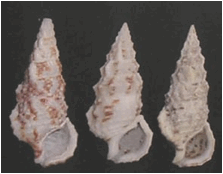
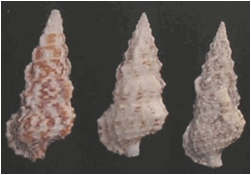
The color of the Cerithium eburneum shell is white to cream with red or red-brown markings. The shell.is tall and the whorls show 4 to 6 rows of 18 to 22 beads (those at periphery often larger). There are several former varices. The aperture is broadly ovate with a notch and ridge at the upper end. The canal is short. There are 6 to 9 whorls and the sutures are distinct.
The operculum is thin, translucent, oval, brownish, and paucispiral.


The live Cerithium eburneum is whitish to yellow with brown to black markings. The antennae are long and slender with dark white and black coloration.
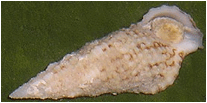
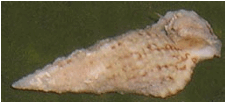
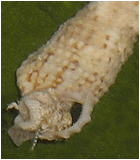
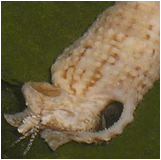
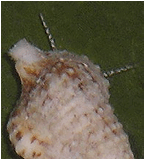
Cerithium eburneum emerging from shell and crawling
Similar species: C. atratum (aperture more upright, beads smaller); C. muscarum (ridge at base of shell)
Note: Specimens with fewer but more prominent nodules at the periphery are sometimes identified as the form C. eburneum algicola. Others have made such specimens a separate species C. algicola.
Long Key: very common in grass beds
Key terminology choices: slender, beaded, oval, medium, smooth, short, very tall
References: Abbot, p. 104; Abbot and Morris, p. 164; Redfern, p. 20; Rehder, p. 438
Back
Cerithium
guinaicum
Schwengel’s Cerith
Key ID features: fine spiral threads, ribs
Size: 25 to 37 mm


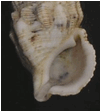
Close-up of aperture, notch, and ridge
The color of the Cerithium guinaicum shell is white to cream with smudges of brown and black. The shell is tall with 9 to 10 ribs and 15 to 20 fine spirals per whorl. Apex often eroded. Ribs truncated to top 1/3 of body whorl. The aperture is broadly ovate with an interior black smudge and a notch and ridge at upper end. There are 8 to 10 whorls; sutures are “wavy” and distinct.
The operculum is fairly strong, brown, and paucispiral.


The live Cerithium guinaicum is yellowish white with extensive dark white and greenish-black markings. The antennae are moderately long and clear with dark white and greenish-black spots and splotches.

Cerithium guinaicum in shell
Similar species: C. litteratum (nodules{rather than ribs})
Long Key: Calossa flat in sponge/soft coral area
Key terminology choices: stocky, ribs dominant, oval, medium, smooth, short, very tall
References: Abbot, p. 104; Abbot and Morris, p. 166
Back
Cerithium
litteratum
Stocky Cerith
Key ID features: color
pattern, shape, knobs Size: 19 to 35 mm
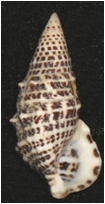

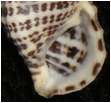
The color of the Cerithium litteratum shell is cream white with many rows of dark (usually brown or black) markings. The shell is tall, and somewhat stocky, with a sharp apex. There are 9 to 12 prominent nodules below the suture, along with numerous knobby spiral cords. The aperture is broadly ovate with a notch and ridge at the upper end. The outer lip is moderately thickened in mature shells. There are 7 to 9 whorls and the sutures are moderately distinct.
The operculum is oval, orange-brown fading to translucent yellow, and paucispiral.


The live Cerithium litteratum is yellowish-white with brown and black splotches and lines. The antennae are long and slender; clear with dark white and brown/black markings.
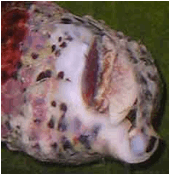
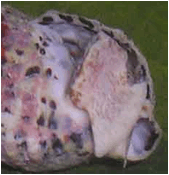
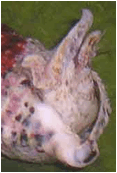
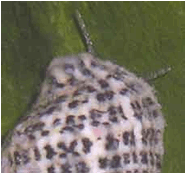
Cerithium litteratum emerging from shell and crawling
Similar species: C. guinaicum (ribs{rather than nodules}, many fine spirals)
Long Key: very common in shallow water in grass beds
Key terminology choices: stocky, beaded, tear-drop, medium, smooth, short, tall
References: Abbot, p. 104; Abbot and Morris, p. 165; Redfern, p. 20; Rehder, p. 437
Back
Cerithium
lutosum
Dwarf Cerith
Key ID features: beads, operculum
Size: 6 to 12 mm
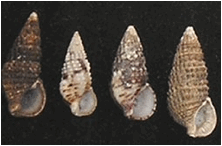
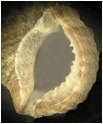
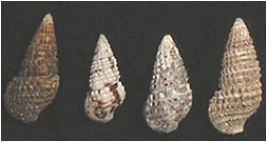
Close-up showing
ridge, notch, and teeth
The color of the Cerithium lutosum shell is quite variable, ranging from white to dull gray to brown to black, the lighter colored shells (usually smaller) often having darker markings. The shell is moderately slender with a pointed apex. There are 3 to 4 rows of beads on each whorl, accompanied by fine spiral threads. There are generally former varices on the body whorl. The aperture is broadly ovate and the canal is very short. The outer lip may be stained with brown spots. In mature shells there will be teeth inside the outer lip, often grouped in pairs. There are 7 to 8 whorls and the sutures are indistinct.
The operculum is thin, translucent, paucispiral, and brown.


The live Cerithium lutosum is greenish-black with some clear/white areas. Some darker lines. The antennae are moderately long and not much tapered; clear with greenish-black markings.
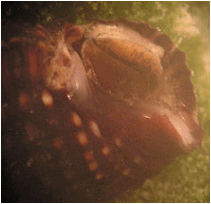
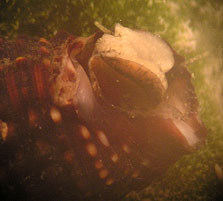
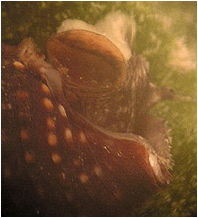
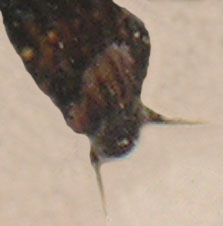
Cerithium lutosum emerging from shell and crawling
Similar species: B. minima (operculum multispiral, sculpturing more rib-like than beaded)
Long Key: common along muddy and sandy shorelines
Key terminology choices: slender, beaded, tear-drop, small, smooth, short, very tall
References: Abbot, p. 105; Abbot and Morris, p. 165; Lee, p. 60; Redfern, p. 20; Rehder, p. 439
Back
Cerithium
muscarum
Fly-specked Cerith
Key ID features: cord on
base
Size: 19 to 25 mm
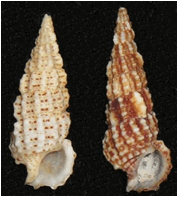
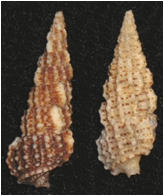
Two color forms of Cerithium
muscarum
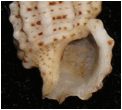
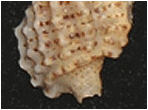
Close-up of aperture, notch, and ridge Close-up of
ridge at base of shell
The color of the Cerithium muscarum shell is white with brown flecks or more predominantly brown. The shell is tall and slender with a sharp apex. There are 3 rows (4 on body whorl) of 8 to 11 nodules per whorl (forming undulating ribs). The base of the shell has a distinct ridge. The aperture is broadly ovate. There are a notch and a ridge at the upper end. The short siphonal canal is twisted slightly left. There are 9 to 10 whorls and the sutures are distinct.
The operculum is thin, oval, yellow-brown (darker at center), and paucispiral.


The live Cerithium muscarum is yellowish with black markings. The antennae are quite long, not much tapered, and with numerous darker white and black markings.
Similar species: C. eburneum (no ridge at base)
Long Key: very common in grass beds and on shallow flats
Key terminology choices: slender, beaded, tear-drop, medium, smooth, short, very tall
References: Abbot, p. 104; Abbot and Morris, p. 165; Redfern, p. 21; Rehder, p. 438
Back
Cerodrillia
clappi
Clapp’s Drillia
Key ID features:
rib size, color
Size: 13 to 19 mm


The color of the Cerodrillia clappi shell is golden brown (lower ˝ of whorl) and white (base and upper ˝ of whorls), with white/cream ribs. The shell is slender with a high spire. The ribs, 8 (to 10) per whorl, are short and oblique. There are several low spiral cords on the base. The aperture is fairly small and an elongate oval. The interior color reflects the surface pattern. The outer lip is thin (although sometimes there is a rib behind the edge giving a thickened appearance) with a notch at the upper end. The canal is short and open. There are 8 to 10 whorls and the sutures are distinct.
Similar species: C. thea (color darker, ribs slightly shorter)

C. clappi; C. thea
Long Key:
Key terminology choices: slender, ribs, narrow, small, smooth, short, very tall
References: Abbot, p. 271 (C. perryae); Abbot and Morris, p. 256
Back
Cerodrillia
thea
Thea Drillia
Key ID features:
ribs, color
Size: 13 to 19 mm


The color of the Cerodrillia thea shell is dark chocolate brown with white/cream ribs. The shell is slender with a high spire. The ribs, 8 (to 10) per whorl, are short and slightly oblique. There are several low spiral cords on the base. The aperture is fairly small and oval. The interior is brown. The outer lip is thin (although sometimes there is a rib behind the edge giving a thickened appearance) with a notch at the upper end. The canal is short and open. There are 8 to 10 whorls and the sutures are distinct.
The operculum is thin, brown, and a tear-drop shape.
The live Cerodrillia thea is off-white with extensive purplish-brown coloration. The antennae are moderately extended beyond the eye; clear with opaque white and dark markings. The siphon is clear with dark markings and white spots.
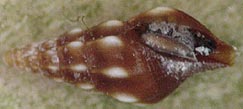
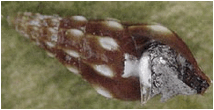
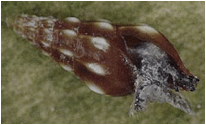
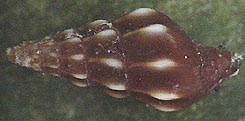
Cerodrillia thea emerging from shell and crawling
Similar species: C. clappi (color lighter, ribs slightly longer)

C. clappi; C. thea
Long Key: in Halimeda in flat off Calossa Cove
Key terminology choices: slender, ribs, narrow, small, smooth, short, very tall
References: Abbot, p. 271; Abbot and Morris, p. 257; Lee, p. 124; Redfern, p. 123; Rehder, p. 618
Back
Chicoreus dilectus
Lace Murex
Key ID features:
ornate spines, ribs and varices
Size: 25 to 75 mm
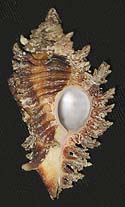
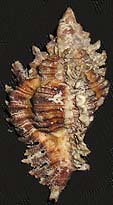


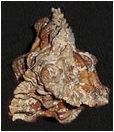
Side view of Chicoreus dilectus Close-up of aperture View from above Chicoreus dilectus
The color of the Chicoreus dilectus shell is medium to dark brown. The shell is very ornate with 3 strong varices with frilled spines (thus showing a triangular shape from above) and one knobby rib between varices. There are low revolving cords. The aperture is nearly round and white internally. The canal is quite long, nearly closed, and recurved. There are 7 to 9 whorls and the sutures are moderately distinct.
The operculum is thick, nearly round, and brown.


The live Chicoreus dilectus is dark in color with some yellow/orange dots and specks. The front of the foot is dark green to black while the sides of the animal are yellowish with fine dark green lines. The antennae are dark in color with lighter colors underneath.
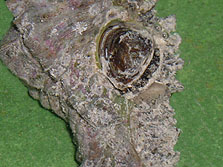
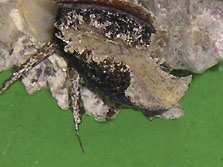
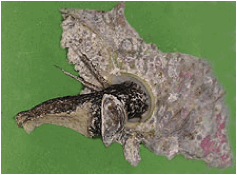
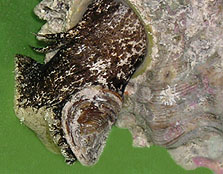
Chicoreus dilectus emerging from shell
Long Key: in shallow water in grass beds on flats, e.g., Channel 5 Bay side, bight sand bar
Key terminology choices: fusiform, beaded, oval, large, smooth, long, tall
References: Abbot, p. 174 (Murex florifer dilectus); Abbot and Morris, p. 209 (Chicoreus florifer dilectus); Lee, p. 104 (Chicoreus florifer dilectus); Redfern, p. 86; Rehder, p. 509 (Chicoreus florifer dilectus)
Back
Chicoreus pomum
Apple Murex
Key ID features: 3 varices with knobs, brown spots in
aperture
Size: 5 to 10 cm
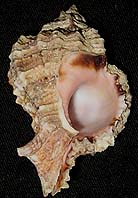
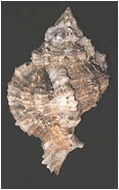

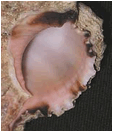
Side view of Chicoreus pomum Close-up of aperture and columella
The color of the Chicoreus pomum shell is various shades of brown (sometimes with a bit of pink or white). The shell is heavy with a moderately elevated spire. The body whorl has 3 large axial ribs between which are smaller varices. The spiral cords form knobs when crossing the ribs and varices. The aperture is oval, white (often with cream or pink) with brown splotches, and there is a callus on the columella with an upturned ridge. The outer lip has many teeth. The canal is long, nearly closed, and bent back. There are 5 to 7 whorls and the sutures are distinct.
The operculum is oval and dark brown.


The live Chicoreus pomum is yellowish-brown with a few dark brown spots. The antennae are dark brown.
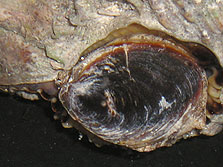
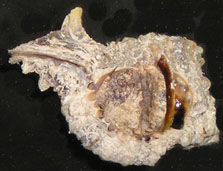
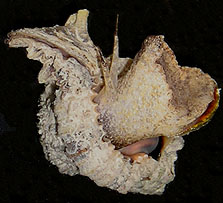
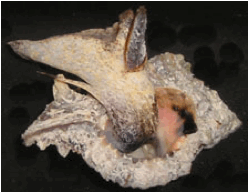
Chicoreus pomum emerging from shell
Note: Lee notes that some have raised Phyllonotus to rank of genus, as may be found in Abbot and Morris and in Malacolog. Lee maintains Chicoreus.
Long Key: Old Dan Bank, Channel 5 flat (Bay side)
Key terminology choices: fusiform, ribs dominant, oval, large, smooth, long, tall
References: Abbot, p. 173 (Murex pomum); Abbot and Morris, p. 210 (Phyllonotus pomum); Lee, p. 104; Redfern, p. 86; Rehder, p. 508 (Murex pomum)
Back
Solariorbis multistriatus
Threaded Vitrinella
Key ID features: partially smooth sculpture, small
cords
Size: 2 to 4 mm
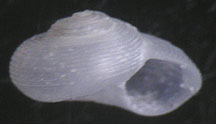
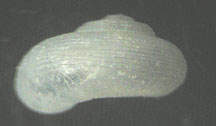
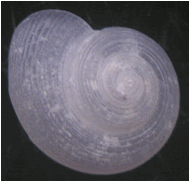
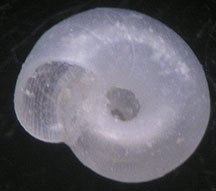
The color of the Solariorbis
multistriatus shell is glassy to white. The shell is
small; flattened with a very low spire.
The upper side of the shell has a series of low spiral cords; the lower
side is smooth. The umbilicus is
round and deep. The aperture is oval, the outer lip
thin. There are 3 to 4 whorls and the sutures are moderately
distinct.
Similar species: C. semisculptus (cords larger); Genus Vitrinella (shells more fragile, smooth)
Long Key:
Key terminology choices: flattened, spirals, oval, minute, smooth, none, wide
References: Abbot, p. 84 (Circulus multistriatus); Redfern, p. 43 (C. sp.)
Back
Circulus semisculptus
Half-smooth
Vitrinella
Key ID features:
partially smooth sculpture, size, shape
Size: 1.5 to 2.5 mm
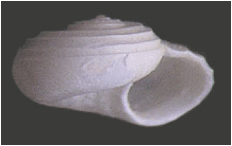
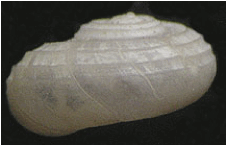
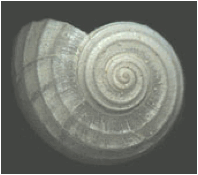
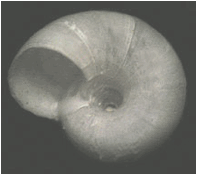
The color of the Circulus
semisculptus shell is glassy to white. The shell is
small; flattened with a very low spire.
The upper side of the shell has a series (3 to 5) of prominent ridges;
the lower side is smooth. The
umbilicus is round and deep. The aperture is oval, the outer lip
thin. There are 3 to 4 whorls and the sutures are moderately
distinct.
Similar species: Solariorbis multistriatus (cords smaller); Genus Vitrinella (shells more fragile, smooth)
Long Key: Old Dan Bank
Key terminology choices: flattened, spirals, oval, minute, smooth, none, wide
References: Lee, p. 69 (Vitrinella semisculpta); Redfern, p. 43
Back
Columbella mercatoria
Common Dove Shell
Key ID features:
aperture and columella teeth, shape
Size: 12 to 19 mm
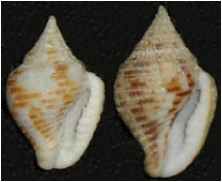
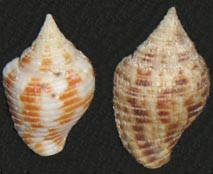
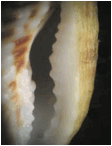
Close-up of narrow aperture showing teeth
The color of the Columbella mercatoria shell is variable, but generally white with substantial areas of yellow, orange, or brown. The shell is solid with spiral cords and a pointed spire. The body whorl is somewhat triangular. The aperture is very narrow, slightly channeled at the upper end, and the outer lip is thickened with its center portion enlarged. There are small teeth at the base of the columella and along the length of the outer lip. There are 5 to 7 whorls and the sutures are moderately distinct.
The operculum is roughly triangular, quite small, thin, and yellowish-brown.

The live Columbella mercatoria is cream-colored with a few brown spots. There is a light brown periostracum. The antennae are fairly short, slender, with numerous white spots. The siphon has white spots and a bit of brown at the base.
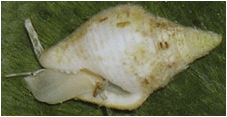
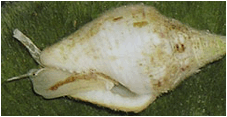
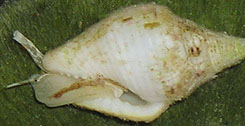
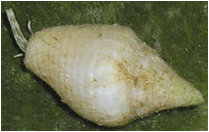
Columbella mercatoria emerging from shell and crawling
Similar species: C. rusticoides (brown between teeth of outer lip)


C. mercatoria on left, C. rusticoides on right
Long Key: very common in grass beds
Key terminology choices: kite, spirals, elongate, small, teeth, short, tall
References: Abbot, p. 195; Abbot and Morris, p. 217; Lee, p. 545; Redfern, p. 94; Rehder, p. 535
Back
Columbella rusticoides
Rusty Dove Shell
Key ID features:
brown between outer lip teeth Size: 12 to 19 mm
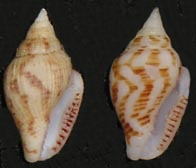
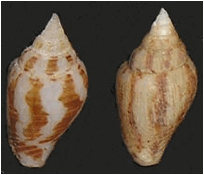
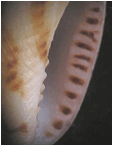
Close-up of aperture and teeth
The color of the Columbella rusticoides shell is variable, but generally white with substantial areas of yellow, orange, or brown. The shell is solid with spiral cords and a pointed spire. The body whorl is somewhat triangular. The aperture is narrow and the outer lip is thickened. There are small teeth at the base of the columella and along the length of the outer lip. The grooves between the teeth of the outer lip are brown. There are 5 to 7 whorls and the sutures are moderately distinct.
The operculum is somewhat triangular, thin, and brownish.

The live Columbella rusticoides is white with brown markings. The antennae are slender, clear with brownish markings, and the tips are clear/white. The siphon is white with brown markings.

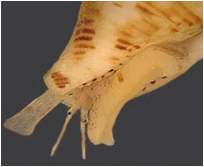
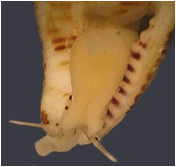
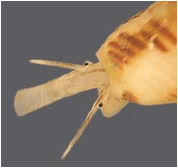
Columbella rusticoides emerging from shell and crawling
Similar species: C. mercatoria (no brown between teeth of outer lip)


C. mercatoria on left, C. rusticoides on right
Long Key: common in grass beds
Key terminology choices: kite, spirals, elongate, small, teeth, short, tall
References: Abbot, p. 195; Abbot and Morris, p. 217
Back
Conus cardinalis
Cardinal Cone
Key ID features:
cone shape, reddish color with light stripe
Size: 20 to 27 mm
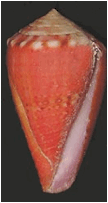
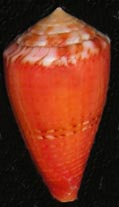
![]()
Close-up showing pink in aperture
The color of the Conus cardinalis shell is pink to light red with a lighter-colored central band. The shell is cone-shaped with a low spire. The spire whorls are slightly angled above the suture. There are low nodules at the shoulder and a few very low spirals on the body whorl (increasing in frequency near the bottom of the shell). The sides of the body whorl are slightly convex (although nearly straight near the base). The aperture is uniformly narrow and nearly as tall as the body whorl. The aperture is pink within. There are 7 to 9 whorls and the sutures are moderately distinct.
The operculum is long, narrow, and brown.
Long Key: dead shells from flat in Channel 5, Bay side
Key terminology choices: kite, spirals, elongate, medium, smooth, short, tall
References: Abbot, p. 256; Redfern, p. 119
Back
Conus anabathrum
Florida Cone
Key ID features:
cone shape, color
Size: 37 to 45 mm
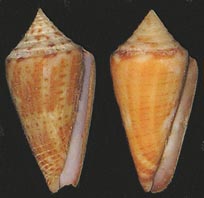
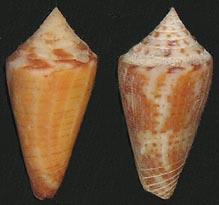
The color of the Conus anabathrum shell is white, cream, or yellow with darker markings, mostly narrow dashes. The shell is cone-shaped with a moderately elevated, slightly concave, spire. The sides of the body whorl are straight and there are a few spirals on the base. The spire whorls are angled above the suture. The aperture is uniformly narrow and nearly as tall as the body whorl. There is a small channel at the upper end of the aperture. There are 7 to 11 whorls and the sutures are distinct.
The operculum is long, narrow, and brown.
Similar species: C. spurius (larger, flattened spire whorls, different color pattern), C. jaspideus (smaller, more colorful, more spiral cords)
Long Key:
Key terminology choices: kite, spirals, elongate, large, smooth, short, very tall
References: Abbot, p. 255 (Conus floridanus); Abbot and Morris, p. 248 (Conus floridanus); Lee, p. 128; Rehder, p. 607 (Conus floridanus)
Back
Conus jaspideus
Jasper
Cone
Key ID features:
cone shape, spirals, color
Size: 13 to 25 mm
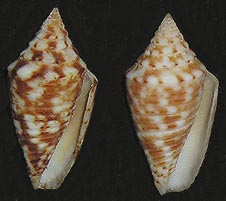
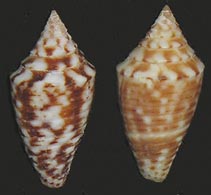
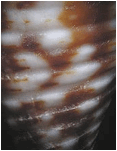
Close-up of spiral grooves on body whorl
The color of the Conus jaspideus shell is white to cream but with considerable coverage by brown to reddish-brown to dark brown markings. The shell is cone-shaped with a moderate spire and a sharp apex. The spire whorls are sharply shouldered above the suture. The sides of the body whorl are straight to slightly convex. There are numerous spiral grooves, the strongest at the base. The aperture is uniformly narrow, slightly channeled at the upper end, and of a height similar to the body whorl. There are 8 to 10 whorls and the sutures are distinct.
The operculum is narrow, elongate, and yellow-brown.
The live Conus jaspideus is yellowish-white marked with black. The antennae are short, black at the base, and clear at the tip. The siphon is black with some white spots.


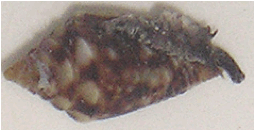
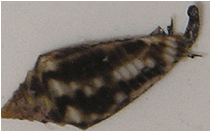
Conus jaspideus emerging from shell and crawling
Similar species: C. spurius (larger, flattened spire whorls, different color pattern), C. anabathrum (larger, less colorful, fewer spiral cords)
Long Key: in areas with soft bottom
Key terminology choices: kite, spirals, elongate, small, smooth, short, tall
References: Abbot, p. 256; Abbot and Morris, p. 249; Lee, p, 129; Redfern, p. 120; Rehder, p. 609
Back
Conus spurius
Alphabet Cone
Key ID features:
cone shape, rows of markings
Size: 50 to 75 mm
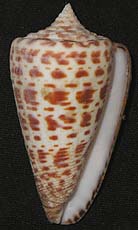
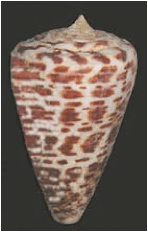
The color of the Conus spurius shell is white or cream with rows of orange-brown to yellow-brown markings. Spire whorls have axial bars of color. The shell is triangular in shape with a small, concave, pointed apex. The large body whorl is slightly convex just below the shoulder, but otherwise has straight sides. There are a few spiral cords at the base. The aperture is uniformly narrow and as tall as the body whorl. The aperture is notched at the upper end and the interior is white. There are 9 to 11 whorls and the sutures are distinct.
The operculum is solid, elongate, narrow, and brown.


The live Conus spurius is tan with a darker band around the base of the foot. The antennae are short and tan. The siphon is white with a tan tip.
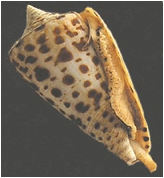

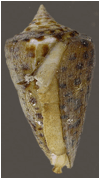

Conus spurius emerging from shell and crawling
Note: Cone shells have unique harpoon-like radular teeth.
![]()

Single radula tooth (stained red and magnified) Group of three radula teeth
Similar species: C. anabathrum (lacks alphabet-like color pattern, spire whorls more erect), C. jaspideus (considerably smaller, more colorful, more spiral cords, spire whorls more erect)
Long Key: flat in channel 5, Bay side
Key terminology choices: kite, smooth, elongate, large, smooth, short, tall
References: Abbot, p. 254; Abbot and Morris, p. 250; Lee, p. 130; Redfern, p. 122; Rehder, p. 606 [Note: most references refer to this Florida shell as form C. s. atlanticus.]
Back
Coralliophila abbreviata
Short Coral-Shell
Key ID features:
solid shell, columella rolled back
Size: 18 to 45 mm
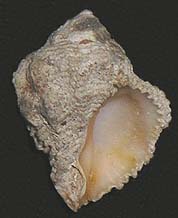
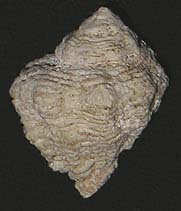
The color of the Coralliophila abbreviata shell is off-white to gray. The shell is solid; the body whorl is angled at the shoulder. There is a fairly low spire. The 7 (to 9) ribs are crossed by crowded spiral cords of varying sizes. The aperture is white (often with a hint of pink or salmon), rounded above, and narrowed below leading to a short canal. The outer lip is crenulate and there are ridges within. The lower portion of the columella is rolled back to frame the umbilicus. There are 6 to 9 whorls and the sutures are moderately distinct (sutures for spire and protoconch whorls often obscure due to wear and/or obscuring lime).
The operculum is thin, yellowish-brown, and suboval.


The live Coralliophila abbreviata is quite colorful. The animal is bright yellow with white spots. The antennae and siphon are also yellow with white spots.
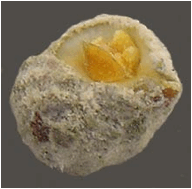
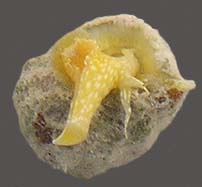
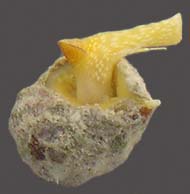
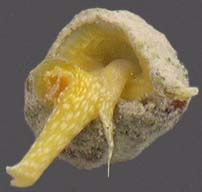
Coralliophila abbreviata emerging from shell
Similar species: C. caribaea (columella straight, wine-red operculum)
Long Key: hard bottom at flat off Anne’s Beach (Calossa Cove)
Key terminology choices: kite, ribs dominant, oval, medium, smooth, short, equal
References: Abbot, p. 193; Abbot and Morris, p.
213; Redfern, p. 90; Rehder, p. 533
Back
Coralliophila caribaea
Caribbaen Coral-Shell
Key ID features:
solid shell, spiral cords, white/purple aperture
Size: 12 to 35 mm
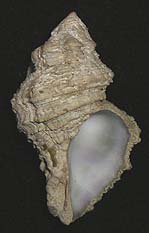
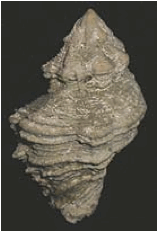
The color of the Coralliophila caribaea shell is off-white to gray. The shell is solid; the body whorl is large and angled at the shoulder. There is a conical spire of moderate height. The 7 (to 9) ribs are crossed by crowded spiral cords of varying sizes (two strong cords occur at center of whorls). The aperture is white (often with a hint of purple), rounded above, and narrowed below leading to a short canal. The umbilicus is quite narrow. There are 7 to 9 whorls and the sutures are moderately distinct (sutures for spire and protoconch whorls often obscure due to wear and/or obscuring lime).
The operculum is wine-red to purplish with a somewhat triangular shape.


Similar species: C. abbreviata (columella rolled back, yellow-brown operculum)
Long Key: hard bottom at flat off Anne’s Beach (Calossa Cove)
Key terminology choices: kite, ribs dominant, oval, medium, smooth, short, tall
References: Abbot, p. 193; Abbot and Morris, p. 214; Lee, p. 107; Redfern, p. 90; Rehder, p. 534
Back
Cosmotriphora melanura
White Atlantic Triphora
Key ID features:
sinistral, white shell, brown apex
Size: 5 to 8 mm



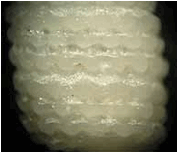
Close-up of apex Close-up of beads on lower whorls
The color of the Cosmotriphora melanura shell is white, the ribbed protoconch is brown. The shell is tall, slender and flat-sided, with a high spire. The early whorls have two rows of rounded beads, the later whorls have 3. The aperture is sinistral and oval, the outer lip thin. The canal is short and recurved. There are 12 to 15 whorls and the sutures are moderately distinct.
Similar species: Iniforis turristhomae (2 rows of beads, lower row reddish-brown); Latitriphora albida (brownish color axial and narrow); Marshallora modesta (brown in color); Notitriphora decorata (reddish-brown color is irregular)
Long Key:
Key terminology choices: slender, beaded, oval, tiny, smooth, short, very tall
References: Abbot, p. 111 (Triphora melanura); Abbot and Morris, p. 169 (Triphora melanura); Lee, p. 88; Redfern, p. 65
Back
Costoanachis catenata
Chain Dove-shell
Key ID features: chain
pattern on shell, ribs
Size: 6 to 8 mm

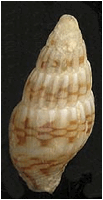

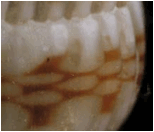
Close-up of teeth on inside of outer lip and chain pattern on body whorl
The color of the Costoanachis catenata shell is white to yellow with brown markings (often in rings forming a chain around the periphery of the whorls). The shell is slender with a moderately high spire; apex is blunt. There are 16 to 19 ribs per whorl; the base has spiral cords. The aperture is fairly narrow and is 40% the height of the shell. The outer lip is thickened. In mature shells there are teeth inside the outer lip. There are 5 to 7 whorls and the sutures are distinct.
The live Costoanachis catenata is black with areas of greenish-white. The antennae are clear at the base and tip with black rings elsewhere. The siphon is black with a small amount of lighter color.
Similar species: C. semiplicata (more fusiform, fewer ribs, larger); C. sparsa (larger, wider, more dark brown); C. translirata (more ribs, larger, more dark brown); Suturoglypta iontha (suture deeper)
Long Key:
Key terminology choices: fusiform, base, narrow, tiny, smooth, short, very tall
References: Abbot, p. 195 (Anachis catenata); Abbot and Morris, p. 218 (Anachis catenata); Redfern, p. 100 (mention only as Costoanachis catenata); Rehder, p. 538 (mention only)
Back
Costoanachis
semiplicata
Semiplicate Dove-shell
Key ID features: size,
fusiform, 12 ribs
Size: 10 to 16 mm



Close-up of aperture and ridges inside outer lip
The color of the Costoanachis semiplicata shell is whitish to yellowish with a brown pattern. The shell is tall and fairly slender with flat-sided whorls. There are 12 ribs on the body whorl, ribs that end at, or just below, periphery. There are a few spirals on the base. The aperture is elongate and fairly narrow; 40% the height of the shell. The outer lip is thin, but there are ridges within. There are 8 to 9 whorls and the sutures are distinct.
The operculum is thin, elongate oval, and yellowish-brown.
The live Costoanachis semiplicata is greenish brown with darker spots and lines. The antennae are of moderate length and are clear/white with brown rings. The siphon has numerous spots of brown with a brown band below tip.
Similar species: C. catenata (chain pattern, smaller); C. sparsa (smaller, more ribs, often darker brown); C. translirata (more ribs, less fusiform, smaller); Suturoglypta iontha (more ribs; suture deeper)
Long Key: in bight grass beds
Key terminology choices: fusiform, base, narrow, small, smooth, short, very tall
References: Abbot, p. 196 (Anachis semiplicata); Lee, p. 115; Rehder, p. 538 (Anachis semiplicata)
Back
Costoanachis
sparsa
Sparse Dove-shell
Key ID features: ribs,
shape, color
Size: 6 to 10 mm



Close-up of teeth inside outer lip
The color of the Costoanachis sparsa shell is a mix of yellow-brown to dark brown with white to yellow spots, flames, and splotches. The shell is moderately slender and has 15 to 19 low ribs. The ribs are quite small to non-apparent on body whorl near outer lip. Cords are most visible on the base of the shell. The aperture is fairly narrow. Mature shells have a series of teeth inside the outer lip. There are 6 to 8 whorls and the sutures are distinct.
The operculum is yellowish-brown, thin, and oval.
The live Costoanachis sparsa is clear to yellowish-white with many small deep white and dark brown or black spots. The antennae are fairly short and are clear/white with dark brown or black spots. The siphon has the same dark markings as the rest of the animal, clear with spots.
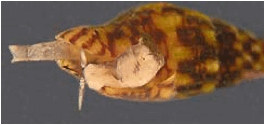
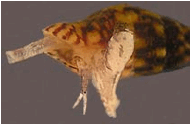
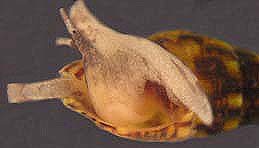
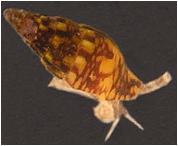
Costoanachis sparsa emerging from shell and crawling
Similar species: C. catenata (chain pattern, smaller); C. semiplicata (larger, fewer ribs, lighter brown); C. translirata (more ribs, less fusiform, smaller); Suturoglypta iontha (ribs stronger, sutures more pronounced)
Long Key: common in grass beds
Key terminology choices: fusiform, base, narrow, tiny, smooth, short, very tall
References: Abbot, p. 195 (Anachis sparsa); Redfern, p. 98; Rehder, p. 537 (Anachis sparsa)
Back
Costoanachis
translirata
Well-ribbed Dove-shell
Key ID features: numerous
ribs, robust body whorl
Size: 10 to 19 mm
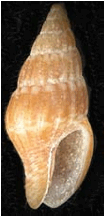
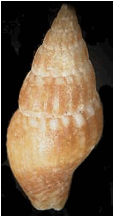

Close-up of aperture and teeth inside outer lip
The color of the Costoanachis translirata shell is dull yellow to brown with spots and streaks of white. The shell is fusiform with a robust body whorl and moderate spire. There are 11 to 20 ribs; the ribs on the body whorl extend only to the periphery or slightly below. Spiral cords are prominent on the base. The aperture is elongate; 30% the height of the shell. Mature shells have up to 8 teeth on the inside of the outer lip. There are 6 to 7 whorls and the sutures are distinct.
The operculum is small and yellowish-brown.
The live Costoanachis translirata is dark green to black with some white. The antennae are short and slender with black markings. The siphon is primarily black with some white dots.
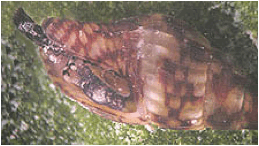
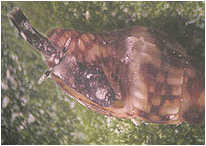
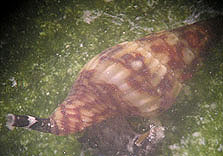
Costoanachis translirata emerging from shell and crawling
Similar species: C. catenata (chain pattern, smaller, shell white); C. semiplicata (more fusiform, fewer ribs, larger); C. sparsa (shell more narrow, fewer ribs); Suturoglypta iontha (ribs stronger, sutures deeper, more fusiform)
Long Key: common in grass beds and clumps of algae
Key terminology choices: fusiform, base, narrow, small, smooth, short, very tall
References: Abbot, p. 195 (Anachis lafresnayi); Abbot and Morris, p. 218 (Anachis lafresnayi); Lee, p. 115; Rehder, p. 536 (Anachis lafresnayi)
Back
Crassispira cubana
Cuban Turrid
Key ID features:
white ribs, notch, channel threads
Size: 17 to 21 mm




Close-ups of thin outer lip and spout-like notch at top of aperture
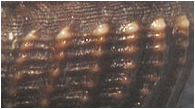
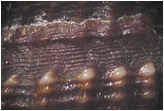
Close-up of ribs and cords Close-up of subsutural channel
The color of the Crassispira cubana shell is dark brown to almost black. On the larger whorls the ribs appear white, especially at the upper end below the channel (due to the color of the small knobs). The shell is robust and the body whorl has 14 to 16 ribs. The ribs are crossed by numerous spiral cords and threads (forming knobs on the ribs), the cords becoming dominant at the base as the ribs fade. The subsutural channel has a cord immediately below the suture and a number of fine spiral threads between the cord and the top of the ribs. The aperture is fairly narrow and there is a spout-like notch at the upper end. There are 8 to 11 whorls and the sutures are moderately distinct.
Similar species: Pyrgospira tampaensis (no white on ribs; shell less robust); Strictispira solida (callus at notch, varix behind outer lip)
Long Key:
Key terminology choices: fusiform, ribs dominant, narrow, small, smooth, short, very tall
References: Abbot, p. 273; Abbot and Morris, p. 254; Lee, p. 126; Redfern, p. 124; Rehder, p. 621
Back
Creedonia succinea
Amber Creedonia
Key ID features:
teeth, color, shape
Size: 3 to 5 mm
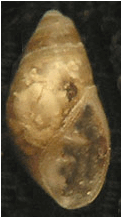
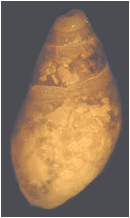
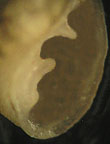
Close-up of columella
The color of the Creedonia
succinea shell is light brown.
The shell is smooth with a
large convex body whorl. The spire
is truncate (the protoconch immersed in the next whorl). The aperture is teardrop in shape, the outer lip thin and rounded
below. There are two large ridges
on the columella and one smaller fold near the base. There are 4 to 5 whorls
and the sutures are distinct.
Long Key:
Key terminology choices: fusiform, smooth, teardrop, minute, teeth, none, tall
References: Abbot, p. 333 (Marinula succinea); Redfern, p. 187
Back
Bostrycapulus aculeata
Spiny Slipper Shell
Key ID feature: spiny
exterior
Size: 13 to 25 mm
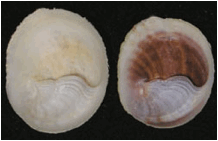
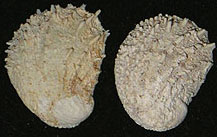



Close-ups of two examples of shelf edge and interior color

Close-up of rows of hollow spines
The color of the Bostrycapulus aculeata shell is white, gray, brown and/or orange-brown. The shell is fairly low in profile, is oval in outline, and the apex is coiled to one side. The exterior is rough, covered by rows of short, hollow spines (which are often eroded to some extent, especially on beach worn specimens). The interior is white or brown, the shelf usually white and covering about 40% of the shell area. The shelf has a central ridge and a sinuous margin.
The live Bostrycapulus aculeata is clear with white spots along the periphery. The antennae are short; clear with white spots.
Note: Malacolog gives B. odites, Lee gives B. aculeatus as current name
Long Key: often attached to dead bivalves
Key terminology choices: rounded, beaded, open, medium, none, none, wide
References: Abbot, p. 142 (Crepidula aculeata); Abbot and Morris, p. 180 (Crepidula aculeata); Lee, p. 75; Redfern, p. 49 (Crepidula aculeata); Rehder, p. 465 (Crepidula aculeata)
Back
Crepidula convexa
Convex Slipper Shell
Key ID features:
solid color, straight shelf edge
Size: 6 to 12 mm
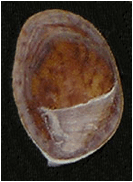
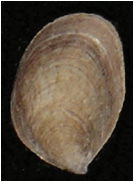
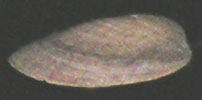

Close-up of shelf edge
The color of the Crepidula
convexa shell is yellowish-brown, reddish-brown or dark brown. The shell is smooth and moderately to considerably arched. The apex is coiled and fairly
small. The interior is reddish-brown, but the shelf is white. The edge of the shelf is straight and
the shelf covers 1/5 to 1/3 of the shell area.
Similar species: C. maculosa (shell is spotted; Note: some young C. maculosa can look much like C. convexa)
Long Key:
Key terminology choices: rounded, smooth, open, tiny, none, none, wide
References: Abbot, p. 141; Abbot and Morris, p. 180; Lee, p. 76; Rehder, p. 465
Back
Crepidula fornicata
Common Atlantic Slipper Shell
Key ID features: sinuous
deck edge, brown coloration
Size: 20 to 50 mm
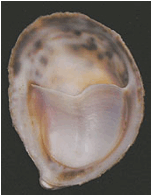
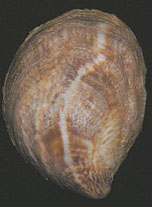
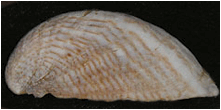
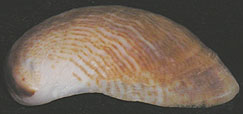

Close-up of sinuous deck edge
The color of the Crepidula fornicata shell is white to cream with brown lines and splotches. The shell is smooth (to slightly wrinkled) and the shape is highly variable (i.e., it may be flattened to highly arched, nearly round to an elongate oval). The coiled apex is bent to the side. The interior is white (but brown is visible from exterior markings). The shelf edge is sinuous and the shelf covers nearly ˝ of the shell area.
The live Crepidula fornicata is white. The antennae are white, of moderate length, and tapered.
Similar species: C. maculosa (spots on shell, shelf edge straight)
Long Key:
Key terminology choices: rounded, smooth, open, medium, none, none, wide
References: Abbot, p. 141; Abbot and Morris, p. 181; Lee, p. 76; Rehder, p. 464
Back
Crepidula maculosa
Spotted Slipper-Shell
Key ID features:
brown spots, straight shelf
edge
Size: 24 to 26 mm
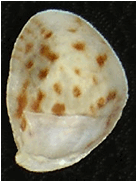
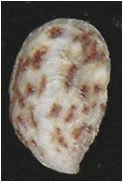


Close-up of shelf
The color of the Crepidula maculosa shell is white with brown or red-brown spots. The shell is smooth, somewhat arched, and the apex is coiled and small. The interior is white (with brown spots due to the exterior color). The shelf is white, has a straight (or very slightly sinuous) edge, and covers 1/5 to 1/3 of the shell area.
The live Crepidula maculosa is clear to whitish. The antennae are long and slender, clear with white spots and streaks.
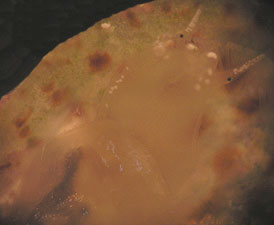
Crepidula maculosa in shell
Similar species: C. fornicata (deck edge sinuous), C. convexa (no spots; Note: some young C. maculosa can look much like C. convexa)
Long Key:
Key terminology choices: rounded, smooth, open, medium, none, none, wide
References: Abbot, p. 141; Abbot and Morris, p. 181; Rehder, p. 464
Back
Crepidula plana
Eastern White Slipper Shell
Key ID features:
flat, white
Size: 13 to 38 mm
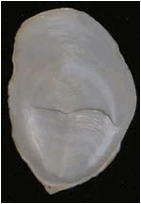
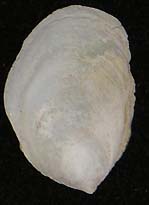

Side view of Crepidula plana
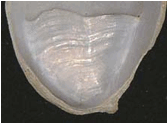
Close-up of sinuous platform shelf and small apex
The color of the Crepidula plana shell is white. The shell is irregularly oval and is generally quite flattened (although its shape is affected by the substrate to which it is attached). There may be some surface sculpture such as wrinkles and growth lines. The apex is coiled, small, and somewhat centrally located. The interior is glossy white. The platform shelf has a sinuous edge and covers 30 to 40 percent of the opening.
The live Crepidula plana is white to a bit yellowish. The antennae are clear to whitish.
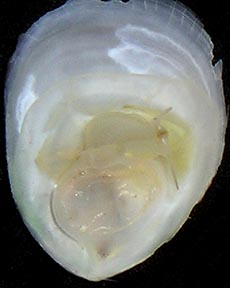
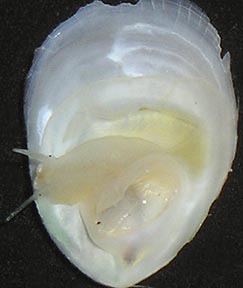
Crepidula plana
Long Key: very commonly found attached to shells; often in the aperture (especially large dead shells)
Key terminology choices: rounded, smooth, open, medium, none, none, very wide
References: Abbot, p. 142; Abbot and Morris, p. 181; Lee, p. 76; Redfern, p. 49; Rehder, p. 466
Back
Cyclostremiscus jeannae
Key ID features: cords, size
Size: .8 to 1.5 mm
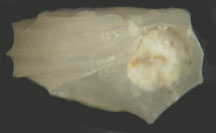
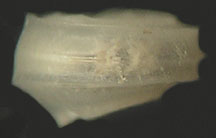
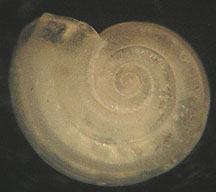
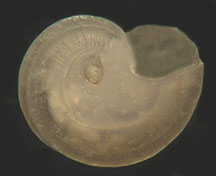
The color of the Cyclostremiscus
jeannae shell is glassy/clear to white. The shell is very
small but strong. The shell is
flattened on top; there are concave gutters on either side of the cord above
the shoulder. Three strong cords
circle the periphery of the shell.
An additional cord circles the base of the shell. The umbilicus is deep. The aperture is oval, the outer lip thin and reflecting the ends of the
cords. There are 2 to 3 whorls and the sutures are moderately
distinct.
Similar species: Lodderena ornata (shell more completely flattened, depressed spire)
Long Key:
Key terminology choices: flattened, spirals, oval, minute, smooth, none, wide
References: Abbot, p. 85; Lee, p. 66
Back
Cyclostremiscus suppressus
Suppressed Vitrinella
Key ID features:
size, 3 cords
Size: 1.2 to 2 mm
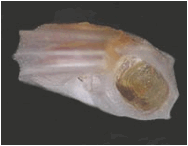
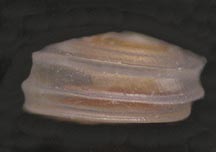
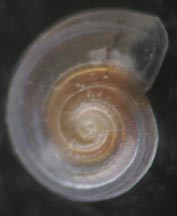
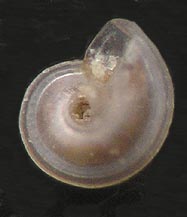
The color of the Cyclostremiscus suppressus shell is clear/translucent. The shell is very small, but quite strong. The profile of the shell is flattened with a very low spire. The body whorl has 3 strong cords with deep gutters between them. The umbilicus is round and deep, bordered by a raised thread. The aperture is nearly circular. There are 4 to 5 whorls and the sutures are difficult to identify.
The operculum is round, very thin, translucent, and multispiral.

Similar species:
Long Key:
Key terminology choices: flattened, spirals, round, minute, smooth, none, wide
References: Abbot, p. 84 (Circulus suppressus); Rehder, p. 422
Back
Cylichnella bidentata
Orbigny’s Barrel Bubble
Key ID features:
fold, callus on apex
Size: 2.5 to 4 mm
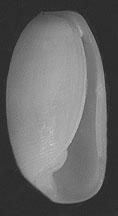
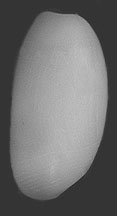
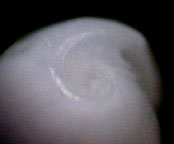
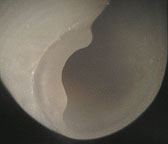
Close-up of callus on apex Close-up of lower portion of columella
The color of the Cylichnella
bidentata shell is white. The shell is barrel-like (the body whorl
moderately convex) and somewhat fragile.
There are spiral grooves on the lower half of the shell. The apex is covered with a depressed
callus. The aperture is elongate, the outer lip as high as the top of the
shell. The outer lip is thin and
rounded below. There is a strong
fold near the base of the columella. The body whorl
is dominant and the callus covers the apex.
Similar species: Atys sharpi (no callus, no fold); Haminoea succinea (no callus, no fold)
Long Key:
Key terminology choices: rounded, smooth, elongate, tiny, smooth, none, tall
References: Rehder, p. 639
Back
Cylindrobulla beauii
Beau’s Paper Bubble
Key ID features:
shape, thin shell
Size: 7 to 11 mm
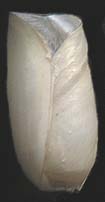
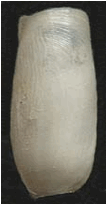
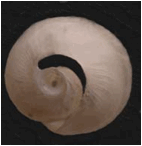
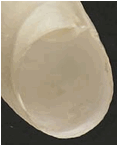
Close-up of apex Close-up of base
The color of the Cylindrobulla beauii shell is white to straw. The shell is cylindrical and very thin and fragile. The suture splits early and the body whorl is largely separated from the apex. The spire is sunken in the apex. The thin, straight, outer lip is rolled over hiding the columella, but there is a round opening at the bottom of the shell. Only the body whorl is visible for the mature snail.
The live Cylindrobulla beauii is yellowish-white with some darker white spots. The animal scarcely fits in the shell.
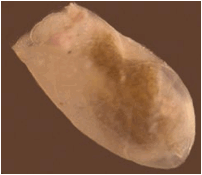
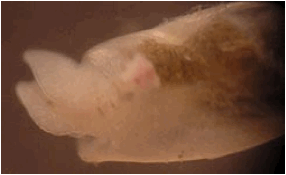
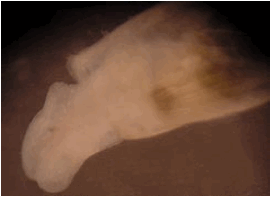
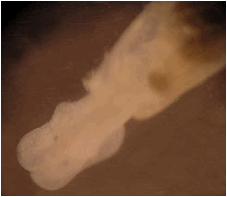
Cylindrobulla beauii emerging from shell and crawling
Long Key: in shallow grass beds
Key terminology choices: tube, smooth, round, tiny, none, none, very tall
References: Abbot, p. 322; Abbot and Morris, p. 269; Lee, p. 158; Redfern, p. 160
Back
Cymatium comptum
Dwarf Hairy Triton
Key ID features:
ridge on upper columella, varices and beads Size: 25 to 35 mm
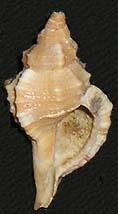
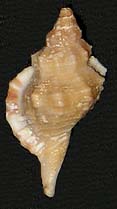
The color of the Cymatium comptum shell is yellowish-white to tan, the varices brown and white. The shell is tall with a pointed spire. The shell has 7 or 8 small ribs and 1 (or 2) stronger varices; these axial features are crossed by spiral cords creating beads, the rows at the shoulder being the largest. The aperture is an elongate oval, white (sometimes with a tint of yellow-orange) with a thick outer lip. There are numerous teeth inside the outer lip and on the lower portion of the columella; the columella smooth (or with very small teeth) in the middle and having one larger ridge near the top. The canal is moderately long and partially closed. There are 6 to 10 whorls and the sutures are distinct.
Similar species: Vokesimurex rubidus (spines, no ridge on upper columella, aperture more round)
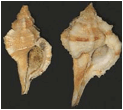
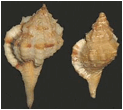
Vokesimurex rubidus in center, Cymatium comptum at either end
Long Key:
Key terminology choices: kite, ribs dominant, oval, medium, teeth, long, tall
References: Abbot, p. 163 (C. vespaceum); Lee, p. 82; Redfern, p. 62
Back
Cymatium
cynocephalum
Dog-Head Triton
Key ID features:
shape, color, varices
Size: 37 to 75 mm
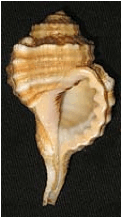


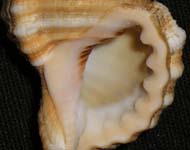
Side view of Cymatium cynocephalum Close-up of aperture
The color of the Cymatium cynocephalum shell is fawn to pale yellow, with some spots of white. The shell is solid with a globular body whorl. There are strong nodulated spiral cords with finer threads between. The shell has one (sometimes 2) prominent varix and there are a number of smaller ribs (formed in part by the knobs of the cords). The aperture is roughly oval with a brown splotch on the columella. There are small ridges on the columella and the outer lip is thick with strong teeth within. The canal is long, partially closed, and somewhat recurved. There are 5 to 7 whorls and the sutures are distinct.
Long Key: dead shell, Channel 5 Bay side flat
Key terminology choices: fusiform, beaded, oval, large, teeth, long, tall
References: Abbot, p. 165 (Cymatium moritictum caribbaeum); Abbot and Morris, p. 201 (Cymatium caribbaeum); Lee, p. 83; Redfern, p. 62; Rehder
Back
Cymatium femorale
Angular Triton
Key ID features:
shape, varices
Size: 8 to 20 cm



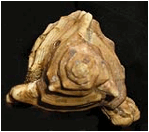
Side
view of
Cymatium femorale Top view
of Cymatium femorale
The color of the Cymatium femorale shell is yellowish-brown (knobs on varices are usually white). The shell is very large and triangular in shape. There are 7 (to 8) strong knobby spiral cords on the body whorl with numerous threads between. The cords generate large knobs on the two large varices. The aperture is an elongate oval and white enamel within. The columella is ridged, in large part by the extensions of the strong spiral cords. The canal is long, partially closed, and strongly recurved. There are 8 to 10 whorls and the sutures are distinct.
The operculum is brown and roughly oval.
![]()
![]()
The live Cymatium femorale is light purple with numerous darker spots. The antennae are moderately long, purple with irregular white lines.
Long Key: Channel 5 flat, Bay side, in grass beds
Key terminology choices: kite, beaded, oval, very large, fold, long, tall
References: Abbot, p. 163; Abbot and Morris, p. 201; Redfern, p. 60
Back
Cymatium
martinianum
Atlantic Hairy Triton
Key ID features:
paired teeth inside outer lip, varices
Size: 4 to 10 cm


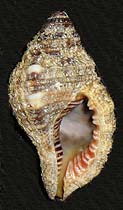

Beach-worn mature shell Shell of less mature snail
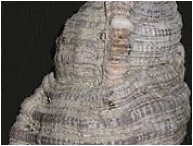

Close-up of cords Close-up of aperture
The color of the Cymatium martinianum shell is brown with some white markings (the live snail has a brownish “hairy” periostracum). The shell is strong with a moderate (to high) spire. There are two strong varices and numerous squarish spiral cords (with finer threads between). The aperture is oval with a somewhat closed canal of moderate length. The outer lip is thickened and there are 7 pairs of white teeth on a yellow-orange background. The low lirae on the columella are on a background of brown. There are 8 to 10 whorls and the sutures are moderately distinct.
The live Cymatium martinianum is yellow-brown with brown/orange spots that are bordered by white. The antennae are of moderate length and the siphon, antennae, and eyestalks are spotted like the body.
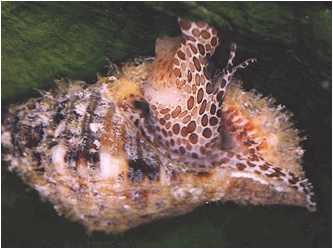
Cymatium martinianum emerging from shell
Long Key:
Key terminology choices: kite, spirals dominant, oval, large, teeth, moderate, tall
References: Abbot, p. 163 (C. pileare); Abbot and Morris, p. 203 (C. pileare); Lee, p. 83; Redfern, p. 61; Rehder, p. 498 (C. pileare)
Back
Cymbovula
acicularis
West Indian Simnia
Key ID features:
shape, color, aperture
Size: 11 to 17 mm

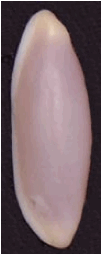
The color of the Cymbovula acicularis shell is purplish (on a few occasions yellowish). The shell is solid, smooth, elongate, and slender. The aperture is long and narrow, running the entire length of the shell. The outer lip is white and thickened. The inner lip is smooth and bordered by a ridge. Only the body whorl is visible.
Note: immature shells lack the thickened outer lip


Long Key: on soft corals (color makes this snail very difficult to find)
Key terminology choices: rounded, smooth, elongate, small, smooth, short, very tall
References: Abbot, p. 151 (Simnia acicularis); Abbot and Morris, p. 197 (Simnia acicularis); Redfern, p. 52; Rehder, p. 482 (Simnia acicularis)
Back
Cyphoma
gibbosum
Flamingo Tongue
Key ID features: glossy
apricot color, cylindrical shape
Size: 19 to 40 mm
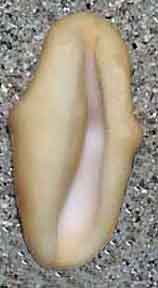
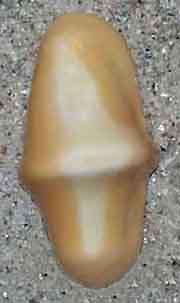
The color of the Cyphoma gibbosum shell is apricot to cream-orange with creamy white across the upper ridge of the shell. The shell is glossy and smooth. It is cylindrical in shape and tapers towards the ends. There is a prominent transverse ridge in the middle of the shell. The aperture runs the length of the shell. It is quite narrow with a thickened outer lip (but with no teeth). Only the body whorl is visible.
The live Cyphoma gibbosum is very colorful . When fully extended, the mantle nearly covers the shell. The mantle is pale in color and has many irregular squarish spots which are ringed with black. The foot and tail are yellow-orange with black lines or trim. The antennae are slender. The siphon has a black line that outlines the tip.
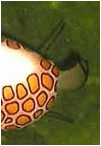
Siphon and antennae of Cyphoma gibbosum
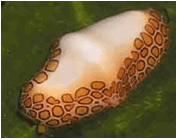
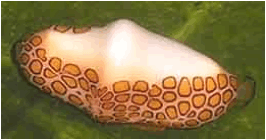
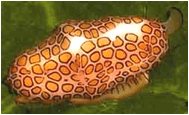
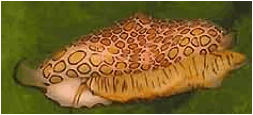
Mantle and foot of Cyphoma gibbosum
Similar species: C. mcgintyi (white shell)
Long Key: on soft corals, e.g., off Craig Key, Caloosa flat
Key terminology choices: rounded, smooth, elongate, medium, smooth, short, tall
References: Abbot, p. 152; Abbot and Morris, p. 197; Redfern, p. 52; Rehder, p. 483
Back
Cyphoma
mcgintyi
McGinty’s Cyphoma
Key ID features: glossy
white color, cylindrical shape
Size: 19 to 40 mm
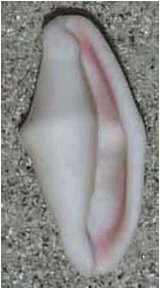
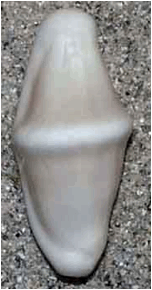
The color of the Cyphoma mcgintyi shell is white with a hint of lavender or purple. The shell is glossy and smooth. It is cylindrical in shape and tapers considerably towards the ends. There is a prominent transverse ridge in the middle of the shell. The aperture runs the length of the shell. It is quite narrow with a thickened outer lip (but with no teeth). Only the body whorl is visible.
The live Cyphoma mcgintyi is very colorful . When fully extended, the mantle nearly covers the shell. The mantle is pale in color and has many irregular dark brown spots. The foot and tail are whitish with an orangish margin and with dark brown or black lines. The antennae, usually dark in color, are slender and tipped in white. The siphon has a black line that outlines the tip.
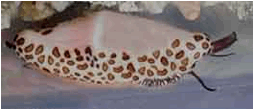
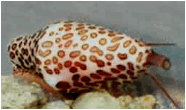


Mantle and foot of Cyphoma mcgintyi
Similar species: C. gibbosum (apricot shell)
Long Key: on soft corals, e.g., off Craig Key, Caloosa flat
Key terminology choices: rounded, smooth, elongate, medium, smooth, short, tall
References: Abbot, p. 153 (C. macgintyi); Abbot and Morris, p. 198 (C. macgintyi); Lee, p. 77; Redfern, p. 52; Rehder, p. 483 (C. macgintyi)
Back
Macrocypraea
cervus
Atlantic Deer Cowrie
Key ID features: shape,
aperture, color
Size: 7.5 to 17.5 cm
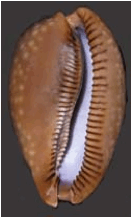
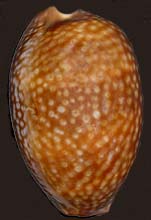
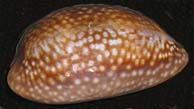
The color of the Macrocypraea cervus shell is light to dark brown with numerous white (to yellowish) dots. The shell is solid, smooth, and glossy. It has an elongate and rounded shape. The aperture is very narrow and runs the length of the shell. There are numerous dark brown ridges on both lips of the aperture. The interior is purple. There are 3 to 4 whorls, but the body whorl predominates (the other whorls are very small and difficult to identify, although sutures are sometimes discernible near the apex).
The live Macrocypraea cervus has a thick gray to black mantle that covers much of the shell when expanded. The surface of the mantle has numerous papillae. The antennae are slender, much tapered, and black. The siphon is black.
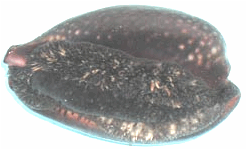
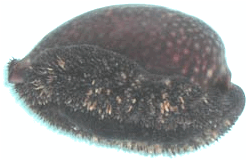
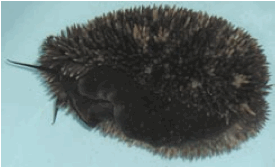
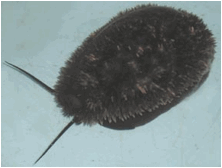
Note: immature shells lack spots and the lip remains thin and has not yet “turned under”


Similar species: Macrocypraea zebra (white dots have brown centers)
Long Key: in shallow water under rocks, ledges, sponges, or lobster traps
Key terminology choices: rounded, smooth, elongate, large, teeth, short, very
tall
References: Abbot, p. 149 (Cypraea cervus); Abbot and Morris, p 194 (Cypraea cervus); Lee, p. 77; Rehder, p. 479 (Cypraea cervus)
Back
Dendropoma corrodens
Ringed Worm-shell
Key ID features:
shape, axial ridges
Size: 3 to 8 mm
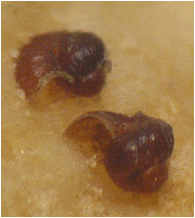
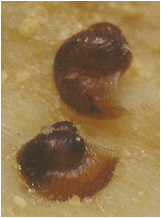
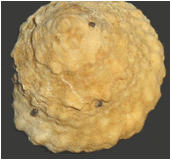
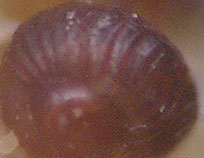
Dendropomo corrodens on Astraea americana Close-up of ridges and apex
The color of the Dendropoma corrodens shell is orangish-brown. The shell is coiled, the surface with axial ridges. The apex is smooth and rounded. The shell is generally found partially embedded in the surface of other shells. The aperture is rounded reaching a diameter of just over a millimeter. There are 3 to 4 whorls and the sutures are distinct.
Long Key: along rocky shore on Astraea americana shells
Key terminology choices: stocky, ribs, oval, minute, smooth, none, equal
References: Abbot, p. 100 (Spiroglyphus annulatus); Redfern, p. 49; Rehder, p. 429 (Spiroglyphus annulatus)
Back
Dermomurex
elizabethae
Elizabeth’s
Aspella
Key ID features:
chalky appearance, varices
Size: 13 to 20 mm
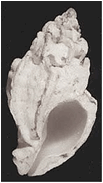
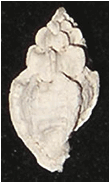
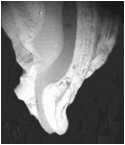
Close-up of fold in aperture and recurved canal
The color of the Dermomurex elizabethae shell is chalky white. The shell is characterized by 6 prominent varices. Low spiral cords are present, especially noticeable on body whorl. Nuclear whorl clear, smooth, glossy. The aperture is rounded and about 50% the height of the shell. There is one fold where canal begins. The siphonal canal is of moderate length and is recurved. There are 5 to 6 whorls and the sutures are very distinct.
The operculum is brown and suboval.


The live Dermomurex elizabethae is quite plain. The animal is yellowish-white. The antennae are clear/white, slender, and well extended past the eye.
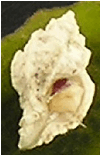
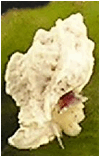
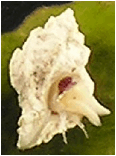
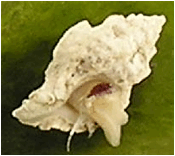
Dermomurex elizabethae emerging from shell
Similar species: D. paupercula (larger, less ornate, fewer ribs)
Long Key: on shallow flats in clumps of Halimeda opuntia
Key terminology choices: fusiform, ribs dominant, oval, small, fold, moderate, tall
References: Abbot, p. 186 (Aspella elizabethae)
Back
Dermomurex
pauperculus
Little Aspella
Key ID features:
varices, chalky appearance Size: 13 to 25 mm


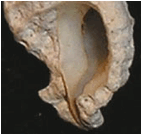
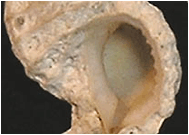
Close-up showing fold Close-up showing outer lip and teeth
The color of the Dermomurex pauperculus shell is chalky white. The shell is characterized by 3 to 5 prominent varices. Low spiral cords are present, especially noticeable on body whorl. The aperture is rounded, yellowish-white within, and about 40% the height of the shell. There is one fold on columella where canal begins. The siphonal canal is of moderate length and is recurved. There are 5 to 7 whorls and the sutures are very distinct.
The operculum is brown, suboval, and moderately strong.


The live Dermomurex pauperculus is white with a few small brown spots. The antennae are white and very slender beyond the eye.
Similar species: D. elizabethae (smaller, more varices, more ornate)
Long Key: often found in Halimeda clumps in shallow water, Channel 5 flat, Caloosa flat
Key terminology choices: fusiform, ribs dominant, oval, medium, fold, moderate, tall
References: Abbot, p. 186 (Aspella paupercula); Abbot
and Morris, p. 211; Redfern, p. 86; Rehder, p. 511 (Aspella paupercula)
Back
Diodora cayenensis
Cayenne Keyhole Limpet
Key ID features:
every 4th rib larger
Size: 19 to 50 mm
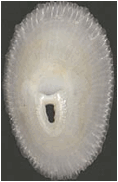
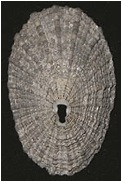
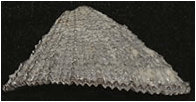
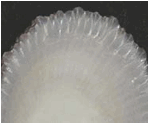
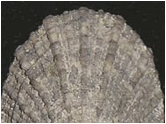

Close-up of crenulate margin Close-up of rib pattern Close-up of keyhole
The color of the Diodora cayenensis shell may be greenish-white or brownish, but may also be a drab gray. In younger shells, brown markings, in the form of radial rays, are often present. The shell is moderately heavy and the apex is elevated. The ribs are prominent and every 4th rib is larger. Concentric cords form nodules (sometimes scale-like) when crossing the ribs. The shell margin is moderately crenulate. The keyhole is in the shape of a dumbbell and is forward of shell center. The front slope of the shell is straight, the posterior slope humped. The interior of the shell is white (to grayish). There is a pit behind the callus of the keyhole.
The live Diodora cayenensis is cream colored with numerous brown spots. The head and antennae are dark brown.
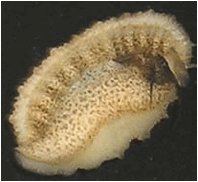
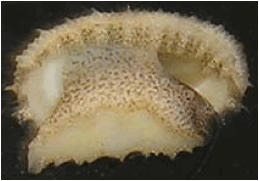
Living Diodora cayenensis
Similar species: D. listeri (every 2nd rib larger, shell more robust), D. dysoni (rays are black; Note: Redfern observes that immature D. cayenensis may sometimes have black, rather than brown, rays. He indicates that further study may show D. dysoni to be immature D. cayenensis), Lucapina species (shells less stout)
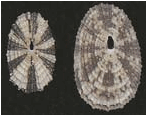
Diodora dysoni on left, immature Diodora cayenensis on right
Long Key: attached to rocks in shallow water
Key terminology choices: rounded, ribs dominant, open, medium, none, none, wide
References: Abbot, p. 23; Abbot and Morris, p. 126; Lee, p. 54; Redfern, p. 4; Rehder, p. 349
Back
Diodora dysoni
Dyson’s Keyhole Limpet
Key ID features:
black rays, white around keyhole
Size: 10 to 20 mm
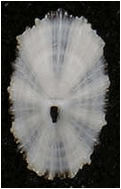
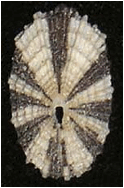

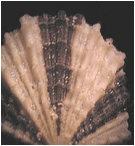

Close-up of rib pattern Close-up of keyhole
The color of the Diodora dysoni shell is white with black rays. The shell is moderately elevated. There are strong radiating ribs; 2 or 3 smaller ribs between each larger one. The numerous concentric rings form scales or knobs when crossing the ribs. The interior is white to gray (although surface color also shows through). The keyhole is not far from shell center and has a pit behind the white callus. The shell margin is crenulate.
The live Diodora dysoni is cream colored with numerous brown spots. The margin of the mantle has alternating black and white markings.
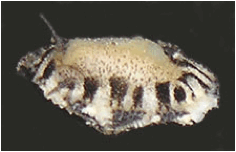
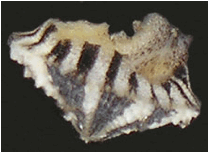
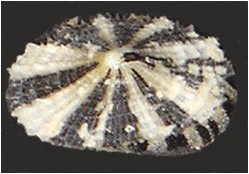
Living Diodora dysoni
Similar species: D. minuta (black around keyhole), D. cayenensis (rays are brown; Note: Redfern observes that immature D. cayenensis may sometimes have black, rather than brown, rays. He indicates that further study may show D. dysoni to be immature D. cayenensis), Lucapina species (shells less stout)
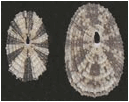
Diodora dysoni on left, immature Diodora cayenensis on right
Long Key: attached to rocks in shallow water
Key terminology choices: rounded, ribs dominant, open, tiny, none, none, wide
References: Abbot, p. 24; Abbot and Morris, p. 127; Redfern, p. 4; Rehder, p. 350
Back
Diodora listeri
Lister’s
Keyhole Limpet
Key ID features: stout
shell, every other rib larger
Size: 25 to 50 mm
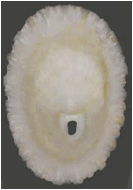
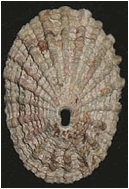
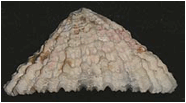
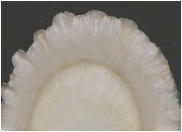
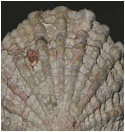

Close-up of crenulations
Close-up of rib pattern Close-up of keyhole
The color of the Diodora listeri shell is cream or white, but most generally a drab gray. The shell is heavy and the apex is elevated. The ribs are very prominent and every other rib is larger. Concentric cords form scales when crossing the ribs and create square pits between ribs. The shell margin is strongly crenulate. The keyhole is an elongate oval and is forward of shell center. The front slope of the shell is straight, the posterior slope humped. The interior of the shell is white. There is a pit behind the callus of the keyhole.
The live Diodora listeri is white with brown dots. The antennae are tapered from a thick base; white with brown markings.
Similar species: D.cayenensis (every 4th rib larger, shell less robust), Lucapina species (shells less stout)
Long Key: attached to rocks in shallow water
Key terminology choices: rounded, ribs dominant, open, medium, none, none, wide
References: Abbot, p. 23; Abbot and Morris, p. 127; Lee, p. 54; Redfern, p. 5; Rehder, p. 350
Back
Diodora minuta
Dwarf
Keyhole Limpet
Key ID features:
black around keyhole, black rays
Size: 11 to 14 mm

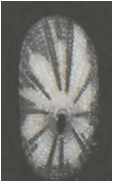

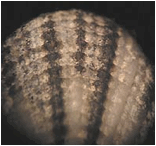
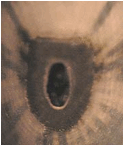
The color of the Diodora minuta shell
is white with black rays (sometimes covering much of the shell). The shell is not much elevated and tends to rest on its ends. The radial ribs are crossed by
concentric cords resulting in knobs or scales at the intersections. The front slope is straight (to slightly
concave) while the rear slop is convex (i.e., slightly humped). The interior is white (although the exterior color may show through
shell). The margin of the shell is
finely creunulate. The keyhole is
widest in the center and the callus around the keyhole is black.
Similar species: D. dysoni (no black around keyhole), Lucapina species (shells less stout)
Long Key: attached to rocks in shallow water
Key terminology choices: rounded, ribs dominant, open, small, none, none, wide
References: Abbot, p. 24; Abbot and Morris, p. 127; Redfern, p. 5; Rehder, p. 351
Back
Elachisina floridana
Florida
Cingula
Key ID features: spiral threads, shape
Size: 2 to 3 mm
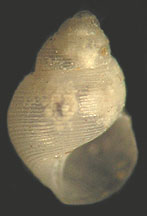
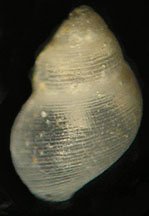
The color of the Elachisina
floridana shell is glassy/clear to white. The shell is thin
but quite strong, stocky with convex whorls, a moderate spire, and a rounded
apex. The surface shows many
close-set spiral threads. There is
a very small umbilicus. The aperture is oval, the outer lip thin
and rounded. There are 4 to 5 whorls and the sutures are distinct.
Similar species: Genus Eulithidium (more colorful, lack same spiral sculpture)
Long Key:
Key terminology choices: stocky, spirals, oval, minute, smooth, none, tall
References: Redfern, p. 39
Back
Emarginula pumila
Pygmy Emarginula
Key ID features:
limpet shape, slit
Size: 6 to 13 mm
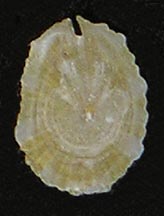
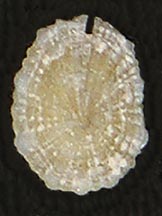
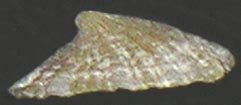
The color of the Emarginula pumila shell is whitish to yellowish (both exterior and interior). The shell is of limpet shape with a low to moderate profile. There are numerous radial ribs of varying size which are crossed by concentric cords. The apex is hooked backwards. There is a short slit at the anterior end. The aperture is open and the base is roughly oval with a scalloped margin.
The live Emarginula pumila has a light orangish foot and a mantle with white stripes. The mantle also displays claw-like appendages. The antennae are fairly short and white with orange tint.
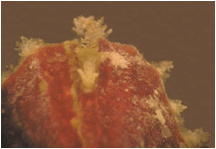
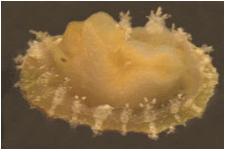
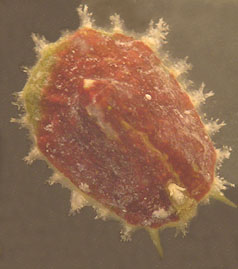
Living Emarginula pumila
Long Key: patch reef off Caloosa Cove
Key terminology choices: rounded, ribs dominant, open, small, none, none, wide
References: Abbot, p. 20; Abbot and Morris, p. 129; Redfern, p. 3; Rehder, p. 348
Back
Episcynia
inornata
Fringed Vitrinella
Key ID features:
serrated cord, size, shape
Size: 2 to 3.5 mm
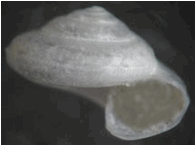
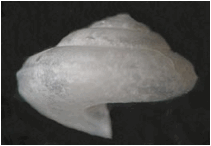
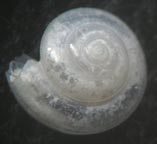
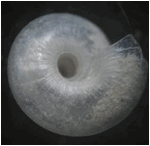

Highly magnified close-up of serrated cord
The color of the Episcynia inornata shell is translucent clear to white. The shell is thin and fragile, considerably flattened with a low spire. The widest part of the shell is bordered with a cord which is serrated. There are low axial ridges on the bottom of the shell. Live shells have a fringed periostracum. The aperture is oval, the outer lip is very thin. The umbilicus is round, large, and deep, and is bordered by a keel. There are 5 to 6 whorls and the sutures are distinct.
Long Key: in sand at patch reef off Caloosa Cove
Key terminology choices: flattened, smooth, oval, minute, smooth, none, wide
References: Abbot, p. 86 (E. multicarinata); Lee, p. 66
Back
Epitonium albidum
Bladed Wendletrap
Key ID features:
curled blades, shape
Size: 12 to 20 mm
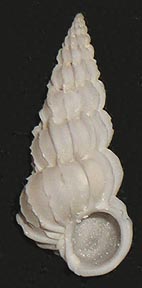
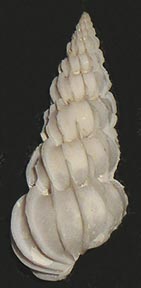
The color of the Epitonium albidum shell is white. The shell is tall with a high spire. There are 12 (to 14) blade-like ribs on the body whorl. The edges of the blades may appear blunt as they are slightly curled over. The blades generally fuse across the suture (the whorls often are not in contact with each other). There is no umbilicus. The aperture is oval. There are 10 to 14 whorls and the sutures are distinct.
Long Key: Channel 5 flat, Bay side
Key terminology choices: slender, ribs, oval, small, smooth, none, very tall
References: Abbot, p. 118; Abbot and Morris, p. 172; Redfern, p. 76; Rehder, p. 452
Back
Epitonium echinaticosta
Widely-coiled Wendletrap
Key ID features:
detached whorls, frilled blades
Size: 6 to 10 mm
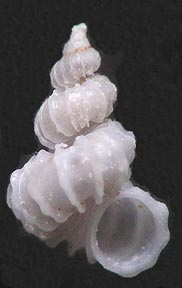
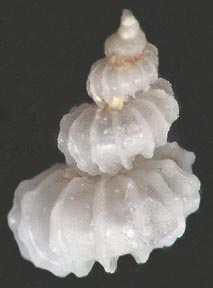
The color of the Epitonium echinaticosta shell is white. The shell is delicate, the lower whorls are very loosely coiled. The blades vary in number, but are often frilled or sinuous. The aperture is deep and well-defined. The protoconch has 3.5+ smooth, clear/white whorls. The aperture is round and surrounded by a thickened lip. There are 8 to 11 whorls and the sutures are distinct (protoconch and uppermost whorls; body whorls may be detached and “sutureless”).
Long Key:
Key terminology choices: stocky, ribs, round, tiny, smooth, none, tall
References: Abbot, p. 119; Abbot and Morris, p. 172; Redfern, p. 76
Back
Erosaria
acicularis
Atlantic Yellow Cowrie
Key ID features:
color, aperture teeth
Size: 16 to 32 mm
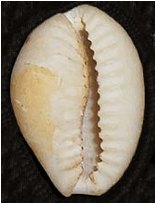
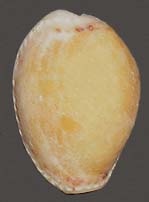
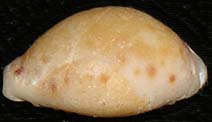
The color of the Erosaria acicularis shell is cream to very light tan, with a white base. The margins of the shell have orange (to orange-brown) spots, often in conjunction with small pits. The aperture is very narrow and runs the length of the shell. There are numerous (17 to 20 on outer lip, 12 to 14 on the inner lip) white or cream ridges on the lips of the aperture. The body whorl is dominant (the other whorls are very small and difficult to identify in mature shells, although sutures are sometimes faintly discernible near the apex).
Similar species: Luria cinerea (more ridges along aperture, darker color)
Long Key:
Key terminology choices: rounded, smooth, elongate, medium, teeth, short, tall
References: Abbot, p. 150 (Cypraea spurca acicularis); Abbot and Morris, p. 194 (Cypraea spurca acicularis); Lee, p. 77; Redfern, p. 51; Rehder, p. 480 (Cypraea spurca acicularis)
BACK
Eulima fulvocincta
Gold-striped Eulima
Key ID features:
colored line on shell, constricted spire
Size: 3 to 5 mm



Side view showing advanced outer lip
The color of the Eulima fulvocincta
shell is clear/glassy with a thin brown (to organish) band which circles
each whorl. The shell is smooth, polished, tall, and
slender. The whorls are flat
sided; the spire is noticeably constricted near the top. The aperture is an elongate teardrop. The outer lip is thin, rounded at the base, and advanced in
the middle. The umbilicus is very
small. There are 8 to 11 whorls and the sutures are moderately
distinct.
Long Key:
Key terminology choices: slender, smooth, teardrop, minute, smooth, none, very tall
References: Abbot, p. 127 (Strombiformis auricinctus); Abbot and Morris, p. 259 (Melanella auricincta); Lee, p. 99; Redfern, p. 80
Back
Eulithidium adamsi
Adams’ Pheasant
Key ID features:
size, color
Size: 2 to 3.5 mm
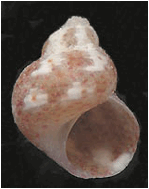
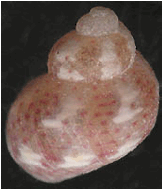
The color of the Eulithidium adamsi shell is off-white to pinkish, with round and elongated pink (or reddish) dots, and a few dark white splotches. The shell is small but stocky, the body whorl dominant. The convex whorls decrease rapidly in size; the apex is fairly flat. The shell appears smooth (but there may be microscopic spiral threads, especially on the early whorls). The aperture is oval and the outer lip thin. There is a small umbilicus. There are 4 to 5 whorls and the sutures are distinct.
The operculum is oval, white, and thickened on the side near the columella, the other side has small ridges.
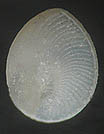
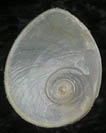
The live Eulithidium adamsi is white to yellowish, with brownish markings. The antennae are long and bristled.
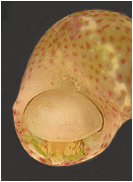
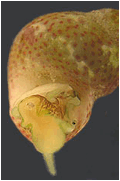
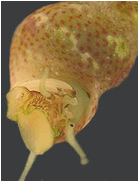
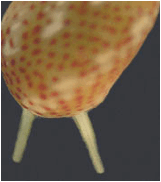
Eulithidium adamsi emerging from shell and crawling
Similar species: Elachisina floridana (very fine spirals, shell clear); Eulithidium affine (larger, especially body whorl); Eulithidium bellum (carinate cord); Eulithidium thalassicola (purple coloration)
Long Key: in grass beds
Key terminology choices: stocky, smooth, oval, minute, smooth, none, tall
References: Abbot, p. 62 (Tricolia adamsi); Redfern, p. 9
Back
Eulithidium affine
Polka-Dot Pheasant (Checkered
Pheasant)
Key ID features:
size, color
Size: 5 to 9 mm
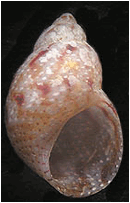
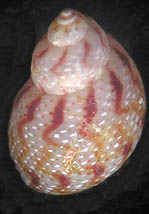
The color of the Eulithidium affine shell is off-white to yellow to pinkish, enhanced by a colorful variety of dots and flames (frequently colored and white dots are in pairs). The shell is stocky, the body whorl dominant. The convex whorls decrease rapidly in size; the spire is of moderate height. The shell appears smooth (but there may be microscopic spiral threads). The aperture is oval and the outer lip thin. There is a small umbilicus. There are 5 to 6 whorls and the sutures are distinct.
The operculum is an irregular oval, white, and thickened on the side near the columella, the other side has small ridges.


The live Eulithidium affine is white with darker (reddish to greenish-black) spots. The antennae are white with brown lines, bristled. There are several pairs of antennae-like structures.
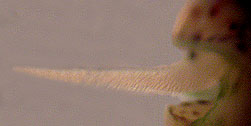
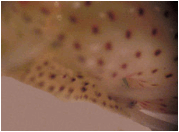
Close-up of bristled antenna Close-up of side of foot
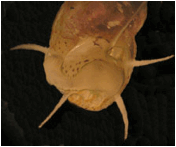
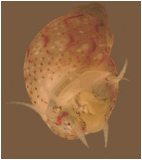
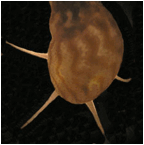
Eulithidium affine emerging from shell and crawling
Similar species: Elachisina floridana (very fine spirals, shell clear); Eulithidium adamsi (smaller, pink or reddish dots); Eulithidium bellum (smaller, carinate cord); Eulithidium thalassicola (smaller, purple coloration)
Long Key: in grass beds, e.g., Old Dan Bank
Key terminology choices: stocky, smooth, oval, minute, smooth, none, tall
References: Abbot, p. 62 (Tricolia affinis); Abbot and Morris, p. 142 (Tricolia affinis); Redfern, p. 10; Rehder, p. 395 (Tricolia affinis)
Back
Eulithidium bellum
Shouldered Pheasant
Key ID features:
large cord
Size: 3 to 5 mm
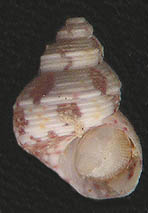
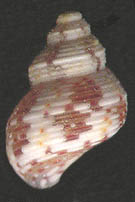
The color of the Eulithidium bellum shell is off-white to pinkish, with reddish (primarily) and yellowish markings. The shell is small and stocky, the body whorl dominant. The convex whorls decrease rapidly in size; the apex is fairly flat. The whorls have regular spiral cords, with one larger cord at the shoulder (giving a carinate appearance). The aperture is oval and the outer lip thin. There is a small umbilicus. There are 4 to 5 whorls and the sutures are distinct.
The operculum is oval, white, and thickened on the side near the columella, the other side has small ridges.
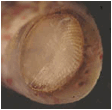
The live Eulithidium bellum is white with brown to orange-brown markings. The antennae are clear and long and covered with bristles. There are several pairs of these bristled structures.
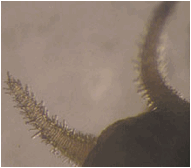
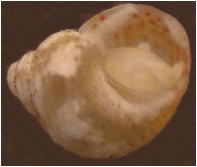
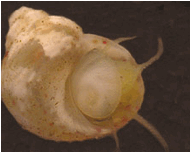
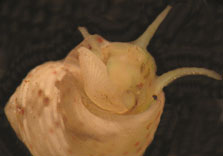
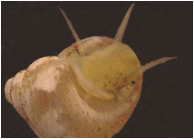
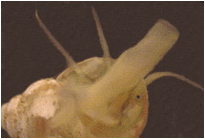
Similar species: Elachisina floridana (very fine spirals, shell clear); Eulithidium adamsi (not carinate, pink or reddish dots); Eulithidium affine (larger); Eulithidium thalassicola (not carinate, purple coloration)
Long Key: in grass beds
Key terminology choices: stocky, spirals, oval, minute, smooth,
none, tall
References: Abbot, p. 62 (Tricolia bella); Redfern, p. 10; Rehder, p. 395 (Tricolia bella)
Back
Eulithidium
thalassicola
Turtle-Grass Pheasant
Key ID features: size, color
Size: 3 to 7 mm
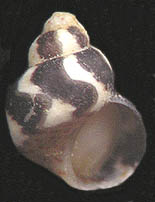
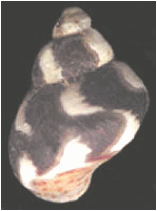
The color of the Eulithidium thalassicola shell is off-white to pinkish, but this base color is substantially obscured by opaque white and purplish axial bands. The shell is small but stocky, the body whorl dominant. The convex whorls decrease rapidly in size; the apex is fairly flat. The shell appears smooth (but there may be microscopic spiral threads, especially on the early whorls). The aperture is oval and the outer lip thin. There is a small umbilicus. There are 4 to 5 whorls and the sutures are distinct.
The operculum is oval, white, and thickened on the side near the columella, the other side has small ridges.
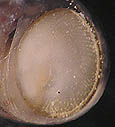
The live Eulithidium thalassicola is white in color. The antennae (there are 2 pair) are very long and white; they are bristled along the edges.
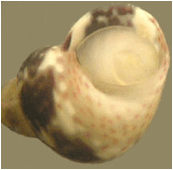
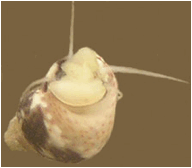
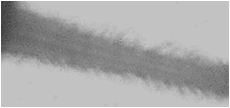
Close-up showing bristled antennae
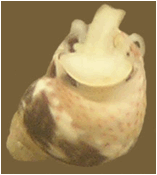
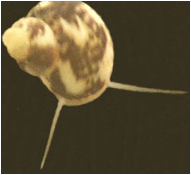
Eulithidium thalassicola emerging from shell and crawling
Similar species: Elachisina floridana (very fine spirals, shell clear); Eulithidium adamsi (pink or reddish dots); Eulithidium affine (larger); Eulithidium bellum (carinate cord)
Long Key: in grass beds
Key terminology choices: stocky, smooth, oval, minute, smooth, none, tall
References: Abbot, p. 62 (Tricolia thalassicola); Abbot and Morris, p. 142 (Tricolia thalassicola); Redfern, p. 10
Back
Eupleura sulcidentata
Sharp-Ribbed Drill
Key ID features: sharp varices, shape
Size: 13 to 25 mm
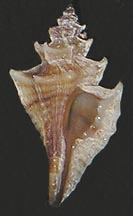
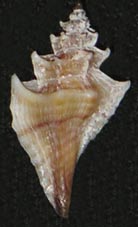
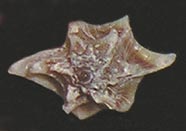
View
from top of Eupleura
sulcidentata
The color of the Eupleura sulcidentata shell is tan, yellowish-brown, or darker brown. The shell is strong, thin when viewed from above, and has two prominent varices with 2 (or 3) lower ribs between. The largest spiral cords, at the shoulders, form spines or nodules on the varices and ribs. The aperture is roughly oval (almost a tear-drop) with white teeth inside the outer lip. The interior is brown. The canal is of moderate length and somewhat closed. There are 7 to 8 whorls and the sutures are distinct.
The operculum is brown and an elongate oval.
The live Eupleura sulcidentata is yellowish-white. The antennae are white and moderately long.
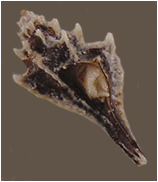
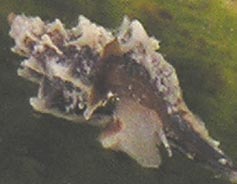
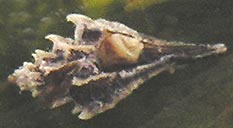
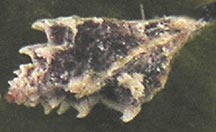
Eupleura sulcidentata emerging from shell and crawling
Long Key: in muddy grass beds, e.g., in Diplanthera bed at Caloosa Cove flat
Key terminology choices: kite, ribs dominant, oval, small, smooth, moderate, tall
References: Abbot, p. 188; Abbot and Morris, p. 212; Redfern, p. 89; Rehder, p.514
Back
Fasciolaria
lilium
Banded Tulip
Key ID features:
smooth below suture, brown lines
Size: 5 to 8 cm
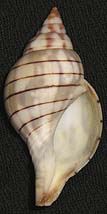
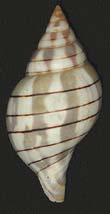

Close-up of smooth area below suture
The color of the Fasciolaria lilium shell is white to gray with narrow spiral lines of dark brown. The shell is of moderate size with convex whorls and a pointed apex. The shell is smooth except for spiral ridges on the base. The aperture is an elongated oval and the canal is fairly short and open. There are two ridges at the lower end of the columella. The outer lip is thin and the brown lines from the surface show through on the interior. There are 7 to 9 whorls and the sutures are distinct.
The operculum is an elongate tear-drop, strong, and brown.
The live Fasciolaria lilium is dark purple with white dots. The antennae are dark purple with white spots.
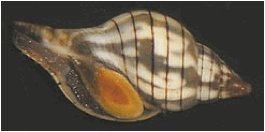
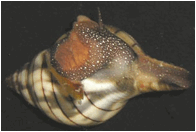
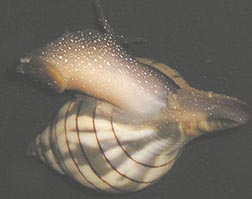
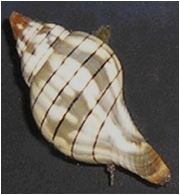
Fasciolaria lilium emerging from shell and crawling
Similar species: F. tulipa (wrinkled cords below suture)
Long Key:
Key terminology choices: fusiform, smooth, oval, large, fold, moderate, tall
References: Abbot, p. 228; Abbot and Morris, p. 232; Lee, p. 112; Rehder, p. 575
Back
Fasciolaria
tulipa
True Tulip
Key ID features:
wrinkled grooves below suture, size
Size: 7 to 20 cm
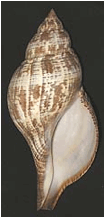
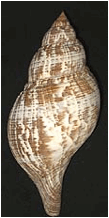

Close-up of wrinkled subsutural cords
The color of the Fasciolaria tulipa shell includes various shades of brown with white markings (and frequently spiral lines of dark brown). The shell is large and tall, with convex whorls. The shell has very low spiral features, the strongest below the suture and on the base. The spirals below the suture are wrinkled. The aperture is an elongated oval and the canal is of moderate length and open. There are two folds at the lower end of the columella. The outer lip is thin and the spirals end as small brown teeth (on mature shells). The numerous fine ridges on the interior of the outer lip extend deep into the shell. There are 7 to 9 whorls and the sutures are distinct.
The operculum is an elongate tear-drop, strong, and brown.
![]()
![]()
The live Fasciolaria tulipa is dark purple to black, with white spots on the body. The antennae are fairly short, dark purple with white spots.
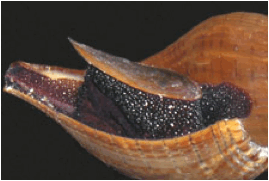
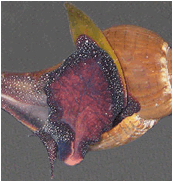
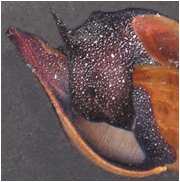
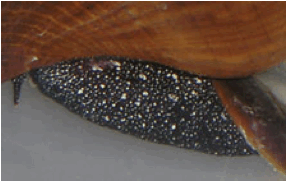
Fasciolaria tulipa emerging from shell and crawling
Similar species: F. lilium (smooth below suture)
Long Key: an aggressive predator found in many locations
Key terminology choices: fusiform, spirals, oval, very large, fold, moderate, very tall
References: Abbot, p. 227; Abbot and Morris, p. 233; Lee, p. 112; Redfern, p. 101; Rehder, p. 574
Back
Favartia
cellulosus
Pitted Murex
Key ID features:
wrinkles, varices
Size: 16 to 25 mm
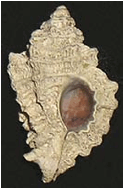
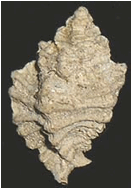
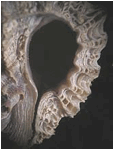
Close-up of crenulate outer lip, wrinkles, and closed canal
The color of the Favartia cellulosus shell is gray. The shell is stout with a low spire. There are 5 to 7 blunt varices with wrinkles between. There are 2 cords on the spire whorls and 5 to 7 on the body whorl. The aperture is fairly small and oval. The outer lip is crenulate and there are small ridges within. The interior is brown or purple. The canal is of moderate length, quite closed, and bent backward. There are 6 to 7 whorls and the sutures are distinct.
The operculum is tear-drop in shape and brown to purplish-brown in color.


The live Favartia cellulosus is yellowish-white. The antennae are of moderate length and yellowish-white.
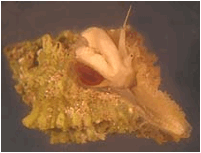
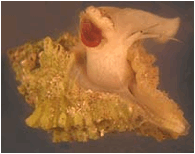
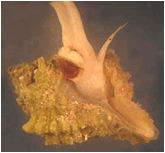
Favartia cellulosus emerging from shell
Long Key: shallow water in muddy areas
Key terminology choices: kite, ribs dominant, oval, small, smooth, moderate, tall
References: Abbot, p. 187 (F. cellulosa); Abbot and Morris, p. 208; Lee, p. 104; Rehder, p. 521 (F. cellulosa)
Back
Ficus communis
Common Fig Shell
Key ID features:
flat spire, large aperture
Size: 7 to 10 cm
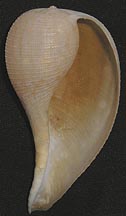
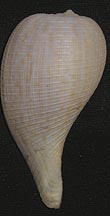
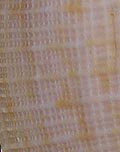
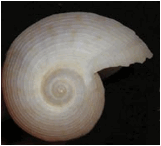
Close-up of body sculpture Close-up of view from top of shell
The color of the Ficus communis shell is white to yellow to tan (and often with small darker tan spots). The shell is thin and somewhat fragile, with a flat spire and a dominant body whorl. The spiral cords are somewhat stronger than the axial threads, but the overall effect is cancellate. The aperture is the same height as the shell and widest in the central portion. The interior is tan to brown. The canal is moderately long and open. The outer lip is thin. There are 4 to 5 whorls and the sutures are distinct.
Long Key:
Key terminology choices: triangular, spirals dominant, elongate, large, smooth, moderate, very tall
References: Abbot, p. 170; Abbot and Morris, p. 207; Lee, p. 82 (F. papyratia); Redfern, p. 60; Rehder, p. 505
Back
Finella adamsi
Adams’ Finella
Key ID features:
protoconch, shape
Size: 2.5 to 4 mm
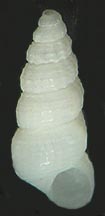

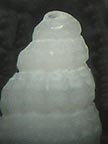
Close-up of protoconch
The color of the Finella adamsi shell is translucent/clear to white to yellowish. Shells sometimes have brown coloration, especially the apex. The shell is small in size; tall and slender in shape. The protoconch has 1+ whorls, the whorls initially quite large in size. The surface features of Finella adamsi are somewhat variable; fresh shells have a sculpture of ribs and cords giving a cancellate appearance. Beachworn shells are generally quite smooth. Former varices may be present. The aperture is oval; the outer lip thin . There are 7 to 8 whorls and the sutures are distinct.
Similar species: F. dubia (protoconch smaller and 2+ whorls)

F. dubia F. adamsi
Long Key:
Key terminology choices: slender, cancellate, oval, minute, smooth, none, very tall
References: Abbot, p. 108; Lee, p. 59; Redfern, p. 27
Back
Finella dubia
Dubious Finella
Key ID features:
protoconch, shape
Size: 2.5 to 3.5 mm


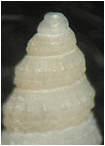
Close-up of protoconch
The color of the Finella dubia shell
is translucent/clear to white to yellowish. Shells sometimes have brown coloration, especially the
apex. The shell is small in size; tall and slender in shape. The protoconch has 2+ whorls, the first
whorls are quite small in size.
The surface features of Finella
dubia are somewhat variable; fresh shells have a sculpture of ribs and
cords giving a cancellate appearance.
Beachworn shells are generally quite smooth. Former varices may be present. The aperture is
oval; the outer lip thin . There
are 9 to 10 whorls and the sutures
are distinct.
Similar species: F. adamsi (protoconch larger and 1+ whorls)

F. dubia F. adamsi
Long Key:
Key terminology choices: slender, cancellate, oval, minute, smooth, none, very tall
References: Abbot, p. 108; Lee, p. 59; Redfern, p. 27
Back
Floridiscrobs dysbatus
Key ID features: eroded apex, color
Size: 2.5 to 3.5 mm
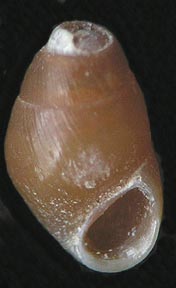
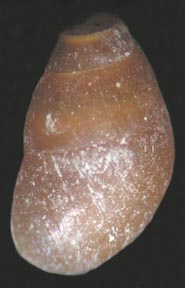
The color of the Floridiscrobs dysbatus shell is tan. The shell is strong, smooth, and ovate. The parietal wall is separated from the whorl by a distinct groove. The aperture is oval (or tear-drop) in shape; the outer lip is smooth and somewhat thickened. There are 2 to 3 whorls (the apex is generally eroded) and the sutures are moderately distinct.
Long Key:
Key terminology choices: stocky, smooth, oval, minute, smooth, none, tall
References: Abbot, p. 75
Back
Fossarus ambiguus
Variable Fossarus
Key ID features: size, cord and thread pattern
Size: 1.5 to 3 mm
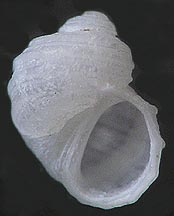
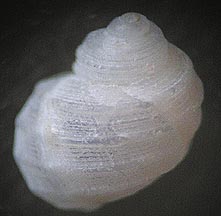
The color of the Fossarus ambiguus shell is translucent clear to white. The shell is small but strong, about as wide as high, and the body whorl dominant with a short spire. The whorls have prominent spiral cords (5 or 6 on the body whorl); between the cords are much smaller spiral threads. The aperture is oval (somewhat “D” shaped), the outer lip reflects the ends of the prominent cords. The umbilicus is of moderate size. There are 4 to 5 whorls (not counting the 3 whorl protoconch which is generally absent from beachworn shells) and the sutures are distinct.
Similar species: F. elegans (microscopic riblets)
Long Key:
Key terminology choices: stocky, spirals, half-moon, minute, smooth, none, equal
References: Abbot, p. 136 (Fossarus orbignyi); Redfern, p. 24
Back
Fossarus elegans
Elegant Fossarus
Key ID features:
size, microscopic riblets
Size: 1.4 to 3 mm
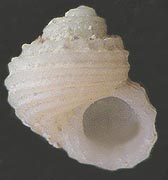
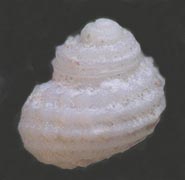
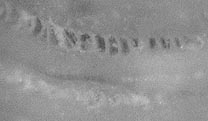
Close-up of riblets
The color of the Fossarus elegans shell is white to grayish. The shell is small but strong, about as wide as high, and the body whorl dominant with a short spire. The whorls have prominent spiral cords; between the cords are microscopic riblets. The aperture is rounded, the outer lip crenulate in young shells; somewhat thickened and less crenulate in mature shells. The umbilicus is of moderate size. There are 4 to 5 whorls and the sutures are distinct.
Similar species: F. ambiguus (fine spiral threads)
Long Key:
Key terminology choices: stocky, spirals, round, minute, smooth, none, equal
References: Abbot, p. 136; Abbot and Morris, p. 177
Back
Gibberula lavaleeana
Snowflake Marginella
Key ID features:
size, aperture, apex
Size: 2 to 3 mm
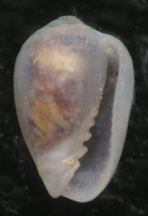
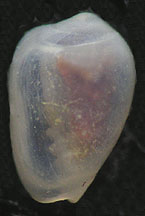
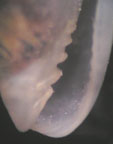
Close-up of lower portion of apeture
The color of the Gibberula
lavaleeana shell is translucent glassy to white. The shell is
glossy, smooth, rounded, and strong.
The spire is short and the apex enameled and rounded. The aperture is narrow and elongate (about 85% the height of the
shell). The outer lip is curled
inward and has many small teeth.
There are 3 (to 4) strong folds on the columella (and often 1 or 2 smaller
ones). There are 3 to 4 whorls and the sutures are difficult to
identify.
Similar species: G. sp. B (white band below shoulder); G. sp. C (more triangular shape); G. sp. D (lower teeth not parallel); G. sp. E (outer lip higher)
Long Key: near shore shallow water in algae
Key terminology choices: kite, smooth, elongate, minute, teeth, short, tall
References: Abbot, p. 251 (Marginella lavaleeana); Lee, p. 119; Redfern, p. 111 (Gibberula sp. A); Rehder, p. 601 (Marginella lavaleeana)
Back
Glyphoturris rugirima
Angular
Mangelia
Key ID features:
shape, ribs, notch
Size: 5 to 6 mm
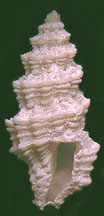
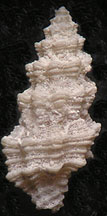
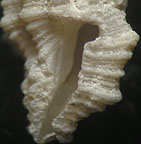
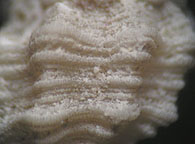
Close-up of aperture and notch Close-up of
ribs, cords, and threads
The color of the Glyphoturris rugirima shell is grayish white to gray. The shell is fusiform in shape with angular whorls. The ribs are extended and pointed at the shoulder. There are numerous spiral cords and smaller threads (whose grainy character gives fresh shells a “frosted” appearance). The strongest cords are at the shoulder and in the center of the body whorl. The aperture is narrow with a short canal. There is a prominent notch at the upper end. There are 9 to 11 whorls and the sutures are distinct.
Long Key: flat off Craig Key
Key terminology choices: fusiform, ribs dominant, narrow, tiny, smooth, short, very tall
References: Lee, p. 132; Redfern, p. 130
Back
Granulina ovuliformis
Teardrop Granulina
Key ID features:
aperture, size
Size: 1.5 to 2.5 mm
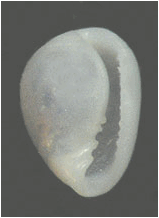
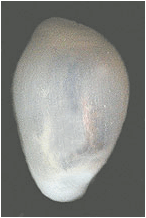
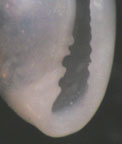
Close-up
of lower aperture
The color of the Granulina
ovuliformis shell is glassy to bluish white. The shell is
strong, smooth (fresh shells may be microscopically granulose), and
globular. The apex is covered by
the outer lip. The aperture is elongate, curved, and
narrow, the lip rising above the height of the shell. The inside of the thickened outer lip has numerous small
teeth. There are 3 (to 4) oblique
folds at the base of the columella.
Only the dominant body whorl is
easily visible.
The mantle of the live Granulina
ovuliformis is dark with opaque white markings. The tail has a clear
background and small opaque spots which are most numerous near the
midline. The antennae are long
with white markings. The siphon
has many opaque white spots.
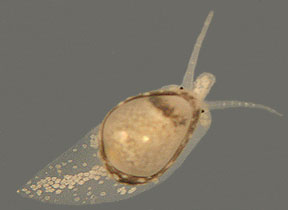
Live Granulina ovuliformis
Similar species: G. sp. B (body whorl more triangular); Genus Gibberula (lip not higher than shell)


G. ovuliformis, G. sp. B
Gibberula lavaleeana
Long Key: common in algae in shallow water
Key terminology choices: rounded, smooth, elongate, minute, teeth, short, tall
References: Abbot, p. 254; Abbot and Morris, p. 244; Lee, p. 120; Redfern, p. 113; Rehder, p. 604
BACK
Graphis menkhorsti
Menkhorst’s Graphis
Key ID features:
slender shape, spirals
Size: 2 to 2.5 mm


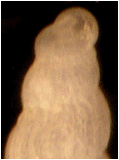
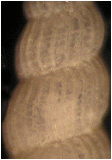
Close-up of apex Close-up of spirals
The color of the Graphis menkhorsti shell is white. The shell is tall and slender. There are numerous (20 to 24) smallish curved ribs. Spirals are quite apparent above the suture, but disappear below the suture. The protoconch is rounded and glassy. The aperture is oval, the outer lip thin. There are 6 to 8 whorls and the sutures are distinct.
Similar species: G. underwoodae (shell more robust, protoconch tilted)

G. underwoodae; G. menkhorsti
Long Key: dead shell in sand off Caloosa Cove
Key terminology choices: slender, ribs dominant, oval, minute, smooth, none, very tall
References: Lee, p. 99; Redfern, p. 79
BACK
Graphis
underwoodae
Underwood’s Graphis
Key ID features:
robust body shape, spirals above suture
Size: 2 to 2.5 mm
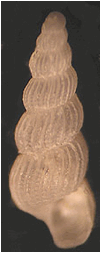
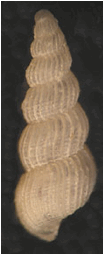
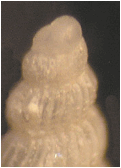
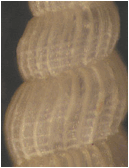
Close-up of apex
Close-up of spirals
The color of the Graphis
underwoodae shell is white. The shell is tall
and moderately slender. There are
numerous (22 to 26) smallish curved ribs.
Spirals are quite apparent above the suture, but disappear below the
suture. The protoconch is slightly
tilted and glassy and about 1.5 whorls. The aperture is oval, the outer lip thin. There are 6 to 7 whorls
and the sutures are distinct.
Similar species: G. menkhorsti (shell more slender, protoconch not tilted)

G. underwoodae; G. menkhorsti
Long Key: dead shell in sand off Caloosa Cove
Key terminology choices: slender, ribs dominant, oval, minute, smooth, none, very tall
References: Abbot, p. 132 (Aclis underwoodae); Lee, p. 99; Redfern, p. 79
Back
Haminoea antillarum
Antillean Paper Bubble
Key ID features:
lip arises on right, microscopic sculpture
Size: 4 to 6 mm
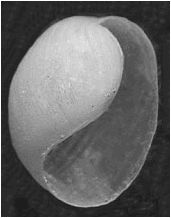
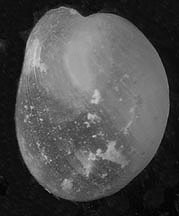
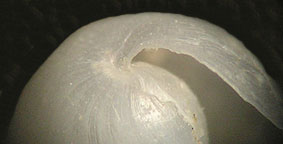
Close-up showing lip arising on right side
The color of the Haminoea
antillarum shell is glassy to white (often with a greenish tint when
fresh). The shell is fragile and globose. The surface has numerous (microscopic) spiral grooves
and equally fine angled growth lines.
The aperture is elongate and
quite large with the lip rising higher than the shell. The outer lip is thin and the base is
rounded. The lip arises on the
right side of the apical perforation.
Only the body whorl is
visible.
The live Haminoea antillarum is
greenish/white with greenish/black dots and splotches (and a few orange
spots). The orange dots may
be seen through the shell. The
animal does not fit inside the shell.
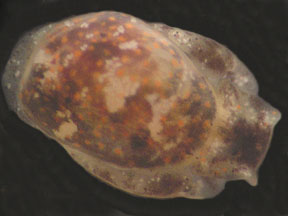
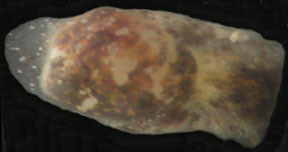
Haminoea antillarum in shell and in motion
Similar species: H. elegans (larger, lip arises on the left); Genus Atys (shells more slender and elongate)
Long Key: in sand and algae in shallow water
Key terminology choices: rounded, smooth, elongate, small, smooth, none, tall
References: Abbot, p. 320; Abbot and Morris, p. 268; Lee, p. 156; Redfern, p. 156
Back
Haminoea elegans
Elegant Paper Bubble
Key ID features:
incised lines, lip rising on left
Size: 10 to 17 mm
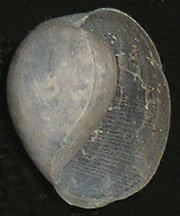
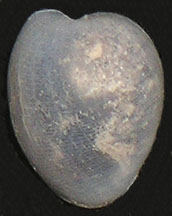
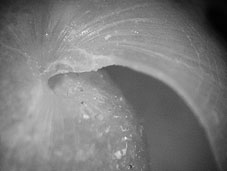
Close-up showing lip arising on left side
The color of the Haminoea elegans
shell is glassy to white. The shell is fragile and globose. The surface has numerous
(microscopic) spiral grooves. The aperture is elongate and quite large
with the lip rising higher than the shell. The outer lip is thin and the base is rounded. The lip arises on the left side of the
apical perforation. Only the body whorl is visible.
Similar species: H. antillarum (smaller, lip arises on the right)
Long Key: in sand and algae in shallow water
Key terminology choices: rounded, smooth, elongate, small, smooth, none, tall
References: Abbot, p. 320; Abbot and Morris, p. 268; Lee, p. 156; Redfern, p. 156
Back
Haminoea succinea
Conrad’s Paper Bubble
Key ID features:
lip arises on right, sculpture, shape
Size: 8 to 12 mm
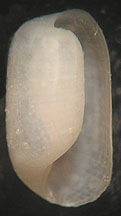
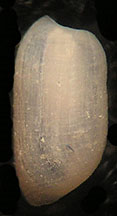
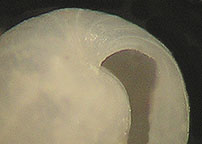
Close-up
showing lip arising on right side
The color of the Haminoea
succinea shell is glassy to white.
The shell is fragile and
barrel-like (the body whorl only slightly convex). The surface has numerous (microscopic) spiral grooves
and equally fine growth lines. The
aperture is elongate with the lip
rising higher than the shell. The
outer lip is thin and the base is rounded. The lip arises on the right side of the apical perforation. Only the body whorl is visible.
Similar species: Genus Atys (lip arises from center of the spire)
Long Key:
Key terminology choices: barrel, smooth, elongate, tiny, fold, none, tall
References: Abbot, p. 320; Abbot and Morris, p. 268; Lee, p. 156; Redfern, p. 157
BACK
Henrya henryi
Henry’s Ebalid
Key ID features:
size, axial lines
Size: 1 mm
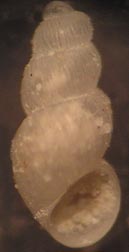
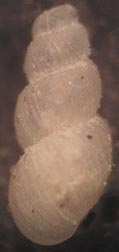
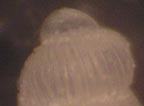
Close-up of protoconch and axial lines
The color of the Henrya henryi shell
is translucent glassy to white.
The shell is smooth (except
for microscopic axial lines), small, and fragile. The whorls are convex.
The small rounded protoconch is tilted and the tip immersed. The aperture is oval in shape with a thin outer lip. There are 3 to 5 whorls and the sutures are distinct.
Similar species: Careliopsis octona (shell smooth); Murchisonella spectrum (grooves below shoulder, smooth above); Genus Stylopsis (fine spiral grooves)
Long Key:
Key terminology choices: slender, smooth, oval, minute, smooth, none, very tall
References: Redfern, p. 151
Back
Angiola lineata
Dwarf Atlantic Planaxis
Key ID features:
color pattern, ridged outer lip
Size: 6 to 10 mm
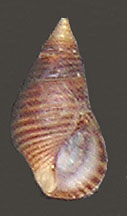
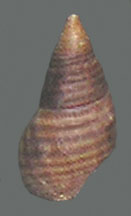
The color of the Angiola lineata shell is yellowish-white with spiral bands of brown. The early adult whorls are yellowish-white. The nuclear whorls (often broken off) are brown. The shell is strong with a moderately tall spire and a pointed apex. There are low spiral cords on the early whorls and on the base. The aperture is oval. The sharp, but strong, outer lip has low ridges within. The inside of the outer lip reflects the surface color pattern while the interior of the aperture is white. The columella is curved and there is a very short canal. There are 8 to 10 whorls; the lower sutures are distinct, the early sutures very difficult to discern.
The operculum is brown and tear-drop in shape.
The live Angiola lineata is dark in
color (with some light patches).
The antennae are long and quite slender, with considerable dark
coloration against a whitish background.
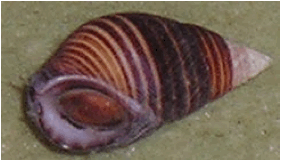
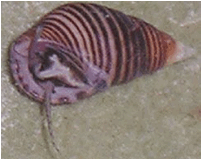
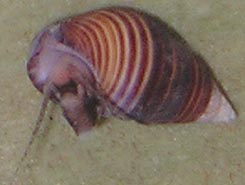
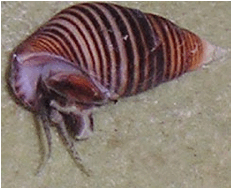
Hinea lineata emerging from shell
Long Key:
Key terminology choices: stocky, smooth, oval, tiny, smooth, short, very tall
References: Abbot, p. 102 (Planaxis lineatus); Abbot and Morris, p. 161 (Angiola lineata); Redfern, p. 24 (Hinea lineata); Rehder, p. 432 (Planaxis lineatus)
Back
Hipponix antiquatus
White Hoof Shell
Key ID features: cap
shape, foliations
Size: 12 to 19 mm
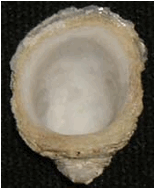
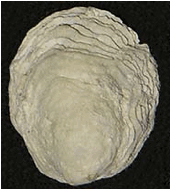
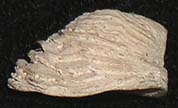

Close-up of the apices of three shells
The color of the Hipponix antiquatus shell is white to grayish-white. The shell is solid, round to oval, and cap-shaped (shape is dependent on the substrate to which the shell is attached). The apex is generally somewhat curled and eroded. The surface has concentric foliations (beach-worn shells may be worn smooth; mature shells are often encrusted). The aperture is open with a horseshoe-shaped muscle scar.
Long Key:
Key terminology choices: rounded, spirals, open, small, none, none, wide
References: Abbot, p. 135; Abbot and Morris, p. 177; Lee, p. 75; Redfern, p. 47; Rehder, p. 458 (Antisabia antiquata)
Back
Hyalina pallida
Pale Marginella
Key ID features:
aperture height, columella curve
Size: 9 to 13 mm
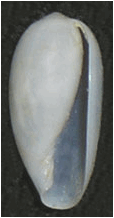
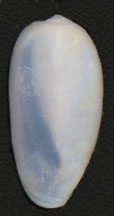
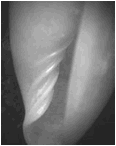
Close-up of lower portion of columella
The color of the Hyalina pallida shell is clear/white. The shell is smooth and rather thin, the sides convex. The spire is very low and the apex bluntly rounded. The aperture is elongate (95% the height of the shell) and narrow (wider below). The outer lip is thin and rounded at the base. There are 4 teeth on the columella. There are 5 to 6 whorls (body whorl is dominant) and the sutures are fairly difficult to identify.
The live Hyalina pallida is clear with opaque white and orange markings. The antennae are moderately long, tapered, and clear with dark white bands. The siphon is clear with opaque white and orange markings.
Similar species: H. Sp. A (columella straighter, teeth more separated, outer lip with lower point of attachment)
Long Key:
Key terminology choices: rounded, smooth, elongate, small, teeth, short, very tall
References: Abbot, p. 253; Lee, p. 121; Redfern, p. 105
Back
Prunum succinea
Velie’s Marginella
Key ID features:
outer lip pushed in, high spire
Size: 7 to 12 mm
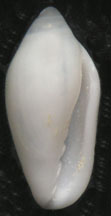
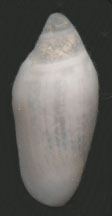
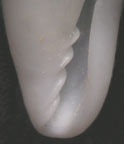
Close-up of lower portion of columella
The color of the Prunum succinea shell is white. The shell is solid and polished, with a moderate spire and a bluntly rounded apex. The aperture is elongate and narrow, 2/3 the height of the shell. There are 4 (occasionally 3) distinct folds on the bottom portion of the columella. The outer lip is thickened and slightly “pushed in” in the central portion. There are 4 to 5 whorls and the sutures are moderately distinct.
The live Prunum succinea is white with black markings and some brown/orange spots. The antennae are long, slender, and much tapered; clear below, white at the top. The siphon is white with orangish spots.
Long Key:
Key terminology choices: kite, smooth, elongate, tiny, teeth, short, very tall
References: Abbot, p. 252 (Hyalina veliei); Abbot and Morris, p. 247 (Hyalina veliei)
Back
Iniforis turristhomae
St.
Thomas Triphora
Key ID features:
dark beads, former canal, protoconch
Size: 5 to 7 mm



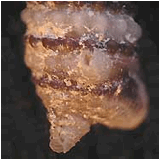
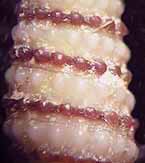
Close-up of protoconch Close-up of back of body
whorl
Close-up of beads
The color of the Iniforis
turristhomae shell is white or cream, the lower row of beads (and
interspaces) reddish-brown. The shell is tall and slender with
flat-sided whorls, a high spire, and sharp apex (with a brown protoconch of 4.5
ribbed whorls). There are two rows
of rounded beads per whorl. The
last whorl envelops the canal (and there is generally a “third canal” on the
back side of the shell). The aperture is sinistral, round, and
fairly small. There are 12 to 16 whorls and the sutures are moderately
distinct.
The live Iniforis turristhomae is
clear/white with orange and white spots.
The front of the foot is blunt and slightly rounded. The antennae are clear, moderately
long, and slightly tapered.
Similar species: Cosmotriphora melanura (shell white, 3 rows of beads); Latitriphora albida (3 rows of elongated beads, brownish color axial and narrow); Marshallora modesta (3 rows of beads, shell brown in color); Notitriphora decorata (3 rows of beads, reddish-brown color is irregular)
Long Key: dead shells at Calossa patch reef
Key terminology choices: slender, beaded, round, tiny, smooth, short, x tall
References: Abbot, p. 111 (Triphora turristhomae); Abbot and Morris, p. 169 (Triforis turristhomae); Redfern, p. 66; Rehder, p. 447 (Triphora turristhomae)
BACK
Ithycythara lanceolata
Spear Mangelia
Key ID features:
shape, brown, nodules Size: 8 to 10 mm


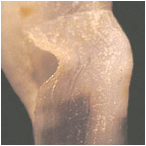
Close-up of notch
The color of the Ithycythara lanceolata shell is white to tan, with a row of brown splotches (sometimes a solid band of brown). The shell is tall and slender with 6 (to 8) ribs which are lined up from whorl to whorl. Each rib has a small nodule at the widest point. The aperture is narrow, the columella straight, and the outer lip thin with low ridges within. There is a notch at the upper end. The canal is short and open. There are 7 to 10 whorls and the sutures are distinct.
The live Ithycythara lanceolata is white with a few darker spots. The antennae are fairly short. The siphon is white with a few darker spots.
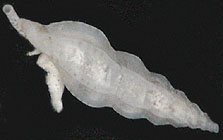
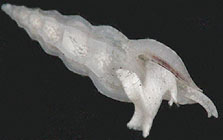


Ithycythara lanceolata emerging from shell and crawling
Long Key: flat off Caloosa Cove
Key terminology choices: slender, ribs dominant, narrow, tiny, smooth, short, very tall
References: Abbot, p. 282; Lee, p. 132; Redfern, p. 131
Back
Ividia havanensis
Havana Odostome
Key ID features: row of beads, shape
Size: 1.8 to 2.5 mm
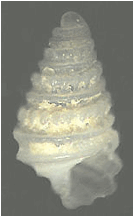
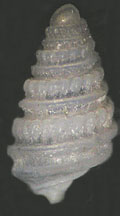
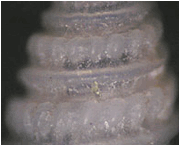
The color of the Ividia havanensis shell is clear/glassy to white. The shell is sculptured by two strong spiral cords, the upper one strongly beaded (the beads axially elongated), the lower one with small beads (to almost smooth). The protoconch is smooth, rounded, and tilted at a 45 degree angle. The aperture is roughly oval; the outer lip is thin and reflects the ends of the cords. There is a low fold on the columella. There are 5 to 7 whorls and the sutures are difficult to identify.
Similar species: Folinella robertsoni (more cancellate); Pseudoscilla babylonia (cords smooth); Eulimastoma didymum (cords smooth); Oscilla somersi (three flat cords)
Long Key:
Key terminology choices: slender, beaded, oval, minute, fold, none, very tall
References: Redfern, p. 144
Back
Folinella robertsoni
Havana
Odostome
Key ID features: small beads, shape
Size: 1.8 to 2.5 mm
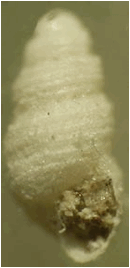
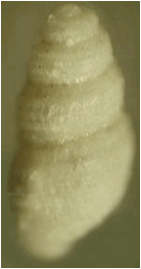
The color of the Folinella robertsoni shell is clear/glassy to white. The shell is sculptured by four weak spiral cords on the upper whorls. Cords are crossed by axial ribs creating small beads (and a cancellate appearance). The protoconch is a single whorl with the tip immersed; top of shell flattened. The aperture is rounded below; the outer lip is thin. There is a low fold on the columella. There are 4 to 6 whorls and the sutures are easy to identify.
Similar species: Ividia havanensis (two beaded cords); Pseudoscilla babylonia (cords smooth); Eulimastoma didymum (cords smooth); Oscilla somersi (three flat cords)
Long Key:
Key terminology choices: slender, beaded, oval, minute, fold, none, very tall
References: Redfern, p. 144
Back
Janthina globosa
Rotund Janthina
Key ID features:
angle at base of aperture, dark color
Size: 10 to 17 mm
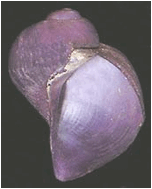
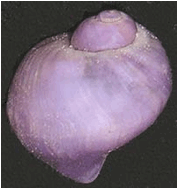
The color of the Janthina globosa shell is medium to dark purple. The shell is thin and fragile, with a low spire and rounded whorls. There are very fine oblique axial lines. The aperture is large and oval. The base of the aperture is sharply angled and the outer lip is thin. The umbilicus is virtually covered by the inner edge of the aperture. There are 3 to 5 whorls and the sutures are distinct.
Similar species: J. janthina (light over dark color, whorls more angled); J. pallida (lighter color, base of aperture more rounded)

J. pallida, J.
globosa, J. janthina
Long Key: in beach drift, especially in winter
Key terminology choices: stocky, smooth, oval, small, smooth, none, equal
References: Abbot, p. 113; Abbot and Morris, p.
175; Redfern, p. 76
Back
Janthina janthina
Common Janthina
Key ID features: thin shell, dark purple below periphery
Size: 15 to 33 mm
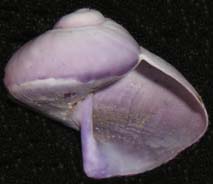
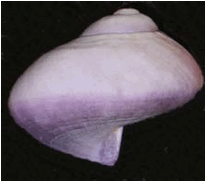
The color of the Janthina janthina shell is light purple (to almost white) above periphery, darker purple below. The shell is quite thin and moderately fragile. The body whorl is somewhat angled at the periphery giving the overall shell a somewhat flattened appearance. There are fine spirals on the base and barely visible oblique growth lines on the upper whorls. The umbilicus is generally covered by the columella callus (although less so in younger shells). The aperture is large and rounded, the outer lip is thin. There are 3 to 4 whorls and the sutures are slightly channeled and therefore distinct.
The live Janthina janthina is purplish. The antennae are long, moderately slender, and colorless.
Similar species: J. globosa (uniform darker color, whorls more rounded); J. pallida (lighter color, whorls more rounded)

J. pallida, J.
globosa, J. janthina
Long Key: in beach drift, especially in winter
Key terminology choices: stocky, smooth, oval, medium, smooth, none, equal
References: Abbot, p. 113; Abbot and Morris, p. 176; Redfern, p. 75; Rehder, p. 448
Back
Janthina pallida
Pale Janthina
Key ID features:
rounded base of aperture, light color
Size: 10 to 20 mm
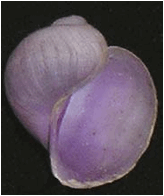
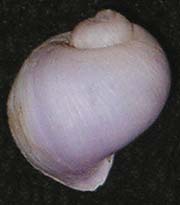
The color of the Janthina pallida shell is light purple. The shell is thin and fragile, with a low spire and rounded whorls. There are very fine oblique axial lines. The aperture is large and oval. The base of the aperture is rounded and the outer lip is thin. The umbilicus is virtually covered by the inner lip of the aperture. There are 4 to 5 whorls and the sutures are slightly channeled and therefore quite distinct.
Similar species: J. globosa (darker color, pointed lower aperture); J. janthina (light over dark color, body whorl more flattened)

J. pallida, J.
globosa, J. janthina
Long Key: in beach drift, especially in winter
Key terminology choices: stocky, smooth, oval, medium, smooth, none, equal
References: Abbot, p. 113; Abbot and Morris, p.
176; Redfern, p. 76
Back
Jaspidella jaspidea
Jasper Dwarf Olive
Key ID features:
shape, color, ridges Size: 19 to 25 mm
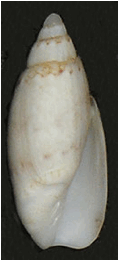
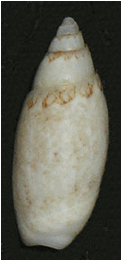
The color of the Jaspidella jaspidea shell is cream white with dark brown markings below the sutures and scattered light brown elsewhere. The shell is smooth and polished. The spire is pointed, but the apex is bluntly rounded. The aperture is nearly 2/3 the height of the shell, wider below, with a thin, but strong, outer lip. There are 8 to 12 ridges on the inner lip (with the lower 3 or 4 the largest). There are 5 to 7 whorls and the sutures are channeled and distinct.
The live Jaspidella jaspidea is white with brown spots and splotches. The head of the animal is bifurcate.
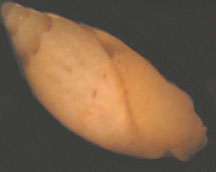
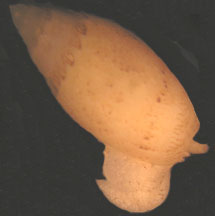
Jaspidella jaspidea emerging from shell and crawling
Long Key: in Thalassia bed at flat off Caloosa Cove
Key terminology choices: fusiform, smooth, elongate, medium, teeth, short, very tall
References: Abbot, p. 233; Abbot and Morris, p. 236; Rehder, p. 586
Back
Cerithiopsis academicorum
Academy Cerithiopsis
Key ID features:
protoconch, size, shape
Size: 1.5 to 2.5 mm

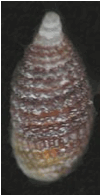
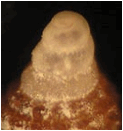

Close-up of protoconch Close-up of beads on lower whorls
The color of the Cerithiopsis academicorum shell is reddish brown. The shell is ovate and stubby with a protoconch of 4 smooth, rounded, brownish whorls (although the protoconch bleaches to white in beachworn shells). There are 3 rows of rounded glassy beads per whorl (the top row reduced in size on the early whorls). The beads are connected by axial ribs and spiral cords. There are one or two ridges on the base. The aperture is oval and the outer lip thin. There are 8 to 10 whorls and the sutures are rather difficult to identify.
Long Key:
Key terminology choices: slender, beaded, oval, minute, smooth, short, very tall
References: Redfern, p. 73 (Joculator academicorum); Lee, p. 85
Back
Cerithiopsis lata
Stubby Cerithiopsis
Key ID features:
protoconch, brown band
Size: 3 to 4 mm


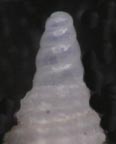
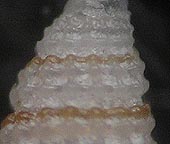
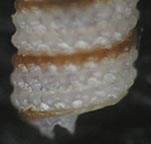
Close-up of protoconch Close-up of beads on early whorls Close-up of beads near base
The color of the Cerithiopsis lata shell is white to cream, with a brown subsutural band. There is also a beaded brown subperipheral cord. The shell is ovate and somewhat stubby with a protoconch of 4+ smooth, rounded, clear whorls. There are 3 rows of rounded glassy beads per whorl (although one row may be quite reduced on the early whorls). The aperture is oval and the outer lip thin. There are 11 to 12 whorls and the sutures are moderately distinct (but their location is made evident by the brown band).
The live Cerithiopsis lata is yellowish with a few white spots. The antennae are clear and moderately long.
Similar species: Cerithiopsis vicola (protoconch of 2.5 whorls)
Long Key:
Key terminology choices: slender, beaded, oval, minute, smooth, short, very
tall
References: Redfern, p. 74
Back
Kurtziella atrostyla
Brown-tipped
Mangelia
Key ID features:
brown on columella, punctate threads
Size: 6 to 7 mm


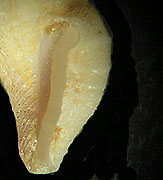
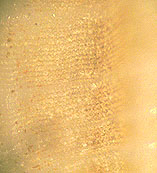
Close-up showing brown
columella and notch Close-up showing punctate
spiral threads
The color of the Kurtziella atrostyla
shell is white (usually with a brown band below the suture and brown spots
on the outer lip). The shell is fusiform with a high spire and
pointed apex. There are 9 (to 12)
ribs which are angled at the periphery.
The surface is densely covered with punctate spiral threads (the
punctate character requiring magnification). The aperture is
narrow with a rounded notch at the upper end. The columella is stained brown. There is a varix behind the outer lip and the canal is short
and open. There are 7 to 9 whorls and the sutures are distinct.
Similar species: Agathotoma candidissima (no brown on columella)
Long Key:
Key terminology choices: fusiform, ribs dominant, narrow, tiny, smooth, short, very tall
References: Abbot, p. 281
Back
Laemodonta cubensis
Cuban Dwarf Pedipes
Key ID features:
teeth, apex
Size: 2 to 4 mm
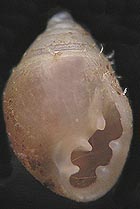
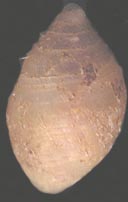
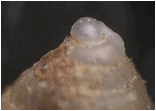
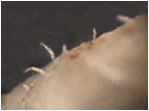
Close-up of apex Close-up of bristled periostracum
The color of the Laemodonta cubensis shell is straw-yellow to light brown. The shell is ovate with a high spire. The protoconch is tilted and the tip embedded, giving the apex an asymmetric appearance. There are numerous spiral grooves on the larger whorls. The aperture is narrow, the base rounded, with 3 strong teeth on the inner lip. Mature shells have two teeth on the interior of the outer lip. There are 5 to 7 whorls and the sutures are moderately distinct.
Similar species: Pedipes mirabilis (upper tooth larger, apex rounded, no large teeth on outer lip)
Long Key: under and in intertidal debris
Key terminology choices: stocky, spirals, narrow, minute, teeth, short, tall
References: Abbot, p. 333; Lee, p. 159; Redfern, p. 186; Rehder, p. 650
Back
Hemipolygona
macgintyi
McGinty’s Latirus
Key ID features:
folds on columella, umbilicus
Size: 25 to 62 mm
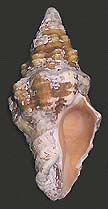
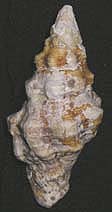
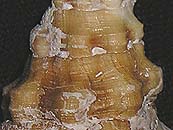
Close-up of knobs
and spiral cords
The color of the Hemipolygona macgintyi shell is cream to yellow to yellow-brown. The shell is very heavy with a pointed apex. There are 7 (to 9) large knobs at the shoulders; the axial features are crossed by spiral cords and fine spiral threads. The umbilicus is funnel-shaped. The aperture is suboval with a canal of moderate length. The interior of the aperture is yellowish-orange and there are two small folds on the lower portion of the columella. There are 8 to 9 whorls and the sutures are distinct.
Note: the reference sources are not in agreement as to whether this is a separate species or only a form of L. cariniferus
Similar species: Leucozonia nassa (4 folds on columella, lacks funnel-shaped umbilicus)
Long Key: dead shells from Channel 5 Bay side flat
Key terminology choices: fusiform, ribs dominant, oval, large, teeth, moderate, tall
References: Abbot, p. 226 (L. cariniferus macgintyi); Abbot and Morris, p. 231 (Latirus macgintyi)
Back
Latitriphora albida
Pale
Triphora
Key ID features:
elongated beads, sinistral
Size: 8 to 11 mm


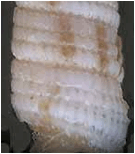
Close-up of beads on larger whorls
The color of the Latitriphora albida shell is cream to gray, mottled with patches of brown that are usually one or two beads wide and run from suture to suture. The base is light brown to tan. The shell is tall and very slender with flat-sided whorls, a high spire, and sharp apex. There are two rows of beads on the upper whorls and 3 rows on the lower whorls (although the center row remains smaller). The beads on the larger whorls are slightly flattened and elongate. The beads are “connected” with axial and spiral cords. The aperture is sinistral and oval. The short canal is closed and recurved. There are 13 to 17 whorls and the sutures are difficult to identify.
Similar species: Cosmotriphora melanura (shell white, rounded beads), Iniforis turristhomae (2 rows of rounded beads, lower row brownish-red); Marshallora modesta (rounded beads, brown in color); Nototriphora decorata (rounded beads, color pattern irregular)
Long Key:
Key terminology choices: slender, beaded, oval, tiny, smooth, short, x tall
References: Lee, p. 89; Redfern, p. 67
Back
Leucozonia nassa
Chestnut Latirus
Key ID features:
heavy shell, 4 folds, yellowish aperture
Size: 37 to 62 mm
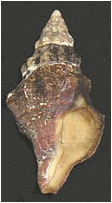
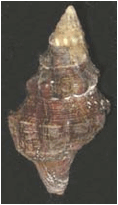

Close-up of columella
The color of the Leucozonia nassa shell is dark (“chestnut”) brown. The shell is heavy with a high pointed spire. There are 9 (to 10) large nodules on the whorl shoulder, and cords (those on the upper part of the knobs and the one midway on body whorl the strongest) and faint spiral threads. The aperture is oval and yellowish/tan within. There are 3 or 4 folds on the lower part of the columella. The outer lip is thin with numerous ridges within. The canal is of moderate length and open. There are 8 to 10 whorls and the sutures are moderately distinct.
The operculum is strong, brown, and slightly twisted tear-drop in shape.

![]()
The live Leucozonia nassa is red with some white spots. The antennae are fairly short.
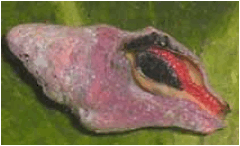
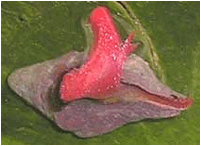
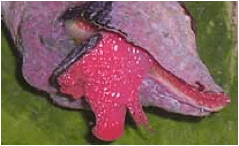
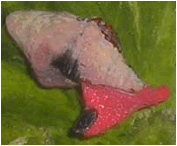
Leucozonia nassa emerging from shell
Similar species: Hemipolygona macgintyi (two teeth on columella, funnel-shaped umbilicus)
Long Key: flat off Caloosa Cove
Key terminology choices: fusiform, ribs dominant, oval, large, teeth, moderate, tall
References: Abbot, p. 226; Abbot and Morris, p. 230; Lee, p. 113; Redfern, p. 573; Rehder, p. 573
Back
Lithopoma
americanum
American Star Shell
Key ID features: shape,
knob and rib pattern
Size: 24 to 35 mm
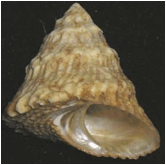
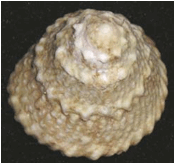
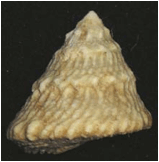
The color of the Lithopoma americanum shell is white, but the surface color is often gray, greenish, or pink due to the growth of organisms on the shell. The shell is triangular in shape and there are many weak wavy axial ribs which terminate in knobs. The base of the shell is flattened with 5 to 8 spiral cords. The aperture is rounded; the outer lip is angled and often crenulate due to the spiral cord pattern on the base. There are 6 to 8 whorls and the sutures are not clearly defined.
The operculum is thick, white, and convex.


Underside Topside
The live Lithopoma americanum is rather drab in appearance. The animal is yellowish-white with dark brown lines and circles. The antennae are long and slender, bristled, and have brownish markings.
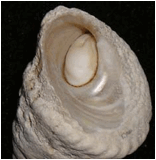
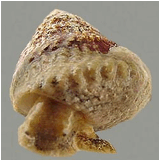
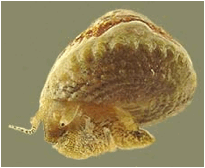
Lithopoma americanum in shell and emerging from shell
Note: immature shells of Lithopoma americanum can be mistaken for those of Astralium phoebium since the knobs are more pointed and spine-like
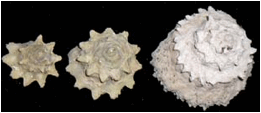
Immature shells of size 5 mm, 8 mm, and 12 mm
Long Key: very abundant in grass beds in shallow water
Key terminology choices: triangular, beaded, oval, medium, smooth, none, equal
References: Abbot, p. 59 (Astraea tecta americana); Abbot and Morris, p. 141 (Astraea americana); Lee, p. 56; Rehder, p. 300 (Astraea tecta americana)
BACK
Litiopa melanostoma
Brown Sargassum Snail
Key ID features:
ridge, shape, nuclear whorls sculpture Size: 5 to 7 mm
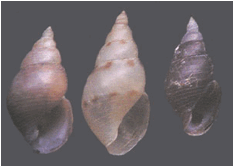
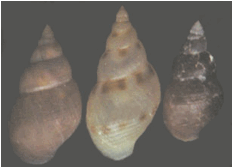
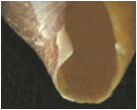
Close-up of ridge at base
The color of the Litiopa
melanostoma shell is white to light brown to dark brown, sometimes with
brown spots. The shell is thin but strong, with a tall
spire and pointed apex. The adult
whorls have incised threads. The
nuclear whorls have low riblets and microscopic cords. The aperture is an elongate oval, the outer lip thin. There is a strong ridge near the base
of the columella. There are 8 to 9
whorls which increase rapidly in
size and the sutures are distinct.
The live Litiopa melanostoma is
yellow with some darker brown areas. The antennae are moderately long and clear
with some yellowish coloration.
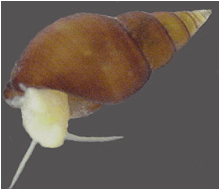
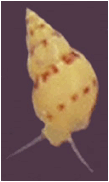

Litiopa melanostoma emerging from shell and crawling
Long Key: pelagic on Sargassum
Key terminology choices: slender, smooth, oval, minute, fold, none, tall
References: Abbot, p. 108; Abbot and Morris, p. 166; Lee, p. 59; Redfern, p. 22; Rehder, p. 441
Back
Littoraria angulifera
Angulate Periwinkle
Key ID features:
strong thin shell, spirals, strong cord
Size: 25 to 37 mm
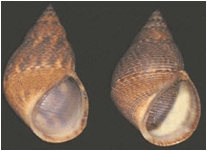
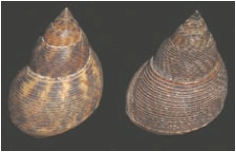

Close-up of strong spiral cord on lower portion of body whorl
The color of the Littoraria angulifera shell is quite variable: gray, red, yellowish, or purplish. The shell is thin but strong. It is somewhat stocky, having rounded whorls that decrease considerably in size leading to a sharp apex. There are many small spiral cords and grooves, with a strong cord on the lower portion of the body whorl. The aperture is suboval; the outer lip is thin. The columella is brownish-purple. There are 6 to 9 whorls and the sutures are distinct (slightly channeled).
The operculum is very thin, paucispiral, tear-drop shape, and pale to dark brown.


The live Littoraria angulifera is dark green (to almost black). The antennae are long, slender, and dark green. The siphon is short.
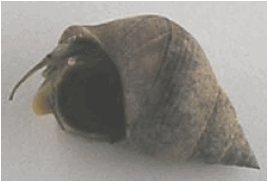
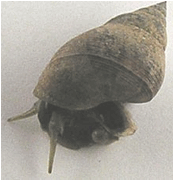
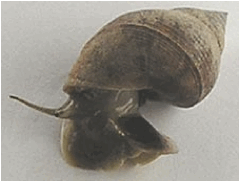
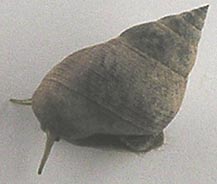
Littoraria angulifera emerging from shell and in motion
Long Key: on mangroves, just above tide line
Key terminology choices: stocky, spirals, oval, medium, smooth, none, tall
References: Abbot, p. 69 (Littorina angulifera); Abbot and Morris, p. 146 (Littorina angulifera); Lee, p. 61; Redfern, p. 27; Rehder, p. 405 (Littorina scabra angulifera)
Back
Lodderena ornata
Ornate Lodderena
Key ID features: size, ridges
Size: .7 to .9 mm
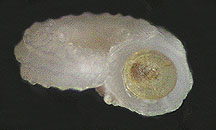
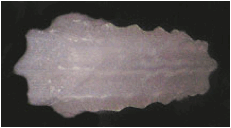
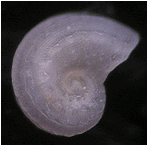
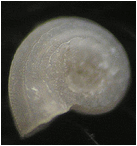
The color of the Lodderena ornata shell is glassy to white to yellowish. The shell is extremely small, quite solid, and flattened into one plane. The spire is depressed, the umbilicus shallow. There are 3 strong cords (the center one the largest) on the periphery and another cord between those and the suture. Cords vary in the degree to which they are beaded. The aperture is round. There are 2 to 3 whorls and the sutures are distinct.
The operculum is round, thin, and yellowish.

Similar species: Cyclostremiscus cf. jennae (apex not depressed, cords not beaded); Cyclostremiscus suppressus (apex not depressed, cords not beaded); Orbitestella bermudezi (aperture not round, cords not as strong)
Long Key:
Key terminology choices: flattened, spirals, round, minute, smooth, none, wide
References: Redfern, p. 16
Back
Lucapina sowerbii
Sowerby’s
Fleshy Limpet
Key ID features:
alternating rib size, white around keyhole
Size: 18 to 20 mm
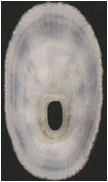
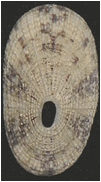


Side
profile
Close-up of alternating ribs
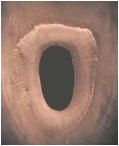
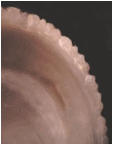
Closeup of keyhole (interior view) Close-up of margin crenulations
The color of the Lucapina
sowerbii shell is buff to tan with rays of darker brown. The shell is low to moderately elevated, oblong with rounded ends. There are 60 ribs with every other one
somewhat larger. There are strong
concentric rings. The aperture is open and the interior is
white. The margin of the shell
is finely crenulate.
The live Lucapina sowerbii is cream
with orange/brown spots. The
animal is larger than the shell. The antennae are moderately long and
tapered. Antennae are whitish with
a few orange markings.
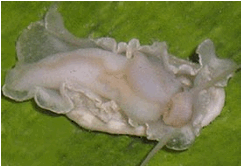
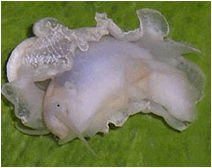
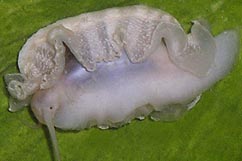
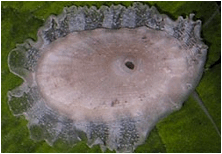
Lucapina sowerbii working to right itself and with mantle extended
Similar species: L. suffusa (keyhole lined in black, margin more crenulate), Diodora species (shells more solid, pit in front of keyhole callus)
Long Key: on undersides of rocks in shallow water
Key terminology choices: rounded, ribs dominant, open, medium, none, none, very wide
References: Abbot, p. 25; Abbot and Morris, p. 128; Redfern, p. 7; Rehder, p. 352
Back
Lucapina suffusa
Cancellate Fleshy Limpet
Key ID features:
stained keyhole, alternating rib size
Size: 19 to 37 mm
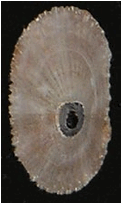
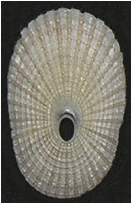

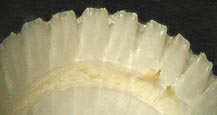
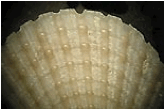
Close-up of crenulations at shell edge Close-up of ribs
The color of the Lucapina suffusa shell is gray to white to pinkish or olive. The shell is oblong and moderately elevated with rounded ends. There are prominent ribs, between each of which is a smaller rib. The ribs are crossed by concentric threads forming knobs on the ribs. The keyhole is oval. The interior is white to pinkish and the keyhole is stained blue/black. The edge of the margin has pronounced crenulations.
The live Lucapina suffusa is very colorful, the animal being bright orange. The animal is larger than shell.
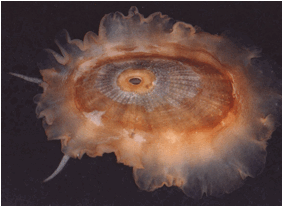
Living Lucapina suffusa
Similar species: L. sowerbii (keyhole not lined in black, margin less crenulate), Diodora species (shells more solid, pit in front of keyhole callus)
Long Key: under rocks in shallow water
Key terminology choices: rounded, ribs dominant, open, medium, none, none, wide
References: Abbot, p. 25; Abbot and Morris, p. 128; Redfern, p. 7; Rehder, p. 352
Back
Macrocypraea
zebra
Measled Cowrie
Key ID features: brown
centers in white spots
Size: 5 to 9 cm
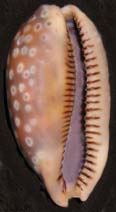
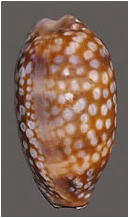
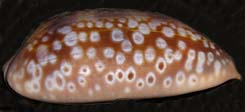
The color of the Macrocypraea zebra shell is light to dark brown with numerous white dots; the dots, especially those along the margins, have brown centers. The shell is solid, smooth, and glossy. It has an elongate and rounded shape. The aperture is very narrow and runs the length of the shell. There are numerous dark brown ridges on both lips of the aperture. The interior is purple. There are 3 to 4 whorls, but the body whorl is dominant (the other whorls are very small and difficult to identify, although sutures are sometimes discernible near the apex).
The live Macrocypraea zebra has a thick gray to black mantle that covers much of the shell when fully expanded. The surface of the mantle has numerous papillae. There are numerous white spots in the posterior area of the mantle. The antennae are slender, much tapered, and black.
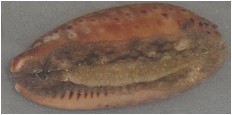
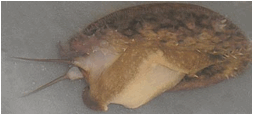
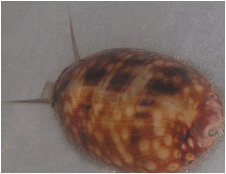
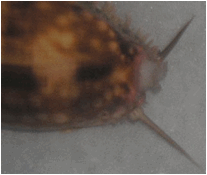
Macrocypraea zebra emerging from shell and crawling
Note: immature shells lack spots and the lip remains thin and has not yet “turned under”


Similar species: Macrocypraea cervus (white dots without brown centers)
Long Key: in shallow water under rocks, ledges, sponges, or lobster traps
Key terminology choices: rounded, smooth, elongate, large, teeth, short, very tall
References: Abbot, p. 149 (Cypraea zebra); Abbot and Morris, p. 194 (Cypraea zebra); Redfern, p. 51; Rehder, p. 479 (Cypraea zebra)
Back
Simulamerelina caribaea
Caribbaen
Alvania
Key ID features: size, solid shell, cancellate
Size: 1.5 to 2.5 mm
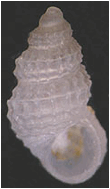
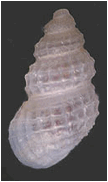
The color of the Simulamerelina caribaea shell is glassy to white to yellowish-white. The shell is very small, solid, and stocky with a short spire. There are cords and ribs of nearly equal size (the subsutural cord being smaller) giving the shell a cancellate appearance (with beads often forming at the intersections). The ribs fade on the base. There is a very small umbilicus. The aperture is oval with a thickened outer lip. There are 4 to 6 whorls and the sutures are well defined.
The operculum is translucent thin, oval, and yellowish.

Similar species: Alvania auberiana (shell wider)
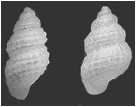
Simulamerelina caribaea Alvania auberiana
Long Key:
Key terminology choices: stocky, cancellate, oval, minute smooth, none, tall
References: Redfern, p. 31 (Manzonia caribaea); Lee, p. 63
Dentimargo aureocinctus
Gold-lined Marginella
Key ID
features: clear/white, polished, 4
folds
Size: 3 to 5 mm
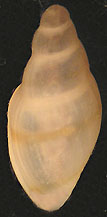

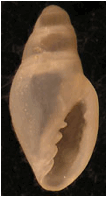
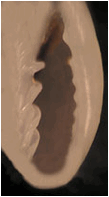
D. aureocintus without color bands Folds on columella and teeth on outer lip
The color of the Dentimargo aureocinctus shell is clear
to white and very polished. There
are orange/tan bands on the body whorl, but a form without these bands is
sometimes found. The shell is smooth and fusiform in shape
and with a blunt spire. The aperture
is about one-half the height of the shell. It is quite narrow and there are four folds on the
columella. Mature shells have 4 to
8 small teeth on the thickened outer lip.
There are 4 to 6 whorls and
the sutures are moderately distinct.
The live Dentimargo aureocinctus is
very colorful. The animal is
whitish with orange/brown and dark white spots and splotches. These colors can be seen through the
shell. The antennae are clear and
slender with several white bands.
The siphon has several orange or orange/brown spots.
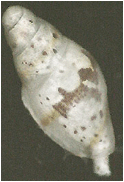


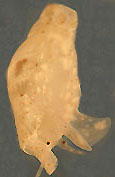
Long Key: in algae clumps
Key terminology choices: fusiform, smooth, narrow, minute, teeth, short, very tall
References: Abbot, p. 246 (Marginella aureocincta); Abbot and Morris, p. 243 (Marginella aureocincta); Lee, p. 120; Rehder, p. 600 (Marginella aureocincta)
Back
Derntimargo
eburneolus
Tan Marginella
Key ID
features: yellow tan, polished, 4
folds
Size: 5 to 8 mm
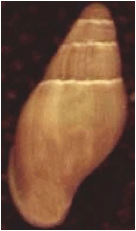
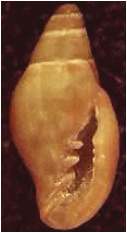
The color of the Dentimargo eburneolus shell is yellowish
tan and very polished. The shell is
smooth and fusiform in shape and with a blunt spire. The aperture is
about one-half the height of the shell.
It is quite narrow and there are four folds on the columella. Mature shells have 7 to 9 teeth on the
thickened outer lip, the top one often quite large There are 4 to 5 whorls
and the sutures are moderately distinct.
The live Dentimargo eburneolus is ornately beautiful. The mantle and tail are clear with delicate white lines and numerous small white pustules. The antennae are clear, slender, of moderate length, and with white spots. The siphon has white spots and lines on a clear background.
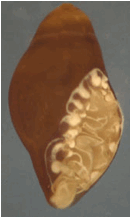
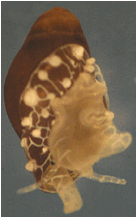
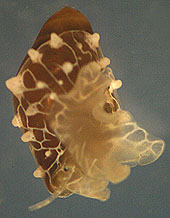
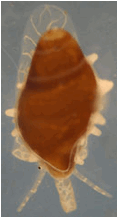
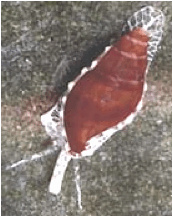
Long Key: in Thalassia
Key terminology choices: fusiform, smooth, narrow, tiny, teeth, short, very tall
References: Abbot, p. 246 (Marginella eburneola); Abbot and Morris, p. 244 (Marginella eburneola); Lee, p. 120
Back
Marshallora
modesta
Modest Triphora (Black-Lined
Triphora)
Key ID features:
sinistral, glassy beads, color
Size: 3 to 6 mm


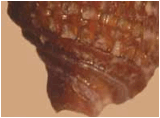
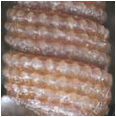
Close-up of base Close-up of beads on largest whorls
The color of the Marshallora modesta shell is medium to dark brown, often darkest in the area of the suture. The shell is tall and slender with slightly convex whorls and a high spire. There are 2 rows of glassy beads on the early adult whorls and 3 rows on the largest whorls. Many shells have an undulating thread in the area of the suture. There is a strong cord just above the base and several additional cords on the base. The aperture is sinistral and oval. The outer lip is thin and the short canal slightly curved. There are 10 to 12 whorls and the sutures are distinct.
The operculum is very thin, rounded, and faintly yellowish.


(lightly
stained)
The live Marshallora modesta is
white. The antennae are long, slender, and clear/white.
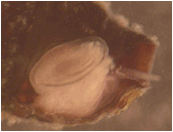
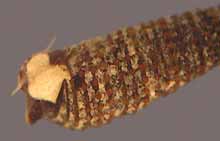
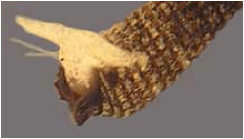
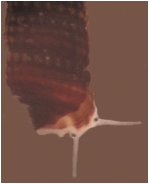
Marshallora modesta emerging from shell and crawling
Similar species: Cosmotriphora melanura (shell white), Iniforis turristhomae (2 rows of beads, lower row brownish-red); Latitriphora albida (beads elongate, shell white and light brown); Nototriphora decorata (color pattern white/cream, with irregular reddish-brown splotches)
Long Key: in Halimeda on flat off Caloosa Cove
Key terminology choices: slender, beaded, oval, tiny, smooth, short, x tall
References: Abbot, p. 111 (Triphora nigrocincta); Abbot and Morris, p. 168 (Triphora nigrocincta); Redfern, p. 67; Rehder, p. 446 (Triphora nigrocincta)
Back
Meioceras nitidum
Little Horn Caecum
Key ID features:
bulge, color
Size: 2 to 3 mm

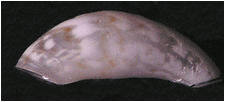
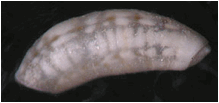
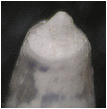
Close-up of mucro
The color of the Meioceras nitidum shell is mottled white and brown (although in some cases almost all brown/tan). The shell is a slightly curved tube. The shell has a bulge (which varies in size from shell to shell, in some cases being much reduced). The mucro is almost centrally located, small and pointed. The aperture is at an oblique angle, round, the lip thin. Only the body whorl is present for the mature snail.
The operculum is thin, round, yellowish, and multispiral.

The live Meioceras nitidum has white and brown markings. The antennae are of moderate length, clear, and rounded at the tip.
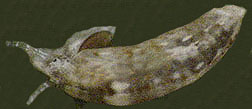
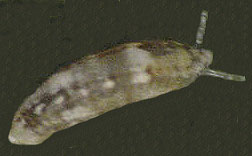
Meioceras nitidum emerging from shell and crawling
Note: immature shells have a horn-like shape
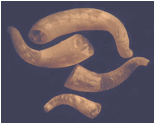
Several stages of development of Meioceras nitidum
Similar species: C. cf. antillarum (smaller, no bulge)
Long Key:
Key terminology choices: tube, smooth, round, minute, none, none, tall
References: Abbot, p. 94 (Caecum nitidum); Lee, p. 74; Redfern, p. 42
Back
Melampus bidentatus
Eastern Melampus
Key ID features:
spiral threads, strong ridge
Size: 10 to 18 mm
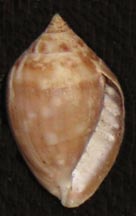
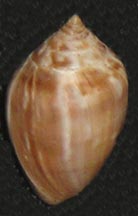
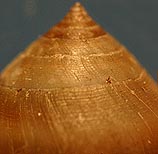
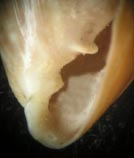
Close-up of apex and spiral threads Close-up of lower aperture
The color of the Melampus bidentatus shell is yellowish-brown to dark brown, sometimes with white markings or lighter spiral bands. The shell is robust with a dominant body whorl, a spire of moderate height, and a pimple-like protoconch. The spire is sometimes concave just below the apex. There are microscopic wavy spiral threads on the upper portion of the body whorl and the larger whorls of the spire. The aperture is elongate and narrow; the outer lip thin. There is a large ridge about 1/3 of the way up the inner lip, and a smaller ridge below. There are low ridges on the interior of the outer lip. There are 9 to 10 whorls and the sutures are distinct.
The live Melampus bidentatus is purplish-brown with an off-white leading edge. The antennae are dark in color and are short and rounded.
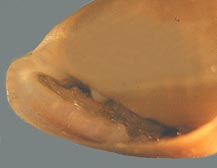
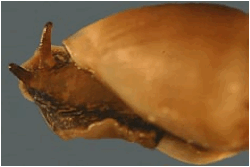
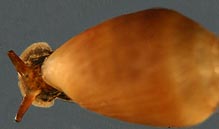
Melampus bidentatus emerging from shell and crawling
Similar species: M. coffea (convex apex, no spirals); M. monile (pit scars)


M. bidentatus M. coffea M. monile
Long Key: marshy areas near high tide line, also under shore debris
Key terminology choices: kite, smooth, elongate, small, teeth, short, tall
References: Abbot, p. 331; Abbot and Morris, p. 274; Lee, p. 160; Redfern, p. 187; Rehder, p. 645
Back
Melampus bullaoides
Bubble Melampus
Key ID features:
shape, apex
Size: 10 to 13 mm
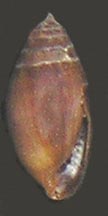

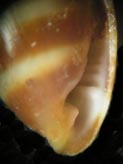
Close-up of lower aperture
The color of the Melampus bullaoides shell is tan to dark brown; some shells also have white or gray streaks or bands. The shell is oval with a moderate spire and pointed glassy protoconch. The body whorl is smooth; only the earliest spire whorls may have fine spiral threads. The aperture is about ˝ the height of the shell, narrow with a strong fold at the base. There are a series of ridges inside the thin outer lip, the bottom one considerably enlarged. There are 9 to 12 whorls and the sutures are distinct.
The live Melampus bullaoides is yellowish-brown. The antennae are short and rounded at the tip; clear with greenish/black tint. The head is rounded.
Long Key: under shore debris, especially among mangrove prop roots
Key terminology choices: fusiform, smooth, elongate, small, fold, short, tall
References: Abbot, p. 332 (Detracia bullaoides); Abbot and Morris, p. 276 (Detracia bullaoides); Redfern, p. 188; Rehder, p. 648 (Detracia bullaoides)
Back
Melampus coffea
Coffee Melampus
Key ID features:
convex spire, ridges
Size: 12 to 20 mm
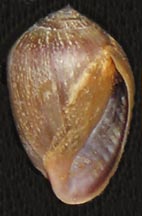
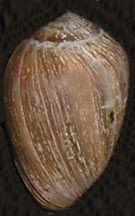
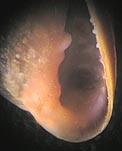
Close-up of lower portion of aperture
The color of the Melampus coffea shell is gray-brown to dark coffee brown. The shell is robust with a dominant body whorl, a spire of moderate height (although there is considerable variation in the spire height), and a pimple-like protoconch. The spire is straight to slightly convex just below the apex. The aperture is elongate and narrow; the outer lip thin. There is a large ridge about 1/3 of the way up the inner lip (sometimes with a smaller hump just below), and a smaller ridge near the base. There are low ridges on the interior of the outer lip. There are 9 to 12 whorls and the sutures are distinct
The live Melampus coffea is brown, the bottom of the foot lighter in color. The antennae are short and stocky, dark in color.
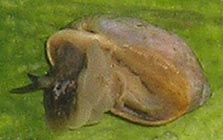
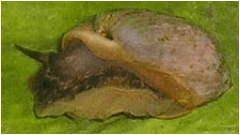
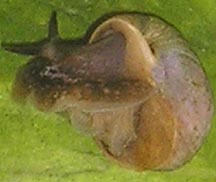
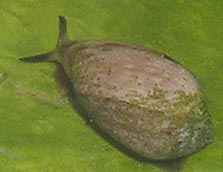
Melampus coffea emerging from shell and crawling
Similar species: M. bidentatus (spirals on spire, less likely to have secondary ridge below upper ridge); M. monile (pit scars)


M. bidentatus M. coffea M. monile
Long Key: marshy areas near high tide line, also under shore debris
Key terminology choices: kite, smooth, elongate, small, fold, short, tall
References: Abbot, p. 332; Abbot and Morris, p. 274; Redfern, p. 188; Rehder, p. 646
Back
Melampus monile
Caribbaen Melampus
Key ID features:
pit scars
Size: 10 to 16 mm
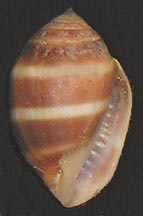
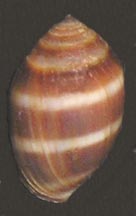
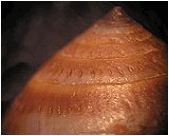
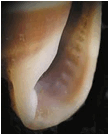
Close-up of pit scars on apex Close-up of lower portion of aperture
The color of the Melampus monile shell is orangish-brown to dark coffee brown, often with bands of white. The shell is robust with a dominant body whorl, a spire of moderate height, and a pimple-like protoconch. The spire is straight to slightly convex just below the apex. The upper end of the shell shows small pit scars (the remains of bristles on immature shells). The aperture is elongate and narrow; the outer lip thin. The only ridge on the inner lip is deep within the shell. There is a small fold at the base of the aperture and there are low ridges on the interior of the outer lip. There are 9 to 12 whorls and the sutures are moderately distinct
Similar species: M. bidentatus (no pit scars); M. coffea (no pit scars)


M. bidentatus M. coffea M. monile
Long Key: marshy areas near high tide line, also under shore debris
Key terminology choices: kite, smooth, elongate, small, fold, short, tall
References: Abbot, p. 332 (M. monilis); Abbot and Morris, p. 275; Redfern, p. 188; Rehder, p. 647
BACK
Melanella eburnea
Ivory Eulima
Key ID features:
angled aperture, shape
Size: 5 to 11 mm



Side view showing
advanced outer lip
The color of the Melanella eburnea shell is white. The shell is smooth and polished, with flat-sided whorls and a high spire. There is no umbilicus. The aperture is a teardrop in shape with a thin outer lip which is angled at the base. There are 10 to 13 whorls and the sutures are moderately distinct.
The operculum is thin, clear, and teardrop in shape.
Similar species: M. hypsela (aperture more rounded)
Long Key: in algae clumps in shallow water
Key terminology choices: slender, smooth, teardrop, tiny, smooth, none, very tall
References: Abbot, p. 125 (M. conoidea); Redfern, p. 81; Rehder, p. 456 (M. conoidea)
BACK
Melanella hypsela
Slender Eulima
Key ID features: rounded aperture, shape
Size: 6 to 10 mm



Side view showing advanced outer lip
The color of the Melanella hypsela shell is white. The shell is smooth and polished, with flat-sided whorls and a high spire. The apex has a rounded glass-like tip. There is no umbilicus. The aperture is a teardrop in shape with a thin outer lip which is rounded at the base. There are 10 to 13 whorls and the sutures are moderately distinct.
The operculum is thin, clear, and teardrop in shape.
The live Melanella hypsela is whitish with eyes visible through shell. An area near the eyes is orange. The antennae are fairly long and tapered.
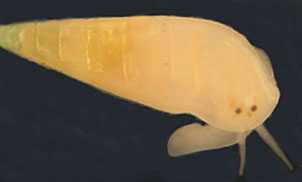
Melanella hypsela crawling
Similar species: M. eburnea (aperture more angular)
Long Key: in algae clumps in shallow water
Key terminology choices: slender, smooth, teardrop, tiny, smooth, none, very tall
References: Abbot, p. 125 (M. intermedia); Lee, p. 101; Redfern, p. 81
Back
Melongena corona
Florida Crown Conch
Key ID features:
spines, shelf-like shoulder
Size: 40 to 80 mm
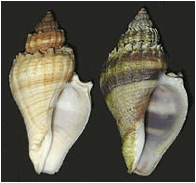
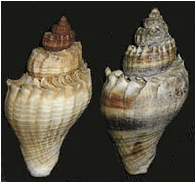
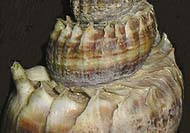
Close-up of spines
The color of the Melongena corona shell is tan or cream, with bands of darker brown. The shell is characterized by a large body whorl, a row of ornate spines at the shoulder, and a shelf below the suture. There are low ribs crossed by numerous weak spiral cords. The aperture is an elongate oval and the canal is short and open. The outer lip is thin. There are 5 to 6 whorls and the sutures are distinct.
The operculum is yellow-brown and somewhat claw-like.


The live Melongena corona is yellowish-green with substantial areas of very dark green and black. The antennae are short and clear. The siphon is greenish with some clear areas.
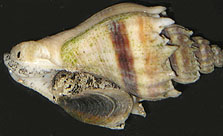
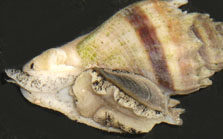
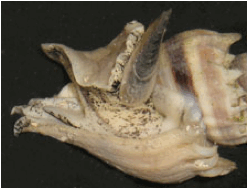
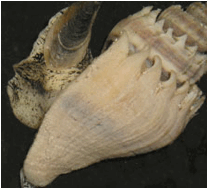
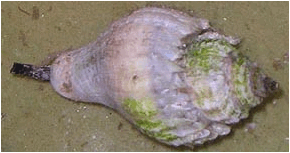
Melongena corona emerging from shell and crawling
Long Key: along shore in very shallow water, island off of Duck Key
Key terminology choices: fusiform, beaded, oval, large, smooth, short, tall
References: Abbot, p. 221; Abbot and Morris, p. 226; Lee, p. 110; Rehder, p. 560
BACK
Oscilla somersi
Somers’ Odostome
Key ID features: flat cords, shape
Size: 1.8 to 3 mm
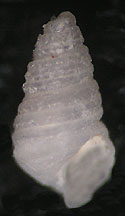
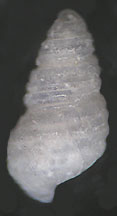
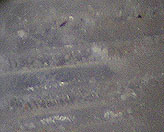
Close-up of flat spiral cords
The color of the Oscilla somersi shell
is clear/glassy to white. The shell is
small but strong and is sculptured by three flat spiral cords (sometimes two on
the upper whorls, four on the body whorl; axial sculpture sometimes produces
weak beads). The protoconch is
immersed in the previous whorl.
The aperture is roughly oval;
the outer lip is thin and reflects the ends of the cords. There is a low fold on the columella
(sometimes deep within). There are
4 to 6 whorls and the sutures are
moderately difficult to identify.
Similar species: Pseudoscilla babylonia (two cords, not flattened) Eulimastoma didymum (cords on either side of suture); Ividia havanensis (upper cord strongly nodulated); Folinella robertsoni (cancellate)
Long Key:
Key terminology choices: slender, spirals, oval, minute, fold, none, very tall
References: Redfern, p. 144
Back
Microtralia ovulum
Western Dwarf Melampus
Key ID features:
folds on columella, shape
Size: 2.5 to 4 mm
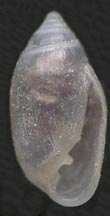
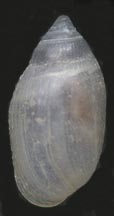
The color of the Microtralia ovulum shell is translucent clear (though large shells may be amber and beachworn shells white). The shell is quite strong and flat-sided. The body whorl is dominant and there is a moderate spire. The shell has microscopic spiral threads, especially on the upper whorls. The aperture is elongate, 2/3 the height of the shell. The lower portion is wider and the base is rounded. There are 3 folds on the inner lip and columella, the middle one the largest. The outer lip is thin and smooth. There are 6 to 7 whorls and the sutures are distinct.
The live Microtralia ovulum is clear/white.
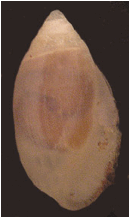
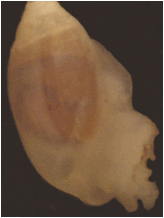
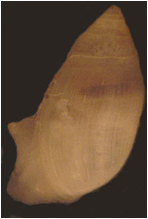
Microtralia occidentalis emerging from shell
Long Key:
Key terminology choices: rounded, smooth, elongate, minute, teeth, none, very tall
References: Redfern, p. 187 (M. occidentalis): Lee, p. 160
Back
Mitra
barbadensis
Barbados Miter
Key ID features:
spiral cords, columella teeth
Size: 24 to 30 mm


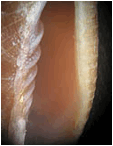
Close-up of aperture
The color of the Mitra barbadensis shell is pale to dark brown. The shell is fusiform and solid with a conical spire of rather flat-sided whorls. The surface features numerous low spiral cords and even smaller (microscopic) threads. The aperture is narrow and 40% the height of the shell. The outer lip is strong but not greatly thickened. The columella has 5 prominent folds. The canal is very short. There are 8 to 10 whorls and the sutures are distinct.
Similar species: M. nodulosa (beaded axial ribs)
Long Key:
Key terminology choices: fusiform, spirals, narrow, medium, teeth, short, very tall
References: Abbot, p. 237; Abbot and Morris, p. 237; Redfern, p. 114; Rehder, p. 588
Back
Mitra nodulosa
Beaded Miter
Key ID features:
columella teeth, beaded ribs
Size: 20 to 40 mm



Close-up of aperture
The color of the Mitra nodulosa shell is pale to dark brown. The shell is fusiform and solid with a conical spire of rather flat-sided whorls. There are 17 (to 21) beaded ribs which are sharply angled just below the suture. The aperture is narrow and 40% the height of the shell. The outer lip is strong but not thickened. The columella has 3 strong folds and one lower weaker fold. The canal is very short. There are 9 to 10 whorls and the sutures are distinct.
The live Mitra nodulosa is yellow with some white. The antennae are yellow, not much extended beyond the eye. The siphon is yellow.
Similar species: M. barbadensis (spiral cords)
Long Key:
Key terminology choices: fusiform, ribs dominant, narrow, medium, teeth, short, very tall
References: Abbot, p. 237; Abbot and Morris, p. 237; Lee, p. 122; Redfern, p. 114; Rehder, p. 588
Back
Mitrella
dichroa
Argus Dove-shell
Key ID features: spire not
eroded, very fine grooves
Size: 7 to 13 mm








Close-ups of aperture and teeth on outer lip
The color of the Mitrella dichroa shell is brown (of various shades) with white spots, splotches, streaks, or flames. The shell is fusiform with a moderate spire. It is smooth (except for very fine threads at the tops of the whorls and cords on the base). The aperture is elongate and fairly narrow, 40% the height of the shell. In mature shells there are small teeth inside the outer lip. There are 6 to 8 slightly convex whorls and the sutures are distinct.
The operculum is thin, oval, clear to light brown.


The live Mitrella dichroa is clear to whitish with brown lines. The antennae are long, clear, with brownish lines. The siphon has bands of brown.
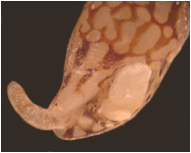
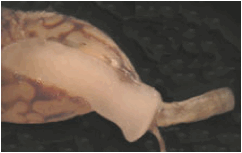
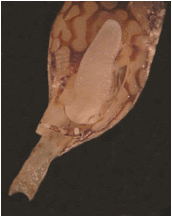
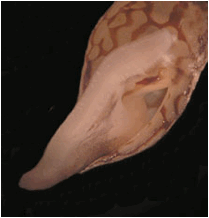
Mitrella dichroa emerging from shell
Similar species: M. ocellata (eroded spire, white spots); Costoanachis species (ribs); Zafrona species (Redfern, p. 96) (ribs); Nitidella species (glossy, aperture wider or longer)
Long Key: common in grass beds
Key terminology choices: fusiform, smooth, narrow, tiny, smooth, short, very tall
References: Abbot, p. 199; Rehder, p. 544
Back
Astyris
lunata
Lunar Dove-shell
Key ID features: zigzag
lines, line below suture
Size: 3 to 6 mm
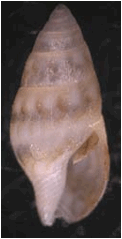
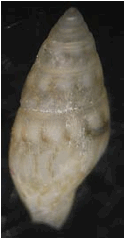

Close-up of sinuous shape of outer lip
The color of the Astyris lunata shell is yellowish to grayish with zigzag lines of brown or yellow. The shell is smooth except for incised lines on the base. The nuclear whorls are small and translucent. There is a revolving line below suture The aperture is narrowly oval and has a small rounded notch at the upper end. The outer lip is slightly sinuous (due in large part to the notch) and is tinged with brown. Mature shells may have several small teeth on the interior of the outer lip. There are 5 to 6 whorls and the sutures are moderately distinct.
The live Asatyris lunata is white with some areas of black. The antennae are clear, fairly short, and not much tapered. The siphon is clear with dark white markings. It is black at the base.
Long Key: algae at coral heads off Caloosa
Key terminology choices: fusiform, smooth, narrow, minute, smooth, short, very tall
References: Abbot, p. 199; Abbot and Morris, p. 219
Back
Mitrella
ocellata
White-spotted Dove Shell
Key ID features:
eroded apex, stout shell
Size: 9 to 12 mm
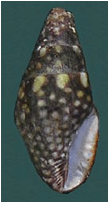
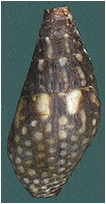
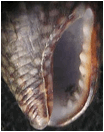
The color of the Mitrella ocellata shell is dark brown or black with numerous white spots, especially on the body whorl. Larger spotches of white are found below the suture. The shell is stout and the apex is eroded on mature shells. The shell is smooth except for fine spirals at the base. The aperture is narrow and the outer lip is thickened. There are a number of enameled teeth inside the outer lip. There are 6 to 8 whorls and the sutures are distinct.
The operculum is thin, elongate, and brownish.


The live Mitrella ocellata is clear to whitish with dark brown to black spots. The antennae are fairly short and are clear with dark markings. The siphon is similarly colored and patterned.
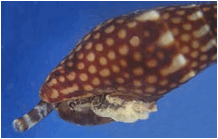
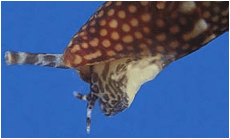
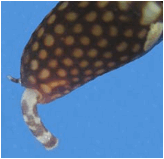
Mitrella ocellata emerging from shell and crawling
Similar species: M. dichroa (lighter color, apex present, shell less stout)
Long Key: under intertidal rocks, e.g., Duck Key
Key terminology choices: fusiform, smooth, narrow, small, smooth, none, very tall
References: Abbot, p. 199; Abbot and Morris, p. 220; Redfern, p. 98; Rehder, p. 544
Back
Modulus carchedonius
Angled Modulus
Key ID features:
smooth cords, angled shoulder, tooth
Size: 11 to 13 mm
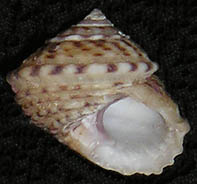
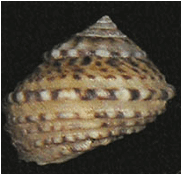
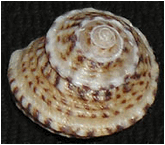
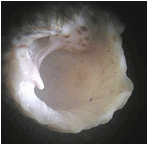
Close-up of aperture and tooth
The color of the Modulus carchedonius shell is cream to yellowish-white, with brown spots. The shell is as wide as tall, with a keeled periphery. There are cords (generally smooth or with very low knobs) on spire and base and a small umbilicus. The aperture is oval and stained with brown and/or purple. There is a prominent tooth at the base of the columella. The outer lip is sinuous and there are ridges within. There are 4 to 6 whorls and the sutures are distinct.
The operculum is round, multispiral, and yellowish-brown


The live Modulus carchedonius is multi-colored, with brown, yellow, green, and white. The antennae are of moderate length, rough and bumpy, green and white on a translucent background.
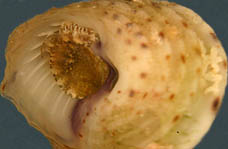
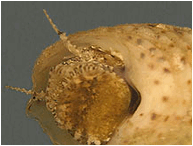
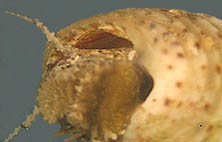
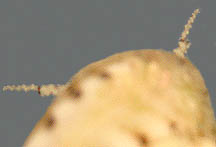
Modulus carchedonius emerging from shell and crawling
Similar species: M. modulus (axial ribs above periphery, cords sinuous)


Modulus carchedonius Modulus modulus
Long Key: in algae and sea grasses
Key terminology choices: flattened, spirals, oval, small, fold, short, equal
References: Abbot, p. 102; Abbot and Morris, p. 162
Back
Modulus modulus
Atlantic Modulus
Key ID features:
sinuous cords, aperture tooth
Size: 11 to 13 mm
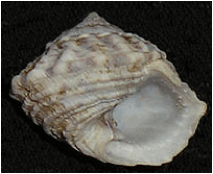
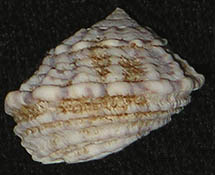
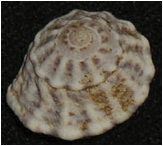
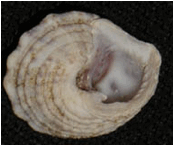
Close-up of aperture and tooth
The color of the Modulus modulus shell is cream to yellowish-white, with brown spots. The shell is as wide as tall, with a keeled periphery. There are axial ribs on the upper whorls and the peripheral cords are sinuous. The aperture is oval and stained with brown and/or purple. There is a prominent tooth at the base of the columella. The outer lip is sinuous and there are ridges within. There is a deep umbilicus. There are 4 to 6 whorls and the sutures are distinct.
The operculum is round, multispiral, and yellowish-brown.
Similar species: M. carchedonius (no axial ribs, cords not sinuous)


Modulus carchedonius Modulus modulus
Long Key: in algae and sea grasses
Key terminology choices: flattened, ribs dominant, oval, small, fold, short, equal
References: Abbot, p. 102; Abbot and Morris, p. 162; Lee, p. 60; Redfern, p. 26; Rehder, p. 433
Back
Morum oniscus
Atlantic Morum
Key ID features:
knobs, pustules, outer lip
Size: 15 to 25 mm
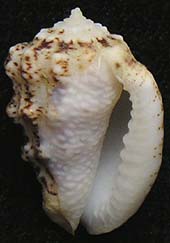
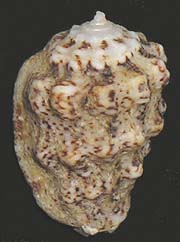
The color of the Morum oniscus shell is cream white to gray, with extensive brown markings. The shell is strong with a dominant body whorl and a low spire (topped by a distinctive protoconch). The body whorl has 3 rows of rounded knobs (the top row at the shoulder often fairly large). The aperture is elongate and narrow. The parietal wall is distinguished by many low white pustules. The outer lip is thickened, turned inward, and has numerous teeth. There are 5 to 7 whorls and the sutures are difficult to identify.
Long Key:
Key terminology choices: kite, beaded, elongate, medium, smooth, short, tall
References: Abbot, p. 160; Abbot and Morris, p.
239; Redfern, p. 108; Rehder, p. 493
BACK
Murchisonella spectrum
Spectral Ebalid
Key ID features: surface pattern, fragile
Size: 2 to 3 mm




Two
examples of Murchisonella spectrum
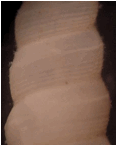
Close-up of spiral pattern
The color of the Murchisonella
spectrum shell is glassy/clear to white. The shell is
translucent, fragile, tall, and slender, with convex whorls. The angled protoconch is a rounded,
smooth, single whorl. The whorls
are shouldered. Microscopic spiral
threads are found below the widest part of the whorl, the area above is smooth. The aperture is rounded, the outer lip thin. There are 8 to 10 whorls
and the sutures are distinct.
Similar species: Careliopsis octona (no spiral threads); Henrya henryi (smaller, axial lines); Stylopsis sp. (spirals over entire whorl)
Long Key:
Key terminology choices: slender, smooth, oval, minute, smooth, none, very tall
References: Lee, p. 137; Redfern, p. 151
Back
Murexsul oxytatus
Hexagonal Murex
Key ID features:
spiny ribs, shape
Size: 25 to 37 mm
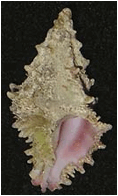
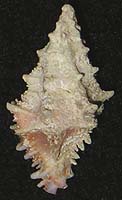
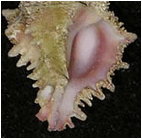
Close-up of aperture and outer lip
The color of the Murexsul oxytatus shell is cream to orange brown (though usually obscured by lime). The shell is fusiform in shape and distinguished by 6 (or 7) spiny axial ribs. The aperture is oval and white/pink. The outer lip is jagged due to spines. The canal is open, of moderate length, and slightly recurved at the end. There are 6 to 8 whorls and the sutures are usually very difficult to identify due to overgrowth.
The operculum is dark brown and tear-drop in shape.


The live Murexsul oxytatus is yellow/white. The antennae are fairly slender, moderately extended beyond the eye, and yellow/white.
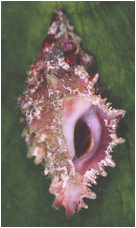
Murexsul oxytatus in shell
Long Key: patch reef off Caloosa
Key terminology choices: fusiform, beaded, oval, medium, smooth, moderate, tall
References: Abbot, p. 187 (Muricopsis oxytatus); Abbot and Morris, p. 210 (Muricopsis oxytatus); Redfern, p. 87 (Muricopsis oxytatus); Rehder, p. 522 (Muricopsis oxytatus)
Back
Nannodiella vespuciana
Key ID features:
brown in aperture, cord at periphery
Size: 6 to 8 mm


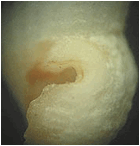
Close-up of notch
The color of the Nannodiella vespuciana shell is white with a light brown band below the suture. The shell is tall and slender with a high spire. There are 18 to 20 axial ribs which are crossed by spiral cords, the strongest cord is at the periphery. The aperture is stained with brown (especially the columella), narrow with a very short canal. There is a prominent spout-like notch at the upper end of the aperture. There are 8 to 10 whorls and the sutures are distinct.
Long Key:
Key terminology choices: slender, cancellate, narrow, tiny, smooth, short, very tall
References: Abbot, p.282; Lee, p. 134
Back
Nassarius
albus
Variable Nassa
Key ID features: stocky shape, twisted inner lip
Size: 9 to 13 mm
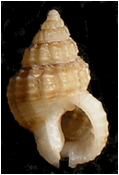
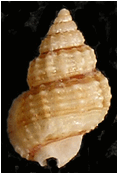
Nassarius albus
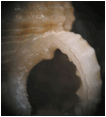
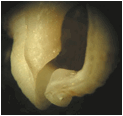
Ridge at upper end of columella
Canal and fold at base of columella
The color of the Nassarius albus shell is cream to white with brown bands at sutures, periphery and near the base. The shell is stocky and beaded, although the ribs are more prominent than the spiral cords. The apex is quite pointed. The aperture is rounded and about one-third the height of the shell. The outer lip is thickened by a varix and shows small folds on the inner surface. The columella has a twist at the base and a ridge near the top. Canal is well defined. Parietal shield is white. There are 5 to 7 whorls of sharply decreasing size and the sutures are distinct.
The operculum is thin, translucent, suboval, and with teeth along nearly ˝ of the circumference.

The live Nassarius
albus is clear with numerous dark white spots. The antennae are moderately long and slender. The siphon is clear with dark white
spots.
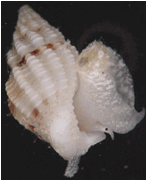
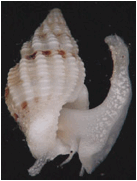
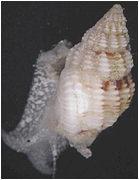

Nassarius albus emerging from shell and crawling
Note: Malacolog gives N. antillarum and N. capillaris as names for N. albus.
Long Key: in grass beds
Key terminology choices: stocky, ribs dominant, oval, small, fold, short, tall
References: Abbot, p. 224; Abbot and Morris, p. 221, Lee, p. 111; Redfern, p. 100; Rehder, p. 566
Back
Natica livida
Livid Moon-Snail
Key ID features:
brown callus, color
Size: 8 to 17 mm
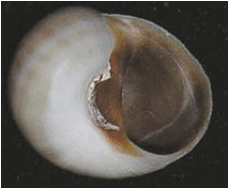
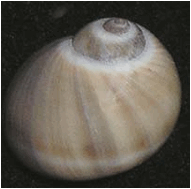
The color of the Natica livida shell is tan to bluish-gray (often with faint bands). The shell is solid and rounded, smooth, with a low spire. Axial growth lines are seen most clearly just below the suture. A dark brown callus nearly fills the umbilicus leaving only a crescent shaped opening. The aperture is ˝ moon in shape with a thin outer lip. The interior and columella are dark brown. There are 4 to 5 whorls and the sutures are distinct.
The operculum is smooth, white, and calcareous.
Long Key:
Key terminology choices: rounded, smooth, half-moon, small, smooth, none, equal
References: Abbot, p. 158; Abbot and Morris, p. 191; Redfern, p. 55; Rehder, p. 489
Back
Naticarius canrena
Colorful Atlantic Moon-Shell
Key ID features:
color, umbilical callus
Size: 25 to 50 mm
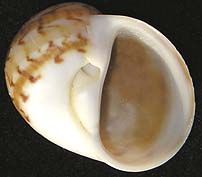
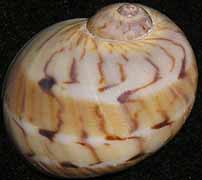
The color of the Naticarius canrena shell is cream white to light tan, with tan/light brown bands and darker brown zig-zag lines. The shell is sturdy, smooth (often polished), and rounded, with a low spire. The umbilicus is white and partially closed by a large callus. The aperture is ˝ moon in shape with a thick callus on the upper parietal wall. The outer lip is thin and smooth. There are 4 to 5 whorls and the sutures are distinct.
The operculum is solid and white with spiral grooves that follow the curvature of the operculum.


The live Naticarius canrena is very attractive; white with orange spots and streaks. The antennae are long, cylindrical, and tapering, with orange bands.
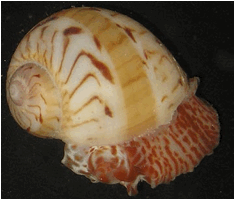
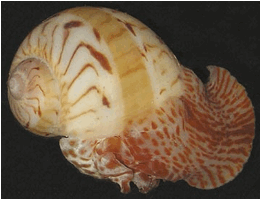
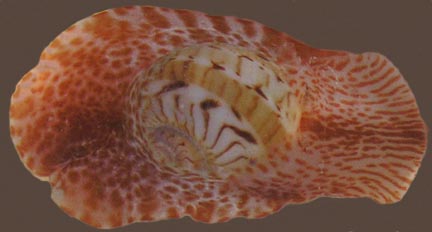
Naticarius canrena emerging from shell and crawling
Long Key: in sand patches in shallow water
Key terminology choices: rounded, smooth, half-moon, medium, smooth, none, equal
References: Abbot, p. 158 (Natica canrena); Abbot and Morris, p. 190 (Natica canrena); Lee, p. 79; Redfern, p. 56; Rehder, p. 489 (Natica canrena)
Back
Nerita
fulgurans
Antillian Nerite
Key ID features: two
columella teeth, gray-colored operculum
Size: 19 to 25 mm
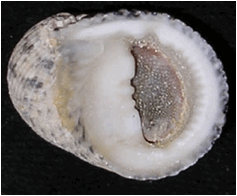
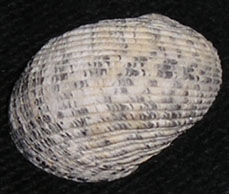
The color of the Nerita fulgurans shell is off-white with black markings. The shell is rounded in shape with a very short spire. The surface has many spiral cords and grooves (more numerous than N. tessellata). The aperture is half-moon in shape and there are two weak teeth on the columella. The outer lip is enameled inside with many small pimples, the upper and lower the largest. There are 3 to 5 whorls (the body whorl dominates) and the sutures are indistinct.
The operculum is an irregular half-circle in outline with a projection along the straight edge. The outer surface is pimpled. The operculum is orangish-gray (underside) and gray (outer surface) in color.
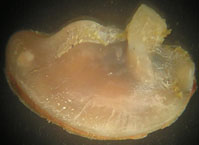
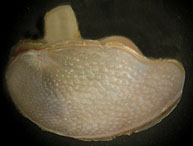
The live Nerita fulgurans is rather drab. The animal is yellowish to cream with thin black lines. The antennae are very long and slender and dark in color.
Similar species: N. peloronta (red spotch on shelf), N. tessellata (black operculum, 2 very small columella teeth), N. versicolor (4 columnella teeth)
Long Key: uncommon on shore rocks, low tide line and upward, e.g. Anne’s Beach
Key terminology choices: rounded, spirals, half-moon, medium, teeth, none, equal
References: Abbot, p. 63; Abbot and Morris, p. 143; Lee, p. 58; Redfern, p. 17
Back
Nerita
peloronta
Bleeding Tooth
Key ID features: red splotch
Size: 19 to 37 mm
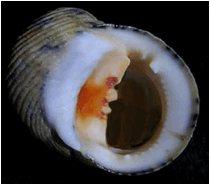
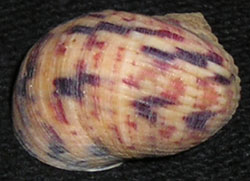
The color of the Nerita peloronta shell is white or yellowish, with red, purplish, and black markings. The shell is rounded in shape with a very low spire. The surface has many low spiral cords. The aperture is half-moon in shape and there are two teeth (the upper one about twice as large as the lower) on the columella. The broad shelf is stained by a colorful reddish-orange splotch. The outer lip is enameled inside with many small pimples, the upper and lower the largest. There are 3 to 5 whorls (the body whorl dominates) and the sutures are indistinct.
The operculum is an irregular half circle in outline with a projection along the straight edge. The underside is light brown to coral in color and fairly smooth. The top side is about one-half smooth and dark reddish-orange in color and one-half pimpled and dark in color.
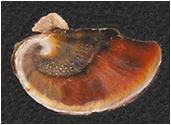
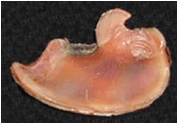
The live Nerita peloronta is rather drab. The animal is yellowish to cream with thin black lines. The antennae are very long and slender and have black longitudinal lines.
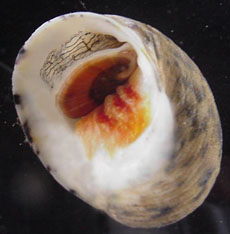
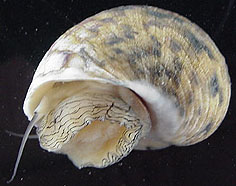
Similar species: N. fulgurans (2 white columella teeth, light colored operculum), N. tessellata (black operculum, 2 very small columella teeth), N. versicolor (4 columnella teeth)
Long Key: shore rocks, low tide line and upward, e.g. Anne’s Beach
Key terminology choices: rounded, spirals, half-moon, medium, teeth, none, equal
References: Abbot, p. 63; Abbot and Morris, p. 143; Redfern, p. 18; Rehder, p. 397
Back
Nerita
tessellata
Checkered Nerite
Key ID features: two
columella teeth, black operculum
Size: 13 to 19 mm
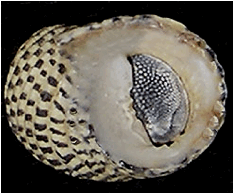
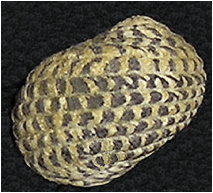
The color of the Nerita tessellata shell is off-white with black markings. The shell is rounded in shape with a very short spire. The surface has many spiral cords and grooves. The aperture is half-moon in shape and there are two weak teeth on the columella. The outer lip is enameled inside with many small pimples, the upper and lower the largest. There are 3 to 5 whorls (the body whorl dominates) and the sutures are indistinct.
The operculum is an irregular half-circle in outline with a projection along the straight edge. The outer surface is pimpled. The operculum is gray (underside) and black (outer surface) in color.
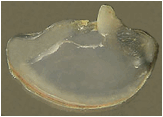
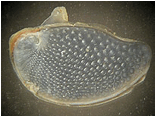
The live Nerita tessellata is rather drab. The animal is yellowish to cream with thin black lines. The antennae are very long and slender and have black longitudinal lines, especially near the base.
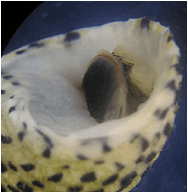
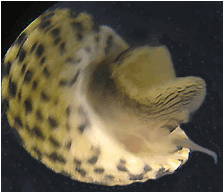
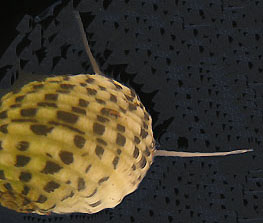
Nerita tessellata emerging from shell and crawling
Similar species: N. fulgurans (2 white columella teeth, light colored operculum), N. peloronta (red spotch on shelf), N. versicolor (4 columnella teeth)
Long Key: shore rocks, low tide line and upward, e.g. Anne’s Beach, Layton Trail site
Key terminology choices: rounded, spirals, half-moon, small, teeth, none, equal
References: Abbot, p. 63; Abbot and Morris, p. 143; Redfern, p. 18; Rehder, p. 398
Back
Nerita
versicolor
Four-footed Nerite
Key ID features: four
columella teeth
Size: 19 to 25 mm
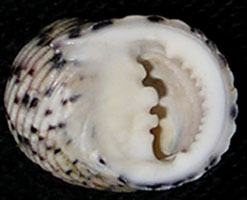
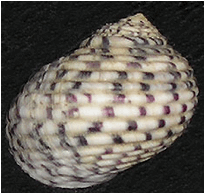
The color of the Nerita versicolor shell is off-white with black (sometimes including purple and/or red) markings. The shell is rounded in shape with a very short spire. The surface has many low spiral cords. The aperture is half-moon in shape and there are four strong teeth on the columella (the two central teeth the largest). The outer lip is enameled inside with many small pimples, the upper and lower the largest. There are 3 to 5 whorls (the body whorl dominates) and the sutures are indistinct.
The operculum is an irregular half-circle in outline with a projection along the straight edge. The outer surface is pimpled. The operculum is light brown in color.
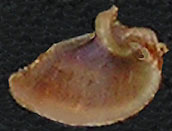
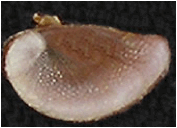
The live Nerita versicolor is rather drab. The animal is yellowish to cream with thin black lines. The antennae are very long and slender and have black longitudinal lines running to the tip.
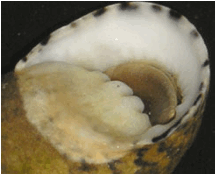
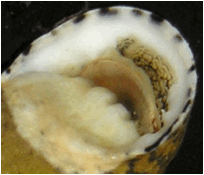
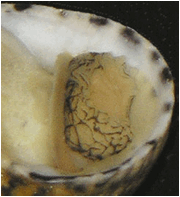
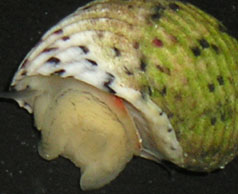
Nerita versicolor emerging from shell
Similar species: N. fulgurans (2 white columella teeth, light colored operculum), N. peloronta (red spotch on shelf), N. tessellata (black operculum, 2 very small columella teeth)
Long Key: shore rocks, low tide line and upward, e.g. Anne’s Beach, Layton Trail site
Key terminology choices: rounded, spirals, half-moon, medium, teeth, none, equal
References: Abbot, p. 63; Abbot and Morris, p. 144; Redfern, p. 18; Rehder, p. 398
Back
Neretina
usnea
Olive Nerite
Key ID features:
fine wavy lines
Size: 9 to 15 mm
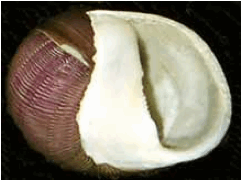

The color of the Neretina usnea shell is brownish green to olive green, with fine lavender or black wavy axial lines. The shell is smooth and rounded, with a very low spire. The aperture is half-moon in shape. The columella is whitish with a few weak teeth (often eroded). The outer lip is moderately thin. There are 4 to 5 whorls and the sutures are distinct.
Similar species: N. virginea (color pattern of lines and spots); Nerita (heavier shells, shells with cords)
Long Key: in brackish water
Key terminology choices: rounded, smooth, half-moon, small, teeth, none, equal
References: Abbot, p. 64 (Neretina reclivata); Abbot and Morris, p. 144 (Neretina reclivata); Lee, p. 58 (Vitta usnea); Rehder, p. 400 (Neretina reclivata)
Back
Neretina virginea
Virgin Nerite
Key ID features:
shape, color
Size: 9 to 18 mm
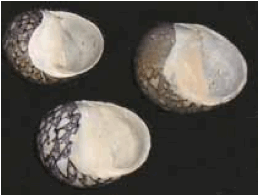
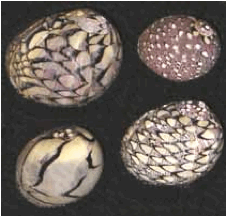
The color of the Neretina virginea shell is tremendously variable: black, brown, red, white, green, purple. On this background color are a wide variety of variously colored lines and spots. The shell is smooth and rounded, with a very low spire. The aperture is half-moon in shape. The columella is whitish to yellowish with a few weak teeth (often eroded). The outer lip is thin. There are 4 to 5 whorls and the sutures are distinct.
The live Neretina virginea is off-white to yellowish, with streaks, lines, and spots of lighter and darker brown. The antennae are very long and slender, colorless with fine lines of darker color running the length of the antenna.
Similar species: N. usnea (wavy lines on green or purple background); Nerita (heavier shells, shells with cords)
Long Key: in brackish water
Key terminology choices: rounded, smooth, half-moon, small, teeth, none, equal
References: Abbot, p. 64; Abbot and Morris, p. 144; Lee, p. 58 (Vitta virginea); Redfern, p. 18; Rehder, p. 399
Back
Echinolittorina angustior
Slender Periwinkle
Key ID features:
strong grooves, angled at base
Size: 6 to 19 mm
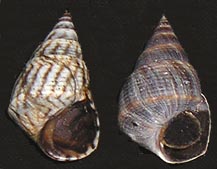
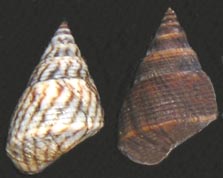
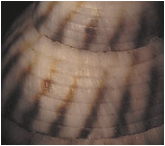
Close-up of strong grooves on whorls above body whorl
The color of the Echinolittorina angustior shell is white to brown with brown markings. The shell is stocky and the body whorl is angled at the base. There are 6 to 9 rather prominent grooves on the upper whorls. The aperture is oval and the outer lip is thin. The strong cord on the body whorl produces a notch near the center of the outer lip. The columella and aperture are dark brown. There are 7 to 8 whorls and the sutures are distinct.
The operculum is rounded, brown (darker at center), and paucispiral.


The live Echinolittorina angustior is greenish-black. The antennae are moderately long, light greenish with numerous darker spots and a hint of orange.
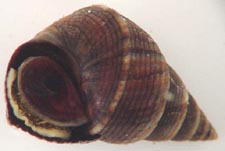
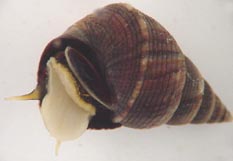
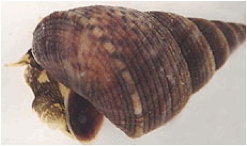
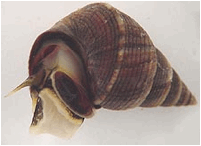
Echinolittorina angustior emerging from shell
Similar species: E. ziczac (more and weaker spiral grooves, body whorl less angulate)
Long Key: on rocks above high tide line (e.g., rocks by bridge at Calossa Cove)
Key terminology choices: stocky, spirals, oval, small, smooth, none, tall
References: Abbot, p. 68 (Littorina angustior); Redfern, p. 28 (Nodilittorina angustior); Rehder, p. 406 (Littorina angustior)
Back
Echinolittorina tuberculata
Prickly Winkle
Key ID features:
flattened columella shelf, triangular knobs
Size: 10 to 19 mm
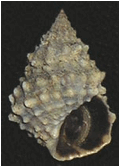
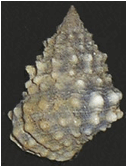
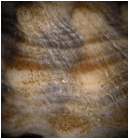
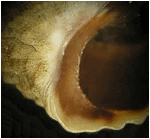
Close-up of knobs and axial lines Close-up of flattened lower columella
The color of the Echinolittorina tuberculata shell is gray to grayish-white; the knobs usually lighter (off-white) in color. The tip of the apex is orange-brown. The shell is stocky and somewhat triangular with a sharp apex. There are several rows of triangular knobs with spiral threads between the rows. The threads and knobs are crossed by microscopic axial growth lines. The aperture is rounded and the interior is brown. The columella is flattened at the base (forming a small shelf). There are 5 to 8 whorls and the sutures are not very clearly defined (especially for the upper whorls).
The operculum is ovate, orange-brown, and paucispiral.


The live Echinolittorina tuberculata is light greenish/black with some darker greenish-white areas. The antennae are short, yellowish-green (darker along edges).
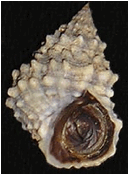
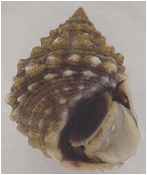
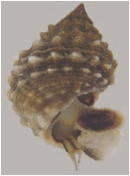
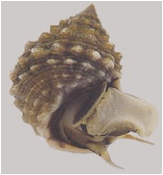
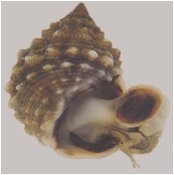
Echinolittorina tuberculata in shell and emerging
Similar species: Tectarius antonii (knobs near suture larger, inner lip much less flattened,
operculum multispiral)


Tectarius antonnii (far left and far right), Echinolittorina tuberculata (two in center)
Long Key: on shore rocks at or above high tide line (e.g., Calossa Cove near bridge). [Note: in Long Key area Tectarius antonii is much less common that Echinolittorina tuberculata.]
Key terminology choices: stocky, beaded, round, small, smooth, none, tall
References: Abbot, p. 70 (Nodilittorina tuberculata); Abbot and Morris, p. 149 (N. tuberculata); Redfern, p. 29 (Nodilittorina dilatata); Rehder, p. 407 (N. tuberculata)
Back
Echinolittorina ziczac
Zebra Periwinkle
Key ID features:
spiral grooves, zigzag lines
Size: 12 to 23 mm
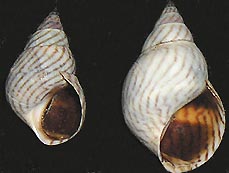
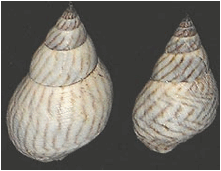
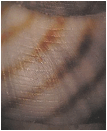
Close-up of grooves on whorl above body whorl
The color of the Echinolittorina ziczac shell is off-white to grayish, with wavy lines of light brown (or purple-brown). The shell is stocky with rounded whorls and a sharp apex (the protoconch is translucent and orange-brown). The body whorl is only weakly angulate at the base. There are 18 to 26 weak spiral grooves on the upper whorls. The aperture is oval with a thin outer lip. The columella, and aperture interior, are brown and white. There are 5 to 6 whorls and the sutures are distinct.
The operculum is a tear-drop shape, brown, and paucispiral.


The live Echinolittorina ziczac is greenish/black. The antennae are short and wide at base; light greenish with a darker tint.
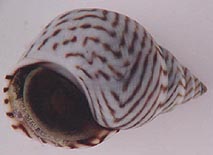
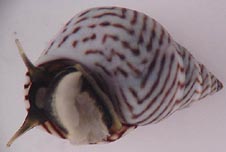
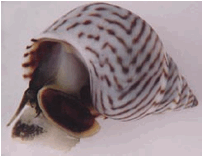
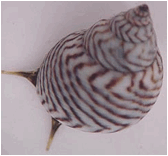
Echinolittorina ziczac emerging from shell and crawling
Similar species: E. angustior (fewer spiral grooves, lower body whorl more angular)
Long Key: on rocks above high tide line (e.g., rocks by bridge at Calossa Cove)
Key terminology choices: stocky, spirals, oval, small, smooth, none, tall
References: Abbot, p. 68 (Littorina ziczac); Abbot and Morris, p. 148 (Littorina ziczac); Redfern, p. 29 (Nodilittorina ziczac); Rehder, p. 404 (Littorina ziczac)
Back
Nototriphora decorata
Mottled Triphora
Key ID features: sinistral, flat-sided whorls, color
Size: 6 to 9 mm


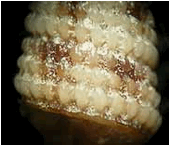
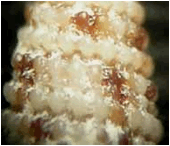
Close-up of beads on body whorl Close-up of emerging middle row of beads
The color of the Nototriphora decorata shell is cream to gray, mottled with irregular patches of reddish-brown. The base is brown. The shell is tall and very slender with flat-sided whorls, a high spire, and sharp apex. There are two rows of rounded beads on the upper whorls and 3 rows (of 24 to 28 beads) on the lower whorls. The middle row of beads is quite small in the middle whorls of the spire. The beads are “connected” with axial and spiral cords. The aperture is sinistral and oval. The short canal is closed and recurved. There are 17 to 20 whorls and the sutures are difficult to identify.
The live Nototriphora decorata is clear/white with a few darker spots. The front of the foot is blunt and rounded. The antennae are moderately long, clear, and tapered.
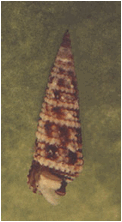
Nototriphora decorata emerging from shell
Similar species: Cosmotriphora melanura (shell white), Iniforis turristhomae (2 rows of beads, lower row brownish-red), Latitriphora albida (elongated beads, brownish color axial and narrow); Marshallora modesta (brown in color)
Long Key: dead shells from channel 5 Bay side flat
Key terminology choices: slender, beaded, oval, tiny, smooth, short, x tall
References: Abbot, p. 111 (Triphora decorata); Lee, p, 91; Redfern, p. 68; Rehder, p.
447 (Triphora decorata)
BACK
Oceanida graduata
Shouldered Eulima
Key ID features:
shelf, overall shape
Size: 2 to 3 mm

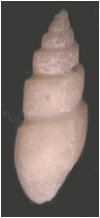
The color of the Oceanida graduata
shell is translucent white (but beachworn shells are darker white to
yellowish). The shell is thin and somewhat
fragile. The shell shape is
slender with a fairly tall spire and sharp apex. The whorls are flat-sided and the sutures are clearly
demarcated by a shelf. The aperture is an elongate oval. The outer lip is thin and rounded at
the base. There are 8 to 10 whorls and the sutures are distinct.
Long Key:
Key terminology choices: slender, smooth, oval, minute, smooth, none, very tall
References: Abbot, p. 131 (Athleenia burryi); Lee, p. 102; Redfern, p. 82
BACK
Pseudoscilla babylonia
Babylon Odostome
Key ID features: spiral cords, protoconch
Size: 1.4 to 2 mm
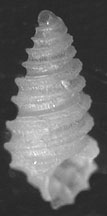
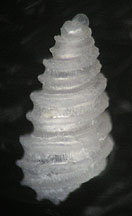
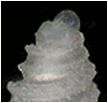

Close-up of protoconch Close-up of cords and axial threads
The color of the Pseudoscilla
babylonia shell is clear/glassy to white. The shell is
sculptured by two strong spiral cords (2 or 3 more on the body whorl) between
which is a channel that has crowded microscopic axial threads. The protoconch is smooth, rounded, and
tilted at a 45 degree angle. The aperture is roughly oval; the outer lip
is thin and reflects the ends of the cords. There is a low fold on the columella. There are 5 to 7 whorls and the sutures are difficult to identify.
Similar species: Eulimastoma didymum (cords on either side of suture); Ividia havanensis (upper cord nodulated); Folinella robertsoni (cancellate); Oscilla somersi (three flat cords)
Long Key:
Key terminology choices: slender, spirals, oval, minute, fold, none, very tall
References: Abbot, p. 301 (Cingulina babylonia); Lee, p. 142; Redfern, p. 142 (Odostomia babylonia)
BACK
Eulimastoma didymum
Twin Odostome
Key ID features:
cords, shape
Size: 1.7 to 3 mm
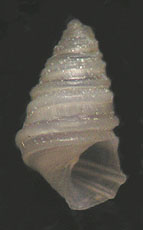
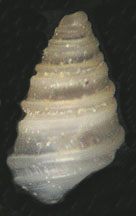
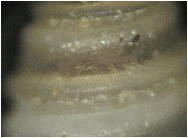
Close-up of cords and suture
The color of the Eulimastoma
didymum shell is clear/glassy to white. The shell is
sculptured by strong spiral cords (2 sometimes 3), two of which occur on either
side of the suture. The protoconch
is tilted, smooth, and rounded.
The aperture is roughly oval;
the outer lip is thin and reflects the ends of the cords. There is a low fold on the columella
(although this may be internal).
There are 5 to 7 whorls and
the sutures are difficult to identify.
Similar species: Pseudoscilla babylonia (two cords per whorl); Ividia havanensis (upper cord nodulated); Folinella robertsoni (cancellate); Oscilla somersi (three flat cords)
Long Key:
Key terminology choices: slender, spirals, oval, minute, smooth, none, very tall
References: Abbot, p. 301 (Cingulina babylonia); Lee, p. 139 (Cyclodostomia didyma); Redfern, p. 142 (Odostomia didyma)
Back
Olivella acteocina
Olsson’s Dwarf Olive
Key ID features:
shape, color, fold
Size: 3 to 6 mm
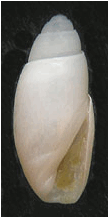
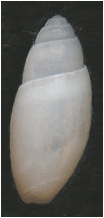
The color of the Olivella acteocina shell is white. The shell is smooth and polished, with convex whorls and a rounded blunt apex. The aperture is about 45% the height of the shell, narrow above, the outer lip thin. The inner lip shows a parietal callus and there is one small fold near the bottom of the columella. There are 4 to 5 whorls and the sutures are deeply grooved (the suture is hidden by the next whorl) and thus well defined.
Similar species: O. floralia (larger, apex pointed)
Long Key:
Key terminology choices: fusiform, smooth, narrow, minute, fold, short, very tall
References: Redfern, p. 110
Back
Olivella floralia
Common Rice Olive
Key ID features:
shape, folds Size: 8 to 12 mm


The color of the Olivella floralia shell is white (sometimes with a bluish undertone, sometimes with a bit of brown color). The shell is smooth and polished, slender with a sharp apex. The aperture is about 45% the height of the shell, narrow above, the outer lip thin. The inner lip has 4 to 7 small folds. There are 4 to 6 whorls and the sutures are deeply grooved and thus well defined.
Similar species: O. acteocina (smaller, apex blunt)
Long Key: in sand patches at flat off Caloosa Cove
Key terminology choices: fusiform, smooth, narrow, tiny, teeth, short, very tall
References: Abbot, p. 234; Abbot and Morris, p. 235; Lee, p. 119; Redfern, p. 110; Rehder, p. 582
Back
Olivella pusilla
Very Small Dwarf Olive
Key ID features:
shape, folds
Size: 6 to 9 mm
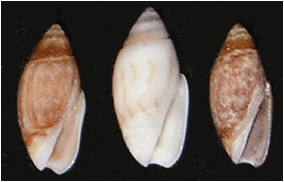
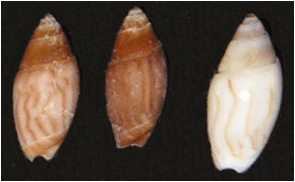
The color of the Olivella pusilla shell is quite variable: light brown, dark brown, white with brown axial stripes. The shell has a convex body whorl and is smooth and polished. The apex is rounded and blunt. There is a noticeable callus on the parietal area. The aperture is about 50% the height of the shell, narrow above, the outer lip thin (and usually edged in white). The inner lip has 4 low ridges near the center and there is a fold at the base. There are 4 to 5 whorls and the sutures are deeply channeled and thus well defined.
The live Olivella pusilla is clear/whitish with numerous opaque white spots and splotches. The front of the head is bifurcate.
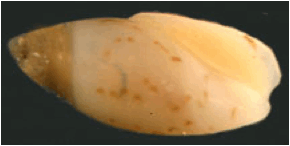
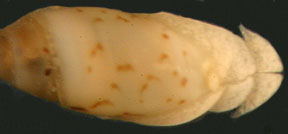
Olivella pusilla in shell and crawling
Long Key: very common in shallow water in the bight
Key terminology choices: fusiform, smooth, narrow, tiny, teeth, short, very tall
References: Abbot, p. 234; Lee, p. 118; Rehder, p. 584
Back
Orbitestella bermudezi
Atlantic Orbitestella
Key ID features:
size, ribs, depressed spire
Size: .6 to .75 mm


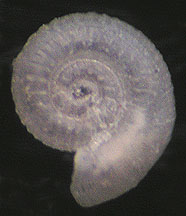
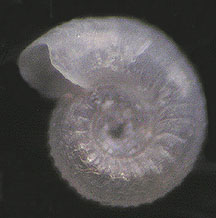
The color of the Orbitestella
bermudezi shell is glassy/clear to white. The shell is very
small and in one plane. There is
both spiral and axial sculpture (the axial features in the form of short ribs
or nodules). The aperture is an irregular oval [Note: the
lip is broken on the pictured shell.]. There are 2 to 3 whorls
and the sutures are distinct.
Similar species: Ammonicera minortalis (brownish color, round aperture); Lodderena ornata (aperture round, 3 strong cords)
Long Key:
Key terminology choices: flattened, ribs dominant, oval, smooth, none, wide
References: Redfern, p. 138
Back
Parviturboides interruptus
Interrupted
Vitrinella
Key ID features:
size, cords, axial threads
Size: .8 to 1.3 mm
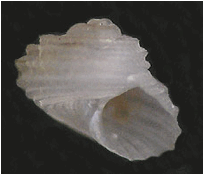
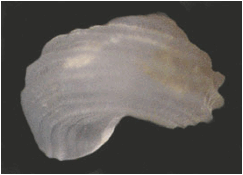
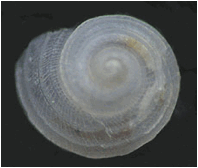
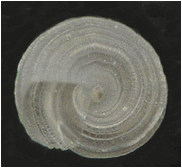
The color of the Parviturboides interruptus shell is translucent clear/white. The shell is small but solid, somewhat flattened with a low spire. There are strong spiral cords. Axial threads are found in the valleys between, and on the slopes of, the cords. The umbilicus is open and bounded by a keel. The aperture is oval, the outer lip thin and reflecting the ends of the cords. There are 3 to 5 whorls and the sutures are distinct.
The operculum is round, thin, clear, and multispiral.

Operculum (lightly stained)
The live Parviturboides interruptus is clear/colorless, with a bifurcate foot. The antennae are clear (except for an opaque white area running the length) and club-shaped and have stiff cilia along the edges.
Long Key: on Channel 5 Bay side flat
Key terminology choices: stocky, spirals dominant, oval, minute, smooth, none, equal
References: Abbot, p. 87; Lee, p. 66
Back
Patelloida
pustulata
Spotted Limpet
Key ID features: limpet
shape, color
Size: 10 to 25 mm
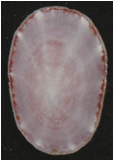
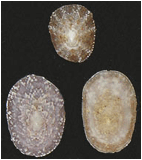


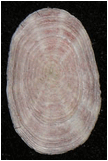
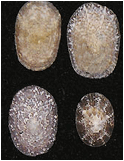
Large form Small Thalassia form
The color of the Patelloida pustulata shell is variable: pink, light red, brown, purple, and white in many combinations. The shell is low and triangular in side view, broadly ovate from the top. Radiating ribs are low; concentric rings present (sometimes requiring magnification for the small form). The limpet shape provides an open aperture. The small form of Patelloida pustulata is delicate and is found living attached to blades of Thalassia. Larger specimens are usually attached to rocks in shallow water.
The live Patelloida pustulata is yellowish-white to greenish with brown dots and splotches. The antennae are long, slender, and light greenish (to clear).
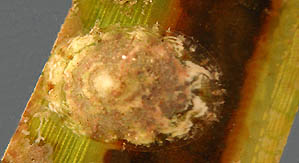
Small form of Patelloida pustulata on blade of Thalassia
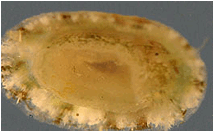
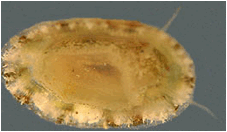
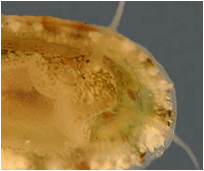
Photos of underside of small form of Patelloida pustulata
Long Key: on Thalassia blades in shallow water
Key terminology choices: rounded, ribs, open, small, none, none, wide
References: Abbot, p. 33 (Acmaea pustulata); Abbot and Morris, p. 130 (Lottia pustulata); Lee, p. 54; Redfern, p. 1; Rehder, p. 367
Back
Pedipes
mirabilis
Globose Pedipes
Key ID features:
teeth, apex
Size: 3 to 6 mm
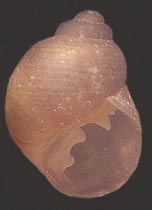
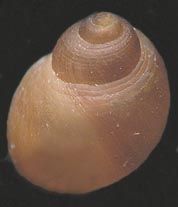
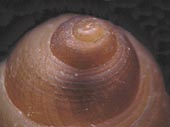
Close-up of apex
The color of the Pedipes mirabilis shell is light to dark brown. The shell is ovate with a low, flattened spire. The protoconch is rounded and the tip embedded. There are numerous spiral grooves on the larger whorls. The aperture is oval, the base rounded, with 3 strong teeth on the inner lip, the top one the largest and pointed down. Mature shells have one low triangular ridge inside the thin outer lip. There are 4 to 5 whorls and the sutures are distinct.
The live Pedipes mirabilis is off-white. The antennae are short, rounded, and black. The siphon is white with some black. The front of the animal is rounded and bilobed.
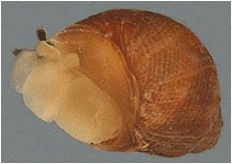
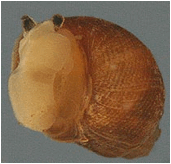
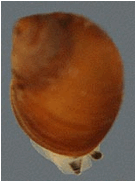
Pedipes mirabilis emerging from shell and crawling
Similar species: Laemodonta cubensis (asymmetric apex, teeth inside outer lip)
Long Key: under rocks and debris above high tide line
Key terminology choices: stocky, spirals, oval, minute, teeth, none, equal
References: Abbot, p. 333; Abbot and Morris, p. 275; Lee, p. 160; Redfern, p. 186; Rehder, p. 648
Back
Peristichia agria
Key ID features:
one cord on columella, cancellate
Size: 5 to 6 mm

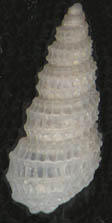
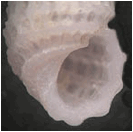
Close-up of columella and aperture
The color of the Peristichia agria shell is white (although fresh shells are glassy and translucent). The shell is tall and slender, with a high spire of slightly convex whorls and a sharp apex. There are both ribs and cords (the cords somewhat stronger) which generate a cancellate appearance (and small knobs at the intersections). The aperture is oval, the outer lip somewhat thickened and reflecting the ends of the spiral cords. One ridge crosses the columella. There are 7 to 9 whorls and the sutures are indented.
The live Peristichia agria is white. The antennae are white, of moderate length, and somewhat triangular.
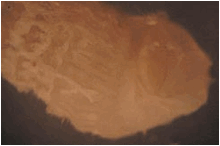
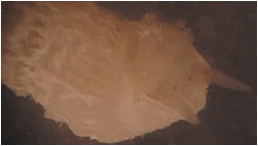
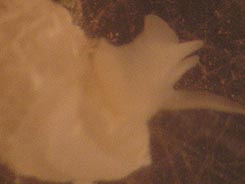
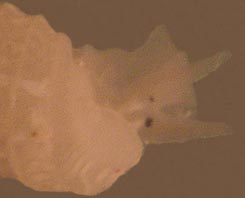
Peristichia agria emerging from shell and crawling
Similar species: Triptychus niveus (two cords cross columella, no ribs)


Peristichia agria Triptychus niveus
Long Key:
Key terminology choices: slender, cancellate, oval, tiny, fold, none, very tall
References: Abbot, p. 300
Back
Persicula catenata
Princess
Persicula
Key ID features:
color, ridges
Size: 4 to 6 mm
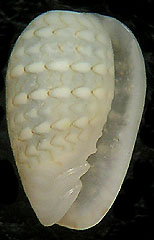
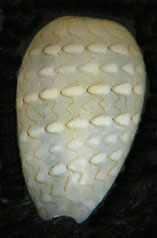

Close-up of columella ridges
The color of the Persicula catenata shell is tan to cream, with rows of white markings and wavy brown lines (which point away from the columella). The shell is smooth and glossy, the top of the shell flat. The aperture is narrow and the same height as the shell. There are up to 9 ridges on the columella, but the upper ones are often very small. Mature shells will have a thickened outer lip with as many as 25 small teeth. The body whorl is dominant and the additional 2 or 3 whorls can be seen only by viewing the top of the shell.
The live Persicula catenata has a mantle with white lines and roundish brown spots along the edge. The head is white with wavy brown lines. The antennae are very slender, white with light brown streaks. The siphon is white with brown lines.
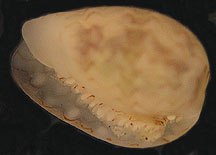
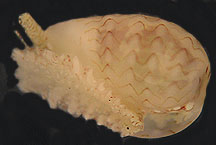
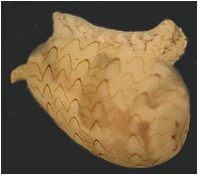
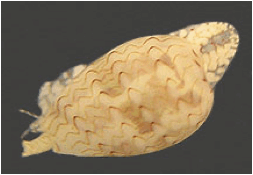
Persicula catenata emerging from shell and crawling
Long Key: in algae in shallow water
Key terminology choices: triangular, smooth, elongate, tiny, teeth, short, tall
References: Abbot, p. 251; Abbot and Morris, p. 246; Lee, p. 120; Redfern, p. 112; Rehder, p. 602
Back
Petaloconchus varians
Variable Worm-shell
Key ID features:
axial ridges, worm tube shape
Size: 1 to 1.5 mm in
diameter
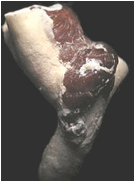
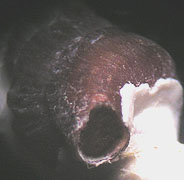
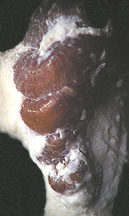
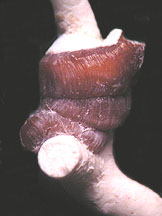
Photos of an individual shell of Petaloconchus varians
The color of the Petaloconchus varians shell is dark brown (but may vary from organish-brown to almost black). The shell is sometimes found individually attached to a shell, coral, or coralline alga, but more generally occurs in massive colonies. The shell is irregularly coiled and is axially ridged. The aperture is irregularly rounded and up to 1.5 mm in diameter.
Long Key: flat off Calossa Cove
Key terminology choices: tube, smooth, oval, large, smooth, none, x tall
References: Abbot, p. 99; Rehder, p. 427
Back
Philine
sagra
Crenulated Paper Bubble
Key ID features: large aperture, fragile
Size: 1.5 to 2.5 mm
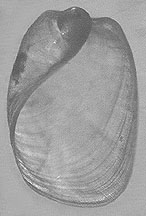
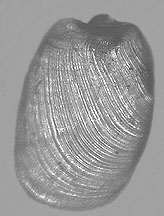

Close-up of circles comprising lines
The color of the Philine sagra shell is translucent and glassy (to white). The shell is very fragile with a small body whorl capped by a tiny rounded apex. There are numerous angled lines crossing the shell (which with high magnification are seen to be rows of small circles). The aperture is very large, the outer lip is thin, rounded below, and microscopically crenulated. There are 2 to 3 whorls.
Long Key:
Key terminology choices: rounded, smooth, flaring, minute, smooth, none, tall
References: Abbot, p. 316; Lee, p. 154
Back
Pilsbryspira
albomaculata
White-Banded Drillia
Key ID features:
white knobs, notch
Size: 12 to 15 mm
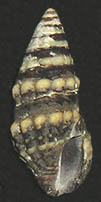


Close-up of lip and notch
The color of the Pilsbryspira albomaculata shell is brown to black, with white to yellowish knobs, including several (up to 4) secondary rows on the body whorl. The shell is rugged with flat-sided whorls. There are 12 (to 14) knobs on the body whorl, with numerous very fine spiral threads between. The aperture is narrow and about Ľ the height of the shell. There is a strong notch at the upper end of the thickened outer lip. The columella is smooth. There are 9 to 12 whorls and the sutures are difficult to identify.
The operculum is thin, brown, and tear-drop shape.
![]()
![]()
The live Pilsbryspira albomaculata is largely black. The antennae are short and clear, rounded at the tip. The siphon is black.
Note: Lee p. 127 gives Pilsbryspira monilis; Malacolog gives Pilsbryspira nodata.
Similar species: Vexillum species (teeth on columella)
Long Key:
Key terminology choices: slender, beaded, narrow, small, smooth, short, very tall
References: Abbot, p. 273 (Crassispira albomaculata); Abbot and Morris, p. 255 (Monilispira albomaculata); Redfern, p. 128
Back
Pilsbryspira leucocyma
White-knobbed Turrid (or Drillia)

Key ID
features: white knobs
Size: 8 to 12 mm


The color of the Pilsbryspira leucocyma shell is grayish
brown to black. There are two rows
of elongated white (sometimes yellow) knobs. The groove separating the two knobs is the same light color.
A beaded cord above the suture may make a third row of light knobs on the body
whorl. The shell is tall and slender in shape; the apex somewhat rounded. There are numerous fine spiral
cords on the upper whorls, stronger cords (interspersed with fine cords) on the
base. The aperture is quite narrow
and there is a notch at the upper end.
The canal is open. There are 6 to 8 whorls
and the sutures are somewhat indistinct.
The operculum is thin, brownish to orangish, and a tear-drop shape.

Operculum of Pilsbryspira leucocyma
The live Pilsbryspira leucocyma is darkly colored. The mantle and tail very dark green to black. The eyestalks are dark in color. The antennae are short, little extended beyond the eye.

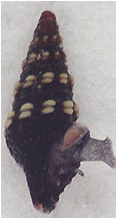
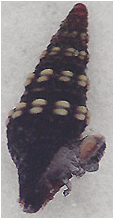
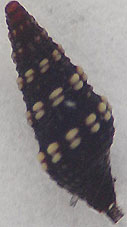
Photos showing Pilsbryspira leucocyma emerging from aperture
Long Key: very common, often in Thallasia or clumps of algae
Key terminology choices: slender, beaded, narrow, tiny, smooth, short, very tall
References:
Abbot, p. 273 (Crassispira leucocyma); Abbot and Morris, p. 256 (Monilispira
leucocyma); Lee, p. 126; Rehder, p. 619 (Crassispira leucocyma); Redfern,
p. 128
Back
Triplofusus giganteus
Horse Conch
Key ID features:
size, color in aperture
Size: up to 60 cm
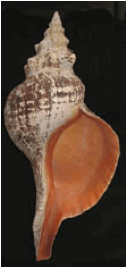
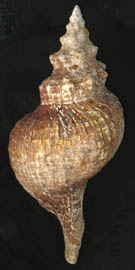
The color of the Triplofusus giganteus shell is grayish-white to brown or orangish-brown (and with a brown periostracum). The shell is very large and heavy. The body whorl is large and rounded, the spire whorls have triangular knobs which are crossed by low spiral cords (immature shells have knobs on the body whorl, a mature shell does not). The aperture is large and oval, the interior is yellowish or orange. The columella has 2 or 3 ridges just above the canal and the outer lip is thin. The canal is long and open. There are 9 to 10 whorls and the sutures are distinct.
The operculum is thick, brown, and oval (with a point at one end).


The live Triplofusus giganteus is orange with some white spots.
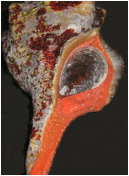
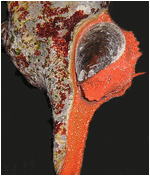
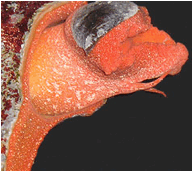
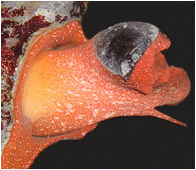
Triplofusus giganteus emerging from shell
Note: immature shells look very much like mature.
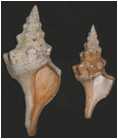
Immature Triplofusus giganteus, 7” and 5” shells
Long Key: many locations on flats and in grass beds
Key terminology choices: fusiform, beaded, oval, very large, teeth, long, very tall
References: Abbot, p. 228 (Pleuroploca gigantea); Abbot and Morris, p. 233 (Pleuroploca gigantea); Lee, p. 113; Rehder, p. 575 (Pleuroploca gigantea)
Back
Polinices lacteus
Milk Moon Shell
Key ID features: color, callus
Size: 15 to 35 mm
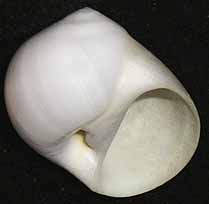
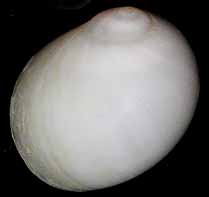

Close-up of callus and umbilicus
The color of the Polinices lacteus shell is milk-white (although live shells have a thin yellowish periostracum). The shell is strong, smooth, and rounded, with a low spire. The umbilicus is deep, with a callus covering a portion. The aperture is a half-moon in shape with a moderately thick outer lip. The interior is white. There are 3 to 5 whorls and the sutures are distinct.
The operculum is thin, D-shaped, and reddish-purple (sometimes more yellowish) in color.


The live Polinices lacteus is lemon yellow at the head, white at foot. The antennae are yellowish.
Similar species: P. uberinus (smaller, callus, ridge into umbilicus)


Polinices lacteus Polinices
uberinus
Long Key:
Key terminology choices: rounded, smooth, half-moon, medium, smooth, none, equal
References: Abbot, p. 153; Abbot and Morris, p. 189; Lee, p. 79; Redfern, p. 55; Rehder, p. 484
Back
Polinices uberinus
Dwarf White Moon Shell
Key ID features: callus. ridge into umbilicus
Size: 9 to 14 mm
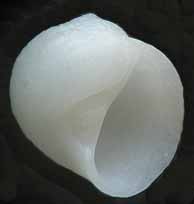
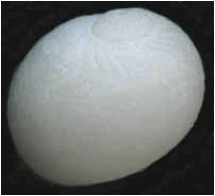
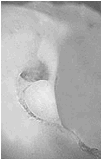
Close-up of callus and umbilicus
The color of the Polinices uberinus shell is milk-white. The shell is strong, smooth, and rounded, with a low spire. The umbilicus is deep, with a button-shaped callus covering a portion, and a rounded ridge into the umbilicus. The aperture is a half-moon in shape with a moderately thick outer lip. The interior is white. There are 3 to 5 whorls and the sutures are distinct.
Similar species: P. lacteus (larger, callus is smaller and umbilicus more open)


Polinices lacteus Polinices
uberinus
Long Key:
Key terminology choices: rounded, smooth, half-moon, medium, smooth, none, equal
References: Abbot, p. 154; Lee, p. 80
Back
Gemophos tinctus
Tinted Cantharus
Key ID features:
teeth and nodule in upper aperture, varix
Size: 19 to 30 mm
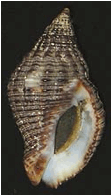
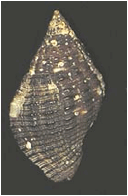

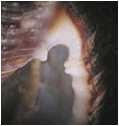
Close-up of aperture Close-up of nodule and double tooth
The color of the Gemophos tinctus shell is dark brown with some white markings. The shell is solid and fusiform with a fairly straight-sided spire. The 11 (to 14) low ribs are crossed by numerous spiral cords forming elongated nodules. The aperture is oval and the canal short. The outer lip has a strong varix behind and small white teeth within. There are small white nodules on the columella. The top of the aperture has a strong double tooth on the outer lip and a nodule on the columella. There are 8 to 10 whorls and the sutures are difficult to identify.
The operculum is strong, tear-drop in shape, and brown (with a yellowish border) in color.
![]()
![]()
The live Gemophos tinctus is white with many black spots. The antennae are clear with black spots; tip beyond eyes is white. The siphon has numerous black spots.
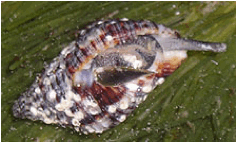
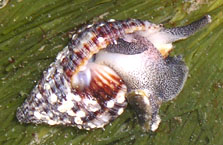
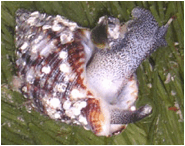
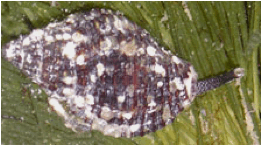
Gemophos tinctus emerging from shell and crawling
Similar species: Cantharus cancellarius (thin outer lip, lacks nodule and double-tooth at upper end of aperture)
Long Key: often in clumps of algae
Key terminology choices: fusiform, ribs dominant, oval, medium, teeth, short, tall
References: Abbot, p. 219 (Pisania tinctus); Abbot and Morris, p. 225 (Pisania tincta); Lee, p. 108; Redfern, p. 94 (Pollia tincta); Rehder, p. 555 (Pisania tincta)
Back
Prunum apicinum
Common Atlantic Marginella
Key ID features: smooth shell, columella teeth, color
Size: 10 to 13 mm
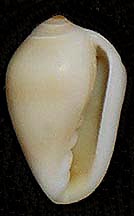
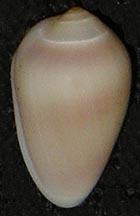

Close-up of aperture
The color of the Prunum apicinum shell is golden-brown to orange-brown, with 3 bands of a darker shade (which fade on beachworn shells). The shell is solid and smooth with a dominant body whorl and a low spire. The apex is orange/brown. The aperture is narrow and elongate, 85% the height of the shell. There are 4 teeth at the base of the columella. The outer lip is thickened by a varix (and sometimes has several small brown spots). There are 4 to 6 whorls and the sutures are distinct.
The live Prunum apicinum is white with greenish to black spots (which are visible through the shell). The antennae are slender and tapered, clear with orange/brown and whitish/green spots. It is orange near the eye. The siphon is orange/brown with whitish/green spots.
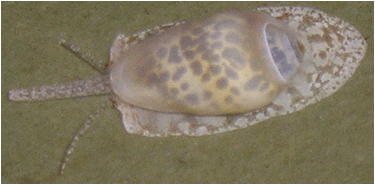
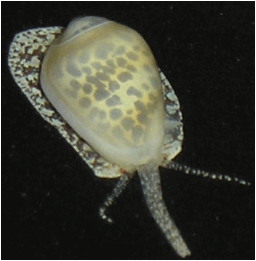
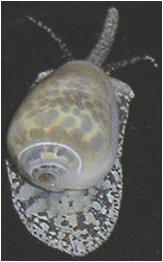
Prunum apicinum crawling with mantle extended
Long Key: very common in shallow water
Key terminology choices: kite, smooth, elongate, small, teeth, short, tall
References: Abbot, p. 250 (Marginella apicina); Abbot and Morris, p. 244; Lee, p. 121; Redfern, p. 105; Rehder, p. 599 (Marginella apicina)
Back
Prunum carneum
Orange Marginella
Key ID features:
color, columella teeth
Size: 13 to 19 mm
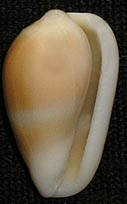
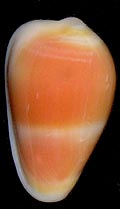
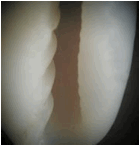
Close-up of lower portion of aperture
The color of the Prunum carneum shell is orange with a white band below the suture and the middle of the body whorl. The shell is solid and smooth with a dominant body whorl and a low spire. The apex is white (covered by an enamel callus). The aperture is narrow and elongate, 95% the height of the shell. There are 4 teeth at the base of the columella. The outer lip is thickened by a varix and mature shells have numerous low obscure teeth on the inside of the lip. The canal is open and very short. There are 4 to 6 whorls and the sutures are distinct.
The live Prunum carneum is very attractive with an orange and white mantle and tail. The antennae have orange and white spots. The siphon has a few orange dots and streaks.
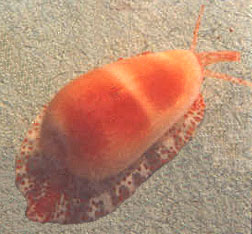
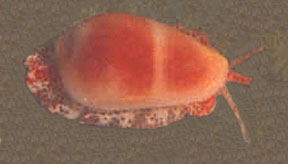
Prunum carneum crawling with mantle extended
Long Key: in Halimeda at Old Dan Bank
Key terminology choices: rounded, smooth, elongate, small, teeth, short, tall
References: Abbot, p. 249 (Marginella carnea); Abbot and Morris, p. 245; Redfern, p. 105; Rehder, p. 598 (Marginella carnea)
Back
Prunum guttatum
White-Spotted Marginella
Key ID features: spots on outer lip, spots on shell
Size: 12 to 19 mm
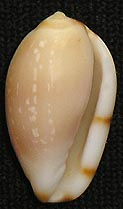
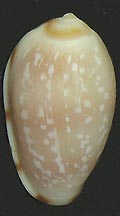
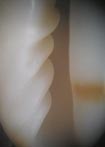
Close-up of lower potion of aperture
The color of the Prunum guttatum shell is cream-white to light brown/tan, with 3 darker bands and irregular white spots. The shell is solid and smooth with a dominant body whorl and a low spire. The apex is white (sometimes with an orange-brown ring). The aperture is narrow and elongate, 85% the height of the shell. There are 4 teeth at the base of the columella. The outer lip is thickened by a varix and there are several spots of brown. The canal is open and very short. There are 4 to 6 whorls and the sutures are moderately distinct.
The live Prunum guttatum has numerous irregular white spots on the mantle and tail. The antennae are long and slender with orange and white bands. The siphon is orange with white spots.
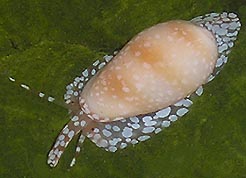
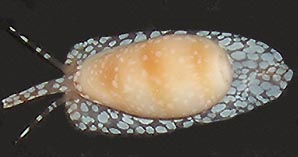
Prunum guttatum crawling with mantle extended
Long Key: in Halimeda at Old Dan Bank
Key terminology choices: rounded, smooth, elongate, small, teeth, short, tall
References: Abbot, p. 249 (Marginella guttata); Abbot and Morris, p. 245; Redfern, p. 106
Back
Pugnus serrei
Serre’s Pugnus
Key ID features:
surface sculpture, size, shape
Size: 1.5 to 2 mm
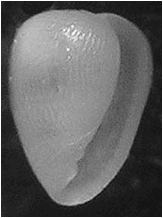
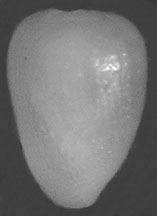
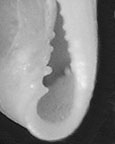
Close-up of aperture
The color of the Pugnus serrei shell is white. The shell is triangular, very small but strong. The spire is flat. The surface is wrinkled (e.g., ridges, bumps, pustules). The aperture is elongate (nearly as high as the shell) and narrow. The outer lip is thickened and has small denticles on the inner side. The columella has several ridges (usually 4, the lowest one the largest). The body whorl is dominant and the sutures are almost impossible to identify in the spire.
The live Pugnus serrei is white with orange/brown markings. The antennae are slender and gently tapered; there is a dark vein down the center.
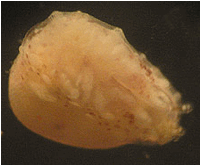
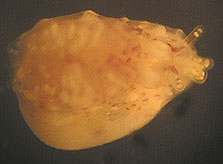
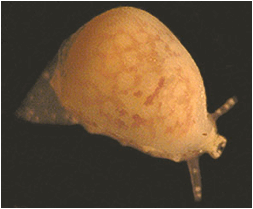
Pugnus serrrei emerging from shell and crawling
Similar species: P. sp. A (body more rounded); Genus Gibberula (lacks surface sculpture)

P. sp A; Pugnus serrei
Long Key:
Key terminology choices: triangular, smooth, elongate, minute, teeth, short, tall
References: Abbot, p. 254 (Marginellopsis serrei); Redfern, p. 114
Back
Purpura
patula
Wide-Mouth Purpura
Key ID features:
large aperture, salmon columella
Size: 25 to 87 mm
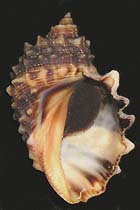
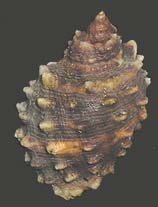
The color of the Purpura patula shell is dull brownish gray with some lighter brown and/or yellowish-brown patches. The shell is moderately large with a dominant body whorl which has several rows of bluntly pointed knobs. There are fine spiral threads between the rows of knobs. There is no umbilicus. The aperture is very large, and the outer lip is thin and strongly crenulate. The lower portion of the columella is salmon in color; the remainder of the interior and the callus are a combination of brown, yellow, and salmon. There are 4 to 5 whorls and the sutures are distinct.
The operculum is dark brown and an elongate oval.
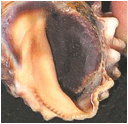
Close-up
of salmon columella and operculum in aperture
Note: Malacolog now lists Plicopurpura as genus.
Long Key: uncommon, on shoreline rocks
Key terminology choices: rounded, beaded, oval, large, smooth, short, tall
References: Abbot, p. 180; Abbot and Morris, p. 214; Rehder, p. 523
BACK
Pyramidella crenulata
Crenate Pyrum
Key ID features:
suture crenulations, columella ridges
Size: 10 to 13 mm


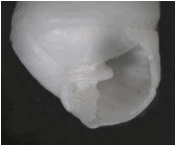
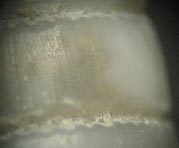
Close-up of columella and ridges Close-up of sutures
The color of the Pyramidella crenulata shell is white to grayish-white to yellowish, sometimes with light brown markings. The shell is tall with a spire of flat-sided whorls. The top of the whorl is crenulate. The aperture is an elongate oval and the outer lip is thin. There are 3 ridges on the columella, the top one the largest. There are 12 to 14 whorls and the sutures are distinct due to crenulations.
The operculum is thin and white, notched to accommodate columella ridges.
The live Pyramidella crenulata is white with some opaque white markings. The antennae are white and much tapered from a broad base.
Note: Looks like the shell Lee (p. 141) calls Longchaeus crenulatus. Malacolog does not recognize Longchaeus crenulatus or Pyramidella crenulata.
Long Key: in sand
Key terminology choices: slender, smooth, oval, small, teeth, short, very tall
References: Abbot, p. 291; Abbot and Morris, p. 261; Redfern, p. 141; Rehder, p. 626
Back
Pyrgocythara filosa
Filose Mangelia
Key ID features:
size, protoconch, notch
Size: 4 to 6 mm
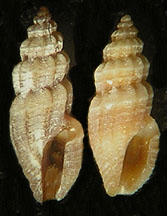
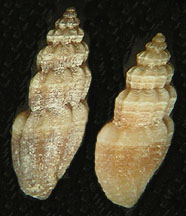
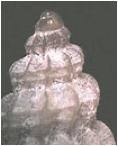
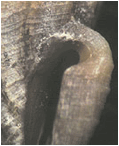
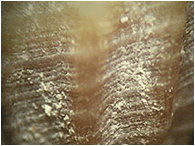
Close-up of apex Close-up of notch Close-up of cords and threads
The color of the Pyrgocythara
filosa shell is yellow to brown, often with a pale band at the angle of the
shoulder. The shell is tall and slender with slightly convex whorls. The 9 (to 12) ribs are usually somewhat
angled at the shoulder and are crossed by numerous spiral cords and very fine
threads (the strongest cord often at the periphery). The aperture is
narrow and there is a fairly deep notch at the upper end. Mature shells have a varix behind the
outer lip. There are 6 to 8 whorls and the sutures are distinct.
Similar species: P. hemphilli (larger overall, protoconch larger); Stellatoma stellata (body whorl wider, protoconch larger)
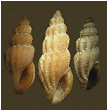
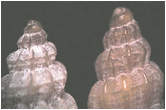
Stellatoma stellata, P. hemphilli, P. filosa P. filosa P. hemphilli
Long Key: dead shells at Channel 5 Bay side flat
Key terminology choices: fusiform, ribs dominant, narrow, tiny, smooth, short, very tall
References: Abbot, p. 284; Redfern, p. 134
Pyrgocythara hemphilli
Hemphill’s Mangelia
Key ID features: size, protoconch, notch
Size: 5 to 9 mm


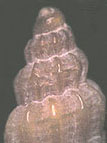
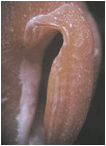
Close-up of apex Close-up of notch
The color of the Pyrgocythara hemphilli shell is yellow to brown, often with a pale band at the angle of the shoulder. The shell is tall and slender with slightly convex whorls. The 11 (to 14) ribs are usually somewhat angled at the shoulder and are crossed by numerous spiral cords and threads (the strongest cord often at the periphery). The cords become more prominent on the base. The aperture is narrow and there is a fairly shallow notch at the upper end. Mature shells have a varix behind the outer lip. There are 6 to 8 whorls and the sutures are distinct.
The live Pyrgocythara hemphilli is yellowish with dark white markings. The antennae are of similar color and very short, only a stub beyond the eye.
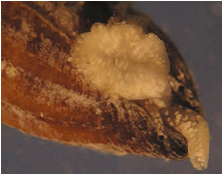
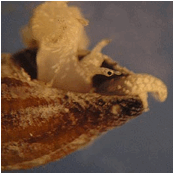
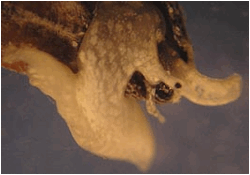
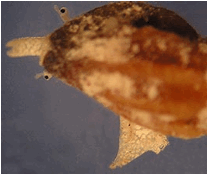
Pyrgocythara hemphilli emerging from shell and crawling
Similar species: P. filosa (smaller overall, protoconch smaller); Stellatoma stellata (body whorl wider)
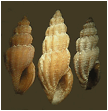
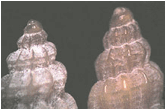
Stellatoma
stellata, P. hemphilli, P. filosa P.
filosa
P. hemphilli
Long Key: dead shells at Channel 5 Bay side flat
Key terminology choices: fusiform, ribs dominant, narrow, tiny, smooth, short, very tall
References: Abbot, p. 284; Redfern, p. 134
Back
Pyrgospira tampaensis
Tampa Turrid
Key ID features:
crenulate outer lip, squarish cords
Size: 18 to 23 mm



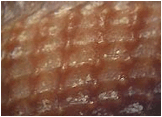
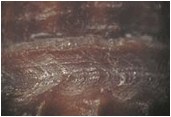
Close-up of crenulate outer lip Close-up of
rib and cord pattern
Close-up of subsutural channel
The color of the Pyrgospira tampaensis shell is reddish-brown (although beach-worn shells are orange- to yellow-brown). The shell is tall and quite slender. There are 15 to 18 ribs on the body whorl; the ribs emerge immediately below the concave subsutural channel giving the whorls a shouldered appearance. The ribs are crossed by squarish spiral cords that form beads at the ribs on some shells. The ribs fade and the cords are dominant on the base. The subsutural channel has a spiral cord immediately below the suture and curved axial growth lines which largely obscure the fine threads in the channel. The aperture is fairly narrow and the outer lip is crenulate due to the termination of the spiral cords. The upper end of the aperture has a distinct notch (most prominent on mature shells). There are 9 to 11 whorls and the sutures are distinct.
The live Pyrgospira tampaensis is purplish with some patches of brown. The antennae and siphon are grayish/clear with a purplish tint.
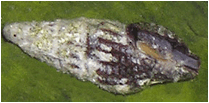
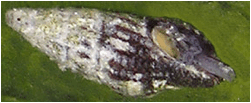
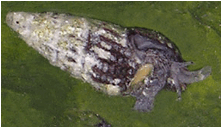
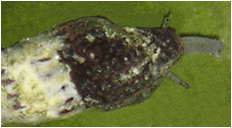
Pyrgospira tampaensis emerging from shell and crawling
Similar species: Crassispira cubana (white ribs); Strictispira solida (varix behind outer lip, callus at notch)
Long Key:
Key terminology choices: fusiform, ribs dominant, narrow, small, smooth, short, very tall
References: Abbot, p. 273 (Crassispira tampaensis); Abbot and Morris, p. 254 (Crassispira tampaensis); Redfern, p. 124
Back
Rictaxis
punctostriatus
Pitted Baby Bubble
Key ID features: spiral
row of pits, columella fold
Size: 3 to 5 mm
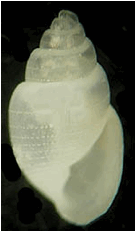
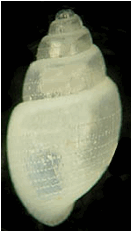
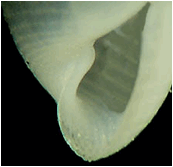
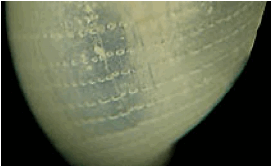
Close-up of fold on columella Close-up of spiral rows of pits
The color of the Rictaxis punctostriatus shell is glassy to white to yellowish-white. The shell has a large body whorl, is translucent, and shows spiral rows of squarish or rectangular pits. The whorls have rounded shoulders. There is a moderate spire and a rounded apex (with submerged nuclear whorl). The aperture is narrow at top, wide and rounded at base. There is one strong, twisted fold on the lower portion of the columella. There are 3 to 4 whorls and the sutures are indented.
The live Rictaxis punctostriatus is white with some brown visible through shell. The forward part of the body is bi-lobed; the antennae are leaf-like.
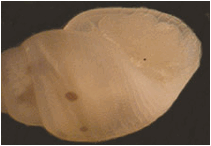
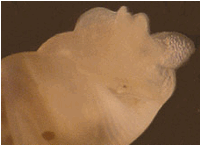
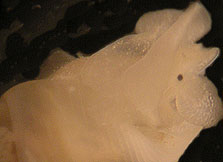
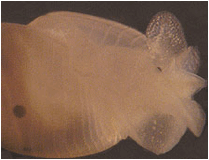
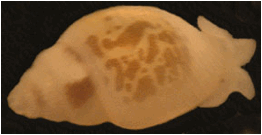
Rictaxis punctostriatus emerging from shell and crawling
Note: Malacolog now lists Japonactaeon as genus.
Long Key: in Long Key bight
Key terminology choices: rounded, spirals, tear-drop, tiny, fold, none, very tall
References: Abbot, p. 311 (Acteon punctostriatus); Abbot and Morris, p. 265 (Acteon punctostriatus); Lee, p. 153; Redfern, p. 151; Rehder, p. 633
Back
Rissoella caribaea
Carribaen Risso
Key ID features:
fragile, translucent, small Size: 1 to 1.7 mm
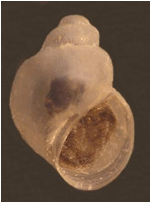
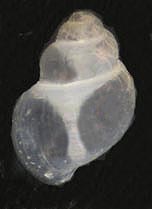
The color of the Rissoella caribaea shell is clear and translucent. The shell is fragile, smooth, rounded with convex whorls of rapidly decreasing size, and a flat apex. The umbilicus is very narrow. The aperture is ovate with a thin outer lip. There are 4 whorls and the sutures are distinct.
The operculum is thin, translucent, and a half-moon with a small projection.


Operculum
in shell
Operculum with red stain
The live Rissoella caribaea is black
(often with a white mark on the back).
The antennae are black.
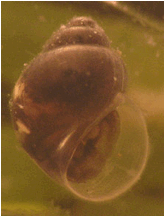
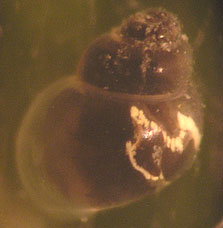
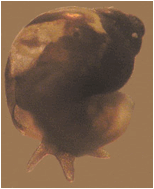
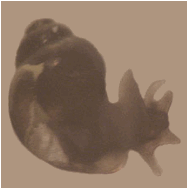
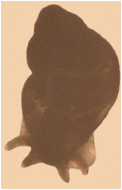
Rissoella caribaea in shell, emerging, and crawling
Long Key: in algae in shallow water and in algae on mangrove roots
Key terminology choices: stocky, smooth, oval, minute, smooth, none, tall
References: Abbot, p. 80; Redfern, p. 140
Back
Rissoina
cancellata
Cancellate Risso
Key ID features:
cancellate
Size: 5 to 7 mm

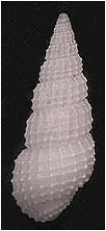
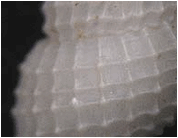
Close-up of cancellate pattern
The color of the Rissoina cancellata shell is white. The shell is tall with a high spire. The shell has strong ribs and spiral cords throughout giving rise to knobs at the intersections and to a strong cancellate appearance. The base of the shell has several beaded spiral cords. The aperture is tear-drop shape; the outer lip is thick. There are 8 to 9 whorls and the sutures are distinct.
Long Key:
Key terminology choices: slender, cancellate, tear drop, tiny, smooth, short, very tall
References: Abbot, p. 76; Abbot and Morris, p. 152; Redfern, p. 34 (the shell pictured here is likely Redfern’s Rissoina sp. B. He shows a more flattened protoconch for R. cancellata)
Close-up of ribs and spirals on upper adult whorls
BACK
Rissoina
decussata
Decussate Risso
Key ID features:
low ribs, solid shell, spirals on base
Size: 6 to 8 mm
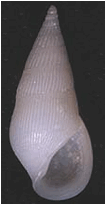
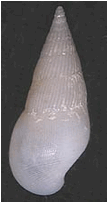
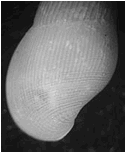
Close-up of spirals on base; ribs on body and preceding whorl
The color of the Rissoina decussata shell is white to glassy. The shell is tall with a high spire; the whorls are very slightly rounded. The body whorl has many low ribs, those on the upper whorls usually somewhat stronger. There are spiral cords on the base (spirals above base require magnification). The aperture is tear-drop in shape and the outer lip is thick. There is a small bulge on the columella just above the base. There are 7 to 10 whorls and the sutures are moderately distinct.
The operculum is orange-brown and has an internal projection (“peg”).
Similar species: Rissoina striosa (rather fragile, 3.5 whorl protoconch); Rissoina princeps (less stout, more rounded, to 11 mm)
Long Key:
Key terminology choices: slender, ribs dominant, tear drop, tiny, smooth, none, very tall
References: Abbot, p. 76; Abbot and Morris, p. 152; Redfern, p. 32
BACK
Rissoina elegantissima
Elegant Risso
Key ID features:
protoconch, excavation behind columella
Size: 3 to 4 mm



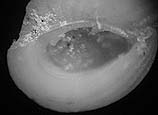
Close-up of protoconch Close-up of excavation

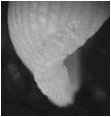
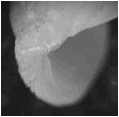
Close-up of ribs and cords on base Close-ups of ridge on base
The color of the Rissoina
elegantissima shell is white to yellowish. The shell is solid with a high spire comprised of rounded whorls. The protoconch is of 2.5 whorls,
flat-topped, and cylindrical. The
adult whorls have low ribs; the ribs on the body whorl continue below the periphery
and cross a ridge on the base.
The base of the shell has visible spiral cords; the cords become very
small elsewhere on the shell. The aperture is tear-drop in shape with a
solid outer lip. The area behind
the columella is excavated. There
are 7 to 9 whorls and the sutures
are distinct.
Similar species: Schwartziella bryerea (stronger ribs, no spiral cords); Schwartziella fischeri (protoconch of 1.5 whorls, stronger ribs); Schwartziella vanpeli (protoconch of 1.5 whorls, ribs with subsutural shoulder) Rissoina krebsii (protoconch of 1.5 whorls, spiral cords on body and adult whorls); Rissoina multicostata (protoconch of 1.5 whorls)
Long Key:
Key terminology choices: slender, ribs, tear drop, minute, smooth, none, very tall
References: Redfern, p. 34
BACK
Rissoina krebsii
Krebs’
Risso
Key ID features:
spirals throughout, robust shape
Size: 3 to 5 mm
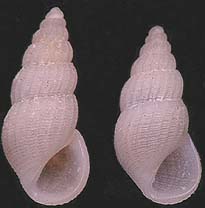
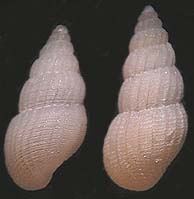
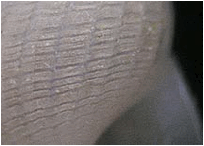
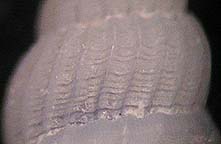
Close-up of ribs and
spirals on body whorl Close-up of
ribs and spirals on spire whorl
The color of the Rissoina krebsii shell is glassy to white. The shell is solid with a high spire comprised of slightly rounded whorls. The protoconch has 1.5 whorls. The adult whorls have low ribs (20+ on the body whorl) and numerous spiral cords of smaller size. The aperture is tear-drop in shape with a solid outer lip. There are 6 to 7 whorls and the sutures are distinct.
Similar species: R. elegantissima (2.5 whorl protoconch, excavated behind columella); R. multicostata (spiral cords prominent on base, weak to absent above); Schwartziella bryerea (no spiral cords, 2.5 whorl protoconch; ribs continue to base); Schwartziella fischeri (no spiral cords, ribs continue to base); Schwartziella vanpeli (no spiral cords; ribs continue to base)
Long Key:
Key terminology choices: slender, ribs dominant, tear drop, minute, smooth, none, very tall
References: Redfern, p. 33
BACK
Rissoina multicostata
Many-ribbed Risso
Key ID features:
cords on base only, ribs fade at periphery
Size: 3.5 to 5 mm


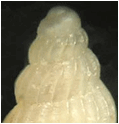
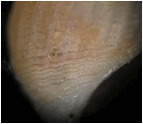
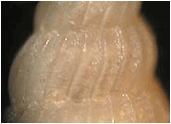
Close-up
of apex Close-up of spiral cords
on base Close-up of
adult whorl lacking spiral cords
The color of the Rissoina multicostata shell is white to somewhat yellowish. The shell is solid with a high spire comprised of slightly rounded whorls. The adult whorls have low ribs; the ribs on the body whorl fade below the periphery. The base of the shell has visible spiral cords; the cords become very small or disappear completely above the periphery of the body whorl. The aperture is tear-drop in shape with a solid outer lip. There are 6 to 8 whorls and the sutures are distinct.
The operculum is yellowish, tear-drop in shape, and has a strong projection.


The live Rissoina multicostata is white. The antennae are slender and moderately long.
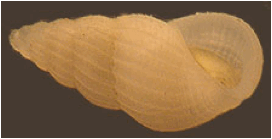
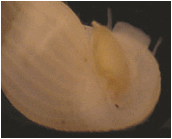
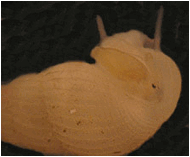
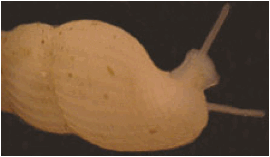
Rissoina multicostata emerging from shell and crawling
Similar species: R. elegantissima (2.5 whorl protoconch, excavated behind columella); R. krebsii (spiral cords on upper portion of body whorl and on adult whorls); Schwartziella bryerea (no spiral cords, 2.5 whorl protoconch; ribs continue to base); Schwartziella fischeri (no spiral cords, ribs continue to base); Schwartziella vanpeli (no spiral cords; ribs continue to base)
Long Key: Long Key bight
Key terminology choices: slender, ribs dominant, tear drop, minute, smooth, none, very tall
References: Abbot, p. 76; Abbot and Morris, p. 152
BACK
Rissoina
princeps
Fine-ribbed Risso
Key ID features:
size, cord on upper adult whorls
Size: 9 to 11 mm



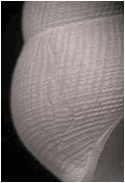
Close-up of protoconch Close-up of weak spirals
and primary cord on
early whorls
and ribs on body whorl
The color of the Rissoina
princeps shell is white. The shell is tall with a high spire, the
whorls slightly rounded. The
shell has numerous low ribs; the ribs become much more numerous on the larger
whorls before fading toward the base of the body whorl. The early adult whorls
have one primary cord in the center of the whorl. There are many fine spiral cords on the larger whorls and
cords are dominant on the base.
The aperture is rounded. There are 9 to 11 whorls (two constituting the protoconch) and the sutures are
distinct.
Similar species: Rissoina striosa (protoconch of 3+ whorls, smaller, no cord on early adult whorls); Rissoina decussata (shell more solid, smaller, no cord on early adult whorls)
Long Key:
Key terminology choices: slender, ribs dominant, oval, tiny, smooth, none, very tall
References: Rehder, p. 33
BACK
Rissoina
striosa
Striate Risso
Key ID features: 3+
whorl protoconch, spirals, ribs
Size: 6 to 8 mm
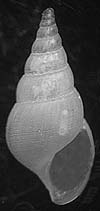
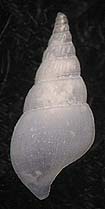
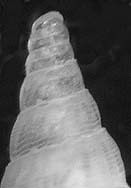
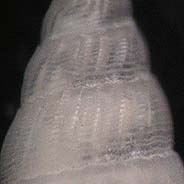
Close-up of protoconch Close-up of ribs and spirals on upper adult whorls
The color of the Rissoina striosa shell is whitish to glassy. The shell is semi-translucent, fairly fragile, the whorls slightly rounded, and with a tall spire. The upper adult whorls have oblique ribs; the body whorl ribs are weak to nonexistent. There are fine spiral cords which are well defined on the upper adult whorls but become weaker on the body whorl. The aperture is rounded. There is a protoconch of 3+ smooth whorls. Overall, there are 6 to 10 whorls and the sutures are distinct.
Similar species: Rissoina princeps (protoconch of 2 whorls, spiral cord on early adult whorls, to 11 mm); Rissoina decussata (protoconch of 2 whorls, more stout)
Long Key: only the pictured immature shell has been found
Key terminology choices: slender, ribs dominant, oval, tiny, smooth, none, very tall
References: Abbot, p. 76; Redfern, p. 33
BACK
Sayella
fusca
Brown Sayella
Key ID features:
“double” suture, fragile, columella twist Size: 3 to 5 mm


The color of the Sayella fusca shell is pale brown, the base of the shell the darkest in color. The shell is slender, translucent, and fragile. The whorls are rounded and convex. Spiral threads can be seen under high magnification. The internal structure of the shell is quite visible giving the appearance of having double sutures. The aperture is tear-drop in shape with a thin, very fragile, outer lip. The aperture lip is rounded below and there is a twist on the inner lip. There are 6 to 8 whorls and the sutures are distinct.
Long Key:
Key terminology choices: slender, smooth, tear-drop, minute, fold, none, very tall
References: Abbot, p. 300; Rehder, p. 632
BACK
Odostomia laevigata
Variable Odostome
Key ID features: smooth, immersed protoconch
Size: 3 to 5 mm

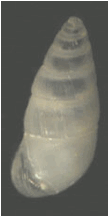
The color of the Odostomia
laevigata shell is clear/glassy to white. The shell is
extremely variable in shape, the whorls are smooth but vary from almost
straight-sided to moderately convex. The protoconch is smooth, rounded, and immersed in the
next whorl. There may be a small
umbilicus. The aperture is oval to teardrop in shape;
the outer lip is thin and rounded.
There is a low fold on the columella (although it may be deep
within). There are 5 to 7 whorls and the sutures are easy to
identify.
The live Odostomia laevigata has
numerous opaque white dots and splotches on a clear background. The antennae
are clear and short.
Variation: shape alternative (see Redfern, picture 604D)


Long Key: in Halimeda on flat off Caloosa Cove
Key terminology choices: slender, smooth, tear-drop, minute, smooth, none, very tall
References: Abbot, p. 291; Abbot and Morris, p. 263; Redfern, p. 145 (Sayella laevigata); Rehder, p. 627
BACK
Schwartziella
bryerea
Caribbaen Risso
Key ID features:
protoconch, ribs
Size: 3.5 to 5.5 mm
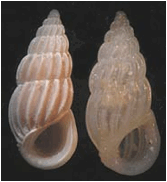
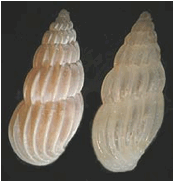
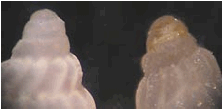
Close-up of protoconchs of 2.5 whorls
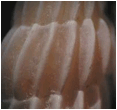


Close-up of adult whorl Close-ups of swelling on base
The color of the Schwartziella bryerea shell is white to slightly yellowish. The shell is solid with a high spire comprised of slightly rounded whorls (and a protoconch of 2.5 whorls). The adult whorls have strong ribs; the 14 (to 22) ribs on the body whorl continuing to the base. There is a small swelling on the base of the shell. The aperture is tear-drop in shape and has a thick outer lip. There is a significant callus on the inner portion (and sometimes a small internal swelling toward the upper end of the outer lip). There are 7 to 9 whorls and the sutures are distinct.
The live Schwartziella bryerea is white. The antennae are long, slender, and white.
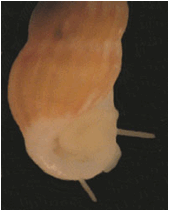
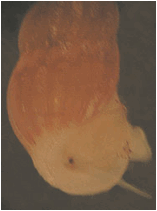
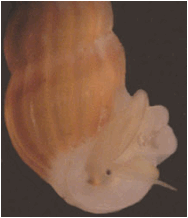
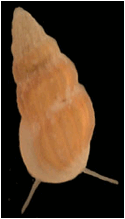
Schwartziella bryerea emerging from shell and
crawling
Similar species: Schwartziella fischeri (protoconch of 1.5 whorls); Schwartziella vanpeli (protoconch of 1.5 whorls); Rissoina elegantissima (excavated behind columella, more ribs on body whorl); Rissoina krebsii (spiral cords on body and adult whorls); Rissoina multicostata (spiral cords on base)
Long Key:
Key terminology choices: slender, ribs, tear drop, tiny, smooth, none, very
tall
References: Abbot, p. 76 (Rissoina bryerea); Abbot and Morris, p. 151 (Rissoina bryerea); Redfern, p. 35
BACK
Schwartziella fischeri
Fischer’s Risso
Key ID features:
swelling on base, strong ribs
Size: 3 to 5 mm
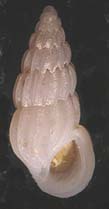

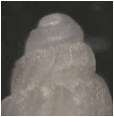
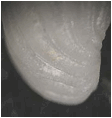
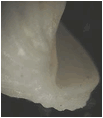
Close-up of protoconch Close-ups of swelling at base
The color of the Schwartziella fischeri shell is white to slightly yellowish. The shell is solid with a high spire comprised of slightly rounded whorls (and a protoconch of 1.5 whorls). The adult whorls have strong ribs; the 12 (to 16) ribs on the body whorl continue to the base. There is a small swelling on the base of the shell. The aperture is tear-drop in shape and has a thick outer lip. There is a significant callus on the inner portion. There are 7 to 9 whorls and the sutures are distinct.
The operculum is translucent and yellow-brown.

Similar species: Schwartziella bryerea (protoconch of 2.5 whorls); Schwartziella vanpeli (smaller, ribs with subsutural shoulder); Rissoina elegantissima (protoconch of 2.5 whorls, excavated behind columella) Rissoina krebsii (spiral cords on body and adult whorls); Rissoina multicostata (spiral cords on base)
Long Key:
Key terminology choices: slender, ribs, tear-drop, tiny, smooth, none, very tall
References: Redfern, p. 35; Lee, p. 64
BACK
Schwartziella vanpeli
Van Pel’s Risso
Key ID features:
swelling on base, shouldered ribs
Size: 2.5 to 3.5 mm
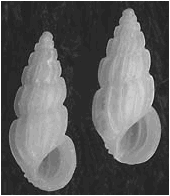
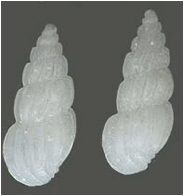
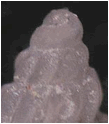
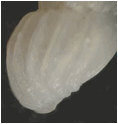
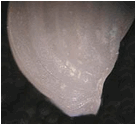
Close-up of apex Close-ups of swelling and ribs on base
The color of the Schwartziella vanpeli shell is white to yellowish. The shell is solid with a high spire comprised of slightly rounded whorls (and a protoconch of 1.5 whorls, the half whorl at an angle). The adult whorls have strong ribs; the 11 (to 14) ribs on the body whorl continuing to the base. There is a small swelling on the base of the shell. The aperture is tear-drop in shape and has a thick outer lip. There is a significant callus on the inner portion. There are 7 to 9 whorls and the sutures are distinct.
Similar species: Schwartziella bryerea (protoconch of 2.5 whorls); Schwartziella fischeri (larger, ribs without subsutural shoulder); Rissoina elegantissima (protoconch of 2.5 whorls, excavated behind columella) Rissoina krebsii (spiral cords on body and adult whorls); Rissoina multicostata (spiral cords on base)
Long Key:
Key terminology choices: slender, ribs, tear-drop, tiny, smooth, none, very tall
References: Redfern, p. 36
BACK
Seila
adamsii
Adams’ Miniature Cerith
Key ID features: squarish cords
Size: 6 to 12 mm



Close-up of cords and striations
The color of the Seila adamsii shell is yellowish-brown. The shell is tall and slender with flat-sided whorls and a pointed apex. Each whorl has 3 squarish cords (4 on the body whorl) between which there are microscopic axial striations. The base of the shell is set off by a small cord, smooth and flat (to slightly concave). The aperture is oval, the outer lip thin and undulating. The canal is short and twisted. There are 11 to 13 whorls and the sutures are very difficult to distinguish (except for the presence of a very small cord).
The operculum is translucent, light yellowish-brown, and triangular with transverse ridges.


The live Seila adamsii is clear to yellowish-white with small whitish spots. The antennae are fairly short, not much tapered, and clear.
Long Key: amongst Porites coral on Old Dan Bank
Key terminology choices: slender, spirals, oval, tiny, smooth, short, very tall
References: Abbot, p. 110; Abbot and Morris, p. 168; Lee, p. 88; Redfern, p. 75; Rehder, p. 445 [Note: Redfern indicates that this is very likely not Seila adamsii, and suggests more work is needed to clarify the Seila species.]
Back
Sinezona confusa
Caribbaen Sinezona
Key ID features:
slit, size, sculpture
Size: .5 to 1 mm
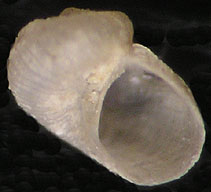
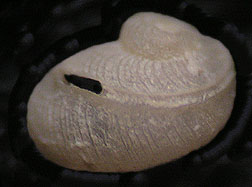
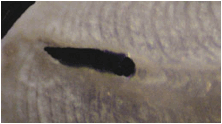
Close-up of slit and axial sculpture
The color of the Sinezona confusa shell is translucent/clear to white.. The shell is carinate with a spiral gutter formed by two ridges. The gutter contains a slit (which may be open to the aperture or be completely encompassed by the body whorl). There are slanting riblets above and below the gutter. The aperture is quite large and an elongated “D.” The outer lip is thin and fragile. The umbilicus is partially obscured. There are 2 to 3 whorls (the body whorl is dominant) and the sutures are distinct.
The operculum is rounded, translucent, and tinted with yellowish-brown.

Operculum (lightly stained)
The live Sinezona confusa is clear, with a dark border. The antennae are clear and bristled with small teeth-like projections on each side.
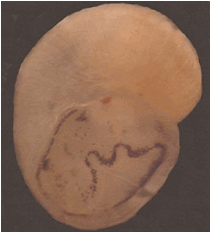
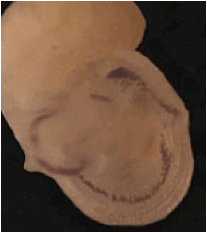
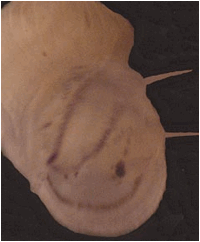
Sinezona confusa emerging from shell
Long Key: in Halimeda opuntia on flat off Caloosa Cove, Old Dan
Key terminology choices: flattened, ribs dominant, oval, minute, smooth, none, equal
References: Redfern, p. 2
Back
Siphonaria alternata
Say’s False Limpet
Key ID features:
limpet shape, ribs pattern
Size: 14 to 20 mm
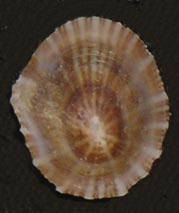
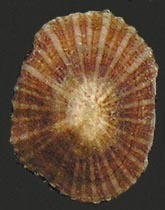

The color of the Siphonaria alternata shell is light to dark brown, the ribs white to cream. The shell is irregularly round in outline, triangular in side view, with a low to moderately elevated apex. There are ribs radiating from the apex, every other rib usually larger. The aperture is open, with a bulge on one side. The interior color is brown near the center, more nearly white near the margins. The surface color is visible, especially near the margins.
The live Siphonaria alternata is dark greenish-brown to black, with some white spots.
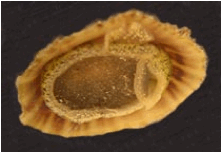
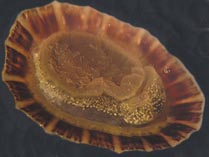
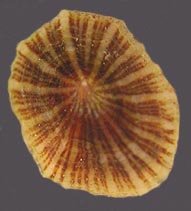
Underside and typical views of live Siphonaria alternata
Similar species: S. pectinata (ribs white and same size)
Long Key: shore rocks, seawalls (difficult to dislodge)
Key terminology choices: rounded, ribs, open, small, none, none, wide
References: Abbot, p. 335; Abbot and Morris, p. 273; Redfern, p. 185; Rehder, p. 652
Back
Siphonaria pectinata
Striped False Limpet
Key ID features: limpet shape, ribs same size
Size: 14 to 25 mm
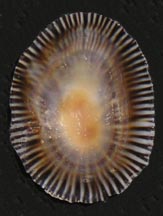
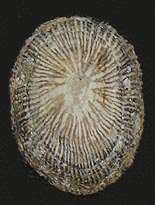

The color of the grooves of the Siphonaria pectinata shell is light to dark reddish-brown, the ribs white to cream. The shell is irregularly oval in outline, triangular in side view, with a low to moderately elevated apex (which is often eroded). There are numerous ribs radiating from the apex. The brown grooves between the ribs often branch near the margins. The aperture is open, with a bulge on one side. The interior color may vary from light to fairly dark; the brown surface color is clearly visible near the margins.
The live Siphonaria pectinata is greenish with white spots.
Similar species: S. alternata (every other rib larger)
Long Key: shore rocks, seawalls (difficult to dislodge)
Key terminology choices: rounded, ribs, open, small, none, none, wide
References: Abbot, p. 335; Abbot and Morris, p. 274; Rehder, p. 652
Back
Smaragdia viridis
Emerald Nerite
Key ID features:
color, shape
Size: 5 to 8 mm
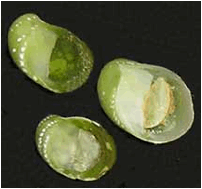
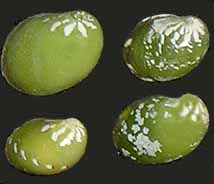
![]()
Close-up of small teeth on columella
The color of the Smaragdia viridis shell is green with a variety of white spots and splotches. The shell is rounded and smooth with a very low spire. The aperture is a half-moon in shape. The outer lip is thin and there are a few small teeth (sometimes much eroded) on the columella. There are 3 to 5 whorls and the sutures are moderately distinct.
The operculum is an irregular tear-drop in shape, thin with a small projection, and green in color.


The live Smaragdia viridis is light green bordered in black. The antennae are light green, long, and tapered.
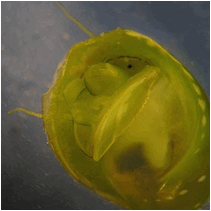
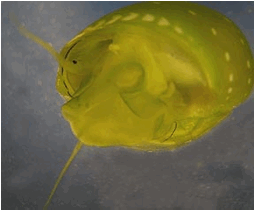
Smaragdia viridis emerging from shell
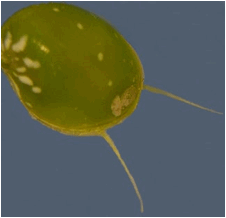
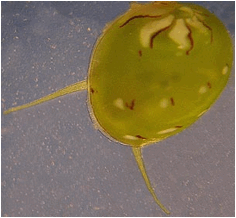
Two shell color patterns of Smaragdia viridis
Long Key: in grass beds on blades of Thalassia
Key terminology choices: rounded, smooth, half-moon, tiny, teeth, none, equal
References: Abbot, p. 65; Abbot and Morris, p. 145; Redfern, p. 19
Back
Steironepion moniliferum
Many-Spotted Dove Shell
Key ID features:
brown knobs
Size: 3 to 6 mm


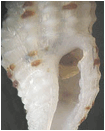
Close-up of aperture and outer lip
The color of the Steironepion moniliferum shell is cream white with rows of spirally elongated brown spots. The shell is slender with a high spire. The 12 (to 14) ribs are crossed by cords (3 to 5 on upper whorls, 10 to 14 on body whorl) creating knobs. The aperture is narrow and 1/3 the height of the shell. There are several teeth inside the outer lip (the upper one being the largest) and a small notch at the upper end. The canal is short. There are 6 to 8 whorls and the sutures are moderately distinct.
The operculum is translucent thin, oval, and yellowish.
![]()
The live Steironepion moniliferum is white with a few brown spots. The antennae are short and white with brown spots. The siphon is white.
Long Key: in Halimeda at patch reef off Caloosa Cove
Key terminology choices: fusiform, beaded, narrow, tiny, smooth, short, x tall
References: Abbot, p. 201 (Nassarina monilifera); Abbot and Morris, p. 224 (Nassarina monilifera); Redfern, p. 99; Rehder, p. 546 (Nassarina monilifera)
Back
Stellatoma stellata
Stellate Turrid
Key ID features:
angular ribs, notch
Size: 4 to 6 mm
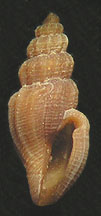
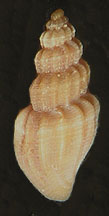

Close-up of notch
The color of the Stellatoma
stellata shell is light to dark brown, sometimes with a light band at the
periphery. The shell is angular
(smaller shells being the most pronounced) with convex whorls which increase
rapidly in size. The 9 (to 12)
ribs are angled at the shoulder and are crossed by numerous spiral cords (the
strongest cord often at the periphery).
The cords become more prominent on the base. The aperture is
narrow and there is a fairly deep notch at the upper end (usually with a
triangular projection on the inside of the outer lip just below the
notch). Mature shells have a varix
behind the outer lip. There are 6
to 7 whorls and the sutures are
distinct.
The live Stellatoma stellata is clear
with white spots. The antennae are little extended beyond the eyes.
Similar species: Pyrgocythara filosa (narrower body whorl, smaller protoconch); Pyrgocythara hemphilli (narrower body whorl)
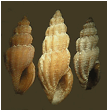
Stellatoma
stellata, P. hemphilli, P. filosa
Long Key: dead shells at most shallow flats, Channel 5 Bay side flat, Old Dan Bank, bight
Key terminology choices: fusiform, ribs dominant, narrow, tiny, smooth, short, very tall
References: Abbot, p. 278 (Mangelia stellata); Redfern, p. 134; Rehder, p. 621 (Mangelia stellata)
Back
Stramonita
haemostoma
Florida Rock-Shell
Key ID features:
colorful aperture, strong shell
Size: 37 to 87 mm
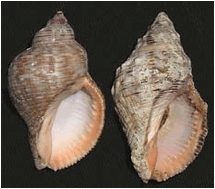
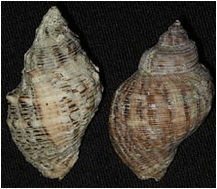
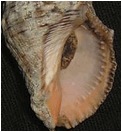
Close-up of aperture
The color of the Stramonita haemostoma shell is grayish with some brown and white markings. The shell is strong with a large body whorl and moderate spire. Spiral cords are present over the entire shell, and many shells have small knobs at the shoulder. The aperture is yellowish-orange to salmon in color, rather large, and an elongate oval. The interior of the outer lip has many elongated ridges. The columella is folded at the base and there is a short canal. There are 5 to 7 whorls and the sutures are moderately distinct.
The operculum is thin, reddish-brown, and D-shaped.


The live Stramonita haemostoma is dark brown to greenish/black. The antennae are fairly short; dark in color with a clear/white tip.
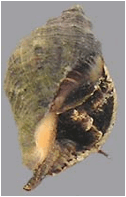
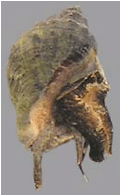
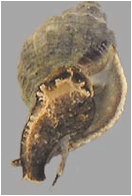
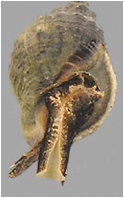
Stramonita haemostoma emerging from shell
Similar species: S. rustica (purple spot on base of columella)
Long Key: on intertidal rocks
Key terminology choices: kite, beaded, oval, large, fold, short, tall
References: Abbot, p. 180 (Thais haemostoma); Abbot and Morris, p. 215 (Thais haemostoma); Lee, p. 105; Redfern, p. 90; Rehder, p. 524 (Thais haemostoma)
Back
Stramonita rustica
Rustic Rock-Shell
Key ID features:
purple spot on columella
Size: 25 to 42 mm
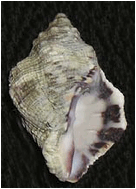
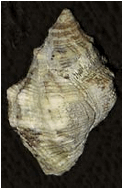

Close-up
of aperture
The color of the Stramonita rustica shell is grayish with some brown and white markings. The shell is strong with a large body whorl and moderate spire. Spiral cords are present over the entire shell, and many shells have small knobs at the shoulder. The aperture is white with brown spots on the outer lip and a purplish-brown splotch on the lower columella. The aperture is an elongate oval in shape. The outer lip has a serrated edge and there are short ridges within. The columella is fairly straight and there is a short canal. There are 5 to 7 whorls and the sutures are moderately distinct.
The operculum is thin, reddish-brown, and D-shaped.


Similar species: S. haemostoma (salmon or yellowish aperture)
Long Key: on shore rocks
Key terminology choices: kite, beaded, oval, medium, smooth, short, tall
References: Abbot, p. 180 (Thais rustica); Abbot and Morris, p. 216 (Thais rustica); Redfern, p. 90; Rehder, p. 525 (Thais rustica)
Back
Strictispira solida
Solid Turrid
Key ID features:
varix, knob-like callus
Size: 13 to 19 mm



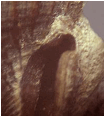

Close-up of varix Close-ups of spout and callus


Close-up of ribs and cords Close-up of subsutural channel
The color of the Strictispira
solida shell is dark brown to almost black (beach-worn shells fade to a
lighter color). The shell is robust and the body whorl has
17 to 19 ribs. The ribs are
crossed by numerous spiral cords and threads (forming low knobs on the ribs),
the cords becoming dominant at the base as the ribs fade. There is a cord below the suture and a
subsutural channel with a number of fine spiral threads between the cord and
the top of the ribs. There is a
varix behind the outer lip. The aperture is fairly narrow and there is
a prominent spout-like notch at the upper end. The columella side of the spout has a sizable knob-like
callus. There are 8 to 11 whorls and the sutures are moderately
distinct.
Note: Rehder indicates that Crassispira cubana has a thick varix behind the outer lip, but Abbot, Abbot/Morris, and Redfern make no reference to this feature. The shell pictured here has a varix behind the outer lip and a deeper notch at the upper end of the aperture than the shell pictured as Crassispira cubana.
Similar species: Pyrgospira tampaensis (no varix, crenulate outer lip); Crassispira cubana (white knobs, smaller spout and callus)
Long Key:
Key terminology choices: fusiform, ribs dominant, narrow, small, smooth, short, very tall
References: Abbot, p. 270 (Drillia solida); Lee, p. 126; Redfern, p. 127; Rehder, p. 621 (Crassispira fuscescens)
Back
Strombus alatus
Florida Fighting Conch
Key ID features:
aperture color, shape
Size: 7.5 to 10 cm
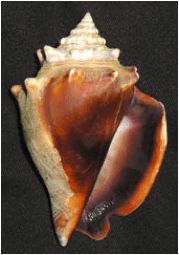
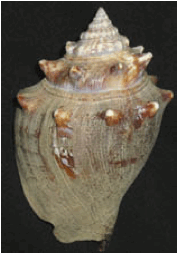
The color of the Strombus alatus shell is brown (although covered by a gray periostracum). The shell is strong with a spire of moderate height. The larger whorls have short knobs at the shoulder and the shell is otherwise quite smooth except for spiral cords on the base. The aperture is elongate (nearly ľ the height of the shell) and the outer lip moderately thick and slightly flaring. The interior of the aperture is darkly colored, from reddish brown to almost black. There is a notch near the lower end of the outer lip. There are 7 to 9 whorls and the sutures are moderately distinct.
The operculum is slightly curved, elongate, slender, and brown
![]()
![]()
The live Strombus alatus is greenish/gray to black. The antennae are very slender and greenish/brown. The eyestalks are white with greenish/brown markings. The siphon is black with white spots.
Long Key: flat off Duck Key
Key terminology choices: kite, beaded, flaring, large, smooth, short, tall
References: Abbot, p. 144; Abbot and Morris, p. 183; Lee, p. 74; Rehder, p. 470
Back
Strombus costatus
Milk Conch
Key ID features: white interior, shape
Size: 10 to 18 cm
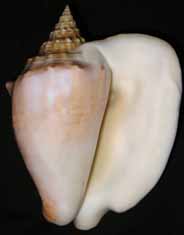
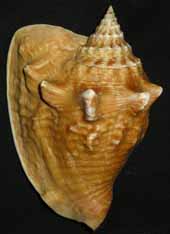
The color of the Strombus costatus shell is light brown. The mature shell is very strong with a pointed spire of moderate height. The body whorl has strong knobs at the shoulder and spiral cords which continue to the base of the shell. The knobs on the upper whorls are mere bumps. The aperture is elongate (nearly 4/5 the height of the shell) and the outer lip very thick and flaring. The interior of the aperture is milk white (sometimes with a hint of yellow or peach). A smooth, glossy parietal callus covers surface features on the front of the shell. There is a notch near the lower end of the outer lip. There are 8 to 10 whorls and the sutures are distinct.
The operculum is slightly curved, long, slender, and brown
![]()
![]()
The live Strombus costatus is brownish-green. The antennae are short and green; the eyestalks greenish-brown. The siphon is greenish.
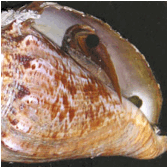
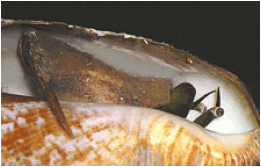
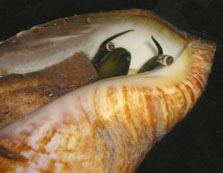
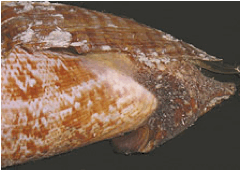
Strombus costatus emerging from shell
Note: immature shells lack the thick outer lip.

Immature Strombus costatus
Note: Malacolog new gives genus Aliger.
Long Key: in channel southeast of Long Key
Key terminology choices: kite, beaded, flaring, very large, smooth, short, tall
References: Abbot, p. 144; Abbot and Morris, p. 184; Lee, p. 75; Redfern, p. 46; Rehder, p. 473
Back
Strombus gigas
Queen Conch
Key ID features:
pink interior, flaring lip Size: 18 to 30 cm
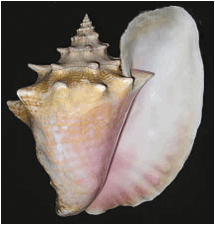
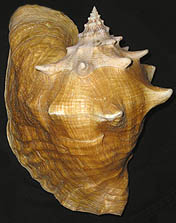
The color of the Strombus gigas shell is cream white to light brown (usually covered with a light brown periostracum). The mature shell is very strong with a pointed spire of moderate height. The whorls have strong knobs at the shoulder and spiral cords which continue to the base of the shell. The knobs on the larger whorls are quite large and triangular. The aperture is elongate (nearly 3/4 the height of the shell) and the outer lip moderately thick and flaring. The interior of the aperture is glossy white and infused with pink. There are a series of undulations at the lower end of the outer lip. There are 11 to 14 whorls and the sutures are distinct.
The operculum is slightly curved, long, slender, and brown. Note: immature shells lack the
thick outer lip
![]()
![]()

Immature Strombus gigas
The live Strombus gigas has a grayish-green foot. The antennae and siphon are black with a few greenish/white spots. The antennae are little extended beyond the eye.
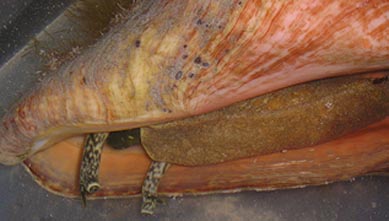
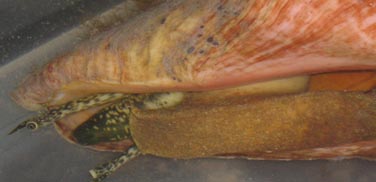
Strombus gigas emerging from shell
Note: Malacolog now gives genus as Eustrombus.
Long Key: in shallow grass beds in many locations
Key terminology choices: kite, beaded, flaring, very large, smooth, short, tall
References: Abbot, p. 144; Abbot and Morris, p. 184; Redfern, p. 46; Rehder, p. 471
Back
Strombus raninus
Hawk-wing Conch
Key ID features: flaring lip, color, shape
Size: 7 to 12 cm
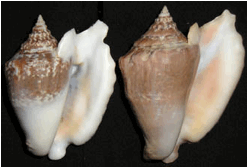
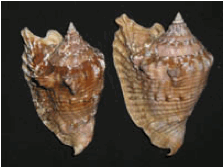
The color of the Strombus raninus shell is light tan to dark brown. The shell is strong with a pointed spire of moderate height (spire whorls have varices). The body whorl has strong knobs at the shoulder and features spiral cords which get larger near the lip. The aperture is elongate (nearly ľ the height of the shell) and the outer lip moderately thick and flaring. The interior of the aperture is infused with yellow, pink, or peach, on a white background. There is a notch near the lower end of the outer lip. There are 8 to 10 whorls and the sutures are moderately distinct.
The operculum is slightly curved, long and slender, and brown.
![]()
![]()
The live Strombus raninus is mottled white and brown. The eyestalks are prominent and colored with white and brown, the antennae are brownish, slender, and extend little beyond the eye. The siphon is spotted with white; the tip is dark in color.
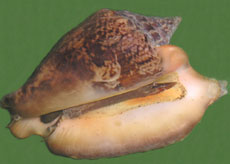
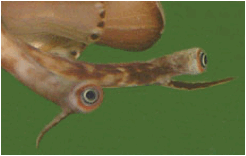
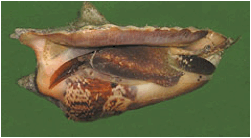
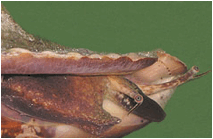
Strombus raninus emerging from shell
Note: Malacolog now gives genus as Lobatus.
Long Key: in shallow grass beds in many locations, especially Channel 5 Bay side flat
Key terminology choices: kite, beaded, flaring, large, smooth, moderate, tall
References: Abbot, p. 144; Abbot and Morris, p. 185; Redfern, p. 47; Rehder, p. 472
Back
Suturoglypta iontha
Ravenel’s Dove Shell
Key ID features: strong ribs, interspaces, sutures
Size: 6 to 9 mm


The color of the Suturoglypta
iontha shell is gray to white, with brown markings. The shell is tall and slender with a high pointed spire. The 14 ribs are strong and the
interspaces about the same width as the ribs. The ribs fade below the periphery of the body whorl; spiral
cords are most evident on the base of the shell. The suture is deep.
The aperture is narrow with a
small notch at the upper end; the outer lip thickened (and mature shells may
show denticles within). There are
8 to 10 whorls and the sutures are
distinct.
Similar species: Costoanachis catenata (chain-lick pattern, more robust); C. semiplicata (fewer ribs, suture less deep); C. sparsa (ribs not as strong, sutures less pronounced); C. translirata (ribs not as strong, sutures less pronounced)
Long Key:
Key terminology choices: fusiform, base, narrow, tiny, smooth, short, very tall
References: Abbot, p. 196 (Anachis iontha); Lee, p. 116; Rehder, p. 539 (Anachis iontha) [Note: Abbot indicates A. hotessieriana is a synonym, Rehder indicates A. hotessieriana is from the West Indies.]
Back
Luria
cinerea
Atlantic Gray Cowrie
Key ID features:
size, color, aperture teeth
Size: 19 to 37 mm
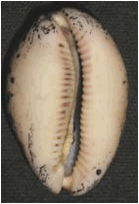
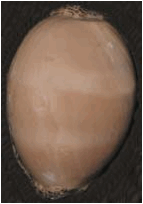
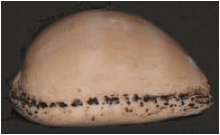
The color of the Luria cinerea shell is grayish to brownish-mauve. There are spots of dark brown or black around the margins of the shell and two pale bands encircle the shell. The base of the shell is cream to ivory in color. The aperture is very narrow and runs the length of the shell. There are numerous (20 to 28 on the outer lip, 16 to 20 on the inner lip) white or cream ridges (often darker color between) on the lips of the aperture. The body whorl is dominant (the other whorls are very small and difficult to identify in mature shells, although sutures are sometimes faintly discernible near the apex).
Similar species: Erosaria acicularis (fewer ridges along aperture, lighter color)
Long Key: uncommon, under ledges or rocks; in old conch shells
Key terminology choices: rounded, smooth, elongate, medium, teeth, short, tall
References: Abbot, p. 149 (Cypraea cinerea); Abbot and Morris, p. 194 (Cypraea cinerea); Lee, p. 77; Redfern, p. 51 (Talparia cinerea); Rehder, p. 480 (Cypraea cinerea)
Back
Tectarius antonii
False Prickly Winkle
Key ID features:
multispiral operculum, large row of knobs
Size: 13 to 23 mm
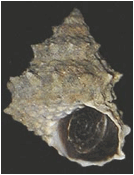
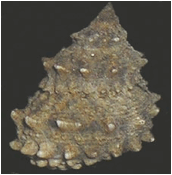
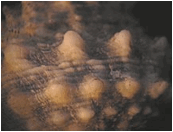

Close-up of knobs showing size difference Close-up of
columella
The color of the Tectarius antonii shell is gray to grayish-white; the knobs usually lighter (off-white) in color. The tip of the pointed apex is light gray. The shell is stocky and somewhat triangular; the whorls increasing sharply in size giving a somewhat squat appearance. There are several rows of triangular knobs (the largest row at the periphery) with spiral threads between the rows. The aperture is rounded and the interior is brown. The columella is only very slightly flattened at the base. There are 8 to 9 whorls and the sutures are moderately well defined.
The operculum is brown, round, and multispiral.

Similar species: Nodilittorina tuberculata (inner lip of columella more flattened and shelf-like, operculum paucispiral, large knobs uniform in size)


Tectarius antonii (far left and far right), Echinolittorina tuberculata (two in center)
Long Key: on rocks above high tide line, e.g., rocks near bridge at Calossa Cove [Note: in Long Key area Tectarius antonii is much less common that Echinolittorina tuberculata.]
Key terminology choices: stocky, beaded, round, small, smooth, none, equal
References: Abbot, p. 70 (Echininus nodulosus); Abbot and Morris, p. 149 (Echininus nodulosus); Redfern, p. 29; Rehder, p. 408 (Echininus nodulosus)
Back
Tegula fasciata
Smooth Atlantic Tegula
Key ID features:
flattened shape, 2 small teeth
Size: 12 to 19 mm
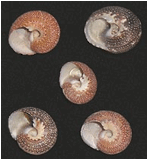
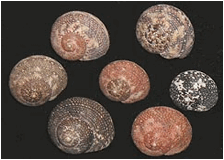




Close-up of tooth at base of columella Close-up of microscopic spiral lines
The color of the Tegula fasciata shell is extremely variable: red, brown, black, white, tan. The shell is flattened to turbinate with a low spire. The whorls are rounded and smooth (although there are microscopic spiral lines). There is a deep umbilicus with a white callus. The aperture is oval with two small teeth at the base of the columella. There are 4 to 5 whorls and the sutures are distinct.
The operculum is round, thin, multispiral, and light yellow to orange-brown.

The live Tegula fasciata is white with dark brown to black lines. The antennae are long and slender. The antennae are bristled and have black longitudinal lines. There are several white “antennae-like” structures near the operculum.
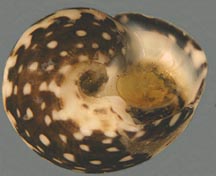
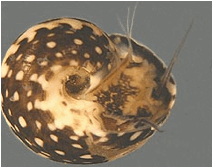
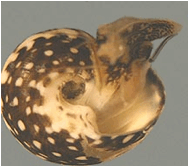
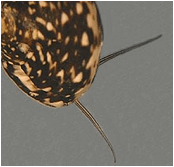
Tegula fasciata emerging from shell and crawling
Note: immature shells have ridges leading into the umbilicus

Ridges and umbilicus of immature Tegula fasciata
Long Key: very common in shallow grass beds
Key terminology choices: flattened, smooth, round, small, teeth, none, equal
References: Abbot, p. 50; Abbot and Morris, p. 138; Redfern, p. 13; Rehder, p. 384
Back
Teinostoma biscaynense
Biscayne Teinostoma
Key ID features:
size, callus
Size: 1.8 to 2.5 mm
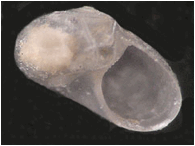
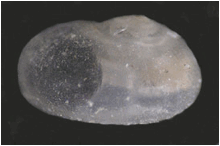
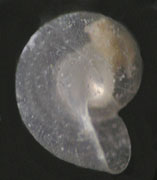
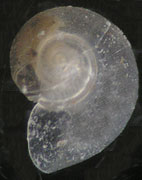
The color of the Teinostoma biscaynense shell is translucent/clear to white. The shell is very small but solid, smooth, flattened with a low spire. There is a callus over the umbilicus. The aperture is oval, the outer lip thin. There are 3 to 4 whorls and the sutures are fairly well defined.
The operculum is thin, round, and multispiral.

Similar species: T. lerema (smaller, heavier shell); T. lituspalmarum (striations); T. nesaeum (carinate)
Long Key:
Key terminology choices: flattened, smooth, oval, minute, smooth, none, wide
References: Abbot, p. 88; Lee, p. 67; Redfern, p. 44
Back
Teinostoma lerema
Key ID features: size, callus, solid shell
Size: .7 to 1 mm
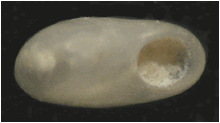
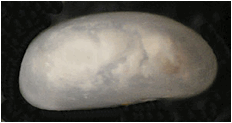
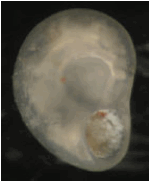
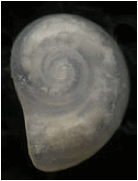
The color of the Teinostoma lerema shell is translucent/clear to white. The shell is very small but solid, smooth, flattened with a very low spire. There is a heavy callus over the umbilicus. The aperture is oval, the outer lip solid. There are 2 to 4 whorls and the sutures are not very clearly defined.
Similar species: T. biscaynense (larger, less robust); T. lituspalmarum (striations); T. nesaeum (carinate)
Long Key:
Key terminology choices: flattened, smooth, oval, minute, smooth, none, wide
References: Abbot, p. 88
Back
Teinostoma lituspalmarum
Key ID features:
size, carinate, keel
Size: 1.5 to 2.5 mm
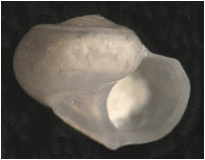
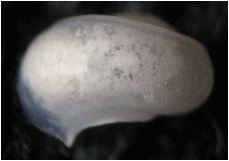
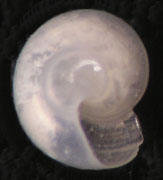
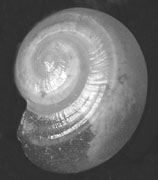
The color of the Teinostoma lituspalmarum shell is translucent/clear to white. The shell is very small, flattened with a low spire. There is a spiral ridge at the shoulder of the body whorl (making the shell carinate). There is a callus over the umbilicus which is encircled by a keel. The aperture is oval, the outer lip thin. There are 2 to 4 whorls and the sutures are not very clearly defined.
Similar species: T. biscaynense (smooth); T. lerema (smaller, heavier shell); T. nesaeum (striations)
Long Key:
Key terminology choices: flattened, smooth, oval, minute, smooth, none, equal
References: Abbot, p. 88
Back
Teinostoma nesaeum
Key ID features:
size, striations, callus Size: 1.2 to 2 mm
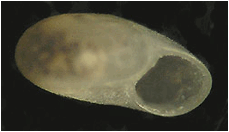
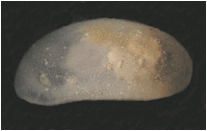
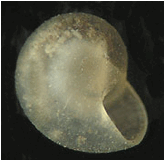
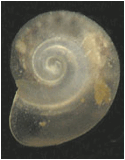
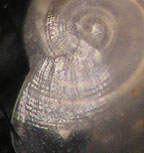
Close-up of surface striations
The color of the Teinostoma nesaeum shell is translucent/clear to white. The shell is very small but solid, flattened with a low spire. The upper surface of the shell has microscopic spiral striations. There is a callus over the umbilicus. The aperture is oval, the outer lip thin. There are 2 to 4 whorls and the sutures are not very clearly defined.
Similar species: T. biscaynense (smooth); T. lerema (smaller, heavier shell); T. lituspalmarum (carinate)
Long Key:
Key terminology choices: flattened, smooth, oval, minute, smooth, none, wide
References: Abbot, p. 88; Redfern, p. 44 [Redfern cites a reference indicating T. nesaeum is a synonym for T. biscaynense. Malacolog indicates the same.]
Back
Tenaturris bartlettii
Bartlett’s Mangelia
Key ID features:
color, ribs, notch
Size: 12 to 18 mm

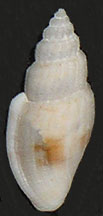
The color of the Tenaturris bartlettii shell is white with brown patches (especially on the body whorl). The shell is fusiform with fairly flat-sided whorls and a spire of moderate height. The 17 (to 20) ribs are crossed by numerous smaller spiral cords. The aperture is narrow and the outer lip is backed by a varix. There is a deep notch at the upper end of the aperture. The canal is very short and open. There are 6 to 8 whorls and the sutures are distinct as the size of the whorls increases rapidly.
The live Tenaturris bartlettii is whitish with opaque white lines (and a few orange spots). The antennae are fairly short and clear beyond the eye. The siphon has white and orange spots.
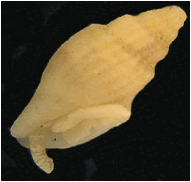
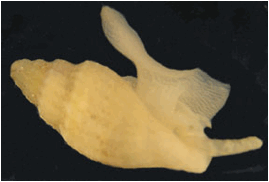
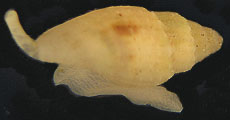
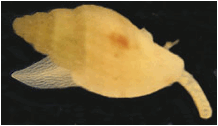
Tenaturris bartlettii emerging from shell and crawling
Note: Malacolog gives Tenaturris inepta as current name.
Long Key: channel end of bight
Key terminology choices: fusiform, ribs dominant, narrow, small, smooth, short, very tall
References: Abbot, p. 278 (Mangelia bartlettii); Redfern, p. 135
Back
Teralatirus cayohuesonicus
Key West Latirus
Key ID features:
shape, teeth in aperture, canal
Size: 13 to 25 mm
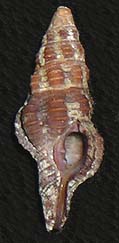
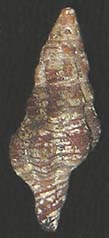
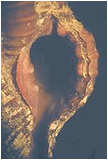
The color of the Teralatirus cayohuesonicus shell is dark brown. The shell is solid, tall, and slender, with a robust spire. The 7 (to 8) swollen ribs are crossed by spiral cords (and with spiral threads between the cords). The aperture is small and oval with a small notch at the upper end. There are two white teeth on the columella and 4 to 5 plications on the interior of the outer lip. The canal is somewhat closed and is of moderate length. There are 5 to 6 whorls and the sutures are moderately distinct.
The live Teralatirus cayohuesonicus is cream with a network of brown lines. The antennae are cylindrical, fairly short, and dark in color.
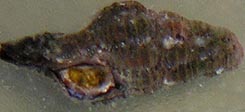
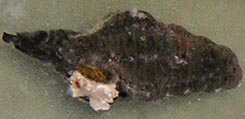
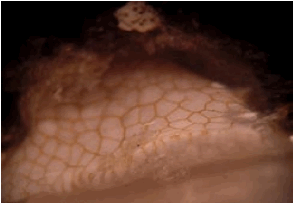
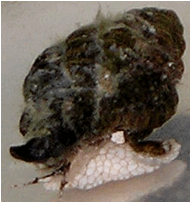
Teralatirus cayohuesonicus emerging from shell and crawling
Long Key: in Laurencia at Channel 5 Bay side flat
Key terminology choices: fusiform, ribs dominant, oval, small, teeth, moderate, very tall
References: Abbot, p. 227 (Dolicholatirus cayohuesonicus); Abbot and Morris, p. 230 (Dolicholatirus cayohuesonicus); Redfern, p. 102
BACK
Terebra glossema
Key ID features: pink apex, ribs, grooves
Size: 17 to 22 mm



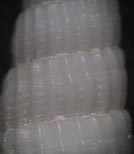
Close-up of apex
Close-up of cord and rib pattern
The color of the Terebra glossema shell is white with a pinkish apex. The shell is tall and slender with a high spire. There are 20 to 22 slightly curved ribs per whorl. Each whorl has 5 (to 6) spiral grooves, the top one the most distinct. The aperture is small and narrow (somewhat rectangular). The columella is smooth; the canal is short and recurved. There are 15 to 17 whorls and the sutures are distinct.
The operculum is tear-drop in shape, thin, and yellowish.
The live Terebra glossema is pure white. The siphon is white.
Long Key: in sand at flat off Calossa Cove
Key terminology choices: slender, ribs dominant, narrow, medium, smooth, short, x tall
References: Abbot, p. 260
Back
Mancinella deltoidea
Deltoid Rock-Shell
Key ID features:
purple/violet on columella, color pattern
Size: 25 to 50 mm
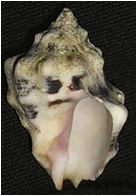
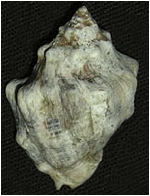
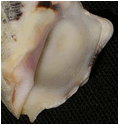
Close-up of aperture
The color of the Mancinella deltoidea shell is gray or white, with brown or purple splotches. The shell is heavy and triangular with a spire of moderate height. The knobs at the shoulder are the largest, those lower on the body whorl and on the spire smaller. There are fine spiral threads. The aperture is an elongated oval with a thin outer lip. The interior is white except that the outer lip is often stained with several patches of purplish-brown and the columella is usually stained with purple or violet. There are 4 to 6 whorls and the sutures are moderately distinct.
The operculum is thin, dark reddish-brown, and triangular with convex sides.


The live Mancinella deltoidea is dark brown to greenish-black, with some small areas of white. The antennae are short and little extended beyond the eye. The antennae are dark at the base and clear at the tip.
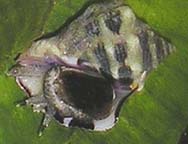
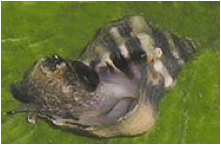
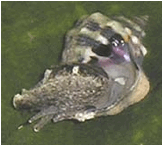
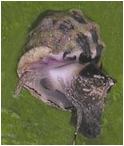
Mancinella deltoidea emerging from shell
Long Key: on shoreline rocks
Key terminology choices: kite, beaded, oval, medium, fold, short, tall
References: Abbot, p. 181 (Thais deltoidea); Abbot and Morris, p. 215 (Thais deltoidea); Redfern, p. 90 (Thais deltoidea); Rehder, p. 525 (Thais deltoidea)
Back
Mitromica foveata
Beaded Florida Miter
Key ID features:
cancellate, columella teeth, color
Size: 6 to 8 mm



Close-up of columella and outer lip
The color of the Mitromica foveata shell is dark brown to gray to black. The shell is symmetrical, tall and slender, with a high spire, and a protoconch of smooth, brown, whorls. Cords and ribs of equal size form a cancellate shell surface. The aperture is narrow and about 40% the height of the shell. The outer lip is thick with teeth on the interior. There are 4 teeth on the columella, the top one the largest. There are 7 to 8 whorls and the sutures are distinct.
The live Mitromica foveata is white. The antennae are short and not much tapered; clear with a few white spots.
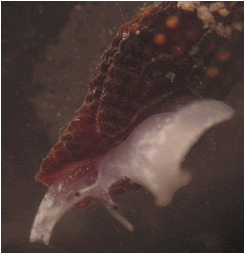
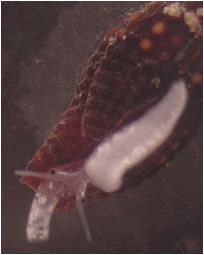
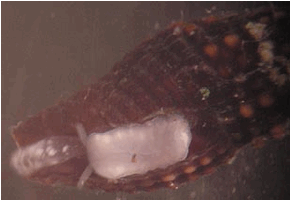
Mitromica foveata emerging from shell
Long Key:
Key terminology choices: fusiform, cancellate, narrow, tiny, teeth, short, very tall
References: Abbot, p. 240 (Thala foveata): Lee, p. 122
Back
Tonna galea
Giant Tun
Key ID features: wide grooves, twisted columella, low
spire
Size: 13 to 18 cm
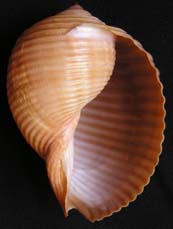
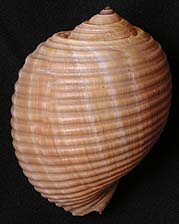
The color of the Tonna galea shell is light brown. The shell is rounded, thin but strong, and with a low spire. There are 19 (to 21) strong spiral ridges which are separated by fairly wide grooves. The aperture is large and open; the outer lip is thin and scalloped (reflecting the ends of the ridges). The columella is sharply twisted about ˝ way up. The umbilicus is tube-like and partially obscured. There are 5 to 7 whorls and the sutures are channeled and distinct.
Similar species: Tonna maculosa (grooves more narrow, no twist in columella, higher spire)

Tonna galea;
Tonna maculosa
Long Key:
Key terminology choices: rounded, spirals, oval, very large, fold, short, tall
References: Abbot, p. 167; Abbot and Morris, p. 206;
Lee, p. 81
Back
Tonna maculosa
Atlantic Partridge Tun
Key ID features: shape, narrow grooves, high spire
Size: 5 to 12 cm
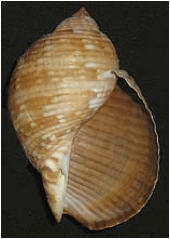
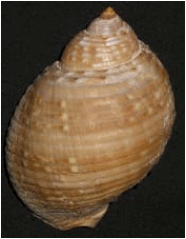
The color of the Tonna maculosa shell is brown with some whitish markings. The shell is rounded, thin but strong, and with a moderate spire. There are 20 (to 22) strong spiral ridges which are separated by narrow grooves. The aperture is large and open; the outer lip is sharp and scalloped (reflecting the ends of the ridges). The umbilicus is tube-like and partially obscured. There are 5 to 7 whorls and the sutures are channeled and distinct.
The live Tonna maculosa is dark brown and white with a long brown/white tail. The antennae and siphon are dark brown and white.
Similar species: Tonna galea (grooves wider, twist in columella, lower spire)

Tonna galea;
Tonna maculosa
Long Key:
Key terminology choices: rounded, spirals, oval, very large, smooth, short, tall
References: Abbot, p. 167; Abbot and Morris, p. 206; Lee, p. 82; Redfern, p. 63 (Tonna pennata); Rehder, p. 504 (Cadus maculosa)
Back
Trachypollia nodulosa
Blackberry Drupe
Key ID features: color, knobs
Size: 13 to 25 mm
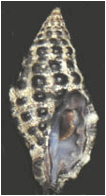
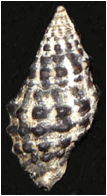

Close-up of aperture
The color of the Trachypollia nodulosa shell is reddish purple to black, with white spots (although this is often hard to see as the shell is frequently encrusted with lime). The shell is fusiform and strong with a pointed spire of moderate height. There are rows of distinct knobs on the body whorl. There are fine spiral threads between the knobs which are crossed by axial growth lines to create very small scales. The aperture is fairly narrow with a channel at the upper end. The outer lip is thickened and has prominent ridges within. The interior is white stained with purple or black. There are 8 to 10 whorls and the sutures are difficult to identify.
The operculum is thin, oblong, and brown.


The live Trachypollia nodulosa is dark green to almost black. The antennae are slender and little extended beyond the eye. The eyestalk is black.
Long Key: Channel 5 Bay side flat in Halimeda
Key terminology choices: fusiform, beaded, narrow, medium, smooth, short, tall
References: Abbot, p. 17 (Morula nodulosa); Abbot and Morris, p. 214 (Morula nodulosa); Redfern, p. 89; Rehder, p. 529 (Morula nodulosa)
Back
Trachypollia turricula
Twin Drupe
Key ID features:
beads, microscopic ridges
Size: 12 to 14 mm
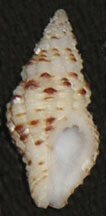
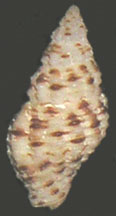
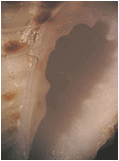
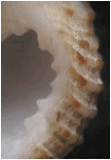
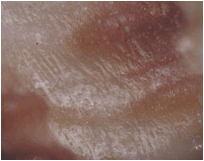
Close-up of columella Close-up of outer lip Close-up of microscopic ridges
The color of the Trachypollia turricula shell is cream to tan to brown, with dark brown beads and/or cords. The shell is sturdy and fusiform. There are beads (often elongated) at the intersections of the ribs and cords. The interspaces show microscopic axial ridges. The aperture is oval with a thick outer lip and a parietal ridge. There are 6 (or 7) teeth inside the outer lip and 3 (or 4) ridges on the columella. The canal is short and straight. There are 6 to 8 whorls and the sutures are distinct.
Long Key:
Key terminology choices: fusiform, beaded, oval, small, teeth, short, tall
References: Abbot, p. 177 (Morula didyma); Lee, p. 105; Redfern, p. 89
Back
Triptychus niveus
Three-Corded
Pyram
Key ID features:
two ridges cross columella, two nodulated cords
Size: 6 to 8 mm


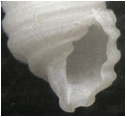
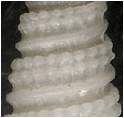
Close-up of ridges and aperture
Close-up of smooth and nodulated cords
The color of the Triptychus niveus shell is white (although fresh shells are glassy and translucent). The shell is tall and slender, with a high spire of flat-sided whorls and a sharp apex. The upper whorls have one nodulated cord and one smooth cord, the lower whorls have 3 spiral cords, the upper 2 nodulated. The body whorl has 6 cords, the last 4 are smooth. The aperture is oval, the outer lip crenulate. Two ridges cross the columella. There are 8 to 9 whorls and the sutures are indented.
The operculum is very thin, comma-shaped, and tinged with yellow.

The live Triptychus niveus is white. The antennae are white, wide at base, and quite short.
Similar species: Peristichia agria (one cord crosses columella, cancellate)


Peristichia agria Triptychus niveus
Long Key: in Halimeda at Old Dan Bank
Key terminology choices: slender, beaded, oval, tiny, teeth, short, very tall
References: Abbot, p. 300; Redfern, p. 145
Back
Pusula pediculus
Coffee Bean Trivia
Key ID features:
shape, riblets
Size: 10 to 18 mm
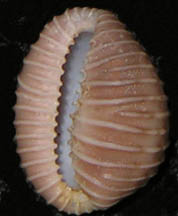
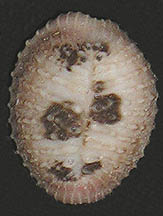
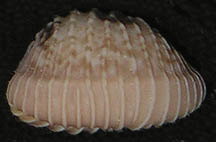
The color of the Pusula pediculus shell is tan to brownish-pink to purplish, with darker spots (often 3 pairs, but the darker areas can be much expanded on some shells). The shell is rounded with a furrow on the upper side. Fifteen to 20 riblets cross the body whorl from lip to lip; the riblets are interrupted by the furrow (and often swollen on either side). The shell surface is microscopically granulose between the ribs. The aperture is very narrow and runs the entire length of the shell. The ends of the riblets give the lips a toothed appearance. Only the body whorl is evident.
The live Pusula pediculus is light brown/tan, with white tubercules and lines on the mantle. The antennae are quite long and slender, tan with white spots. The siphon has white pustules.
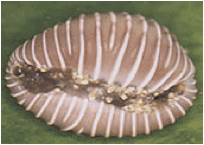
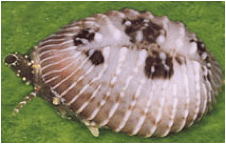
Pusula pediculus withdrawn in shell and crawling without mantle extended.
Long Key: from algae at patch reef off Caloosa Cove
Key terminology choices: rounded, spirals, elongate, small, teeth, short, equal
References: Abbot, p. 147 (Trivia pediculus); Abbot and Morris, p. 195 (Trivia pediculus); Lee, p. 79; Redfern, p. 53 (Trivia pediculus); Rehder, p. 475 (Trivia pediculus)
Back
Niveria quadripunctada
Four-Spotted Trivia
Key ID features:
riblets, shape, dark spots
Size: 4 to 9 mm
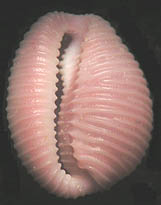
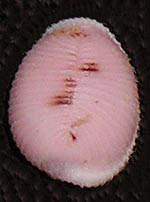
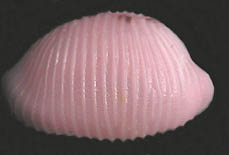
The color of the Neveria quadripunctada shell is light to dark pink, with 2 to 4 dark spots coloring the interspaces near the midline (spots often fade on beachworn shells). The shell is rounded with a furrow on the upper side. Nineteen to 24 riblets cross the body whorl from lip to lip. The aperture is very narrow and runs the entire length of the shell. The ends of the riblets give the lips a toothed appearance. Only the body whorl is evident.
The live Niveria quadripunctada is black (although occasionally burnt orange) There are white spots around the edge of the mantle. The antennae are long and slender, with a mixture of dark and white coloring. The siphon has white pustules; the tip of the siphon appears white.
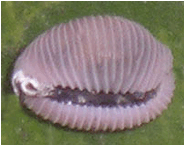
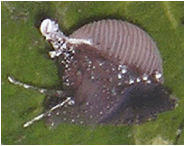
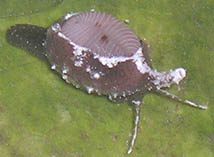
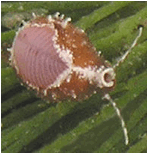
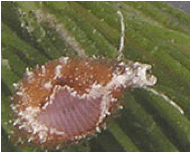
Two color variations of Niveria quadripunctada emerging from shell and crawling
Long Key: on many flats in Halimeda, e.g., Old Dan Bank
Key terminology choices: rounded, spirals, elongate, tiny, teeth, short, tall
References: Abbot, p. 148 (Trivia quadripunctada); Abbot and Morris, p. 196 (Trivia quadripunctada); Redfern, p. 53 (Trivia quadripunctada); Rehder, p. 476 (Trivia quadripunctada)
Back
Truncatella caribaeensis
Caribbean Tuncatella
Key ID features: thin outer lip, early whorls lost
Size: 4 to 8 mm
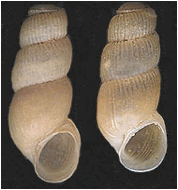
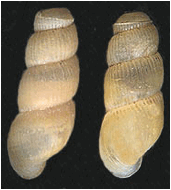
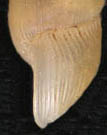
Close-up of outer lip without varix
The color of the Truncatella caribaeensis shell is pale brown to yellow to orange. The shell is cylindrical and truncate; the upper whorls are lost. There are numerous low axial ribs (up to 40) and it is smooth between the ribs. The aperture is oval; the outer lip thin. There are 3 to 4 whorls on the adult shell and the sutures are distinct.
The operculum is thin, oval, and clear (with a hint of yellowish-brown).

The live Truncatella caribaeensis is yellowish-white. The antennae are short and clear.
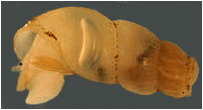
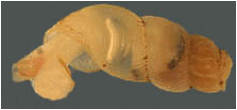
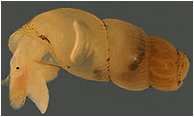
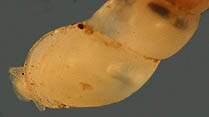
Truncatella caribaeensis emerging from shell and crawling
Note: early whorls are almost always absent on mature shells

Immature Truncatella caribaeensis with early whorls present
Similar species: T. clathrus (varix behind outer lip); T. pulchella (varix behind outer lip)
Long Key: under shore debris at or above high tide line
Key terminology choices: slender, ribs, oval, tiny, smooth, none, x tall
References: Abbot, p. 80; Lee, p. 64; Redfern, p. 38; Rehder, p. 417
Back
Truncatella clathrus
Strong-Ribbed Truncatella
Key ID features:
varix behind outer lip, upper whorls lost
Size: 4 to 6 mm
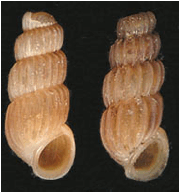
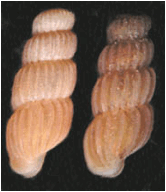
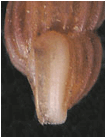
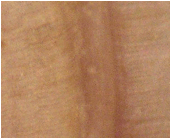
Close-up of varix behind outer lip Spiral threads under high magnification
The color of the Truncatella clathrus shell is pale brown to yellow to orange. The shell is cylindrical and truncate; the upper whorls are lost. There are numerous fairly strong axial ribs (up to 20) and there are closely crowded microscopic spiral threads between the ribs. The aperture is oval; the lip encircles the entire aperture. There is a varix behind the outer lip. There are 3 to 4 whorls on the adult shell and the sutures are distinct.
The operculum is thin, oval, and clear (with a hint of yellowish-brown).

Note: early whorls are almost always absent on mature shells

Immature Truncatella clathrus with early whorls present
Similar species: T. caribaeensis (no varix behind outer lip); T. pulchella (no microscopic spiral threads)
Long Key: under shore debris at or above high tide line
Key terminology choices: slender, ribs, oval, tiny, smooth, none, very tall
References: Abbot, p. 80 (T. scalaris); Redfern, p. 38
Back
Truncatella pulchella
Beautiful Truncatella
Key ID features: varix behind outer lip, upper whorls
lost
Size: 3 to 6 mm
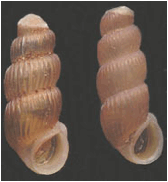
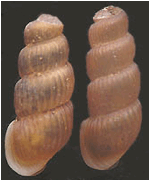
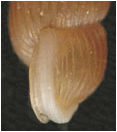
Close-up of varix behind outer lip
The color of the Truncatella caribaeensis shell is pale brown to yellow to orange. The shell is cylindrical and truncate; the upper whorls are lost. There are numerous axial ribs (up to 40) and it is smooth between the ribs. The aperture is oval; the lip encircles entire aperture. There is a varix behind the outer lip. There are 3 to 4 whorls on the adult shell and the sutures are distinct.
The operculum is thin, oval, and clear (with a hint of yellowish-brown).


The live Truncatella pulchella is white but with a dark aura due to many small dark dots. The antennae are short and rounded, clear along edges, small black dots on interior.
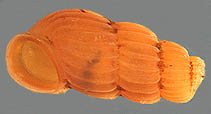
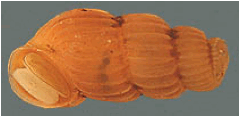
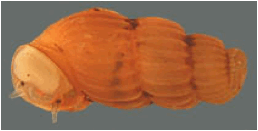
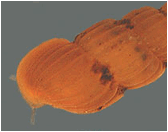
Truncatella pulchella emerging from shell and crawling
Note: early whorls are almost always absent on mature shells
![]()
Immature Truncatella pulchella with early whorls present
Similar species: T. caribaeensis (no varix behind outer lip); T. clathrus (microscopic spiral threads)
Long Key: under shore debris at or above high tide line
Key terminology choices: slender, ribs, oval, tiny, smooth, none, very tall
References: Abbot, p. 80; Abbot and Morris, p. 151; Redfern, p. 38; Rehder, p. 417
Back
Turbo castanea
Chestnut
Turban
Key ID features:
beaded cords, white aperture
Size: 25 to 37 mm
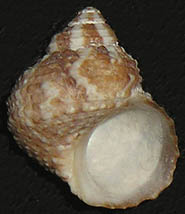
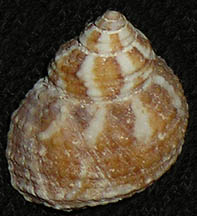
The color of the Turbo castanea shell is brown, tan, or orange, usually with white spots or flames (colorful character often diminished in more mature shells). The shell is stocky with convex whorls decreasing rapidly in size creating a spire of moderate height. The whorls have beaded cords of varying size (some cords continuous with frequent knobs, some as disconnected individual beads). The aperture is round with a white interior. There is a white callus on the columella and the outer lip is thin (and somewhat sinuous). There are 4 to 6 whorls and the sutures are distinct.
The operculum is calcareous, white and thick, the upper side often stained with color.


The live Turbo castanea is white with dark green to black markings. The antennae are very long and slender, clear with some light brown markings. There are leaf-like structures at the base of the antennae.
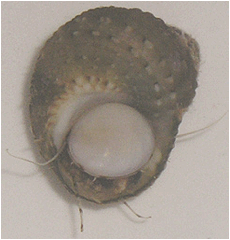
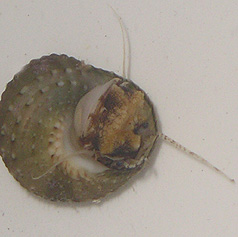
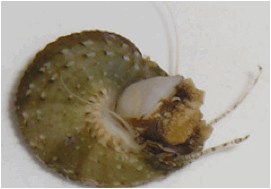
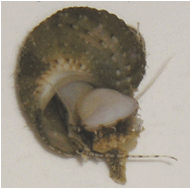
Turbo castanea emerging from shell
Long Key: quite common in grass beds
Key terminology choices: stocky, spirals, round, medium, smooth, none, equal
References: Abbot, p. 58; Abbot and Morris, p. 140 (T. castaneus); Lee, p. 56; Redfern, p. 11; Rehder, p. 389
BACK
Odostomella fonteini
Fontein’s
Turbonilla
Key ID features:
size, shape, protoconch
Size: 1.2 to 2 mm

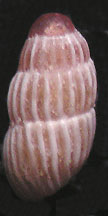
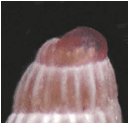
Close-up of protoconch
The color of the Odostomella fonteini shell is a shade of brown (the ribs often lighter or white). The shell is small and stubby, with slightly convex whorls. There are about 20 axial ribs; it is smooth between the ribs. The visible portion of the protoconch is smooth, dark in color, and rounded. The aperture is a tear-drop in shape; the outer lip thin. There are 3 to 4 whorls and the sutures are distinct.
Long Key:
Key terminology choices: slender, ribs, tear drop, minute, smooth, none, tall
References: Redfern, p. 150 (Turbonilla fonteini)
Back
Turbonilla
hemphilli
Hemphill’s Turbonilla
Key ID features:
protoconch, U-shape rib end
Size: 4 to 7 mm

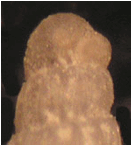

Close-up of shape of protoconch
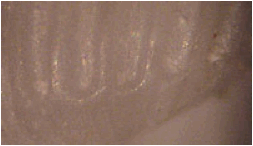
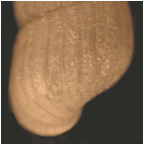
Close-up of U-shaped rib ends Close-up of ribs
The color of the Turbonilla
hemphilli shell is white. The shell is very tall and slender with 20
(to 24) moderately strong ribs which may curve slightly to the left. The ribs end above the aperture with a
U-shape. The gullies are
smooth. The second whorl of the
protoconch is set at an angle and partially embedded; the initial whorl is a
small sphere. The aperture is suboval with a thin outer
lip. There are 11 to 14 whorls and the sutures are distinct.
Similar species: T. penistoni (protoconch more upright and slightly larger)

Turbonilla cf. penistoni; Turbonilla hemphilli
Long Key:
Key terminology choices: slender, ribs, oval, tiny, smooth, none, x tall
References: Abbot, p. 302; Abbot/Morris, p. 262; Lee, p. 145; Redfern, p. 147
BACK
Trabecula krumpermani
Krumperman’s
Turbonilla
Key ID features: varices, shape
Size: 6 to 8 mm
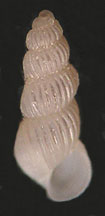

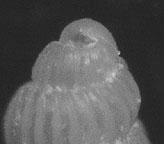
Close-up of
protoconch
The color of the Trabeculla
krumpermani shell is white.
The shell is tall and
slender, however, the shape often appears distorted due to irregularly placed
varices. The numerous ribs are
fairly narrow and oblique in orientation; the interspaces are smooth. The protoconch is largely immersed in
the apex leaving only a small smooth bulge. The aperture is a
tear drop shape, the outer lip thin.
There are 6 to 7 whorls and
the sutures are distinct.
Long Key: dead shells from flat off Craig Key
Key terminology choices: slender, ribs, tear drop, tiny, smooth, none, very tall
References: Redfern, p. 150 (Turbonilla krumpermani); Lee, p. 152
Back
Turbonilla
ornata
Ornate Turbonilla
Key ID features:
curved ribs, spiral threads
Size: 4 to 6 mm



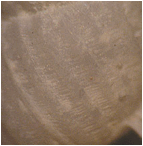
Close-up of apex Close-up of spiral threads
The color of the Turbonilla
ornata shell is brownish to white.
The shell is very tall and
slender with 24 (to 28) moderately strong ribs which curve distinctly to the
right. There are numerous very
fine threads between the ribs. The
protoconch is set at an angle and partially embedded. The aperture is
suboval. There are 10 to 12 whorls and the sutures are distinct.
Similar species: Genus Graphis (sutures more indented, protoconch not at an angle); T. pupoides (brown at suture); T. sp. A (ribs not curved toward columella); T. sp. B (wider spirals, ribs not curved toward columella)
Long Key:
Key terminology choices: slender, ribs, oval, tiny, smooth, none, x tall
References: Redfern, p. 149
BACK
Turbonilla protracta
Drawn-out
Turbonille
Key ID features:
color, fine spirals
Size: 3 to 4 mm


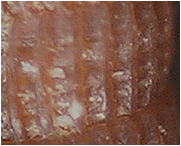
Close-up of sculpture
The color of the Turbonilla protracta shell is yellowish-brown to brown. The shell is tall and slender, with slightly convex whorls. The crowded ribs are slightly oblique in orientation. The ribs run to the base on the body whorl. There are spiral threads between the ribs. The aperture is a tear drop shape with a thin outer lip and a slightly twisted columella. There are 6 to 8 whorls and the sutures are distinct.
Long Key:
Key terminology choices: slender, ribs dominant, tear drop, minute, smooth, none, very tall
References: Abbot, p. 305
Back
Turbonilla
pupoides
Pupa Turbonilla
Key ID features:
brown band, fine spirals
Size: 4 to 6 mm



Close-up of apex
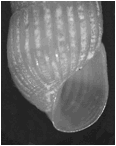
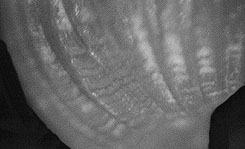
Close-up of ribs and aperture Close-up of spirals on base
The color of the Turbonilla pupoides shell is yellowish white with a band of pale brown on either side of the suture and on the periphery of the body whorl. The shell is very tall and slender with 22 (to 28) strong, fairly straight ribs which fade on the base. There are numerous very fine threads between the ribs. The base has clearly defined, often wavy, spirals. The protoconch is set at an angle and partially embedded. The aperture is suboval; rounded at the base. There are 8 to 10 whorls and the sutures are distinct.
Similar species: Genus Graphis (sutures more indented, protoconch not at an angle); T. ornata (ribs curved toward columella); T. sp. A (no brown at suture); T. sp. B (wider spirals)
Long Key:
Key terminology choices: slender, ribs, oval, tiny, smooth, none, x tall
References: Redfern, p. 148
Back
Vasum
muricatum
Caribbaen Vase
Key ID features:
heavy shell, white aperture
Size: 6 to 13 cm
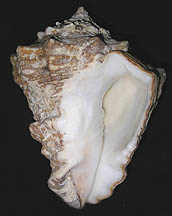
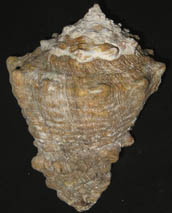
The color of the Vasum muricatum shell is white (but covered with a grayish periostracum). The shell is very heavy and kite-shaped. The spire is low and pointed. There are spiral cords on the body whorl and a row of knobs at the shoulder. There is a second row (often a double row) of nodules near the base. The aperture is an elongated oval, 80% the height of the shell. The interior is glossy white. There are 4 (to 5) strong folds on the center of the columella, the largest at the top. The canal is short and curved. There are 6 to 8 whorls and the sutures are distinct.
The operculum is strong, shades of brown, and claw-like in shape.


The live Vasum muricatum is purplish-black. The antennae are little extended beyond the eye; purplish-black in color.
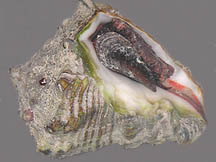
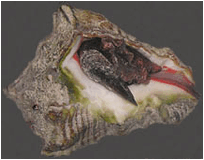
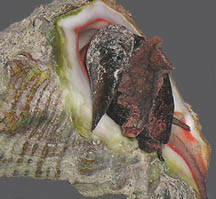
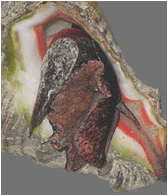
Vasum muricatum emerging from shell
Long Key: in bight, flats at Craig Key
Key terminology choices: kite, beaded, elongate, large, teeth, short, tall
References: Abbot, p. 241; Abbot and Morris, p. 239; Rehder, p. 591
Back
Vermicularia fargoi
Fargo’s Worm Shell
Key ID features:
large turritella, worm-tube shape
Size of turritella 19 to 25 mm
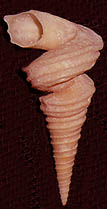
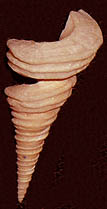

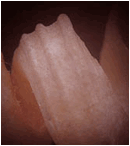
Close-up of turritella Close-up of cords
The color of the Vermicularia fargoi shell is amber, reddish-brown, or yellowish. The shell is an extended tube (to 100 mm) in overall shape; the early whorls, the turritella, are tightly coiled. Strong longitudinal cords give portions of the extended tube a squarish shape. The aperture is oval.
Similar species: V. spirata (turritella smaller)

Turritellas: V. fargoi on left, V. spirata
Long Key:
Key terminology choices: tube, spirals, oval, large, smooth, none, x tall
References: Abbot, p. 96; Abbot and Morris, p. 156
Back
Vermicularia spirata
West-Indian Worm Shell
Key ID features:
small turritella, worm-tube shape
Size of turritella 6 to 8 mm
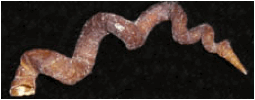

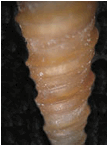
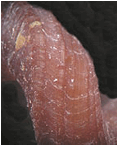
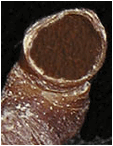
Close-up of turritella Close-up of cords Close-up of aperture
The color of the Vermicularia spirata shell is amber, reddish-brown, or yellowish. The shell is an extended tube (to 70 mm) in overall shape; the early whorls, the turritella, are small and tightly coiled. Cords often become obscure toward aperture. The aperture is oval.
The operculum is thin, multispiral, and yellowish (often tinged with brown).

The live Vermicularia spirata is brown with areas of white. The antennae are spotted.
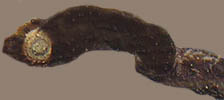
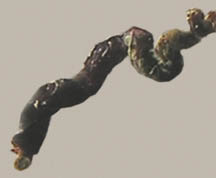
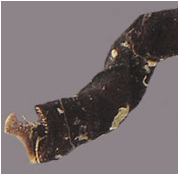
Vermicularia spirata emerging from shell
Similar species: V. fargoi (turritella larger)

Turritellas: V. fargoi on left, V. spirata
Long Key: immature shells in algae, mature shells embedded in sponges
Key terminology choices: tube, spirals, oval, large, smooth, none, x tall
References: Abbot, p. 96; Abbot and Morris, p. 157; Lee, p. 61; Redfern, p. 23; Rehder, p. 425
Back
Vexillum dermestinum
Mottled Miter
Key ID features: columella teeth, wide body,
color
Size: 14 to 18 mm
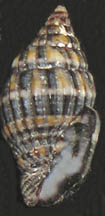
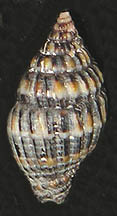
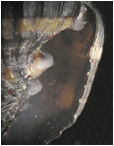
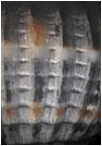
Close-up of columella Close-up of grooves between ribs
The color of the Vexillum
dermestinum shell is dark brown/black with white/cream markings. The shell is fusiform, twice as tall as wide, and with a pointed
apex. There are 17 (to 20) low
ribs with small grooves between.
The aperture is quite narrow
and about 40% the height of the shell.
There are 4 teeth on the columella, the top one the largest. The interior is white stained with
brown (including the area between the teeth). There is a small callus at the upper end of the
columella. The outer lip is thin. There is no umbilicus. There are 8 to 10 whorls and the sutures are distinct.
The live Vexillum dermestinum is
black with a few white spots. The antennae are moderately long, black with some
clear spots, and with a clear tip.
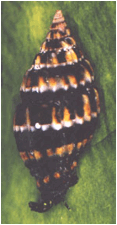
Vexillum dermestinum crawling
Similar species: V. moniliferum (light color band more narrow, shell smaller); V. sykesi (shell smaller, incised line below suture, ribs do not extend to previous suture)

V. dermestinum, V. sykesi, V. moniliferum
Long Key: patch reef off Caloosa Cove
Key terminology choices: fusiform, ribs dominant, narrow, small, teeth, short, tall
References: Abbot, p. 239/240; Redfern, p. 115
Back
Vexillum
exiguum
Meager
Miter (Hanley’s Miter)
Key ID features:
wrinkles. narrow ribs
Size: 4 to 6 mm


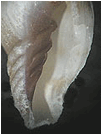
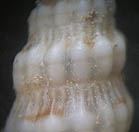
Close-up of aperture Close-of of suture
The color of the Vexillum exiguum shell is light (to dark) brown with cream coloring and brown spots (which may fade on beachworn shells). The shell is slightly inflated with convex whorls. There are 13 (to 16) axial ribs and a few (2 or 3) spiral cords on the base. The area below the suture appears wrinkled due to small axial riblets. The aperture is narrow and about 1/3 the height of the shell. There are 4 folds on the brown columella. The outer lip is thin. There are 7 to 10 whorls and the sutures are distinct.
The live Vexillum exiguum is white with a few brown splotches. The antennae are moderately long beyond the eye, brown with white spots. The siphon is brown with white spots.
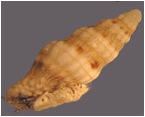
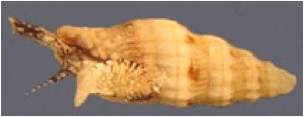
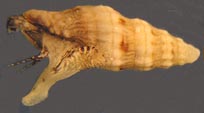
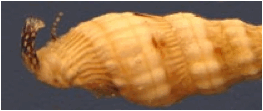
Vexillum exiguum emerging from shell and crawling
Similar species: V. gemmatum (shell wider, fewer and larger ribs, area below sutures less wrinkled. Note: Redfern indicates that V. gemmatum may be a form of V. exiguum)


V. exiguum V. gemmatum
Long Key: in bight grass beds and sand patches
Key terminology choices: fusiform, ribs, narrow, tiny, teeth, short, very tall
References: Abbot, p. 239 (Vexillum hanleyi); Redfern, p. 116; Rehder, p. 589 (Vexillum hanleyi)
Back
Vexillum
gemmatum
Gem
Miter (Little Gem Miter)
Key ID features:
wide body whorl, color, strong ribs
Size: 5 to 8 mm
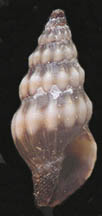
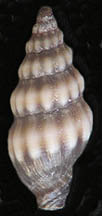

Close-up of aperture
The color of the Vexillum gemmatum shell is dark brown (to black) with cream colored ribs (and interspaces on some shells). The shell is somewhat inflated with convex whorls. There are 11 (to 13) axial ribs and a few (3 to 6) spiral cords on the base, of which the top one is strong, the others quite small. On some shells, the area below the suture may appear faintly wrinkled due to small axial riblets. The aperture is narrow and about 1/3 the height of the shell. There are 4 low folds on the brown (to purple or black) columella. The outer lip is thin. There are 7 to 10 whorls and the sutures are distinct.
The live Vexillum gemmatum is black with some light patches. The antennae are fairly short, not much tapered, and are clear with light and dark spots. The siphon has black coloration on a clearish background.
Similar species: V. exiguum (shell narrower, more and narrower ribs, area below suture more wrinkled. Note: Redfern indicates that V. gemmatum may be a form of V. exiguum)


V. exiguum V. gemmatum
Long Key: in bight grass beds and sand patches
Key terminology choices: fusiform, ribs, narrow, tiny, teeth, short, very tall
References: Abbot, p. 239; Lee, p. 122; Redfern, p. 116; Rehder, p. 590
Back
Vexillum moniliferum
Necklace
Miter
Key ID features:
white band of color, ribs, folds
Size: 10 to 17 mm
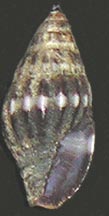

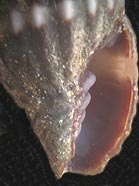
Close-up of aperture
The color of the Vexillum
moniliferum shell is dark brown/black with a narrow band of
cream/white. The shell is fusiform, a bit more than
twice as tall as wide, and with a pointed apex. There are 12 (to 16) low ribs. The aperture is
quite narrow and about 1/3 the height of the shell. There are 4 teeth on the columella, the top one the
largest. The interior is largely
brown with one white stripe (reflecting the surface color). The teeth are grayish and the area
between the teeth brown. The outer
lip is thin. There is no
umbilicus. There are 8 to 10 whorls and the sutures are distinct.
The live Vexillum moniliferum is dark
brown to dark greenish-black, with white spots. The antennae are slender and
not much tapered, black with white.
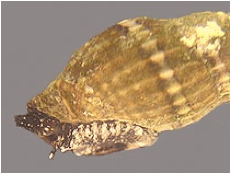
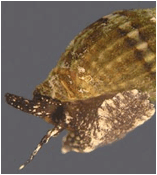
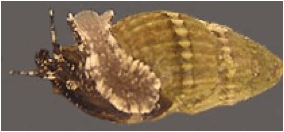
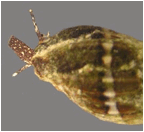
Vexillum moniliferum emerging from shell and crawling
Similar species: V. dermestinum (light colored band wider, shell larger); V. sykesi (incised line below suture, ribs do not extend to previous suture)

V. dermestinum, V. sykesi, V. moniliferum
Long Key: flat off Caloosa Cove; Old Dan Bank
Key terminology choices: fusiform, base, narrow, small, teeth, short, very tall
References: Redfern, p. 117, Lee, p. 122
Back
Vexillum sykesi
Syke’s Miter
Key ID features:
flat area below suture, beads on base
Size: 9 to 12 mm

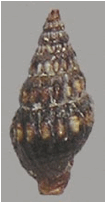

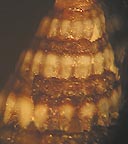
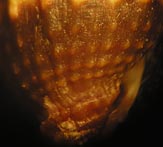
Close-up of aperture Close-up of ribs on spire whorls Close-up of beads on base
The color of the Vexillum sykesi shell is medium/dark brown with a band of cream/white. The shell is on the robust side of slender, of slightly convex whorls, and with a pointed apex. There are 15 (to 18) low ribs. There is a flattened area below the suture; thus the ribs cover only the lower 2/3 of the whorl. On the base, the ribs fade and the surface is beaded in appearance. The aperture is narrow and about 1/3 the height of the shell. There are 4 gray teeth on the columella, the top one the largest. The interior is stained with brown (including the area between the teeth) with one band of white (reflecting the exterior color). The outer lip is thin. There is no umbilicus. There are 8 to 10 whorls and the sutures are distinct.
The live Vexillum sykesi is dark brown to black, and white. The siphon and antennae are mottled with dark coloration and white.
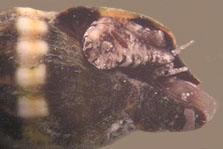
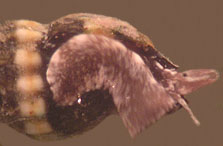
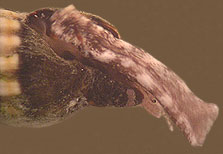
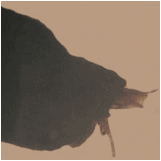
Vexillum sykesi emerging from shell and crawling
Similar species: V. dermestinum (light color band wider, shell larger); V. moniliferum (no incised line below suture, ribs extend to previous suture)

V. dermestinum, V. sykesi, V. moniliferum
Long Key:
Key terminology choices: fusiform, ribs dominant, narrow, small, teeth, short, very tall
References: Redfern, p. 118, Lee, p. 122
BACK
Vitreolina arcuata
Twisted Eulima
Key ID features: shape
Size: 2 to 3 mm



Side view showing advanced outer lip
The color of the Vitreolina arcuata shell is glassy/clear. The shell is smooth and polished. The upper whorls are almost flat-sided; they increase in size to an inflated convex body whorl. The spire is curved. The aperture is an elongate teardrop. The outer lip is thin, rounded at the base, and advanced in the middle. There are 8 to 10 whorls and the sutures are moderately distinct.
The operculum is thin, teardrop in shape, and clear (to yellowish).
![]()
Long Key:
Key terminology choices: slender, smooth, teardrop, minute, smooth, none, very tall
References: Redfern, p. 84, Lee, p. 103
BACK
Vitreolina bermudezi
Graceful Eulima
Key ID features: shape
Size: 4 to 5 mm



Side view showing advanced outer lip
The color of the Vitreolina bermudezi
shell is glassy/clear. The shell is smooth, polished, tall, and
slender. The whorls are flat sided
and increase smoothly in size. The
spire is gently, yet noticeably, curved.
The aperture is an elongate
teardrop. The outer lip is thin,
rounded at the base, and advanced in the middle. The umbilicus is very small. There are 8 to 11 whorls
and the sutures are moderately distinct.
The live Vitreolina bermudezi is
primarily white (although there may be a few spots of color). The eyes are located in streaks of
orange.


Live Vitreolina bermudezi in shell
Long Key:
Key terminology choices: slender, smooth, teardrop, minute, smooth, none, very tall
References: Redfern, p. 84
Back
Vitrinella filifera
Threaded Vitrinella
Key ID features: spiral cord, size, shape
Size: 1 to 1.5 mm
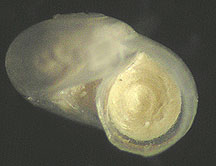
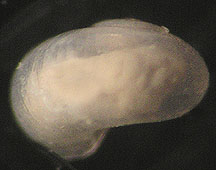
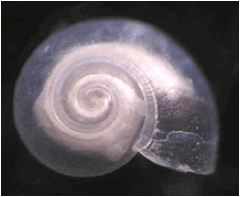
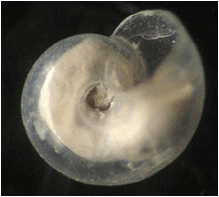
The color of the Vitrinella filifera shell is translucent glassy/clear to white. The shell is very small and somewhat fragile. The profile is flattened with a very low spire. There is a single cord just below the suture. The umbilicus is round and deep and bordered by a keel which fades near the aperture. The aperture is rounded with a thin outer lip. There are 2 to 3 whorls and the sutures are distinct.
Similar species: V. cf. floridana (no cord, no umbilical keel); Circulus multistriatus (spiral threads); Circulus semisculptus (spiral cords)
Long Key:
Key terminology choices: flattened, smooth, oval, minute, smooth, none, wide
References: Abbot, p. 82
Back
Vokesimurex
rubidus
Rose Murex
Key ID features:
varices, long canal, spines
Size: 25 to 50 mm
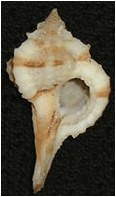
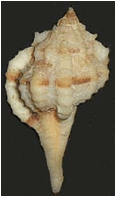
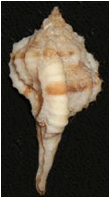
Side view of Vokesimurex rubidus
The color of the Vokesimurex rubidus shell is cream to white, with reddish, tan, brown, or pink markings. The shell is kite-shaped with a spire of moderate height. The body whorl has 3 prominent ribs with 2 or 3 smaller varices between. There are low spiral cords. A few sharp spines may be present, especially on the upper portion of the shell. The aperture is nearly circular. The outer lip is serrated and has ridges within; there are several white teeth on the lower portion of the columella. The canal is long, slender, partially closed, and only slightly recurved. There are 6 to 7 whorls and the sutures are distinct.
The live Vokesimurex rubidus is white. The antennae are white, but brown beyond the eyes
Similar species: Cymatium comptum (ridge on upper columella, aperture more oval)
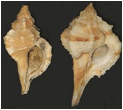
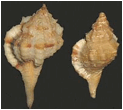
Vokesimurex rubidus in center, Cymatium comptum at either end
Long Key:
Key terminology choices: kite, ribs dominant, oval, medium, teeth, long, tall
References: Abbot, p. 171 (Murex recurvirostris rubidus); Abbot and Morris, p. 206 (Murex recurvirostris rubidus); Redfern, p. 87
Back
Volvarina albolineata
White-lined Marginella
Key ID features:
colored bands, columella folds, polished
Size: 5 to 8 mm
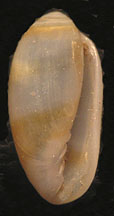
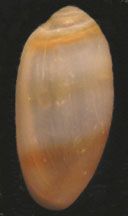
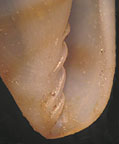
Close-up of folds on columella
The color of the Volvarina albolineata shell is white with several bands of orange/tan. The shell is convex, smooth, and polished. The spire is low and bluntly rounded. The aperture is narrow and 80% the height of the shell. There are 4 folds on the columella. The outer lip is thin but strong. There are 3 to 4 whorls (the body whorl dominant) and the sutures are moderately distinct.
The live Volvarina albolineata is white with a few orange spots. The antennae are long, white, and tapered. The siphon is white with a few orange spots.
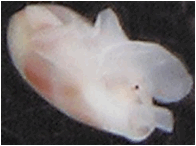
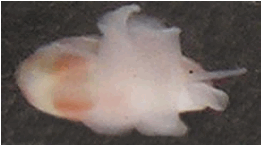
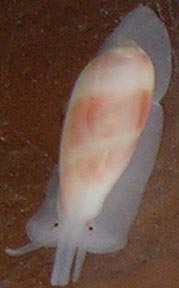
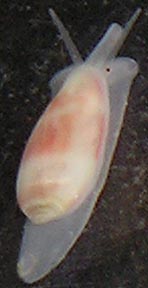
Volvarina albolineata emerging from shell and crawling
Similar species: V. avena (larger, outer lip thick); V. avenacea (larger, white with yellow tint)
Long Key: in clumps of algae, often Halimeda opuntia
Key terminology choices: rounded, smooth, elongate, tiny, teeth, short, very tall
References: Abbot, p. 253 (Hyalina albolineata); Abbot and Morris, p. 246 (Hyalina albolineata); Rehder, p. 603
Back
Volvarina avena
Oat Marginella (Orange-banded
Marginella)
Key ID features:
color, shape, polished
Size: 11 to 16 mm

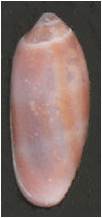
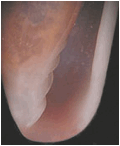
Close-up of folds on columella
The color of the Volvarina avena shell
is white with several bands of orange/tan (sometimes almost pink). The shell is convex, smooth, and polished. The spire is low and bluntly rounded. The aperture is narrow and 85% the height of the shell. There are 4 (sometimes 3) folds on the
columella. The outer lip is
thickened and curled in. There are
4 to 5 whorls (the body whorl
dominant) and the sutures are moderately distinct.
The live Volvarina avena is clear/white with orange blotches. The antennae are long, tapered, and clear with a few orange spots. The siphon is clear with a few orange spots.
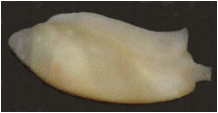
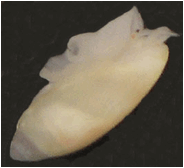
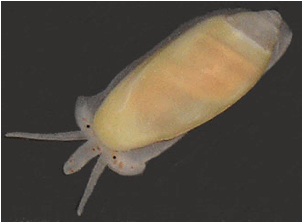
Volvarina avena emerging from shell and crawling
Similar species: V. albolineata (smaller, thin outer lip); V. avenacea (smaller, white with yellowish tint)
Long Key: in Halimeda opuntia at Old Dan Bank
Key terminology choices: rounded, smooth, elongate, small, teeth, short, very tall
References: Abbot, p. 252 (Hyalina avena); Abbot and Morris, p. 247 (Hyalina avena); Lee, p. 122; Redfern, p. 107; Rehder, p. 602
Back
Volvarina avenacea
Little Oat Marginella
Key ID features:
color, folds, polished
Size: 8 to 13 mm


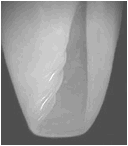
Close-up of columella
The color of the Volvarina
avenacea shell is white with a hint of light yellow. The shell is convex, smooth, and
polished. The spire is low and
bluntly rounded. The aperture is narrow and 90% the height
of the shell. There are 2 (often 3
with a very small 4th) folds on the columella. The outer lip is thickened and curled in. There are 4 to 5 whorls (the body whorl dominant) and the sutures are moderately
distinct.
The live Volvarina avenacea is off
white with opaque white spots. The antennae are slender with white and dark
markings. The siphon has opaque
white splotches.
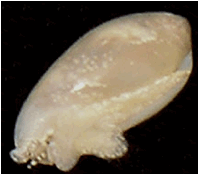
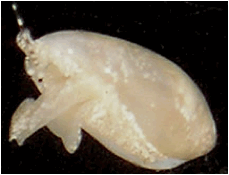
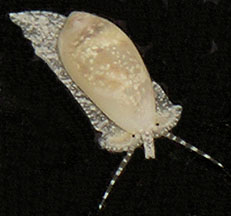
Volvarina avenacea emerging from shell and crawling
Similar species: V. albolineata (smaller, thin outer lip); V. avena (larger, more color, 4 folds); V. sp. (lower spire, more columella teeth)
Long Key: in Halimeda opuntia at Old Dan Bank
Key terminology choices: rounded, smooth, elongate, small, teeth, short, very tall
References: Abbot, p. 252 (Hyalina avenacea); Abbot and Morris, p. 247 (Hyalina avenacea) [This may be Redfern’s Volvarina sp. D., p. 108]
Back
Volvulella persimilis
Southern
Spindle Bubble
Key ID features:
spike-like apex, translucent
Size: 3 to 4 mm
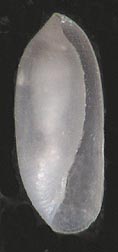
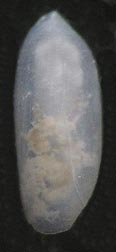
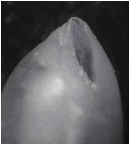
Close-up of apex
The color of the Volvulella persimilis shell is translucent clear/white. The shell is tall, smooth, and fragile, with a spike-like apex. There are microscopic spirals at either end of the shell. The umbilicus is very small. The aperture is elongate (exceeding the height of the shell). The outer lip is thin; the top portion follows the curvature of the body whorl, the lower portion is straight with a rounded base. Only the body whorl is visible.
Long Key:
Key terminology choices: rounded, smooth, elongate, minute, smooth, short, very tall
References: Abbot, p. 321; Lee, p. 155
Back
Xenophora
conchyliophora
Atlantic
Carrier Shell
Key ID features:
attachments on shell, colorful aperture
Size: 25 to 70 mm
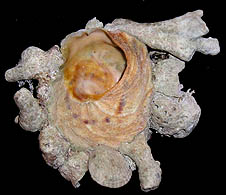
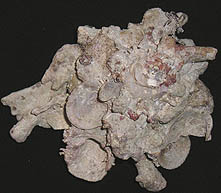
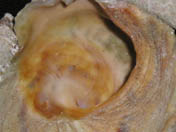
Close-up of aperture
The color of the Xenophora conchyliophora shell is difficult to discern since it is covered with attached shells and pieces of coral. The base of the shell is reddish-tan to light brown (with a few spots of dark brown). The shell is triangular in shape. The base is flattened and smooth except for growth lines. The aperture is an oblique oval and the interior is yellow and brown. The outer lip is thin. The umbilicus is substantially to completely covered by a callus.
The operculum is an irregular oval, thin, and yellowish-brown.
The live Xenophora conchyliophora is reddish-orange to maroon, with white spots. The antennae are purplish.
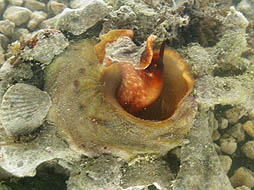
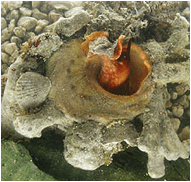
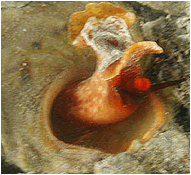
Xenophora conchyliophora emerging from shell
Long Key:
Key terminology choices: triangular, spirals, oval, large, smooth, none, equal
References: Abbot, p. 143; Abbot and Morris, p. 182; Lee, p. 77; Redfern, p. 49; Rehder, p. 468
BACK
Zebina browniana
Glossy
Risso
Key ID features: smooth,
glassy/white
Size: 3 to 4 mm
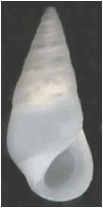
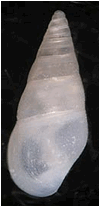

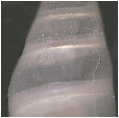
Close-up of ridge in aperture
Close-up of line parallel to suture
The color of the Zebina browniana shell is glassy to white. The shell is strong, smooth, and tall. It is 2.5 to 3.5 times as tall as wide. The aperture is a tear-drop shape and the outer lip is thickened. There is a ridge running into aperture at the upper end of the outer lip. There are 7 to 8 whorls and the sutures are moderately distinct. In fresh shells there is a very noticeable parallel line below the suture.
The operculum is thin (translucent), clear to pale yellow-brown, and an irregular oval.



Top and bottom views of operculum (two right views with red stain)
The live Zebina browniana is clear to tinted white. The antennae are rather long, slender, but not much tapered.

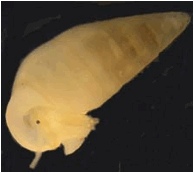
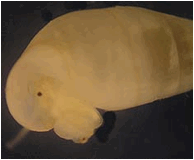
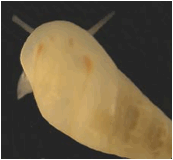
Zebina browniana in shell, emerging, and crawling
Note: Redfern differentiates Z. browniana from a very similar species, Z. laevigata, based on a small difference in the protoconch.
Long Key: common in algae in shallow water
Key terminology choices: slender, smooth, tear-drop, minute, smooth, none, very tall
References: Abbot, p. 77; Abbot and Morris, p. 152; Lee, p. 64; Redfern, p. 36; Rehder, p. 414